Corel Painter IX User Guide Instruction Manual UG EN
User Manual: corel Painter - IX - Instruction Manual Free User Guide for Corel Painter Software, Manual
Open the PDF directly: View PDF ![]() .
.
Page Count: 417 [warning: Documents this large are best viewed by clicking the View PDF Link!]
- Featured artists
- Table of contents
- Welcome to Corel Painter IX
- The Basics
- Working with Documents
- Creating and Opening Documents
- Creating and Opening Templates
- Placing Files
- Understanding Resolution
- Zooming
- Repositioning Documents
- Rotating Documents
- Cropping Images
- Using Full Screen Mode
- Image Size Information
- Resizing the Canvas
- Rotating and Flipping the Canvas
- Saving Files
- Closing Documents and Quitting the Application
- Setting Preferences
- Working with Documents
- Layers
- Getting Started with Layers
- Managing Layers
- Editing Layers
- Painting on Layers
- Brush Methods and Painting on Layers
- Preserving Layer Transparency
- Working with Floating Objects
- Adding Drop Shadows
- Creating Patterns on Layers
- Working with Reference Layers
- Setting Layer Opacity
- Blending Layers by Using Composite Methods
- Adding Notes to a Layer
- Storing Images with the Image Portfolio
- Organizing Layers with Image Portfolio Libraries
- Color
- Getting Started with Color
- Working with the Mixer Palette
- Working with Color Sets
- Setting Color Variability
- Viewing Color Information
- Setting Color Expression
- Working with Gradients
- Textures, Patterns, and Weaves
- Using Paper Texture
- Using Patterns
- Using Weaves
- Painting
- Exploring Brushes
- Marking the Canvas
- Exploring Painting
- Working with Fill
- Watercolor
- Liquid Ink
- Impasto
- Image Hose
- Customizing Brushes
- Getting Started with the Brush Creator
- Managing Settings and Controls
- General Controls
- Size Controls
- Spacing Controls
- Angle Controls
- Bristle Controls
- Well Controls
- Rake Controls
- Random Controls
- Mouse Controls
- Cloning Controls
- Impasto Controls
- Image Hose Controls
- Airbrush Controls
- Water Controls
- Liquid Ink Controls
- Digital Watercolor Controls
- Artists’ Oil Controls
- Color Variability Controls
- Color Expression Controls
- Expression Settings
- Managing Custom Brushes
- Cloning and Tracing
- Image Effects
- Working with Surface Texture
- Setting Appearance of Depth Properties
- Using Paper to Create Texture
- Using 3D Brush Strokes to Create Texture
- Creating 3D Oils
- Using Image Luminance to Create Texture
- Using Clone Source Luminance to Create Texture
- Creating Embossing Effects
- Using Channels and Layer Masks to Create Texture
- Working with Reflection Maps
- Applying Lighting to a Texture
- Working with Surface Texture
- Mosaics
- Getting Started with Mosaics
- Placing and Customizing Tiles
- Using Shapes
- Animation and Video
- Creating Animations and Video
- Getting Started with Movies
- Modifying a Movie
- Rotoscoping
- Saving and Exporting Movies
- Printing
- Index

PIXUserGuide.book Page 2 Thursday, August 26, 2004 10:43 AM
Copyright 1991 - 2004 Corel Corporation. All rights reserved.
Corel® Painter™ IX User Guide
The contents of this user guide and the associated Corel Painter software are the
property of Corel Corporation and its respective licensors, and are protected by
copyright. For more complete copyright information about Corel Painter, please refer
to the About Corel Painter section in the Help menu of the software.
Corel, the Corel logo, Corel Painter, CorelDRAW, KPT , Gel, Goo, LensFlare,
Lightning, Pyramid Paint, Reaction, ShapeShifter, and Natural-Media are trademarks
or registered trademarks of Corel Corporation and/or its subsidiaries in Canada, the
U.S. and/or other countries.
Adobe, Illustrator, Photoshop, PostScript, and Premiere are registered trademarks of
Adobe Systems Incorporated in the United States and/or other countries. Mac, Mac
OS, and Quick Draw are registered trademarks of Apple Computer, Inc., registered in
the United States and other countries. Canon is a registered trademark of Canon Inc.
Kodak is a registered trademark of Eastman Kodak Company. Hewlett-Packard and
DeskJet are registered trademarks of Hewlett Packard. Microsoft and Windows are
registered trademarks of Microsoft Corporation in the United States and/or other
countries. Minolta QMS is a trademark of Minolta Co., Ltd. Pantone, Hexachrome,
and PANTONE MATCHING SYSTEM are trademarks or registered trademarks of
Pantone, Inc. in the United States and/or other countries. TARGA is a registered
trademark of Pinnacle Systems, Inc., registered in the U.S. and other countries.
Cinepak is a registered trademark of Radius, Inc. EPSON Stylus is a registered
trademark of Seiko Epson Corporation. Tektronix is a registered trademark of
Tektronix, Inc. Wacom and Intuos are registered trademarks of Wacom Company, Ltd.
Other product, font, and company names and logos may be trademarks or registered
trademarks of their respective companies.
Corel's licensor(s) makes no warranties, express or implied, including without
limitation the implied warranties of merchantability and fitness for a particular
purpose, regarding the software, Corel's licensor(s) does not warrant, guaranty,
or make any representations regarding the use of the results of the use of the
software in terms of its correctness, accuracy, reliability, currentness, or
otherwise. The entire risk as to the results and performance of the software is
assumed by you. The exclusion of the implied warranties is not permitted by
some states. The above exclusion may not apply to you.
In no event will Corel's licensor(s), and their directors, officers, employees, or
agents (collectively "Corel's licensor") be liable to you for any consequential,
incidental, or indirect damages (including damages for loss of business profits,
business interruption, loss of business information, and the like) arising out of
the use of, or inability to use, the software even if Corel's licensor has been
advised of the possibility of such damages. Because some states do not allow the
exclusion or limitation of liability for consequential or incidental damages, the
above limitations may not apply to you.
007094
Featured artists
Ryan Church . . . . . . . . . . . . . . . . . . . . . . . . . . . . . . . . . . . . . . . . . . . . 1
Chet Phillips . . . . . . . . . . . . . . . . . . . . . . . . . . . . . . . . . . . . . . . . . . . 13
Christopher Welch. . . . . . . . . . . . . . . . . . . . . . . . . . . . . . . . . . . . . . . 75
Jeremy Sutton . . . . . . . . . . . . . . . . . . . . . . . . . . . . . . . . . . . . . . . . . 135
Cher Threinen-Pendarvis . . . . . . . . . . . . . . . . . . . . . . . . . . . . . . . . . 195
Don Seegmiller . . . . . . . . . . . . . . . . . . . . . . . . . . . . . . . . . . . . . . . . 271
John Taylor Dismukes . . . . . . . . . . . . . . . . . . . . . . . . . . . . . . . . . . . 325
John Ryan . . . . . . . . . . . . . . . . . . . . . . . . . . . . . . . . . . . . . . . . . . . . 355
Andrew Jones. . . . . . . . . . . . . . . . . . . . . . . . . . . . . . . . . . . . . . . . . . 383

Table of contents i
Table of contents
Art by Ryan Church: Concept painting for a movie scene
Welcome to Corel Painter IX. . . . . . . . . . . . . . . . . . . . . . . . . . . . . . . . 3
What’s in This User Guide? . . . . . . . . . . . . . . . . . . . . . . . . . . . . . . . . . . . . . . 3
What’s New in Corel Painter IX?. . . . . . . . . . . . . . . . . . . . . . . . . . . . . . . . . . 3
How to Use the Documentation. . . . . . . . . . . . . . . . . . . . . . . . . . . . . . . . . . . 9
How to Sign Up for Free Training from lynda.com. . . . . . . . . . . . . . . . . . . . 12
How to Access Corel Support Services. . . . . . . . . . . . . . . . . . . . . . . . . . . . . . 12
Art by Chet Phillips: Newspaper illustration
The Basics. . . . . . . . . . . . . . . . . . . . . . . . . . . . . . . . . . . . . . . . . . . . . . 15
Working with Documents . . . . . . . . . . . . . . . . . . . . . . . . . . . . . . . . . . . . . . 15
Setting Preferences . . . . . . . . . . . . . . . . . . . . . . . . . . . . . . . . . . . . . . . . . . . . 32
Layers . . . . . . . . . . . . . . . . . . . . . . . . . . . . . . . . . . . . . . . . . . . . . . . . . 43
Getting Started with Layers . . . . . . . . . . . . . . . . . . . . . . . . . . . . . . . . . . . . . 43
Managing Layers . . . . . . . . . . . . . . . . . . . . . . . . . . . . . . . . . . . . . . . . . . . . . 52
Editing Layers . . . . . . . . . . . . . . . . . . . . . . . . . . . . . . . . . . . . . . . . . . . . . . . 63
Art by Christopher Welch: Concept vehicle design
Color . . . . . . . . . . . . . . . . . . . . . . . . . . . . . . . . . . . . . . . . . . . . . . . . . . 77
Getting Started with Color. . . . . . . . . . . . . . . . . . . . . . . . . . . . . . . . . . . . . . 77
Working with the Mixer Palette. . . . . . . . . . . . . . . . . . . . . . . . . . . . . . . . . . 84
Working with Color Sets . . . . . . . . . . . . . . . . . . . . . . . . . . . . . . . . . . . . . . . 92
Setting Color Variability. . . . . . . . . . . . . . . . . . . . . . . . . . . . . . . . . . . . . . . 100
Viewing Color Information. . . . . . . . . . . . . . . . . . . . . . . . . . . . . . . . . . . . . 102
Setting Color Expression. . . . . . . . . . . . . . . . . . . . . . . . . . . . . . . . . . . . . . . 103
Working with Gradients . . . . . . . . . . . . . . . . . . . . . . . . . . . . . . . . . . . . . . 104
Textures, Patterns, and Weaves. . . . . . . . . . . . . . . . . . . . . . . . . . . . 113
Using Paper Texture. . . . . . . . . . . . . . . . . . . . . . . . . . . . . . . . . . . . . . . . . . 113

ii Table of contents
Using Patterns . . . . . . . . . . . . . . . . . . . . . . . . . . . . . . . . . . . . . . . . . . . . . . 120
Using Weaves. . . . . . . . . . . . . . . . . . . . . . . . . . . . . . . . . . . . . . . . . . . . . . . 131
Art by Jeremy Sutton: Digital portrait painting
Painting . . . . . . . . . . . . . . . . . . . . . . . . . . . . . . . . . . . . . . . . . . . . . . 137
Exploring Brushes. . . . . . . . . . . . . . . . . . . . . . . . . . . . . . . . . . . . . . . . . . . . 137
Marking the Canvas . . . . . . . . . . . . . . . . . . . . . . . . . . . . . . . . . . . . . . . . . . 144
Exploring Painting . . . . . . . . . . . . . . . . . . . . . . . . . . . . . . . . . . . . . . . . . . . 148
Working with Fill. . . . . . . . . . . . . . . . . . . . . . . . . . . . . . . . . . . . . . . . . . . . 163
Watercolor . . . . . . . . . . . . . . . . . . . . . . . . . . . . . . . . . . . . . . . . . . . . 169
Getting Started with Watercolor. . . . . . . . . . . . . . . . . . . . . . . . . . . . . . . . . 169
Working with Digital Watercolor. . . . . . . . . . . . . . . . . . . . . . . . . . . . . . . . 172
Liquid Ink. . . . . . . . . . . . . . . . . . . . . . . . . . . . . . . . . . . . . . . . . . . . . 175
Working with the Liquid Ink Layer. . . . . . . . . . . . . . . . . . . . . . . . . . . . . . . 175
Using Liquid Ink Controls. . . . . . . . . . . . . . . . . . . . . . . . . . . . . . . . . . . . . . 176
Impasto. . . . . . . . . . . . . . . . . . . . . . . . . . . . . . . . . . . . . . . . . . . . . . . 179
Getting Started with Impasto . . . . . . . . . . . . . . . . . . . . . . . . . . . . . . . . . . . 179
Adjusting Surface Lighting . . . . . . . . . . . . . . . . . . . . . . . . . . . . . . . . . . . . . 187
Image Hose. . . . . . . . . . . . . . . . . . . . . . . . . . . . . . . . . . . . . . . . . . . . 191
How the Image Hose Works. . . . . . . . . . . . . . . . . . . . . . . . . . . . . . . . . . . . 192
Getting Started with the Image Hose . . . . . . . . . . . . . . . . . . . . . . . . . . . . . 193
Art by Cher Threinen-Pendarvis: Digital landscape painting
Customizing Brushes . . . . . . . . . . . . . . . . . . . . . . . . . . . . . . . . . . . . 197
Getting Started with the Brush Creator. . . . . . . . . . . . . . . . . . . . . . . . . . . . 198
Managing Settings and Controls . . . . . . . . . . . . . . . . . . . . . . . . . . . . . . . . . 204
Managing Custom Brushes . . . . . . . . . . . . . . . . . . . . . . . . . . . . . . . . . . . . . 263
Art by Don Seegmiller: Concept character painting

Table of contents iii
Cloning and Tracing. . . . . . . . . . . . . . . . . . . . . . . . . . . . . . . . . . . . . 273
Cloning Images . . . . . . . . . . . . . . . . . . . . . . . . . . . . . . . . . . . . . . . . . . . . . 273
Using Cloner Brushes. . . . . . . . . . . . . . . . . . . . . . . . . . . . . . . . . . . . . . . . . 278
Turning Other Brushes into Cloners. . . . . . . . . . . . . . . . . . . . . . . . . . . . . . 288
Image Effects . . . . . . . . . . . . . . . . . . . . . . . . . . . . . . . . . . . . . . . . . . 291
Working with Surface Texture . . . . . . . . . . . . . . . . . . . . . . . . . . . . . . . . . . 291
Mosaics . . . . . . . . . . . . . . . . . . . . . . . . . . . . . . . . . . . . . . . . . . . . . . . 307
Getting Started with Mosaics . . . . . . . . . . . . . . . . . . . . . . . . . . . . . . . . . . . 308
Placing and Customizing Tiles. . . . . . . . . . . . . . . . . . . . . . . . . . . . . . . . . . 314
Art by John Taylor Dismukes: 3D Halloween concept design
Using Shapes . . . . . . . . . . . . . . . . . . . . . . . . . . . . . . . . . . . . . . . . . . 327
Getting Started with Shapes. . . . . . . . . . . . . . . . . . . . . . . . . . . . . . . . . . . . 327
Creating Shapes . . . . . . . . . . . . . . . . . . . . . . . . . . . . . . . . . . . . . . . . . . . . . 330
Editing Shapes . . . . . . . . . . . . . . . . . . . . . . . . . . . . . . . . . . . . . . . . . . . . . . 339
Transforming Shapes . . . . . . . . . . . . . . . . . . . . . . . . . . . . . . . . . . . . . . . . . 345
Combining Shapes . . . . . . . . . . . . . . . . . . . . . . . . . . . . . . . . . . . . . . . . . . . 351
Art by John Ryan: Animation storyboard for a radio commercial
Animation and Video . . . . . . . . . . . . . . . . . . . . . . . . . . . . . . . . . . . . 357
Creating Animations and Video . . . . . . . . . . . . . . . . . . . . . . . . . . . . . . . . . 357
Getting Started with Movies. . . . . . . . . . . . . . . . . . . . . . . . . . . . . . . . . . . . 362
Modifying a Movie . . . . . . . . . . . . . . . . . . . . . . . . . . . . . . . . . . . . . . . . . . . 367
Rotoscoping . . . . . . . . . . . . . . . . . . . . . . . . . . . . . . . . . . . . . . . . . . . . . . . . 369
Saving and Exporting Movies . . . . . . . . . . . . . . . . . . . . . . . . . . . . . . . . . . . 378
Art by Andrew Jones: Character design for a video game
Printing. . . . . . . . . . . . . . . . . . . . . . . . . . . . . . . . . . . . . . . . . . . . . . . 385
Understanding Printing . . . . . . . . . . . . . . . . . . . . . . . . . . . . . . . . . . . . . . . 385
Getting Started with Printing. . . . . . . . . . . . . . . . . . . . . . . . . . . . . . . . . . . 386

Ryan Church is one of the leading concept artists working today. He has worked with clients such as
Walt Disney Imagineering, Universal Studios, Industrial Light and Magic, and Lucasfilm. Ryan
is currently a Concept Design Supervisor for Star Wars: Episode III, and a Senior Art Director at
Industrial Light and Magic.
Art by Ryan Church: Concept painting for a movie scene

Welcome to Corel Painter IX 3
Welcome to Corel Painter IX
Corel® Painter™ IX is the leading Natural-Media® painting application.
Corel Painter lets you simulate a wide range of art tools — from felt pens, charcoal,
and colored pencils to watercolor and oils.
What’s in This User Guide?
The Corel Painter IX User Guide is divided into nine sections. Each section describes a
collection of tools you can use to create digital artwork and provides step-by-step
instructions. In addition, artwork by a renowned digital artist is featured at the
beginning of each of the nine sections to demonstrate what can be achieved using
Corel Painter IX.
The content provided in this user guide describes the most common tasks performed in
Corel Painter IX. Please note that it is not an exhaustive reference for every tool. If you
require detailed information about topics that are not discussed in this user guide,
please refer to the application’s Help system.
What’s New in Corel Painter IX?
Corel Painter IX adds a range of tools and features that increase performance, fuel
creativity, and further extend compatibility with other industry-standard tools and
applications. With improved Help, tutorials by world-class digital artists, and free
lynda.com videos, getting started with Corel Painter is easier than ever.

4 Corel Painter User Guide
Performance and Productivity
Increasing the overall speed, performance, and stability was a top priority for
Corel Painter IX. Working closely with Apple, Intel, and AMD, Corel engineers
created improvements and efficiencies wherever possible. Corel Painter has never been
a more efficient and powerful application.
Improved Speed
This is the fastest version of Corel Painter yet, with some brushes up to 10 times faster!
Brushes now perform, on average, twice as fast. In addition, users can now change the
default scratch disk location in the Preference settings.
New Welcome Screen
Getting down to the job at hand has never been easier, thanks to the Corel Painter IX
Welcome screen, which launches on startup. Divided into four sections, the Welcome
screen gives quick access to recently used files, tutorials, brush and color-management
settings, and even artwork from renowned Corel Painter masters.
Brush Control Palettes
New Brush Control palettes provide easy access to all brush settings and controls.
Making on-the-fly changes to brush settings and variables is as simple as dragging a
slider — without any disruption to workflow.
For example, the new Boost slider, found in the General palette of the Brush Controls,
instantly enhances brush speed. Just drag the slider and see brush performance
accelerate.
Frames-per-Second Control
Animators can now test frame rates directly in Corel Painter. With the new Frames-
per-Second Control, frame rates can be set and previewed in a range of 1 to 40 frames
per second.
Rotate/Flip Canvas
Entire images can now be easily rotated or flipped directly in Corel Painter. Image
composition is easily verified at the touch of a button.

Welcome to Corel Painter IX 5
Customizable Shortcut Keys
Corel Painter now offers creative professionals an unprecedented level of control over
their workflow by enabling complete customization of shortcut keys. A handy
printable template for keeping a quick reference is included.
Multiuser Support
Corel Painter now supports multiple users on both the Mac® and Windows®
platforms. User files are stored in the user file directory, ensuring that users in a
networked environment can retain individual settings and preferences. In addition, all
settings are easily reverted to the default without having to reinstall the application.
Tracker Palette Enhancements
The Tracker palette stores historical information about every brush stroke that is
applied to the canvas. Acting as a "virtual brush diary," the Tracker palette tells the
story of an image created with Corel Painter IX brushes. Brushes used in the last
session can be recalled in the next, and favorite brush variants can be locked so that
they are always readily accessible.
Iterative Save
Iterative Save enables users to quickly save sequentially numbered versions of an image
with a simple menu command. The first time Iterative Save is used, "_001" is
appended to the filename. Each subsequent time the number increments by 1, and a
new sequentially numbered file is created.
Creativity
Corel Painter IX delivers an impressive array of new features that provide
unprecedented power to replicate natural media, and dazzling new effects offer more
options than ever.
Artists' Oils Painting System
The Artists' Oils Painting System is a milestone in the evolution of digital art. This
new painting system enables users to apply paint blends created in the Mixer palette
directly onto images in the document window. Each brush dab loads the brush variant

6 Corel Painter User Guide
with a finite amount of oil. As the oil runs out, the brush stroke becomes fainter. Brush
strokes interact with any paint already on the canvas just as they would with natural
media.
The Artists' Oils Painting System has four components:
• Artists' Oils Brush Category and Variants
• Artists' Colors are based on the color measurements of real-world oil paints.
• Integration of Artists' Oils with the Mixer palette, including a new multicolor
eyedropper
• Artists' Oil Brush Controls provide the ability to control the amount of oil,
viscosity, blend, bristling, clumpiness, brush trails, and dirtiness.
Snap-to-Path Painting
When users need to create a perfect curve or shape, Snap-to-Path Painting is a great
time-saver. Snap-to-Path Painting makes it possible to constrain a brush stroke along a
path or a shape by clicking a button or using a keyboard shortcut. With a simple click,
users can now create a perfect, precise brush stroke that reflects the attributes typically
found in a Corel Painter stroke, such as pressure, tilt, and bearing.

Welcome to Corel Painter IX 7
Digital Watercolor
Digital Watercolor has been significantly enhanced in Corel Painter IX. Paint stays wet
between sessions, enabling users to start one session where the last one ended. The wet
fringe of digital watercolor brush strokes can now be changed dynamically, enabling
experimentation after the brush stroke has been applied.
Quick Clone
Quick Clone is ideal for photographers, enabling them to transform their photos into
paintings. This new feature speeds up the image-cloning workflow and reduces five
steps to one. Quick Clone settings can be defined on the General page of the
Preferences dialog box.
KPT Filters
KPT® filters are renowned, powerful plug-ins that creative professionals rely on to
produce stunning effects quickly and easily. Seven powerful KPT filters have been
included in Corel Painter IX: KPT® Gel™, KPT® Goo™, KPT® LensFlare™,
KPT® Lightning™, KPT® Pyramid Paint™, KPT® Reaction™, and KPT®
ShapeShifter™. These plug-ins are valuable additions to the impressive array of effects
available in Corel Painter.
Compatibility
The ability to use Corel Painter in conjunction with other industry-standard software
and hardware is greater than ever. New color-management enhancements enable
printer colors to be reproduced more accurately on-screen and in print. Extended
support for Adobe® Photoshop® and Wacom® pen tablets streamlines a professional
workflow.
Enhanced Adobe Photoshop Support
Moving between Adobe Photoshop and Corel Painter is simple. Files saved to the
Adobe Photoshop (PSD) file format open in Corel Painter IX, with layer masks, alpha
channels and layer sets (layer groups) maintained.
Layer behavior in Corel Painter is now very similar to Adobe Photoshop. New layers
are now added above the selected layer, layers with different merge modes are
collapsible, and it is now possible to hide or display multiple layers by simply clicking
and dragging.

8 Corel Painter User Guide
In addition, Corel Painter now supports Photoshop plug-ins for Mac OS® X.
Enhanced Wacom Support
Corel Painter IX features support for Wacom's newest pen tablet model — the
Wacom® Intuos®3 — and the entire Wacom tablet product line. The Wacom
Intuos3 has touch strips that can be configured to control brush size, zooming, and
many other functions, eliminating the need for a keyboard while painting. In addition,
tablet keys can be used as modifier keys, such as Command, Option, Shift, or Spacebar
on a Mac; or Ctrl, Alt, Shift, or Spacebar on a PC.
Enhanced Color Management
Corel Painter IX includes an enhanced Color Management System that ensures
accurate color reproduction when images are printed. Supporting industry-standard
ICC4.0 profiles, Corel Painter IX Color Management enables color matching between
on-screen and printed colors. A color-management tutorial helps users configure their
system for optimal color reproduction.
Learning
With improved Help, a revitalized User Guide, tutorials from leading graphics
professionals, training videos from lynda.com, and courseware specifically designed for
educators, getting started with Corel Painter IX has never been easier!
Improved Help
A revised User Guide and Help system provide information and fast solutions. The
Corel Painter IX Handbook, which is included with Corel Painter IX Full and
Upgrade versions, offers a collection of step-by-step tutorials created by well-known
creative professionals.
Free lynda.com Training Videos
Corel Painter IX includes training videos created by lynda.com, one of the world's
most renowned graphics training companies, to guide users through the Corel Painter
workspace, tools, features, and techniques.

Welcome to Corel Painter IX 9
Free Academic Courseware
Corel Painter academic courseware consists of complete lesson plans and exercises for
10 classes on a variety of subjects.
How to Use the Documentation
You can find answers to many of your questions in the Corel Painter User Guide and
the Help available from within the Corel Painter workspace.
The Corel Painter User Guide contains commonly used procedures and information. A
Portable Document Format (PDF) version of the Corel Painter User Guide is available
on the Corel Painter IX CD. Full-color versions of the Corel Painter User Guide can be
purchased from www.corel.com/painterix.
The Help gives you access to a full range of topics in a searchable format.
If you have any comments or suggestions about The Handbook, user guide, Help, or
tutorials, please contact us at www.corel.com/painterix/feedback.
Documentation Conventions
The following table describes important conventions used in the
Corel Painter User Guide and in the Help.
Convention Description Example
Multiple platforms The Corel Painter User Guide is
for both the Mac OS and
Windows platforms. As a
convention, Mac OS commands
precede Windows commands in
the text.
Hold down Command (Mac OS)
or Ctrl (Windows).
Modifier keys When a modifier key differs
between Mac OS and Windows,
the Mac OS modifier is listed
first, followed by the Windows
modifier.
“Command + I (Mac OS) or Ctrl
+ I (Windows)” means that
Mac OS users would press
Command + I and Windows
users would press Ctrl + I.

10 Corel Painter User Guide
Choose X menu >
menu item On the menu bar, click the menu
name, and choose the menu item
from the list.
“Choose File menu >
Quick Clone” means the
following:
Title bar A title bar is located at the top or
side of some UI elements, such as
the toolbox, property bar, and
palettes. It may not display title
text.
Examples of the toolbox title bar
on the Mac OS (left) and in
Windows (right):
Palette title bar The palette title bar appears at
the top of a palette. When
expanded, the palette’s title bar
changes to dark gray. When a
palette is collapsed, you can still
see the palette’s title bar, which is
now light gray.
Palette title bars for the Colors,
Mixer, and Color Sets palettes are
collapsed, and the Color Info
palette is expanded.
Palette arrow The palette arrow is used to
expand or collapse a palette. The Color Sets palette arrow is
collapsed, and the Color Info
palette arrow is expanded.
Convention Description Example

Welcome to Corel Painter IX 11
Palette menu arrow
or selector menu
arrow
Clicking a palette menu arrow or
a selector menu arrow displays a
pop-up menu with additional
commands.
The palette menu arrow for the
Mixer palette displays the Mixer
palette menu.
Flyout Some tools share a space in the
toolbox. Hold down the tool
button that’s displayed to open
the flyout.
In the toolbox, by clicking and
holding the Grabber tool, you
can display a flyout that includes
two other tools: the Rotate Page
tool and the Perspective Grid
tool.
A note contains information that
is important to the steps that
precede it. It can describe
conditions under which the
procedure can be performed.
For example: “This command is
available only if you have turned
off a selection.”
A tip contains suggestions for
performing the steps that
precede it. It can present
alternatives to the steps, as well
as other benefits and uses of the
procedure.
For example: “You can choose a
brush category and variant in the
main application or in the Brush
Creator.”
Convention Description Example

12 Corel Painter User Guide
Using Corel Painter Help
The Help is the documentation that can be accessed from within the Corel Painter
workspace. It is fully searchable and includes all the information in the
Corel Painter User Guide and more.
To use Help
1Choose Help menu > Help Topics.
2Click one of the following tabs:
• The Contents tab lets you browse through topics in the Help.
• The Index tab lets you use the index to find a topic.
• The Search tab lets you search the full text of the Help for a particular word. For
example, if you are looking for information about RGB color mode, you can
type “RGB” to display a list of relevant topics.
How to Sign Up for Free Training from lynda.com
When you register Corel Painter IX, you will receive free access to some of the
lynda.com “Getting Started With Corel Painter IX” training videos. These videos are
designed to allow new users to start working quickly and give experienced users a tour
of the new features.
How to Access Corel Support Services
Corel® Support Services can provide you with prompt and accurate information about
product features, specifications, pricing, availability, services, and technical support.
For the most current information on support services available for your Corel product,
please visit www.corel.com/support.

Chet Phillips has presented his slightly off-center view of the world under the guise of a freelance
illustrator for more than 20 years. He divides his time between working for corporate, publishing,
advertising and design companies as well as displaying his work in galleries and shows. As usual,
no electrons are harmed in the process.
Art by Chet Phillips: Newspaper illustration

The Basics 15
The Basics
The Corel Painter application provides a digital workspace in which you can create
new images, or alter existing images, using the Corel Painter Natural-Media tools and
effects. Your working image is known as a document and is displayed in a document
window. This document window includes navigation and productivity features to help
you work efficiently.
As you create an image, you can save your document in a number of different file
formats: RIFF (Corel Painter native format), JPEG, TIFF, and Adobe Photoshop
(PSD), to name a few. Corel Painter also lets you open or import images in many file
formats.
Every artist works in a unique way, and every computer system has its own
configuration of memory, disks, printers, and accessories. Corel Painter preferences let
you customize the program for your own work style and for optimum performance on
your particular system. You can also customize the features of your tablet and pens in
Corel Painter.
Working with Documents
The first step in creating an image in Corel Painter is opening a document. You can
open a blank canvas by creating a new document, work with an existing image by
opening a file already created, or acquire an image from a scanner or digital camera.
Once you have created your image, you can place it directly into a document.
Creating and Opening Documents
The File menu > New command creates a blank, untitled document based on the
specifications you set in the New dialog box. Canvas Size shows the RAM requirement
for creating the document at the specified width, height, and resolution. This number

16 Corel Painter User Guide
does not reflect the file size for the saved document. A saved Corel Painter file is
usually 25% to 50% of the size of the working document, depending on the number of
colors it contains.
You can also open documents from other graphics applications and use Corel Painter to
add brush strokes, tints, or paper textures. Or, you can clone a document to re-create it
in a different medium. Corel Painter lets you open the following file formats:
• RIFF — Corel Painter native format (RIF)
• TIFF (TIF)
•CMYK TIF (TIF)
• Adobe Photoshop formats (PSD) — Corel Painter preserves layers, layer masks,
alpha channels, and composite methods. Layer effects and adjustment layers are not
supported and should be merged or flattened in Adobe Photoshop.
•Windows Bitmap (BMP)
• PC Paintbrush (PCX)
• TARGA® (TGA)
• GIF — Corel Painter does not convert GIF animations to frame stacks.
•JPEG (JPG)
• Frame stacks (FRM) — Corel Painter animation files
• QuickTime™ (MOV), Video for Windows (AVI), and numbered files. For more
information, refer to “Opening a Movie” on page 363 or “Working with Numbered
Files” on page 381.
Corel Painter does not support LZW compressed TIFF file format. Only
uncompressed TIFF files open in Corel Painter.
To create a new document
1Choose File menu > New.
2In the New dialog box, enter values for the following:
• Width and Height determine the dimensions of the canvas. You can change the
unit of measurement by using the menu. Choose from pixels (the default),
inches, centimeters (CM), points, picas, and columns (2 inches wide).

The Basics 17
• Resolution is the number of pixels per inch (ppi) or pixels per centimeter that
make up an image. In the New dialog box, setting the document’s pixels per
inch is the same as setting its dots per inch (dpi). Refer to “Understanding
Resolution” on page 19 for detailed information about document, screen, and
print resolutions.
3Click the Paper Color chip to set the document’s background to a color other than
white.
Choose a color from the Color dialog box that appears.
4Choose a Picture Type.
Picture Type lets you set up a document to contain a single frame for an image (the
default) or multiple frames for a movie.
5Click OK.
A new document appears in the workspace.
To open an existing document
1Choose File menu > Open.
Corel Painter remembers the location of the last file you opened.
2In the Open (Mac OS) or Select Image (Windows) dialog box, use the controls to
locate the file you want to open.
Corel Painter lists every image’s dimensions (in pixels), file size, and file format. In
addition, files saved in Corel Painter include thumbnails for browsing purposes.
3Click Open.
The File menu also offers you a shortcut to previously opened documents.
Before choosing Open in the File menu, see if the file you want is in the
recently opened files list at the bottom of the File menu.
To browse for a document (Mac OS)
1Choose File menu > Open.
2Click Browse.
The Browse dialog box shows thumbnails for all the RIFF files in a folder.
3Double-click the file name, or select a file and click Open.

18 Corel Painter User Guide
Acquiring Images
You can acquire images for Corel Painter directly from an external device — such as a
scanner or digital camera — if the device provides a:
• Adobe Photoshop-compatible plug-in module (Mac OS)
• TWAIN driver (Windows)
Before acquiring images
• Install the device plug-in module on your computer.
This plug-in module is provided by the manufacturer of your scanner or digital
camera. Refer to the device documentation for installation instructions.
Corel Painter can access plug-ins from any single folder on your computer. This
location can be inside the Corel Painter folder, in a generic plug-ins folder on your
hard drive, or in the Adobe Photoshop Plug-ins folder.
• Make sure your TWAIN driver is properly installed.
Creating and Opening Templates
If you regularly create documents that contain similar dimensions, formatting, and
resolution, you can create document templates so that you don’t have to start each
document from scratch.
To open a document template
1Choose Help menu > Welcome.
2Choose a template from the Open a Template pop-up menu.
To save a document as a template
1Set up a file with all the sizing, formatting, and resolution attributes you want in
the template.
2Choose File menu > Save As.
3In the Save Image As dialog box, save the file to the Corel Painter IX\Templates
folder.
If you work in a multiuser environment, only Administrators can add to the
Corel Painter IX\Templates folder.

The Basics 19
Placing Files
Placing a file lets you import an image into an existing Corel Painter document. The
placed image becomes a new reference layer in the document — you can transform
(resize, rotate, slant) it on screen by dragging its handles. A placed file maintains its
link to the source file until you commit it to standard layer format.
For general information about working with reference layers, refer to “Working with
Reference Layers” in the Help.
To place a file
1Choose File menu > Place.
2Select an image file, and click Open.
3In the Place dialog box, set the options:
• In the Scaling area, the Horizontal and Vertical boxes suggest a scale to fit the
image in the current document. To change the size, enter scaling percentages in
the Horizontal and Vertical boxes.
• Constrain Aspect Ratio maintains the proportions of the image. Disable this
check box to distort the image.
• Retain Alpha retains the file’s mask. When the image is placed, the image mask
becomes the layer mask. Disable this check box to discard the mask.
4Do one of the following:
• To place the image in a particular location, click on that location in the
document.
• To place the image in the center of the document, click OK.
Understanding Resolution
When working with images in a digital workspace, it is helpful to understand the
concept and applications of resolution. Resolution refers to how Corel Painter
measures, displays, saves, and prints images — either as small squares of color known
as pixels or as mathematical objects known as vectors.
A document’s resolution affects both its appearance on your computer screen and its
print quality. You can specify a document’s resolution when you create a new
document, acquire an image, or save or export a file.

20 Corel Painter User Guide
Resolution and Screen Appearance
Most monitors have a resolution of 72 dpi (dots per inch). Because of this, the
Corel Painter display default is 72 ppi (pixels per inch). This means that each pixel in
the Corel Painter image occupies 1 pixel on your monitor. The display resolution does
not affect the document’s actual pixels per inch — only how the image is displayed on
the monitor.
For example, a 300-ppi document displays at approximately four times its actual size.
This happens because each pixel in the Corel Painter image occupies 1 pixel on your
monitor, and the monitor’s pixels are four times the size of the image’s pixels. Put
another way, at 300 ppi your printed document will be approximately one-quarter of
its on-screen size. In this example, if you wanted to view the image at actual size, you
would set the zoom level to 25%.
Keep in mind that if you leave the dimensions in pixels and then change the pixels per
inch (resolution), the actual printed size will be affected by the change. If you set your
document size in inches, centimeters, points, or picas and change resolution, the
dimensions will not be affected by the change.
Resolution and Print Quality
The resolution of output devices (printers) is measured in dots per inch, and, in the
case of halftones, lines per inch (lpi). Output device resolutions vary, depending on the
type of press and paper you’re printing on. Generally, a photograph will be output at a
crisp 150 lpi if printed on glossy magazine stock and at 85 lpi for newspaper stock.
If you are using a personal laser or inkjet printer, set your document size in inches,
centimeters, points, or picas at the dots-per-inch setting specific to your printer. Most
printers will produce excellent output from images set at 300 ppi. Your file will be
output correctly — in the proper size and at the best resolution for your printer.
Increasing the file’s pixels-per-inch setting does not necessarily improve the output and
may create a large, unwieldy file.
If you are using a commercial printer or a more sophisticated output device, the
dimensions of the image should always be set to the actual size it will appear in the
printed piece. For the resolution, a good rule of thumb is to set your document’s pixels
per inch to twice the desired lines per inch. So, at 150 lpi, the pixels per inch should be
twice that, or 300 ppi; at 85 lpi, the pixels per inch should be 170 ppi. It’s a good idea
to check with your service bureau if you have questions about output device resolution.

The Basics 21
Zooming
By default, Corel Painter opens a document at 100% magnification, but you can
change the level of magnification by zooming. You can zoom in and out using the
Magnifier tool, reset magnification, or zoom to fit the screen. You can even zoom in
and out while working with other tools.
To zoom in
1Do one of the following:
• In the toolbox, click the Magnifier tool .
• Hold down Command + Spacebar (Mac OS) or Ctrl + Spacebar (Windows).
The Magnifier cursor shows a plus sign (+), indicating that you are increasing
magnification (zooming in).
2Click or drag in the document window.
When you drag, Corel Painter chooses the magnification level that most closely
conforms to the selected area and centers the screen view on that area.
The document’s magnification level appears in the document window’s title bar.
To zoom out
1Do one of the following:
• In the toolbox, click the Magnifier tool and hold down Option (Mac OS) or Alt
(Windows).
• Hold down Option + Command + Spacebar (Mac OS) or Alt + Ctrl +
Spacebar (Windows).
The Magnifier cursor shows a minus sign (-), indicating that you are decreasing
magnification (zooming out).
2Click in the document window.
Each click reduces the magnification to the next level, as defined in the Zoom Level
at the bottom of the image window.
You can also zoom in or out by moving the Scale slider, typing a value in the
Scale box at the bottom of the image window, or choosing an option from the
Zoom Level pop-up menu on the property bar.

22 Corel Painter User Guide
To zoom using the Magnifier tool
1In the toolbox, click the Magnifier tool.
2Choose a zoom level from the Zoom Level pop-up menu on the property bar.
To reset magnification to 100%
•Double-click the Magnifier tool.
To zoom to fit the screen
•Do one of the following:
• Choose Window menu > Zoom to Fit.
• In the toolbox, double-click the Grabber tool .
Corel Painter generates a view of the entire document to fit the size of your screen.
To access the Magnifier tool while any other tool is selected
•Press Command + Spacebar (Mac OS) or Ctrl + Spacebar (Windows), and click to
zoom in; press Command + Option + Spacebar (Mac OS) or Ctrl + Alt +
Spacebar (Windows), and click to zoom out.
Repositioning Documents
The Grabber tool allows you to reposition a document in the Corel Painter workspace
and view different areas of an image.
To use the Grabber tool
1Activate the Grabber tool by doing one of the following:
• In the toolbox, click the Grabber tool .
• Hold down the Spacebar.
The cursor changes to the Grabber tool.
2Do one of the following:
• Drag in the document window to scroll through your image.
• Click once in the document window to center the image.

The Basics 23
Rotating Documents
The Rotate Page tool lets you rotate an image on the screen to accommodate the way
you draw naturally.
To rotate the page
1Activate the Rotate Page tool by doing one of the following:
• In the toolbox, click the Rotate Page tool .
• Hold down Option + Spacebar (Mac OS) or Alt + Spacebar (Windows).
The cursor changes to a hand with a pointing finger.
2Drag in the document window to rotate the image.
Move the cursor clockwise to rotate the image clockwise. Move the cursor
counterclockwise to rotate the image counterclockwise.
The new rotation angle appears on the property bar.
You can also rotate an image by typing a rotation angle in the Rotation Angle
box on the property bar.
To return an image to its original orientation
1In the toolbox, click the Rotate Page tool .
2Do one of the following:
• Click once in the document window.
• Double-click the Rotate Page tool.
• On the property bar, click the Reset Tool button.
To constrain rotation to 90° increments
•Hold down the Shift key while rotating.
Cropping Images
You can remove unwanted edges from the image with the Crop tool. You can adjust
the ratio of the cropped image and choose to maintain the aspect ratio.

24 Corel Painter User Guide
To crop an image
1In the toolbox, click the Crop tool .
2Drag inside the image to define the rectangular area you want to keep.
You can adjust the rectangle by dragging a corner or any of its edges.
3When you’re ready to execute the crop, click inside the rectangle.
To constrain the cropping rectangle to a certain aspect ratio, enter values for
the width and height aspect, and enable the Ratio option on the property bar.
To constrain cropping to a square
•Hold down the Shift key while dragging to define the area with the Crop tool.
To adjust the ratio of the cropped image
1In the toolbox, click the Crop tool.
2On the property bar, type ratio values in the boxes.
If necessary, enable the Ratio check box to maintain aspect ratio when cropping the
image.
Using Full Screen Mode
Full screen mode allows you to hide your computer’s desktop and view the document
window without scroll bars. When full screen mode is on, the document window is
centered over a solid background. All Corel Painter features — except the buttons on
the document window — work when you use full screen mode.
To toggle the full screen mode on and off
•Press Command + M (Mac OS) or Ctrl + M (Windows), or click Window menu >
Screen Mode Toggle from the menu bar.
You can position the image window anywhere on the screen by holding down
the Spacebar and dragging.

The Basics 25
Image Size Information
You can use the Info palette to check image size. For more information, see “Using the
Info Palette” in the Help.
Resizing the Canvas
If you want the same image at a different scale, you can resize the canvas. You can also
change the size of the drawing area or crop the canvas.
To resize the canvas
1Choose Canvas menu > Resize.
The Resize dialog box appears, showing the current and new sizes by width, height,
and resolution.
2Enter a new value for width, height, or resolution.
For more information on these values, refer to “Creating and Opening Documents”
on page 15.
3The Constrain File Size check box lets you choose how to deal with dimensions
relative to resolution.
When Constrain File Size is enabled, you can change the height and width of the
image together. The resolution will change accordingly.
When Constrain File Size is disabled, you can change the height and width
independently of the resolution, and vice versa.
If you choose pixels or percent as the unit and enter a value, Corel Painter
automatically disables the Constrain File Size check box.
To resize the drawing area
1Choose Canvas menu > Canvas Size.
2In the Canvas Size dialog box, specify the number of pixels you want to add to any
side of the canvas.
Enter negative values to reduce the canvas size.

26 Corel Painter User Guide
Rotating and Flipping the Canvas
Corel Painter lets you rotate and flip the Canvas layer. When you rotate or flip the
Canvas layer, all other layers move along with it. You can rotate the Canvas layer by a
predefined amount, or you can choose the amount of rotation. If your document has
layers of different varieties, you are prompted to commit all of them to default, pixel-
based layers. The Canvas layer increases in size when necessary, so rotating or flipping
it does not cause the contents of other layers to be cropped.
To rotate the Canvas layer by a predefined amount
1Choose Canvas menu > Rotate Canvas.
2Choose one of the following:
• 180 to rotate 180 degrees
• 90 CW to rotate 90 degrees clockwise
• 90 CCW to rotate 90 degrees counterclockwise
To rotate the Canvas layer by a user-defined amount
1Choose Canvas menu > Rotate Canvas > Arbitrary.
2In the Rotate Selection dialog box, type the number of degrees of rotation you want
in the Amount box.
To flip the Canvas
1Choose Canvas menu > Rotate Canvas.
2Choose one of the following:
• Flip Canvas Horizontal
• Flip Canvas Vertical
Saving Files
You have several options for saving files. You can save a file in its current format or to a
different format. You can also save iterations of the same file. Whenever you perform
an iterative save, a new version of the file is saved with a number added to the file
name, and for each subsequent save, the number added to the file name increments by
1. In addition, Corel Painter remembers the location of the last file you saved.

The Basics 27
Saving RIF Files
RIF is the Corel Painter native format, which retains special information about your
document. For example, a RIF file maintains layers so that you can return to the file to
re-access them.
It is a good idea to always save files in RIF format first. Think of RIF files as
“work-in-progress” files. When a file is ready for production, then save it to GIF,
JPEG, TIF, or another file format.
Corel Painter lets you compress files and save disk space with a lossless compression
method. When saving in RIF format, leave the Uncompressed option disabled to
minimize the file size on your hard disk.
Saving JPEG Files
Corel Painter supports the JPEG file format. Because of its small file size and high
quality, JPEG is commonly used to transmit files through a modem. Unlike GIF, the
JPEG file format displays a full range of colors.
The JPEG file format allows you to compress your file on a scale of Fair to Excellent,
where quality is directly proportional to file size. These quality settings will let you
achieve compression ratios of less than 10:1 to greater than 100:1. JPEG is a “lossy”
file format, meaning that a decompressed JPEG file will not be identical pixel-for-pixel
to the original. However, because the JPEG algorithm takes into account the
sensitivity of the eye to different colors, the higher-quality settings should achieve
visually satisfying results.
You can assign a URL to layers and placed images and then save the file in GIF or
JPEG format to produce an image map. For more information, refer to “Client-Side
Image Mapping” in the Help.
When you save a file in JPEG format, Corel Painter displays the JPEG Encoding
Quality dialog box, with the following options:
• The Quality options — Excellent, High, Good, and Fair — let you set the degree
of file compression.
The Excellent option compresses the least, but retains the most data. Fair
compresses the most, but loses the most data.
You can also use the Quality slider to adjust file compression.
• The Smoothness slider applies smoothing to the entire image. This is useful when
using the Fair option, to blur the edges of JPEG artifacts. The default is 0. Keep in
mind that using a high smoothness setting can cause blurring.

28 Corel Painter User Guide
• The Progressive JPEG check box creates a progressive JPEG file. Progressive
format is useful for files used on the Web. As the name implies, progressive format
displays an image in stages — as a series of scans — while the file downloads. The
first scan is a low-quality image; the following scans improve in quality. This allows
the user to see the whole image very quickly.
• The HTML Map Options — NCSA Map File, CERN Map File, and Client Side
Map File — let you generate an image map. (NCSA refers to the National Center
for Supercomputing Applications, and CERN refers to the Conseil Europeén pour
la Recherche Nucléaire.) Use the NCSA Map File or CERN Map File option to
generate a server-side image map. Use the Client Side Map File option to generate
a client-side image map.
Refer to “Working with Image Maps” in the Help for more information about image
map types.
It is best not to decompress and recompress a file multiple times. Although JPEG can
compress and discard data not visible or obvious, the degradation of the data can affect
the condition of your file.
When a file has lost a significant amount of data, block patterns may appear in areas of
the image. If you try to use the Apply Surface Texture feature on a JPEG file, you may
find it will accent the block patterns.
Saving GIF Files
Corel Painter allows you to save documents as GIF files. GIF, a file format using 8 or
fewer bits, is commonly used to display graphics on the Web. When you save a GIF
file, you can choose settings from 4 Colors to 256 Colors. You can choose how your
colors will be displayed and what part of your image will be transparent.
You can enable the Color Set option to force all colors in the color table of the GIF file
to match the colors in the current color set. This option can be useful when you are
doing Web work, especially if you want to constrain colors to a specific color set or
control the number of colors in a Web page, thus controlling the image file size.
The Imaging Method setting determines how your 24-bit Corel Painter document will
be converted to the limited number of colors that GIF uses. If you choose Quantize to
Nearest Color, Corel Painter picks the color nearest to that of each pixel. If you choose
Dither Colors, Corel Painter applies a pattern to the colors chosen to generate a more
accurate, less banded result.
Corel Painter can also save a frame stack as a GIF animation file. For more
information, refer to “Creating Animated GIFs” in the Help.

The Basics 29
If you want your image to have transparency, enable the check box for Output
Transparency. Most programs that display GIF files support transparency, but for those
that don’t, you should specify the color of the “transparent” area. If your image will be
displayed on the Web, enable the Background is WWW Gray option. You can also
choose to use the background color of your Web page by enabling the Background is
BG Color option.
For programs that support transparency, your selection will determine which areas are
transparent. The Threshold slider determines which selection (loaded mask) value
becomes transparent. You can see how the Threshold slider is affecting the
transparency of your image in the Preview window in the dialog box. Transparency is
displayed in the Preview window by a rectangular lattice. You can toggle between the
Preview window and your Save As GIF options to get exactly what you want. Enable
the Interlaced check box if your image will be displayed on a Web page.
For information on creating masks, refer to “Selections” in the Help.
Saving RGB TIF and CMYK TIF Files
The TIF format facilitates exchange between applications and computer platforms. It
is a widely supported bitmap image format that lets you save with either CMYK or
RGB color space information. When you save a file in CMYK TIF format,
Corel Painter creates a color separation, which can then be used for four-color process
printing.
Saving Adobe Photoshop (PSD) Files
Corel Painter can save files in Adobe Photoshop (PSD) format. For optimum
compatibility, shapes are rasterized, and masks are placed in channels.
When you save a file in PSD format, you have RGB and CMYK options, as you do
when saving in TIF format.
Saving Encapsulated PostScript (EPS) Files
The encapsulated PostScript® (EPS) files in Corel Painter conform to the Desktop
Color Separation (DCS) 2.0 format (EPS-DCS 5 file format). Although Corel Painter
saves files in EPS-DCS, it can’t read EPS-DCS. If you plan to save an image in
EPS-DCS, it’s a good idea to save it in another format first, so that you’ll have a copy
of it that you can reopen in Corel Painter.

30 Corel Painter User Guide
When you save an image as EPS-DCS with Preview Options turned on, Corel Painter
uses the loaded International Color Consortium (ICC) profile to prepare the separation
files. If you’re using the Hexachrome® ICC profile, Corel Painter prepares six
separation files — Cyan, Magenta, Yellow, Green, Orange, and Black. For more
information on Preview Options and color management, refer to “Printing” on
page 385.
Although you can save your images as CMYK EPS separations, Corel Painter can’t
open or edit CMYK files.
When you save a file in EPS-DCS, Corel Painter opens the EPS Save Options dialog
box, with these options:
• Hex (ASCII) Picture Data provides another way of storing PostScript information.
Some page design programs require that this option be checked. The file sizes will
be approximately twice as large when saved with this option.
• Preview Options — No Preview, Black and White Preview, and Color Preview —
specify whether to save preview data and in what format. The resulting preview file
is a low-resolution (72-ppi) file.
If you have an older laser printer, you have to use the black and white preview to
print these files. Although the preview or display is black and white, the color
information remains intact.
Recovering Lost Work
When you work with computers, sometimes uncontrollable events cause files to
become corrupt. How can you recover work lost in a corrupt image file? No backup?
Do you have to create the whole image again?
Maybe not. Corel Painter records all actions into the Current Script. If Corel Painter is
stopped and restarted within 24 hours, the old current script is still available (saved as
“{date}{time}”), and a new current script is started. By default, the dated scripts are
saved for one day, but you can reset this to a longer time.
The dated scripts can be used to replay actions for recovering lost work or to create
scripts for movies. Also, you can use the Script List to cut and paste portions of the
dated script that are useful. Just open the dated script, and delete the last few
commands; then play the script to re-create the work, and try saving the file again.
For more information, see “Scripting” in the Help.

The Basics 31
To save a file in its current format
•Choose File menu > Save.
To save a file with a different name or format
1Choose File menu > Save As.
2In the Save (Mac OS) or Save Image As (Windows) dialog box, use the controls to
specify a location, file name, and format.
To perform an iterative save
•Choose File menu > Iterative Save.
You can also perform an iterative save by pressing Command + Option + S
(Mac OS) or Ctrl + Alt + S (Windows).
Closing Documents and Quitting the Application
You can close documents or quit Corel Painter using menu commands, keyboard
shortcuts, or the Close button of the current window.
To close a document
•Do one of the following:
• Click the current window’s Close button.
• Choose File menu > Close.
• Press Command + W (Mac OS) or Ctrl + W (Windows).
To quit Corel Painter
•Do one of the following:
• (Mac OS) Choose Corel Painter IX menu > Quit Corel Painter IX.
• (Windows) Choose File menu > Exit.
You can also quit Corel Painter by pressing Command + Q (Mac OS) or Ctrl
+ Q (Windows).

32 Corel Painter User Guide
Setting Preferences
Corel Painter has several different pages of the Preferences dialog boxes: General,
Brush Tracking, Customize Keys, Undo, Shapes, Internet, Save, Operating System,
and Palettes.
General Preferences
To access General preferences
•Do one of the following:
• (Mac OS) Choose Corel Painter IX menu > Preferences > General.
• (Windows) Choose Edit menu > Preferences > General.
To make changes to other preferences before closing the Preferences dialog
box, choose another preference type from the pop-up menu.
Setting up the Drawing Cursor
You can choose a cursor icon and its orientation. You can also set the drawing cursor to
show the brush size and shape.
To choose a drawing cursor icon
1On the General page of the Preferences dialog box, enable the Brush option in the
Cursor Type area.
2Choose one of the following drawing cursor icon options from the pop-up menu to
the right of the Brush option:
•Brush
• Cross
•Torus
•Triangle
• Hollow Triangle
•Gray Triangle
The selected cursor icon appears in the Orientation area.
3Enable an Orientation option.

The Basics 33
If you want to set the cursor to show the brush size and shape, enable the
Brush Ghosting check box. Brush Ghosting gives you immediate visual
feedback on the cursor, showing you the shape and size of the selected brush.
If you want the drawing cursor icon to be a single pixel, enable the Single
Pixel option in the Cursor Type area.
When you use a brush with “Enable Brush Ghosting”
enabled, the cursor shows the shape of the brush.
Setting the Default Libraries
Corel Painter provides standard libraries that contain brushes, paper grains, selections,
layers, images, and color sets. The Libraries section of the General page of the
Preferences dialog box lets you designate which libraries appear by default.
To set default libraries
•Enter library file names in the Brushes, Papers, Selections, Images, and Color Set
boxes.
The default libraries must reside in the Corel Painter folder.
Setting Quick Clone Preferences
You can customize the Quick Clone effect. You can choose whether to delete the image
from the clone or to turn on Tracing Paper. You can also select the last-used Cloner
brush or choose to clone color with any brush variant.

34 Corel Painter User Guide
To set Quick Clone preferences
1Choose Corel Painter IX menu > Preferences > General (Mac OS), or Edit menu
> Preferences > General (Windows).
2In the Quick Clone area of the Preferences dialog box, enable or disable the
following check boxes:
• Delete Image From Clone. When enabled, this option automatically deletes the
contents of the clone file.
• Turn on Tracing Paper. When enabled, this option automatically activates the
Tracing Paper feature.
3Enable one of the following check boxes:
• Switch to Cloner Brushes automatically activates the last Cloner brush variant
used.
• Clone Color uses the current brush variant to clone the underlying color.
By default, the Switch to Cloner Brushes check box is enabled. To enable the
Clone Color check box, you must disable the Switch to Cloner Brushes check box.
Auto-Save Scripts
When you create an image, Corel Painter records all the operations you perform. This
recording is known as a background script and is saved on the Scripts palette. The
Auto-Save Scripts preference governs how long Corel Painter saves background scripts
before deleting them.
To reset the Auto-Save Scripts preference
1Do one of the following:
• (Mac OS) Choose Corel Painter IX menu > Preferences > General.
• (Windows) Choose Edit menu > Preferences > General.
2Specify the number of days for which you want Corel Painter to save background
scripts in the Auto-Save Scripts For box.
For more information about creating and using scripts, refer to “Scripting” in the
Help.
Brush Size Increment
The Brush Size Increment preference lets you set the increment value in pixels.

The Basics 35
Magnifier Increment
The Magnifier Increment preference lets you specify the percentage of magnification at
which the magnifier will increase or decrease.
Units
The Units preference lets you choose the unit of measurement used by the
application’s various sliders and other measurement options.
Cloning Preference
When you clone an image, Corel Painter uses the color information from the original
as you fill in your clone. If you would like Corel Painter to display what part of the
original you’re cloning, check the box next to Indicate Clone Source with Crosshairs
While Cloning.
Draw Zoomed-out Views Using Area-Averaging
When you are viewing an image at under 100% magnification, screen draw is faster
when Draw Zoomed-out Views Using Area-Averaging is enabled, and slower — but
more accurate — when this check box is not enabled.
Display Warning When Drawing Outside Selection
Checking this box enables the warning that appears when you draw outside a
selection.
Show Commit Dialog When Converting to a Layer
Enable this check box if you have enabled the Commit and Don’t Ask Again check box
in the Commit dialog box and want to reinstate the dialog box.
Brush Tracking Preferences
When you draw with traditional media, the amount of pressure you use with a tool
determines how dense and how wide your strokes are. Using a pressure-sensitive stylus
with Corel Painter gives you this same kind of control. Each artist has a different
strength or pressure level in a stroke. The Brush Tracking preference lets you adjust
Corel Painter to match your stroke strength. This is particularly useful for artists with
a light touch. If a light stroke leaves no color on the canvas, you should use Brush
Tracking to increase sensitivity.

36 Corel Painter User Guide
You might also change brush tracking between phases of a project. You could use a
light touch when sketching with a pencil brush variant, then set tracking for more
pressure when you switch to an oil paint variant. Corel Painter saves Brush Tracking
between sessions, so whatever tracking sensitivity you set will be the default the next
time you open the application.
To set Brush Tracking
1Do one of the following:
• (Mac OS) Choose Corel Painter IX menu > Preferences > Brush Tracking.
• (Windows) Choose Edit menu > Preferences > Brush Tracking.
2Drag in the scratch pad in a “normal” stroke.
Use the pressure and speed you prefer when drawing or painting. For specific
adjustments, you can move the sliders.
Customize Keys Preferences
Corel Painter lets you assign commands to keys on your keyboard. This saves you time
by giving you immediate keyboard access to your favorite commands. Along with
character, numeric, function, and modifier keys, you can also use Tab, Backspace
(Windows), Delete, Insert, Home, End, Page Up, Page Down, Up Arrow, Down
Arrow, Left Arrow, Right Arrow, and Spacebar. You can use keys already used for other
shortcuts.
You can also create a collection of keyboard shortcuts, or key sets, based on changes to
the default key set. For easy reference, you can generate an HTML summary of a key
set.
To assign commands to keys
1Do one of the following:
• (Mac OS) Choose Corel Painter IX menu > Preferences > Customize Keys.
• (Windows) Choose Edit menu > Preferences > Customize Keys.
2Choose a key set from the Key Set pop-up menu.
The default key set is named “Default” and is not editable. When you change any
shortcut in the Default key set, another set is created and named “Custom.”
3Choose one of the following from the Shortcuts menu:
• Application Menus to create or modify menu bar command shortcuts

The Basics 37
• Palette Menus to create or modify palette menu command shortcuts
• Tools to create or modify tools shortcuts
• Other to create or modify non-menu, non-palette menu or non-tool command
shortcuts
4Choose a command from the Application Commands list, and type the shortcut
keys you want to assign.
If the shortcut you assigned is already in use, a message appears below the
Application Commands list.
5Do one of the following:
• Click Accept to assign the shortcut to the command.
The conflicting command that previously had the keyboard shortcut now has no
keyboard shortcut assigned to it.
• Click Accept and Go To Conflict to assign the shortcut to the new command,
and to assign another keyboard shortcut to the conflicting.
To revert keyboard shortcuts
To manage key sets
To Do the following
Revert the last keyboard shortcut you
created or modified Click Undo.
Revert to all keyboard shortcuts you created
or modified since you opened the Preferences
dialog box
Click Reset. In the warning dialog box, click
Yes.
Revert all keyboard shortcuts to their default
settings Click Defaults. In the warning dialog box,
click Yes.
To Do the following
Open an existing key set Click the Open button . In the Open Key
Set dialog box, select a key set, and click
Open.

38 Corel Painter User Guide
Key set files created on the Mac OS cannot be imported into Corel Painter on
Windows. Likewise, key set files created on Windows cannot be imported into
Corel Painter on the Mac OS.
Undo Preferences
Multiple Undo allows you to undo and redo up to 32 levels of changes. Corel Painter
sets 32 levels as the default.
The number of Undo levels applies across open documents. If you have set the number
of Undo levels to 5, and you have two documents open and have “undone” three
operations on the first document, you can undo only two operations on the second
document.
Multiple Undo can use a significant amount of disk space. If you perform multiple
operations on the entire image, the whole image must be saved for each Undo step.
To set Undo levels
1Do one of the following:
• (Mac OS) Choose Corel Painter IX menu > Preferences > Undo.
• (Windows) Choose Edit menu > Preferences > Undo.
2Enter a number between 1 and 32 in the box.
Create a new key set from the existing key
set Click the New from Existing button . In
the Save New Key Set dialog box, type a
name for the key set in the Filename box,
and click Save.
Save the active key set Click the Save Active Set button . In the
Save Key Set dialog box, type a name for the
key set in the Filename box, and click Save.
Create an HTML summary of the active key
set Click the Create HTML Summary button
. In the Save Summary dialog box, type a
name in the Filename box, and click Save.
Delete the active key set Click the Delete button .
To Do the following

The Basics 39
Shapes Preferences
You can set the default fill and stroke in the Shapes page of the Preferences dialog box.
These settings apply to new shapes you create. If you enable the Big Handles check
box, the Bézier curve control handles will appear larger. (You may find it easier to work
with them in the larger size.) You can also specify colors for the wing color, outline
color, and point color.
To change Shapes preferences
1Do one of the following:
• (Mac OS) Choose Corel Painter IX menu > Preferences > Shapes.
• (Windows) Choose Edit menu > Preferences > Shapes.
2Select your preferences from the following options:
• Drawing Options control how Corel Painter displays shapes as you create them
(On Draw) and when a shape path is closed (On Close). The default setting for
On Draw is Stroke In Current Color, and the default setting for On Close is Fill
with Current Color.
• Big Handles controls the size of the anchor points and direction wing handles.
This can make them easier to grab and drag. If you want big points, enable this
option.
• Outline controls the color of the shape outline paths. Double-click the chip to
change the color.
• Selected Point controls the color of selected anchor points (unselected anchor
points appear “hollow”). Double-click the chip to change the color.
• Wing controls the color of the control wings and handles. Double-click the chip
to change the color.
Save Preferences
You can set preferences for the color space prompt automatically, so that you do not
need to choose a color space every time you save.
For Mac OS only, Corel Painter allows you to select file extension preferences.
To set preferences for the color space prompt
1Do one of the following:
• (Mac OS) Choose Corel Painter IX menu > Preferences > Save.

40 Corel Painter User Guide
• (Windows) Choose Edit menu > Preferences > Save.
2Choose one of the following options from the TIFF and PSD pop-up menus:
• RGB automatically saves the file as RGB.
• CMYK automatically saves the file as CMYK.
• Prompt on Save prompts you to choose a color space every time you save a file.
To set file extension preferences (Mac OS)
1Choose Corel Painter IX menu > Preferences > Save.
2Choose one of the following options from the Append pop-up menu:
• Always — The appropriate file extension is always added when you save a file.
• Never — A file extension is never added when you save a file.
• Ask When Saving — You are prompted to choose whether to add a file
extension when you save a file.
Operating System Preferences (Windows)
Computers running Windows have some additional options.
Printing Option
In the Printing Option area of the Operating System page of the Preferences dialog
box, if you disable the No Print Banding check box, print banding is disabled.
Disabling print banding may help some PostScript printers, but it hurts the
performance of some bitmap printers, such as the Hewlett-Packard® DeskJet®
printers. The operation of most dot matrix printers is faster if you do not enable No
Print Banding. If you experience problems printing in landscape orientation, you may
have to enable the No Print Banding check box.
Display Option
If your video display driver is set to 16-bit colors, you may experience some color
irregularities on your screen when you use Corel Painter. Enabling the No Device
Dependent Bitmaps check box will correct this problem with most 16-bit color video
displays. If you are not using 16-bit color, enabling this check box will have no effect
on your system.

The Basics 41
To access Operating System preferences
•(Windows) Choose Edit menu > Preferences > Operating System.
Palettes and UI Preferences
Corel Painter lets you control how palettes are docked and grouped. You can also set
the window background color.
To change palette behavior
1Do one of the following:
• (Mac OS) Choose Corel Painter IX menu > Preferences > Palettes and UI.
• (Windows) Choose Edit menu > Preferences > Palettes and UI.
2Choose your preferences from the following options:
• Autoscroll lets you scroll through a palette with many elements automatically.
• Snapping Behavior determines where palettes are docked in relation to other
elements on the user interface.
• Snapping Tolerance determines the minimum distance, in pixels, between the
palette and other elements on the user interface before docking.
To change the window background color
1Do one of the following:
• (Mac OS) Choose Corel Painter IX menu > Preferences > Palettes and UI.
• (Windows) Choose Edit menu > Preferences > Palettes and UI.
2 Do one of the following:
• To use the current main color, click Use Current Color.
• To choose another color, click Custom Color, select a color in the Color dialog
box, and click OK.
Memory and Scratch Preferences
You can change the percentage of memory usage dedicated to Corel Painter, which is
set to 80% by default. You can dedicate as much as 100% of memory to Corel Painter.
The lowest percentage you can choose is 5%. You can also choose the scratch disk,
which selects the disk volume that Corel Painter uses to store its temporary file and to
access virtual memory.

42 Corel Painter User Guide
To set memory usage
1Do one of the following:
• (Mac OS) Choose Corel Painter IX menu > Preferences > Memory & Scratch.
• (Windows) Choose Edit menu > Preferences > Memory & Scratch.
2Type a number in the Memory Usage box.
To choose a scratch disk
1Do one of the following:
• (Mac OS) Choose Corel Painter IX menu > Preferences > Memory & Scratch.
• (Windows) Choose Edit menu > Preferences > Memory & Scratch.
2Choose the volume name (Mac OS) or letter (Windows) from the Scratch Disk
pop-up menu.
Using Two Monitors
The Corel Painter user interface can be displayed across two or more monitors. You can
drag any of the Corel Painter palettes, the property bar, and the toolbox to any
monitor; however, each palette must be displayed entirely on one monitor at a time. If
a palette straddles two monitors, it will automatically snap to the nearest vertical edge
of the monitor with the largest portion of the palette. If the palette is displayed equally
on both monitors, it will snap to the vertical edge of the left monitor.
For best performance, make sure that both monitors are set to the same resolution. In
Windows, you must stretch the application window to straddle both monitors, then
redesign your workspace. For information on configuring your system to display across
two or more monitors, refer to your operating system documentation.

Layers 43
Layers
When you open a new document and create an image, your work appears on a
background layer known as the Canvas layer. You can add additional layers to a
document, which allows you to manipulate the visual elements in the image
independently of the canvas.
Layers provide one of the great advantages of creating images in a digital workspace
— the freedom to experiment with different compositions and effects without risking
an unwanted, permanent edit. The Corel Painter RIF file format preserves layers when
you save a document, so you can easily make changes at a later time. There’s no need
to re-create the entire composition — just modify one or more layers. The result is a
dynamic and flexible design environment.
Think of layers as sheets of clear material, such as acetate. Painting on a layer obscures
the image below it. Areas of a layer that don’t contain images remain transparent.
Getting Started with Layers
Corel Painter features different types of layers; how you work with each layer depends
on the type of data it contains. You can manage layers by using the Layers palette, and
modify layers by using the Layer Adjuster tool. You can also create, name, save, and
delete layers.

44 Corel Painter User Guide
Layer Basics
In Corel Painter, layers are objects that contain image data. Because each layer is a
distinct object, you can move it around and edit it without interfering with the image
data on the canvas or other layers. Likewise, you can work on the canvas without
interfering with any of the other layers.
Layers can contain either pixel-based or vector-based images. How you work with a
layer depends on the type of data it contains. When you work with layers, you use the
Layers palette and the Layer Adjuster tool.
Layer Types
Layers can contain two types of images:
• Pixel-based images
• Vector-based images
Corel Painter also features specialized types of layers:
• Floating object layers
• Reference layers
• Dynamic layers
• Watercolor layers
• Liquid Ink layers
Some features in Corel Painter can be applied only to default, pixel-based layers. If you
want to use these features on shapes, Watercolor layers, Liquid Ink layers, dynamic
layers, and so on, you must convert them to default layers.
Pixel-based Layers
You can create pixel-based images on a layer using any brush variant, with the
following exceptions: Watercolor brushes, Liquid Ink brushes, brushes that use the
Wet method. You can also create pixel-based images on a layer by pasting or placing
an image.
Layers play a role in more specialized functions, such as building an image hose nozzle,
embedding a URL in an image, or creating an animation.

Layers 45
Vector Shape Layers
Shapes are vector-based objects. When you create a shape with one of the shape tools
(Pen, Quick Curve, Rectangular Shape, Oval Shape, or Text), Corel Painter
automatically adds a new layer to the document. Each new shape becomes a separate
layer; you can group multiple shapes together or merge them into a single shape.
Shapes cannot contain pixel information. To perform pixel-based operations — such as
painting in a shape with a brush or filling it with a gradation — you must convert the
shape to a pixel-based layer.
The information in this chapter can help you manage shapes on the Layers palette. For
detailed information about creating and working with shapes, see “Using Shapes” on
page 327.
Floating Object Layers
Floating object layers contain images that can be moved around the layer. For more
information, refer to “Floating Object Layers” on page 45.
Reference Layers
Reference layers are low-resolution representations of other layers. Using reference
layers lets you more easily manipulate standard layers. For more information, refer to
“Working with Reference Layers” on page 69.
Dynamic Layers
Dynamic layers are a class of layers that provide dynamic effects to the underlying
image. Some dynamic layers, such as Glass Distortion and Equalize, interact with the
underlying images in a specific area to produce effects. Other dynamic layers, such as
Liquid Metal, interact with the underlying images as you apply brush strokes.
Dynamic layers are different from other effects because they are distinct objects — you
can access them on the Layers palette and update their controls to modify them at any
time.
This chapter can help you manage dynamic layers on the Layers palette. For detailed
information about creating and working with dynamic layers, see “Dynamic Plug-ins”
in the Help.

46 Corel Painter User Guide
Watercolor Layers
The Watercolor layer is a special layer reserved for Watercolor brushes. It enables the
paint applied with these brushes to mix and flow together. You can create multiple
Watercolor layers in a document. These layers are part of the layer hierarchy and
appear on the Layers palette, where they are characterized by a blue ink droplet icon
.
In earlier versions of the application, if you applied watercolor brush strokes, they were
applied to the Canvas layer and, as such, were uneditable. Now, when you apply a
Watercolor brush to the canvas or to an image layer, a new Watercolor layer is
automatically created. You can edit Watercolor layers as you would any other layer,
including erasing and blurring, without affecting other layers.
Refer to “Working with the Watercolor Layer” on page 170 for more information
about working with Watercolor layers.
Liquid Ink Layers
The Liquid Ink layer is a special layer reserved for Liquid Ink brushes. You can create
multiple Liquid Ink layers in a document. These layers are part of the layer hierarchy
and appear on the Layers palette, where they are characterized by a black ink droplet
icon .
When you apply one of the Liquid Ink brushes to the canvas or to an image layer, a
new Liquid Ink layer is automatically created. You can edit Liquid Ink layers without
affecting other layers.
Refer to “Working with the Liquid Ink Layer” on page 175 for more information about
working with Liquid Ink layers.
The Layers Palette
All layers in a document are listed on the Layers palette. The Layers palette manages
the hierarchy of layers and includes controls for selecting, hiding, locking, deleting,
naming, and grouping layers.
You can access many layer functions and commands using the buttons at the bottom of
the palette, and the palette menu (accessed by clicking the palette menu arrow in the
upper-right corner of the palette).
The Layers palette displays icons next to each layer to indicate the layer’s type and
characteristics. The following table lists the icons that appear in the Layers palette:

Layers 47
On the Layers palette, you can set layer opacity and choose a composite method. For
information about layer opacity, refer to “Setting Layer Opacity” on page 71. For
information about composite methods, refer to “Blending Layers by Using Composite
Methods” on page 71.
The Info palette displays information about the dimensions and position of layer
content. For more information, refer to “Using the Info Palette” in the Help.
To display the Layers palette
•Choose Window menu > Show Layers.
If the palette is not expanded, click the palette arrow.
To convert to a default layer
1On the Layers palette, select the layer that you want to convert.
Types of layers that you may want to convert include shape, Watercolor, Liquid Ink,
and dynamic layers.
2Click the palette menu arrow, and choose Convert to Default Layer.
The Layer Adjuster Tool
With the Layer Adjuster tool, you can select and work with layers. When you choose
the Layer Adjuster tool from the toolbox, the property bar contains options for
selecting layers automatically and for changing a layer’s position in the hierarchy. For
information about selecting layers automatically, refer to “Selecting Layers” on
page 52. For information about changing the layer hierarchy, refer to “Changing Layer
Hierarchy” on page 58.
You can also cut, copy, paste, and duplicate layers using the Layer Adjuster tool. For
more information, see “Creating Layers” on page 48.
Pixel-based layer Floating object Expanded group
Watercolor layer Reference layer Visible layer
Liquid Ink layer Dynamic layer Hidden layer
Shape layer Grouped layer Locked layer

48 Corel Painter User Guide
Creating Layers
You can create new pixel-based, Watercolor, or Liquid Ink layers directly from the
Layers palette. You can also duplicate layers and copy layers between documents.
How you create a layer determines its place in the layer hierarchy on the Layers
palette. If you use a button on the Layers palette, a Layers menu command, or a
keyboard shortcut to create a layer, the new layer is placed directly above the selected
layer. If the selected layer belongs to a group, the new layer is added to the group. If a
group of layers is selected, the layer is placed above the group. For more information,
see “Grouping Layers” on page 60.
Another way to create a layer is to base it on a selection. To do this, you can copy or
convert the contents of a selection to a new layer. For information about creating
selections, refer to “Creating Selections” in the Help.
For information about creating dynamic layers, refer to “Creating Dynamic Layers” in
the Help. For information about creating vector shape layers, see “Creating Shapes” on
page 330.
To create a new layer
• Click one of the following buttons at the bottom of the Layers palette:
• New Layer
• New Watercolor Layer
• New Liquid Ink Layer
You can also create a new layer by clicking the palette menu arrow and
choosing New Layer, New Watercolor Layer, or New Liquid Ink Layer.
To duplicate or copy and paste a layer
1Choose the Layer Adjuster tool from the toolbox.
2On the property bar, enable the Auto Select Layer check box.
3Perform an action from the following table.

Layers 49
For more information about selecting layers, refer to “Selecting Layers” on
page 52.
You can also paste a copied layer from the Clipboard to a new document by
choosing Edit menu > Paste Into New Image.
To create a layer based on a selection
1Make a selection.
2Perform an action from the following table.
To Do the following
Duplicate a layer In the document window, hold down Option
(Mac OS) or Alt (Windows), and click the
layer.
Corel Painter duplicates the layer on top of
the original layer. Drag the new layer to
reveal the original layer in the document
window.
Copy a layer between documents In the document window, select a layer, and
do one of the following:
•In the document window, drag the layer to
another document.
•Choose Edit menu > Copy, display the
other document, and then choose Edit
menu > Paste.
To Do the following
Convert the selection to a layer Choose Select menu > Float or click the
selection with the Layer Adjuster tool .
Convert, cut, and move the selection to layer Drag the selection with the Layer Adjuster
tool.

50 Corel Painter User Guide
You can also convert a selection to a layer by rotating, scaling, distorting, or
flipping a selection. Refer to “Using Orientation Effects” in the Help for more
information.
You can also create a new layer by copying or cutting a selection and then
pasting it.
Naming Layers
Corel Painter assigns each layer or group a default name when you create it. This name
references the object’s type and creation order. For example, pixel-based layers are
titled Layer 1, Layer 2, and so on. A shape’s title is based on the tool you use to create
it — Rect # for the Rectangular Shape tool, Oval # for the Oval Shape tool, and
Shape # for the Pen and Quick Curve tools.
As you add more layers and groups to a document, it can become difficult to
remember which image data each layer contains. By assigning descriptive names to
layers and groups, you can easily keep track of the separate pieces of an image.
To name a layer or group
1On the Layers palette, select a layer or group.
2Click the palette menu arrow, and choose Layer Attributes.
3In the Layer Attributes dialog box, type a new name in the Name box.
For pixel-based layers and reference layers, double-click the item on the
Layers palette, or select an item and press Return (Mac OS) or Enter
(Windows).
You cannot change the name of the Canvas layer.
Copy the selection to a layer Hold down Option (Mac OS) or Alt
(Windows), and click the selection with the
Layer Adjuster tool.
Copy and move the selection to a layer Hold down Option (Mac OS) or Alt
(Windows), and drag the selection with the
Layer Adjuster tool.
To Do the following

Layers 51
You can add extra infomation to a layer using notes. For more information,
see “Adding Notes to a Layer” on page 72.
Saving Files That Contain Layers
You can save your Corel Painter document in the RIFF format with “live” layers — the
layers continue to function when you reopen the file. RIFF is the only format that
preserves layers in their original state.
If you save a Corel Painter document in PSD (Photoshop) format, all layers convert to
standard Photoshop transparent layers. Photoshop does not preserve groups; each
layer in a group becomes its own Photoshop layer. For information about grouping
layers in Corel Painter, refer to “Grouping Layers” on page 60.
If you save a Corel Painter document to PSD format, keep in mind how layer
composite methods in Corel Painter convert to blend modes in Photoshop:
For more information about composite methods, refer to “Blending Layers by Using
Composite Methods” on page 71.
If you save a file to a file format other than RIFF or PSD, the layers drop (or merge)
into a single background image.
Corel Painter
Composite
Method
Photoshop
Blend Mode
Corel Painter
Composite
Method
Photoshop
Blend Mode
Gel Darken Overlay Overlay
GelCover not converted Soft Light Soft Light
Colorize Color Hard Light Hard Light
Reverse-Out Normal Darken Darken
Shadow Map Multiply Lighten Lighten
Magic Combine Lighten Difference Difference
Pseudocolor Normal Hue Hue
Normal Normal Saturation Saturation
Dissolve Dissolve Color Color
Multiply Multiply Luminosity Luminosity
Screen Screen

52 Corel Painter User Guide
Deleting Layers
You can delete layers from the Layers palette, but you cannot delete the canvas.
To delete a layer
1On the Layers palette, select the layer.
2Do one of the following:
• Click the palette menu arrow, and choose Delete Layer.
• Click the Delete button at the bottom of the Layers palette.
You can also delete vector shape layers by pressing Delete (Mac OS) or
Backspace (Windows).
You cannot delete the Canvas layer.
Managing Layers
To manage layers in a document, you can select, lock, view, or hide them, or change
their position in the hierarchy.
Selecting Layers
Selecting a layer lets you make changes to it. If no layers are selected, any changes you
make apply to the canvas. The Auto Select Layer option changes your ability to select
and move layers with the Layer Adjuster tool.
By default, the Auto Select Layer option is disabled. This means that the layer selection
is “locked in” — the Layer Adjuster tool affects only the selected layer or layers. In
other words, you cannot select a layer by clicking it in the document window; you
must select a layer by clicking it on the Layers palette. When the Auto Select Layer
option is enabled, you can select layers automatically with the Layer Adjuster tool by
clicking an area of layer content in the document window.

Layers 53
To select a layer
You can also press the F key to activate the Layer Adjuster tool.
If you are working with a shape, you can switch to the Shape Selection tool by
double-clicking a shape with the Layer Adjuster tool.
To deselect layers
•On the Layers palette, click Canvas (the last item in the list).
Deselecting one or more layers automatically selects the Canvas layer.
You can also click the palette menu arrow on the Layers palette, and choose
Deselect.
To Do the following
Select a single layer Do one of the following:
•Click a layer on the Layers palette.
•Choose the Layer Adjuster tool from
the toolbox. With the Auto Select Layer
check box on the property bar enabled,
click anywhere in a layer’s content.
Select multiple layers Do one of the following:
•On the Layers palette, hold down Shift
and click each layer you want to select.
•Choose the Layer Adjuster tool from the
toolbox. With the Auto Select Layer
check box on the property bar enabled,
drag over the layers you want to select in
the document window.
Select all layers in a document On the Layers palette, click the palette menu
arrow, and choose Select All Layers.
Corel Painter selects all layers except the
canvas.

54 Corel Painter User Guide
Moving Layers
When a layer is selected, you can move its content anywhere in the document to create
a new image layout.
Repositioning layer content helps you achieve the optimal image composition quickly and easily.
Think of a layer’s content as being contained by an invisible bounding box. This
bounding box is a rectangle that marks the left, right, top, and bottom edges of the
layer’s content. When you move or align a layer, you work with the dimensions and
position of this bounding box, not with the entire area of the layer. This allows you to
easily position the contents of a layer in relation to the canvas.
This layer contains a brush stroke. The content area is defined by an
invisible bounding box (indicated by a dashed outline in the image).
The layer indicators provide a visual representation of the bounding box. Refer to
“Showing Layer Indicators” on page 60 for more information.
To move or nudge a layer
1On the Layers palette, select the layer or group you want to move.
2Perform an action from the following table.

Layers 55
To move a layer to a specific location
1On the Layers palette, select a layer or group.
2Click the palette menu arrow, and choose Layer Attributes.
3In the Layer Attributes dialog box, type values in the following boxes:
• Top defines the distance in pixels from the top edge of the canvas to the top
edge of the layer’s content. Increase to move the layer down, or decrease to
move the layer up.
• Left defines the distance in pixels from the left edge of the canvas to the left
edge of the layer’s content. Increase to move the layer to the right, or decrease
to move the layer to the left.
If you use negative values, or values larger than the canvas dimensions, the
layer is placed partially or wholly outside the canvas.
You can also open the Layer Attributes dialog box for pixel-based and by
double-clicking the item on the Layers palette, or by selecting an item and
pressing Return (Mac OS) or Enter (Windows).
Aligning Layers
You can align layers horizontally or vertically. When you align layers, Corel Painter
calculates the “destination” point for alignment. For example, if you align layers to the
left, the destination is the leftmost point of all selected layers. If you align horizontally
to the center, the destination is the midpoint between the leftmost edge and the
rightmost edge of the selected layers.
Next, Corel Painter aligns the corresponding edge of each selected layer’s bounding
box with the destination point.
To Do the following
Move a layer Choose the Layer Adjuster tool from the
toolbox, and drag the selected layer in the
document window.
Move a layer one pixel at a time Press the Arrow keys to move the selected
layer one pixel at a time.

56 Corel Painter User Guide
For example, if you align layers to the left, Corel Painter moves each layer so that
the left edge of its bounding box lines up with the destination point. If you align
horizontally to the center, Corel Painter moves each layer so that the horizontal
midpoint of its bounding box lines up with the destination point.
The left edge of the square is the leftmost point of all the layers (left). The layers are
aligned horizontally to the left so that all the layers line up with the leftmost point (right).
To align layers
1Select the layers or groups that you want to align.
2Choose Effects menu > Objects > Align.
3In the Align Shapes dialog box, enable any of the following Horizontal options:
• Left aligns the left edges of the layers’ content.
• Center aligns the midpoints of the layers’ content horizontally.
• Right aligns the right edges of the layers’ content.
• None preserves the existing horizontal alignment.
4Enable any of the following Vertical options:
• Top aligns the top edges of the layers’ content.
• Middle aligns the midpoints of the layers’ content vertically.
• Bottom aligns the bottom edges of the layers’ content.
• None preserves the existing vertical alignment.
Locking Layers
You can lock layers to avoid accidentally changing them. When a layer is locked, you
cannot select it with the Layer Adjuster tool in the document window. You can,
however, move a locked layer or shape by nudging it. For more information, refer to
“Working with Reference Layers” on page 69.

Layers 57
To lock or unlock a layer
1Select the layer on the Layers palette.
2Do one of the following:
• On the Layers palette, click the Lock Layer button .
• Click the palette menu arrow, and choose Lock or Unlock.
The Locked Layer icon appears next to a locked layer on the Layers palette.
Viewing Layers
You can control your view of an image in the document window by changing layer
visibility settings. This is helpful in both compositing an image and applying effects.
You can hide one layer to gain better visibility of the layer below it. Or, you can set up
different states of an image to create rollover effects for use on the Web. For more
information about creating rollovers, refer to “Creating Rollovers from Image Slices” in
the Help.
Use layer visibility settings to create different states of an image. In the example on the left, the
layers containing the background are hidden; in the example on the right, the layers containing
the background are visible.
Layer visibility settings stay active when you print or save documents to certain file
formats. In other words, the content of hidden layers does not print and is not saved.
However, saving a document in RIF or PSD format preserves hidden layers as part of
the document. Refer to “Saving Files That Contain Layers” on page 51 for more
information about how layers are saved in different file formats.
To show or hide a layer or the canvas
•On the Layers palette, click the eye icon next to the layer name or the canvas.
When the eye is shut , the layer is hidden in the document window. When the
eye is open , the layer is visible in the document window.

58 Corel Painter User Guide
You can show or hide multiple layers at the same time by dragging over eye
icons in the Layers palette. The state of the first eye icon you drag over
determines what will happen with subsequent layers. For example, if you first
drag over a layer that is hidden, and then drag over some layers that are
visible and some that are hidden, all layers you drag over become visible.
Changing Layer Hierarchy
The hierarchy of layers determines how the layers in a document interact. When you
create a new pixel-based layer, it appears on top of the existing layers (when the canvas
is selected) or on top of the selected layer. New Watercolor, Liquid Ink, and dynamic
layers are always created on top of existing layers. Depending on its transparency,
masking, and compositing characteristics, the layer will obscure or otherwise affect the
underlying layers.
A document’s layer hierarchy is reflected on the Layers palette. The bottom layer is
always the canvas.
Change the hierarchy of layers to create different effects.
To change a layer’s position in the hierarchy
1Choose the Layer Adjuster tool from the toolbox.
2On the Layers palette, select the layer you want to reposition in the hierarchy.
3From the menu bar, choose Layers, and one of the following:
• Move to Bottom
•Move to Top
•Move Down One Layer
• Move Up One Layer

Layers 59
When you have nonoverlapping layers in a document, the Move Up One
Layer and Move Down One Layer commands may move the selected layer
past multiple layers. This is because nonoverlapping layers are considered to
be at the same level. The Move Up One Layer and Move Down One Layer
commands move the selected layer (or layers) above or below the next level.
To move a layer to a position between nonoverlapping layers, drag it on the
Layers palette.
You can also reposition a layer by dragging it to a new position on the Layers
palette, by clicking the Move to Bottom , Move to Top , Move Down
One Layer , or Move Up One Layer buttons on the property bar.
Viewing Layer Position
The Info palette contains information about the size and position of the selected layer’s
content on the canvas. Think of the area of a layer that contains images as being
marked by a bounding box. The Info palette displays the dimensions and position of
the bounding box, not the entire area of the layer. This makes it easy to determine the
exact size and location of a layer’s content in the document.
The following list describes information displayed in the Info palette:
•X is the x-coordinate of the pointer on the canvas, measured in pixels.
• Y is the y-coordinate of the pointer on the canvas, measured in pixels.
•W is the width of the layer’s content, measured in pixels.
•H is the height of the layer’s content, measured in pixels.
•T is the position of the top edge of the layer’s bounding box, measured in pixels
from the top edge of the canvas.
•L is the position of the left edge of the layer’s bounding box, measured in pixels
from the left edge of the canvas.
•B is the position of the bottom edge of the layer’s bounding box, measured in pixels
from the top edge of the canvas.
•R is the position of the right edge of the layer’s bounding box, measured in pixels
from the left edge of the canvas.
In the document window, you can also view indicators that mark the corners of the
selected layer’s content. For more information, see “Showing Layer Indicators” on
page 60.
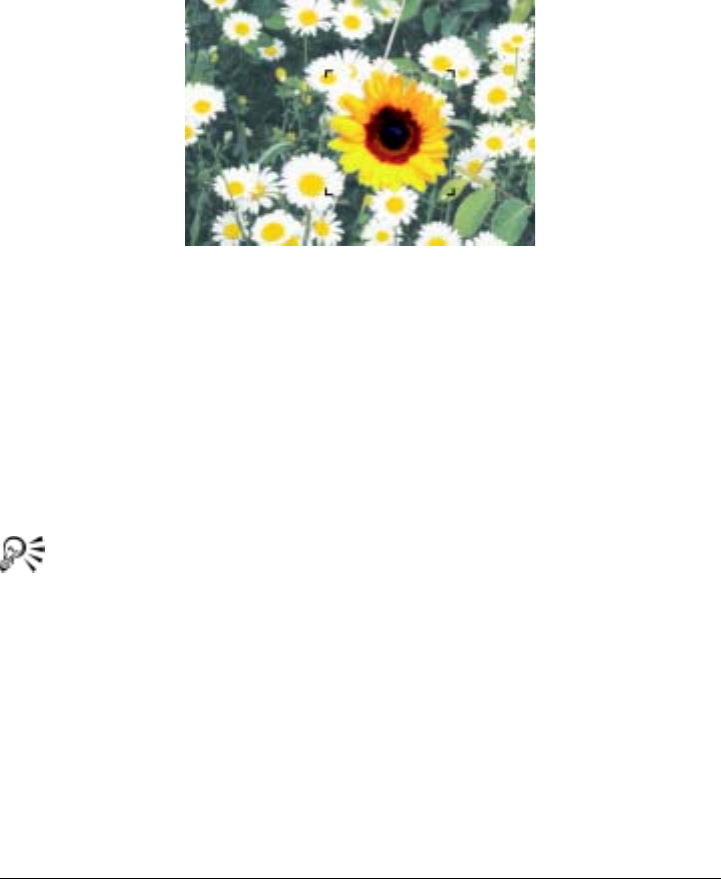
60 Corel Painter User Guide
Showing Layer Indicators
You can show the layer indicators to see display handles at the corners of a layer’s
content when it is selected. You can also display information about the size of a layer’s
content and its position on the canvas. For more information, see “Viewing Layer
Position” on page 59.
Show the layer indicators to mark the corners of a selected layer.
To display the Info palette
1Choose Window menu > Show Info.
If the palette is not expanded, click the palette arrow.
To show layer indicators
1On the Layers palette, select a non-Canvas layer.
2Click the palette menu arrow, and choose Show Layer Indicators.
To hide the layer indicators, click the palette menu arrow, and choose Hide
Layer Indicators.
Grouping Layers
Grouping layers enables you to control layers as a unit. A group can contain any
combination of layers: pixel-based layers, Watercolor layers, Liquid Ink layers,
vector-based shapes, and dynamic layers.

Layers 61
You can move, rename, hide, show, lock, and set options for a group just as you do for
a single layer. However, you cannot paint across layers in a group or change the
composite method for a group; you must collapse the group into a single layer if you
want to paint on it.
To work with individual layers in a group, you must open the group. To regain control
of the group as a unit, you must close the group. Collapsing a group reduces its
contents to a single layer.
If you create a layer with a button on the Layers palette, a Layers menu command, or a
keyboard shortcut when a layer within a group is selected, the new layer is added to
the group. If the group is selected, the layer is placed above the group.
To create a group
1On the Layers palette, select the layers you want to group.
For more information about selecting multiple layers, refer to “Selecting Layers” on
page 52.
2Do one of the following:
• Click the Layer Commands button , and choose Group.
• Click the palette menu arrow, and choose Group.
The layers are collected under a group item on the Layers palette.
If you select nonsequential layers (layers not next to each other in the list),
Corel Painter creates the group at the position of the topmost layer. To select
nonsequential layers, on the Layers palette, hold down Shift and click each
layer you want to select.
To open or close a group
•On the Layers palette, click the palette arrow to the left of the group.
When the arrow points down and you can see the group items, the group is
open. When the arrow points to the right and the names of the group members
are hidden, the group is closed.
To add or remove a layer in a group
1On the Layers palette, open the destination group.
2Perform an action from the following table.

62 Corel Painter User Guide
You can create a nested group by dragging a closed group to the open
destination group.
To ungroup layers
1On the Layers palette, select the group.
If the group is open, click the palette arrow to close it.
2Do one of the following:
• Click the Layer Commands button , and choose Ungroup.
• Click the palette menu arrow, and choose Ungroup.
To collapse a group
1On the Layers palette, select the group.
2Do one of the following:
• Click the Layer Commands button , and choose Collapse.
• Click the palette menu arrow, and choose Collapse.
If the group contains shapes, Liquid Ink layers, or dynamic layers, the Commit
dialog box is displayed. Click Commit All to convert the items to pixel-based layers
before collapsing the entire group.
If you want to collapse a group containing a Watercolor layer, you must first
convert the Watercolor layer to a default layer and change its composite
method to Default. For more information about composite methods, refer to
“Blending Layers by Using Composite Methods” on page 71.
Merging Layers with the Canvas
Dropping a layer or group merges its contents with the canvas. Once you drop a layer,
you can no longer access the layer’s content separately from the canvas. You can drop
specific layers or you can drop all layers at once.
To Do the following
Add a layer to a group Drag a layer to the group.
Remove a layer from a group Drag the layer out of the group.
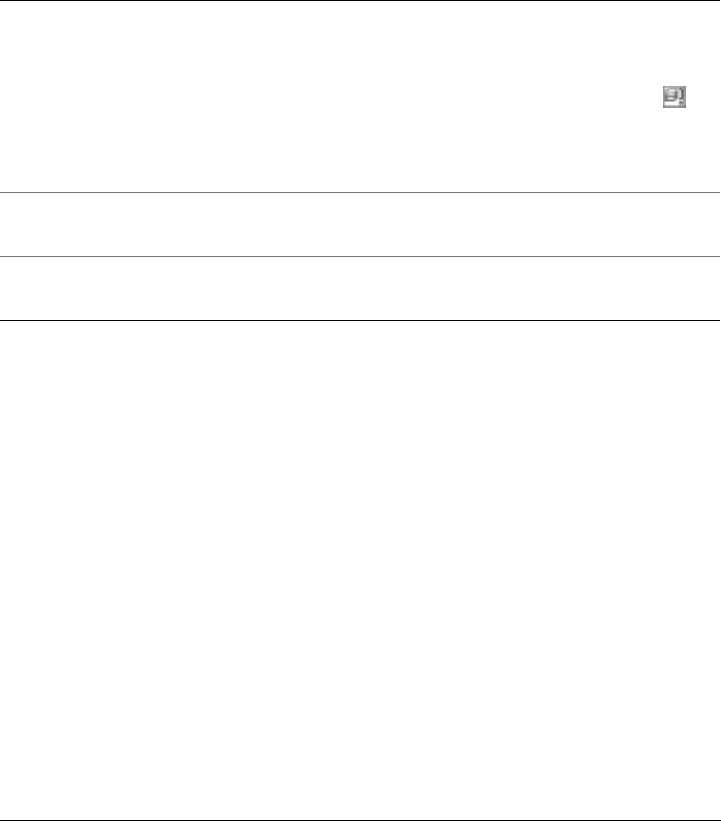
Layers 63
When you drop a layer, you can choose to create a selection based on the layer
contents. If the layer has a layer mask, the mask is used to make the selection. For
more information about layer masks, refer to “Working with Layer Masks” in the
Help. For more information about selections, refer to “Selections” in the Help.
To drop a layer
Editing Layers
You can paint on layers, and preserve layer transparency to prevent painting on
transparent areas. You can also move layer content to change the overall image layout.
Using selections, you can turn an area of a layer into a floating object so that you can
move it separately. Reference layers, low-resolution representations of an image, let
you quickly manipulate images in ways that might otherwise require more time.
You can edit a layer’s content by applying effects to it, such as drop shadows and
patterns, and by transforming its dimensions. You can also change a layer’s opacity,
and use composite methods to change how a layer blends with other layers. The
Image Portfolio lets you save the contents of a layer for future use.
Painting on Layers
When a layer is selected, you can use the brushes to paint, draw, erase, or clone. When
painting on layers, keep the following points in mind:
To Do the following
Drop specific layers On the Layers palette, select the layers (or
groups) that you want to drop, and do one of
the following:
•Click the Layer Commands button ,
and choose Drop.
•Click the palette menu arrow, and choose
Drop.
Drop all layers On the Layers palette, click the palette menu
arrow, and choose Drop All.
Make a selection by dropping a layer On the Layers palette, click the palette menu
arrow, and choose Drop and Select.

64 Corel Painter User Guide
• Watercolor brushes can be used only on Watercolor layers; on a Watercolor layer,
you can paint only with Watercolor brushes.
• Liquid Ink brushes can be used only on Liquid Ink layers; on a Liquid Ink layer, you
can paint only with Liquid Ink brushes.
• You can’t paint across grouped layers — you must collapse the group first. For
more information, see “To collapse a group” on page 62.
• Before painting on a shape, you must commit it to a pixel-based layer.
Corel Painter prompts you to commit a shape if you attempt to paint on it. Once
committed, you cannot re-access the shape’s vector controls. For more information,
see “To paint a shape” on page 350.
• You can protect areas of a layer from painting by creating a selection. For more
information, see “Creating Selections” in the Help.
• You can control what parts of a layer are visible and hidden by creating a layer
mask. For more information, refer to “Working with Layer Masks” in the Help.
To paint on a layer
1On the Layers palette, select a layer.
2On the Brush Selector bar, choose a brush category and variant.
3Paint on the layer in the document window.
The Preserve Transparency option on the Layers palette affects what areas of a layer
you can paint on. Refer to “Preserving Layer Transparency” on page 65 for more
information.
Brush Methods and Painting on Layers
The Natural-Media environment allows brush strokes on different layers to interact
with each other. However, mixing brush strokes that use the Cover and Buildup
methods on the same layer can produce unexpected results. This is caused by a conflict
between the brush method and the layer’s composite method.
• Brushes that use the Buildup method — such as those in the Felt Pens or Pencils
category — work best on layers that use the Gel composite method. In fact, when
you use the Buildup method to paint on a blank layer, Corel Painter automatically
sets the layer’s composite method to Gel.
• Brushes that use the Cover method work best on layers that are set to the Default
composite method.
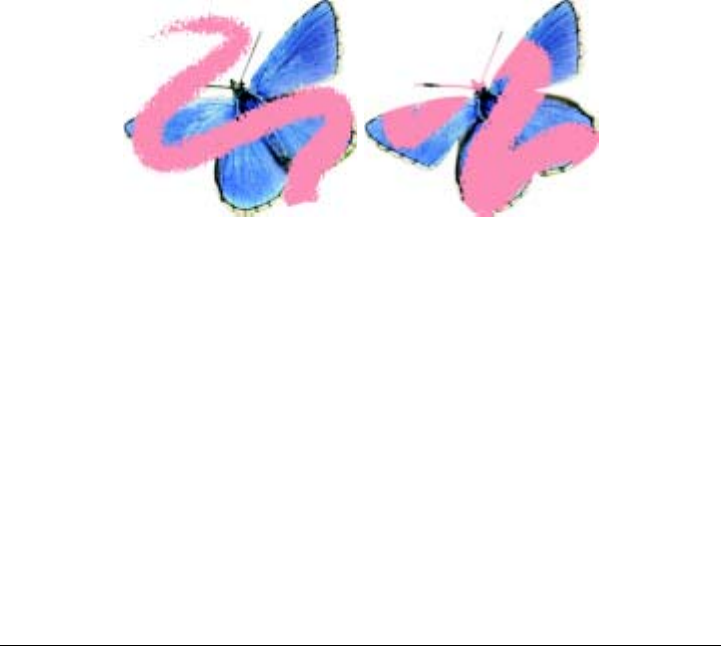
Layers 65
For more information about layer composite methods, refer to “Blending Layers by
Using Composite Methods” on page 71. For more information about brush methods,
refer to “Methods and Subcategories” on page 211.
Preserving Layer Transparency
Areas of a layer that don’t contain images are transparent. You can preserve the
transparent areas of a layer with the Preserve Transparency check box on the Layers
palette. This option affects which areas of a layer you can create images on. It also
affects the results of erasing or deleting images on a layer.
By default, the Preserve Transparency check box is disabled, which lets you paint
anywhere on the layer. When Preserve Transparency is enabled, the transparent areas
are preserved, and you are confined to painting on areas of the layer that already
contain images.
The results of painting on a layer with the Preserve Transparency option
disabled (left) and enabled (right).
If you want to paint on a shape, you must first commit the shape to a pixel-based layer.
For more information, see “To paint a shape” on page 350.
A good way to think about the Preserve Transparency option is in terms of a layer
mask. As described in “Working with Layer Masks” in the Help, a layer mask defines
the visible areas of a layer.
Preserve Transparency provides a powerful selective editing capability to create
interesting effects by altering the strokes you’ve already applied. For example, you can
enable Preserve Transparency to fill a set of hand-drawn letters with a pattern, a color
gradient, or other brush strokes.
Preserve Transparency also affects the results of cutting or erasing on a layer.

66 Corel Painter User Guide
• When Preserve Transparency is disabled, erasing or deleting images restores
transparency to the area and reveals the underlying image.
• When Preserve Transparency is enabled, erasing or deleting images reveals the
document’s paper color. In effect, erasing or deleting with Preserve Transparency
enabled is the same as painting or filling with the document’s paper color.
Erasing part of a layer (the top-right wing of the butterfly) with the
Preserve Transparency check box disabled restores transparency (left).
When the option is enabled, erasing reveals the paper color (right).
You can create a layer mask based on the layer’s transparency. A layer mask defines
which areas of a layer are visible in the document window. For more information, see
“Creating Layer Masks” in the Help.
To preserve layer transparency
•On the Layers palette, enable the Preserve Transparency check box.
You can also load a layer’s transparency to a selection. On the Layers palette,
hold down Control and click the layer (Mac OS), or right-click the layer
(Windows), and choose Select Layer Transparency. For more information
about selections, refer to “Selections” in the Help.
Working with Floating Objects
You can make a selection on a layer using the Rectangular Selection, Oval Selection,
Lasso, or Magic Wand tool. Selections on layers function in the same way as selections
on the canvas — you can use them to constrain brush strokes, to isolate an area of the
layer for applying an effect, or to choose an area of the layer to cut or copy. For more
information about working with selections, see “Selections” in the Help.

Layers 67
By default, when you move a selection, only the selection marquee moves, not the
images. To move selected images on a layer, you must “float” the selection. In effect,
this turns the selected area of the layer into a floating object. You can move floating
objects around a layer to create new compositions.
Each layer in a document can have only one floating object at a time. You can drop a
floating object to merge it with the layer. Many operations automatically drop (or
merge) the floating object back to its parent layer.
Floating objects are created by making a selection on a pixel-based layer. Shapes
cannot be floating objects because they are vector-based. However, you can turn a
shape into a pixel-based layer. For instructions, see “To convert a shape to a pixel-based
layer” on page 329
When you save a document to RIF format, Corel Painter preserves all floating objects.
However, saving a document in a non-RIF format automatically drops floating objects
onto their parent layers.
To create a floating object
1Create a selection on a layer using a selection tool.
2Do one of the following:
• Click the selection with the Layer Adjuster tool .
• Choose Select menu > Float.
The floating object appears as an item below the parent layer on the Layers palette.
To reposition or drop a floating object
1On the Layers palette, select the floating object.
2Perform an action from the following table.
To Do the following
Repositon a floating object In the document window, drag the floating
object to the new location with the Layer
Adjuster tool . Then, press the arrow keys
to move the floating object one pixel at a
time.
Drop a floating object Click the Layer Commands button , and
choose Drop.

68 Corel Painter User Guide
Adding Drop Shadows
Adding shadows to a layer’s content can enhance the appearance of an image. You can
add a drop shadow to a single layer or to a group.
Drop shadows are also helpful for developing Image Hose nozzles. For more
information, refer to “Preparing Images” in the Help.
When you add a drop shadow, Corel Painter creates a new layer for the shadow and
groups it with the original. This enables you to select and modify the drop shadow
layer independently from the original layer.
To add a drop shadow
1Select a layer or group.
2Choose Effects menu > Objects > Create Drop Shadow.
3In the Drop Shadow dialog box, type values in the following boxes:
• X-Offset and Y-Offset specify the distance, in pixels, from the center of the layer
image to the shadow.
• Opacity specifies the degree to which the shadow covers underlying images.
Setting Opacity to 100% obscures underlying images; lower values create a
more transparent shadow.
• Radius specifies the amount of blur at the edge of the shadow. The radius is half
the distance across the blurred region. If you set Radius to zero, you create a
sharp-edged shadow.
• Angle specifies the direction of the blur.
• Thinness specifies the amount of blur applied perpendicular to the Angle. If a
blur shows streaks, increase Thinness to soften it.
If you want to merge the drop shadow layer with the image layer, enable the
Collapse to One Layer check box.
Creating Patterns on Layers
You can use the same techniques to create patterns on layers as you do to create them
on the canvas. However, a pattern’s wrap-around features do not apply to layers. This
is because the canvas has edges, but layers do not — they are unlimited in size. If you
shift a pattern on a layer, the pattern does not wrap around. Refer to “Using Patterns”
on page 120 for more information.
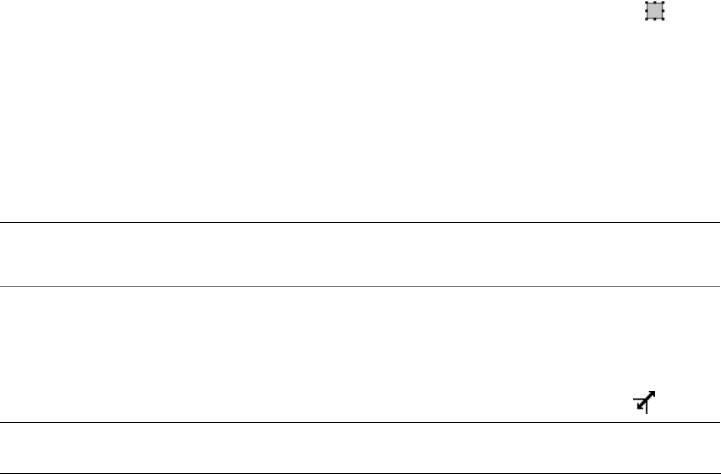
Layers 69
Working with Reference Layers
Reference layers get their image content from an external source — either a pixel-
based layer in the current document or a separate file. They provide a low-resolution
representation of the original image that you can quickly manipulate in ways that
would otherwise require more time. Working with a reference layer allows you to
transform (resize, rotate, or slant) a layer onscreen by dragging its handles. You can
adjust various options. Transformations are immediately displayed in the document
window. When you finish applying transformations, you commit the reference layer
back to a standard layer. Corel Painter examines the source image to restore the
original resolution.
You cannot edit the image data in a reference layer. If you try to paint on or apply
effects to a reference layer, Corel Painter prompts you to commit it back to a
pixel-based layer.
You can create a reference layer by basing it on an existing layer or by placing an
image. For more information about placing images, see to “Placing Files” on page 19.
To create a reference layer
1Select a layer.
2Choose Effects menu > Orientation > Free Transform.
The layer’s icon on the Layers palette changes to an eight-handled square , and
an eight-handled box marks the boundary of the layer’s contents in the document
window.
To transform a reference layer
• Select a reference layer.
To Do the following
Resize a reference layer in one direction Drag a side handle to resize the layer in one
direction only.
Resize a reference layer in more than
direction Drag a corner handle to resize the layer in
two directions at once. If you want to
maintain the layer proportions, hold down
Shift as you drag. The pointer changes when
you position it over a corner handle .

70 Corel Painter User Guide
To set reference layer options
1Select a reference layer.
2Choose Effects menu > Orientation > Set Transform.
3In the Set Transform dialog box, adjust any of the following settings:
• Retain Alpha works with placed images to retain the file’s alpha channel. When
the image is placed, the channel becomes the layer mask. Disable this option to
discard the channel.
• Horizontal and Vertical define the scaling relationship between the reference
layer and the source layer. If the scaling is low, 33% for example, and you
increase it, Corel Painter refers to the source layer to obtain more pixel data.
• Constrain Aspect Ratio maintains the proportions of the image. Disable this
option to distort the image proportions.
• Rotation and Slant rotates or slants the layer based on an original position of 0°.
Enter positive values to rotate or slant the layer counterclockwise; enter
negative values to rotate or slant the layer clockwise.
• Fast sets a high sampling ratio to produce a low-resolution reference layer. A
low-resolution reference layer contains less information, so it can be
transformed quickly.
• Clean sets the sampling ratio at 1 to 1 to produce a reference layer of the
highest possible resolution — up to that of the source. This shows a better
image as you work, but takes much longer to calculate transformations.
The Quality setting (Fast or Clean) applies only to the quality of the reference
layer. When you convert a reference layer to a pixel-based layer, Corel Painter
resamples the original image to produce the best possible resolution.
Rotate a reference layer Hold down Command (Mac OS) or Ctrl
(Windows), and drag a corner handle. The
pointer changes when you position it over a
corner handle .
Skew a reference layer Hold down Command (Mac OS) or Ctrl
(Windows), and drag a side handle. The
pointer changes when you position it over a
side handle .
To Do the following
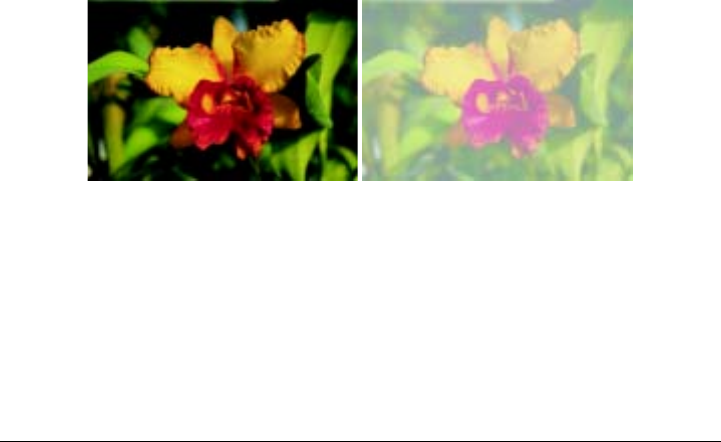
Layers 71
Reference Image shows the pixel dimensions of the original image. This is
static information — you can’t change the Reference Image values.
To commit a reference layer
1Select a reference layer.
2Choose Effects menu > Orientation > Commit Transform.
The conversion process might take a few seconds, depending on the size and
quality of the layer.
Setting Layer Opacity
You can adjust a layer’s opacity to create different levels of transparency. The Opacity
slider covers a range of 0% (completely transparent) to 100% (completely opaque).
To change a layer’s opacity
1Select the layer you want to change.
2On the Layers palette, do one of the following:
• Move the Opacity slider.
• Type a percentage in the Opacity box, and press Return (Mac OS) or Enter
(Windows).
The example on the left shows the background layers at 100% opacity. The
example on the right shows them at 50% opacity.
Blending Layers by Using Composite Methods
A layer’s composite method controls how it interacts with the underlying image. You
can change composite methods to create special effects without changing the actual
images that make up a document.

72 Corel Painter User Guide
Corel Painter provides two types of composite settings:
• Composite Method sets the standard composite method.
• Composite Depth controls how a layer’s image data interacts with depth
information on the canvas and other layers.
For example, if the canvas contains Impasto brush strokes, the Composite Depth
setting determines what happens when these brush strokes intersect with brush strokes
on the layer. Refer to “Blending Impasto with Other Layers” on page 185 for more
information about Composite Depth options.
You can set a different composite method for every layer in a document. Keep in mind
the role of the underlying image in creating an effect — you might achieve an
unexpected result if the underlying image is solid black or white.
The best way to understand the different composite methods is by seeing them in
action. Quickly cycle through a layer’s composite methods to create new and
interesting versions of your image. For a comparison of Corel Painter composite
methods and Adobe PhotoShop blend modes, see “Saving Files That Contain Layers”
on page 51.
To change a layer’s composite method
1Select a layer.
2On the Layers palette, choose a composite method from the Composite Method
pop-up menu.
Adding Notes to a Layer
In the Layer Attributes dialog box, you can attach additional information to a layer by
adding notes to it.
To record notes for a layer
1Select a layer or group.
2Do one of the following:
• Choose Layers menu > Layer Attributes.
• Click the palette menu arrow on the Layers palette, and choose Layer
Attributes.
3Type in the Note box.
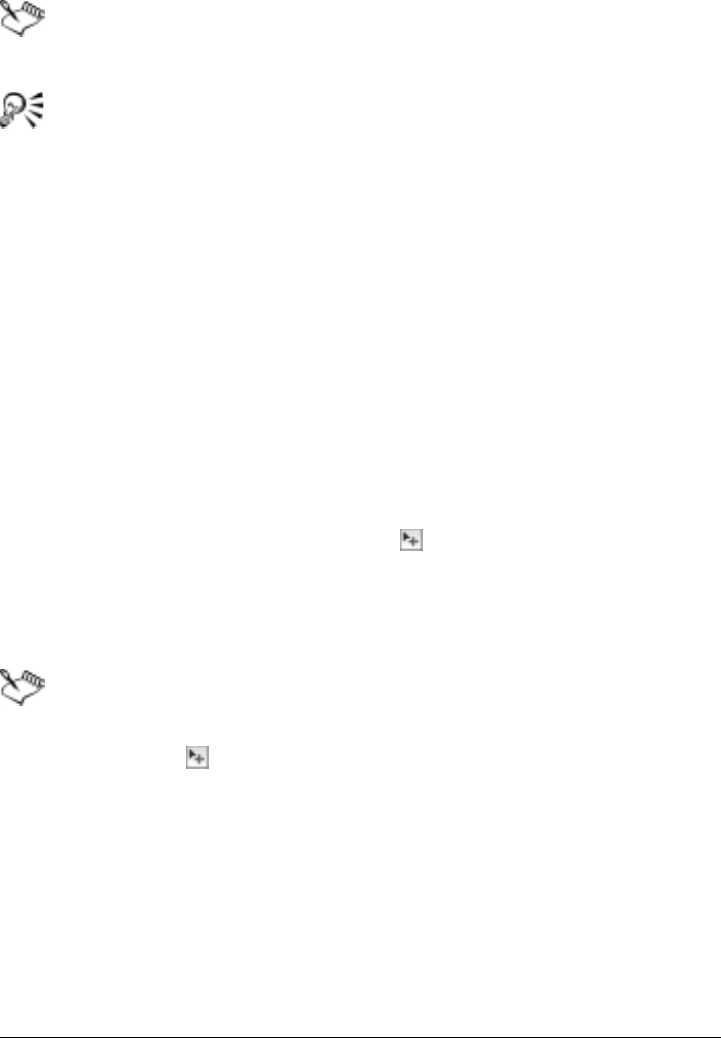
Layers 73
You cannot record notes for a layer if you enable the WWW Map Clickable
Region check box for image mapping.
You can also record notes for pixel-based layers and reference layers, by
double-clicking the item on the Layers palette, or selecting an item and press
Return (Mac OS) or Enter (Windows).
Storing Images with the Image Portfolio
The Image Portfolio is a convenient place to store images you that want to use again.
To display the Image Portfolio palette
1Choose Window menu > Show Image Portfolio.
If the Image Portfolio palette is not expanded, click the palette arrow.
To add a layer to the Image Portfolio
1Select a layer.
2In the toolbox, click the Layer Adjuster tool .
3Drag the layer from the document window to the Image Portfolio palette.
The layer is cut from the current document.
4In the Save Image dialog box, type a name in the Save As box.
To copy the layer from the current document, hold down Option (Mac OS) pr
Alt (Windows), and drag it to the Image Portfolio palette using the Layer
Adjuster tool .
The Image Portfolio holds only pixel-based layers. If you want to add a shape,
Watercolor, Liquid Ink, or dynamic layer to the Image Portfolio, you must
first convert it to a default layer. On the Layers palette menu, click Convert to
Default Layer.
To use an image from the Image Portfolio
•Drag an item from the Image Portfolio palette to the document window.

74 Corel Painter User Guide
Corel Painter places the Image Portfolio item in a new layer.
Organizing Layers with Image Portfolio Libraries
You can create your own Image Portfolio libraries to organize layers by category. When
you’re creating a library, keep in mind that the smaller the library, the easier it will be
to see its contents at a glance.
The Image Mover command on the Image Portfolio palette menu lets you move items
between Image Portfolio libraries. For more information about moving items between
libraries, refer to “Libraries and Movers” in the Help.
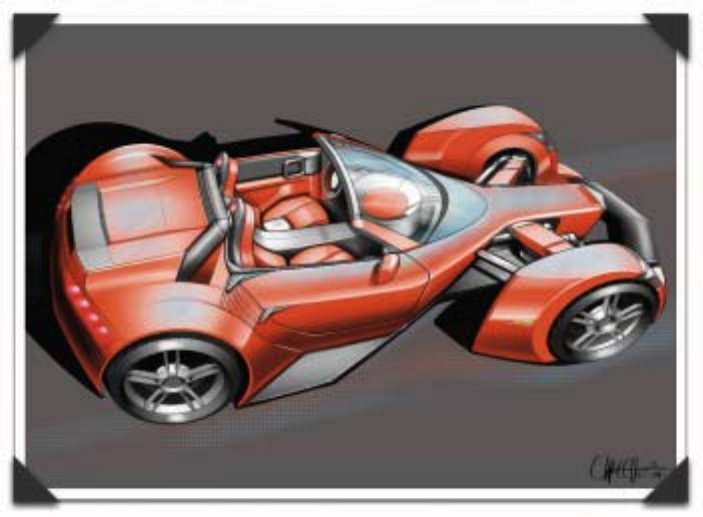
Art by Christopher Welch: Concept vehicle design
Christopher Welch has worked as a primary designer in the "Advanced" Studio at the automotive
supply company Magna, later renamed Intier Automotive. Recently, he began working at
DaimlerChrysler, creating automotive interiors and exteriors. In addition to automotive design,
Chris does freelance concept design work for the toy and entertainment industry.

Color 77
Color
Corel Painter offers many ways to apply color to your image. For example, you can
change the paper color, choose colors for your brush strokes, or apply gradients to an
entire image or selection.
Getting Started with Color
You can select colors in several ways. You can use
• the color squares on the Colors palette
• the Dropper tool, which samples color from the image
• the Use Clone Color setting, which pulls color from a source
• the Mixer palette
• the Color Sets palette
The Colors palette is one place where you can select a color to add to your image.
Changing the Paper Color
You can change a document’s paper color — the color of the background canvas — at
any time. This color appears when you delete a filled area or use a brush from the
Erasers category to remove color.
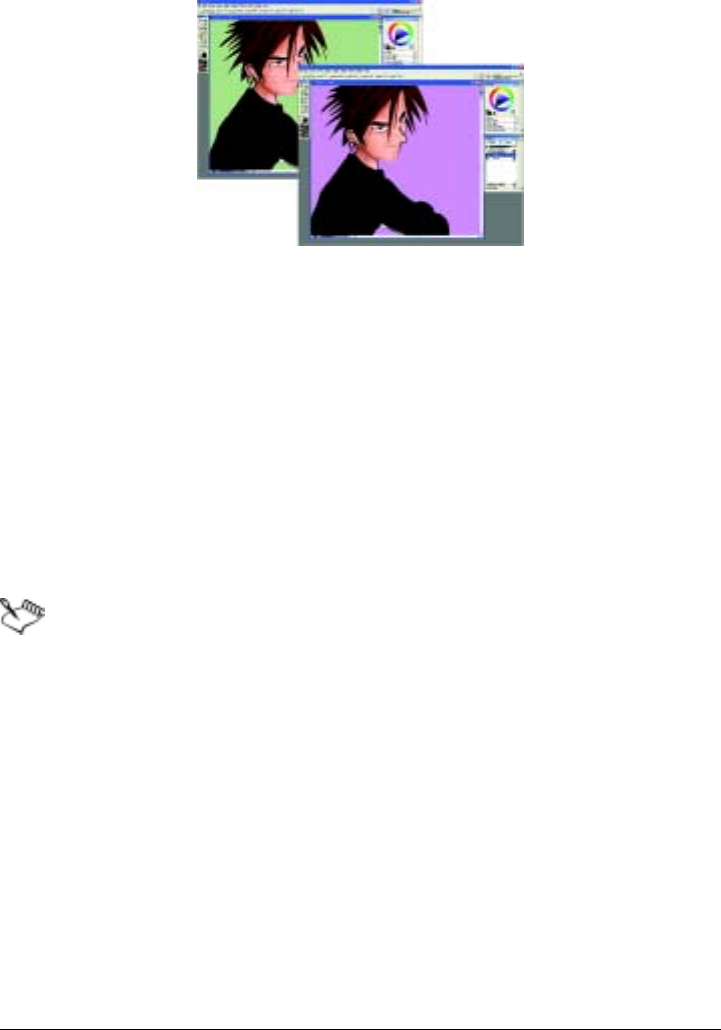
78 Corel Painter User Guide
An example of changing the paper color.
To display the Colors palette
•Choose Window menu > Color Palettes > Show Colors.
To change the existing paper color
1Choose a main color from the Colors palette.
2Choose Canvas menu > Set Paper Color.
3To expose the new paper color, do one of the following:
• Make a selection, and cut or delete it.
• Use a brush from the Erasers category to erase part of your image.
Do not use a bleach variant to expose the new paper color unless the paper
color is white. Bleach variants erase to white, regardless of the paper color.
Using the Colors Palette
You can configure the Colors palette to display in two ways: standard and small.

Color 79
The Color palette configured as standard (left) and small (right).
By default, the Colors palette displays in its standard configuration, which includes the
Hue Ring and the Saturation/Value Triangle.
• Values span the triangle from top to bottom, with the top of the triangle being the
highest value (white) and the bottom being the lowest value (black).
• Saturation levels go from left to right. Dragging or clicking to the right produces
the purest color within the predominant hue. Dragging or clicking to the left
reduces the level of color saturation, producing “muddier” or grayer colors.
In its small configuration, the Colors palette displays a color triangle and indicates
hues on a single bar (the “hue indicator”).
To configure the Colors palette for small display
1Choose Window menu > Color Palettes > Show Colors to display the Colors
palette.
If the Colors palette is not expanded, click the palette arrow.
2Click the palette menu arrow, and choose Small.
To choose a hue and color from the Colors palette
1Choose Window menu > Color Palettes > Show Colors to display the Colors
palette.
If the Colors palette is not expanded, click the palette arrow.
2Click the palette menu arrow, and choose one of the following:
• Standard Colors to display the Colors palette in its default state.
• Small Colors to display the small configuration of the Colors palette.
3Do one of the following:
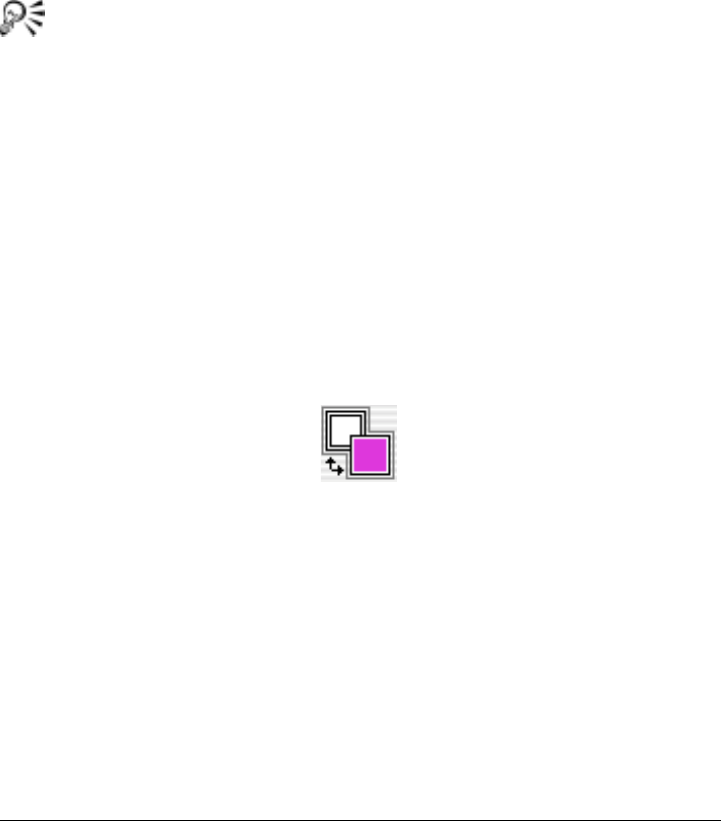
80 Corel Painter User Guide
• If you use the Standard Colors display, drag the circle on the Hue Ring to select
the predominant hue.
• If you use the Small Colors display, drag the circle on the Hue Ring to select the
predominant hue.
The Saturation/Value Triangle displays all available colors within that selected hue.
4Select a color on the Saturation/Value Triangle by dragging the circle or by clicking
the color you want.
You can also select a hue by clicking once anywhere on the Hue Ring
(Standard Colors) or on the hue indicator (Small Colors).
Understanding Main and Additional Colors
The color you select appears in one of two overlapping squares displayed on the Colors
palette. The front square represents the selected main color. The back square shows the
selected additional color. By default, blue is the main color, and white is the additional
color. Most of the time, you work with the main color.
Don’t confuse the additional color with what other graphics programs call “the
background color.” In Corel Painter, the “background color” is the paper color.
The additional color is for multicolor brush strokes, two-point gradients, and Image
Hose effects. It’s used when more than one color is applied.
Overlapping squares display the current main and additional colors.
To choose the main color
1Choose Window menu > Color Palettes > Show Colors to display the Colors
palette.
2Double-click the front square.
3Choose a color from the Colors dialog box.

Color 81
Click the front square to set the main color.
To choose the additional color
1On the Colors palette, double-click the back square.
2Choose a color from the Colors dialog box.
Click the back square to set the additional color.
If you usually work with the main color, you might want to re-click the front
square to reselect it.
To swap main and additional colors
•Click the Color Swap Icon .
Sampling Colors from Images
In addition to choosing colors on the Colors palette, you can use the Dropper tool to
select, or “pick up,” a color from an existing image.
To use the Dropper tool
1Click the front or back square to select a main or additional color.
2Click the Dropper tool in the toolbox.
3Move the cursor to the color you want to pick up, and click it.
The color square updates to display the color you’ve selected.
The Dropper tool picks up visible color only; it cannot be used to select a
hidden color.

82 Corel Painter User Guide
You can quickly access the Dropper tool by pressing D on the keyboard.
To access the Dropper tool from other tools
•Press Option (Mac OS) or Alt (Windows).
The Dropper tool works with the Brush, Crop, Pen, Rectangular Shape, Oval
Shape, Text, Shape Selection, Scissors, Add Point, Remove Point, Convert
Point, and Paint Bucket tools.
Cloning Color
The Clone Color option offers another way to choose color. This feature lets the brush
pick up dabs of color from an original (source) image. Brushes using dab-based dab
types take an average based on samples of color from the clone source, resulting in an
approximation of the original color. Brushes using rendered dab types sample several
colors, loading each into individual bristles of the brush, allowing for startlingly
realistic results. For more information about cloning, refer to “Cloning Images” on
page 273.
To set up a clone source
1Choose File menu > Open, and choose the file you want to use as a clone source.
2Choose File menu > Clone.
3Choose Select menu > All, and press Delete (Mac OS) or Backspace (Windows).
Now you can work in the new file, taking data from the original source file.
You can also use this feature when creating a mosaic. For more information,
see “Mosaics” on page 307.
To use clone colors
1Set up a clone source.
If you don’t set a file as the source, Corel Painter uses the currently selected
pattern.
2Choose a brush from the Brush Selector bar.
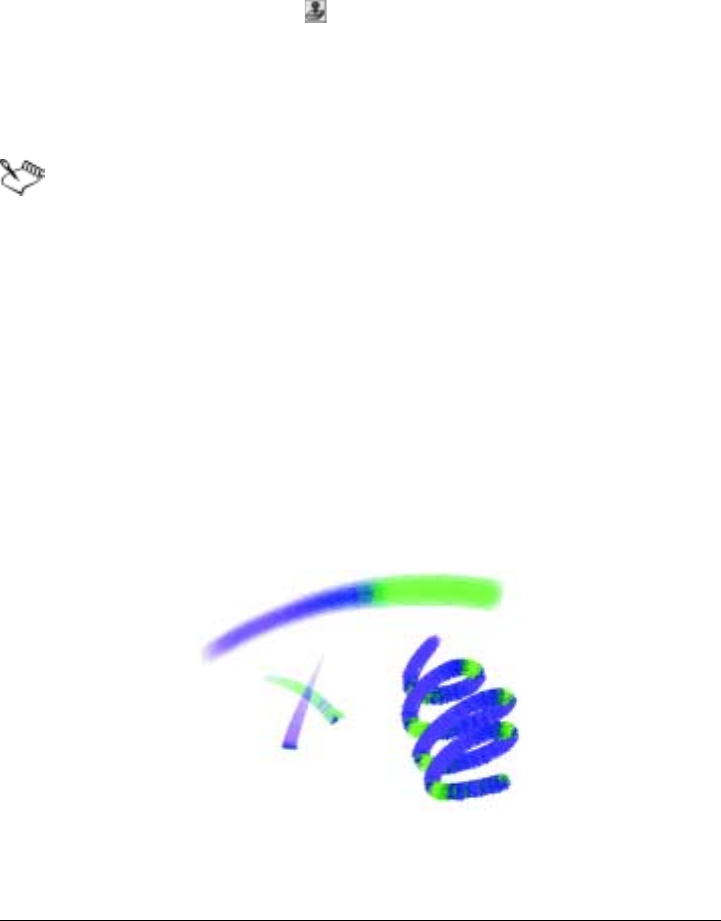
Color 83
3Choose Window menu > Color Palettes > Show Colors to display the Colors
palette.
4Do one of the following:
• Click the palette menu arrow, and choose Use Clone Color.
• Click the Clone Color button on the Colors palette.
Enabling the Clone Color option disables the Colors palette. This is a reminder that
your color information is coming from the clone source.
5When you paint in the clone file, Corel Painter uses colors from the clone source
image.
When you change the brush or variant, Corel Painter turns Use Clone Color
off. Be sure to turn it back on to continue working with the clone color.
Using Two Colors at Once
Usually, you’ll work with only the main color — the front square of the two
overlapping squares on the Colors palette. Using one color produces a solid-color brush
stroke.
By selecting an additional color, you can determine the colors for multicolored brush
strokes. Many brush variants are able to paint with a variable range of colors.
The settings on the Color Expression palette determine when Corel Painter uses one
color or the other. For more information about using color expression, see “Setting
Color Expression” on page 103.
You can use two colors at once in a brush stroke.

84 Corel Painter User Guide
To set up a two-color brush stroke
1Choose a brush from the Brush Selector bar.
2Choose Window menu > Color Palettes > Show Colors to display the Colors
palette.
3Choose a main and additional color from the Color palette.
Refer to “Understanding Main and Additional Colors” on page 80 for more
information about setting main and additional colors.
4Choose Window menu > Brush Controls > Show Color Expression to display the
Color Expression palette.
5From the Controller pop-up menu, choose Direction.
6Paint in the document.
The main color is used in one direction, and the additional color is used in the
other.
You can also choose a color from a color set. For more information, see
“Working with Color Sets” on page 92.
You might want to try a different setting from the Controller pop-up menu
on the Color Expression palette. Try setting it to Pressure instead of Direction.
For more information, see “Setting Color Expression” on page 103.
Working with the Mixer Palette
The Mixer palette mimics the traditional experience of mixing colors on an artist’s
palette. You can apply two or more colors to the Mixer pad, blending them together to
get the color you want.
Colors can be saved, loaded, and reset on the Mixer palette, saved as mixer swatches,
and saved to color sets.
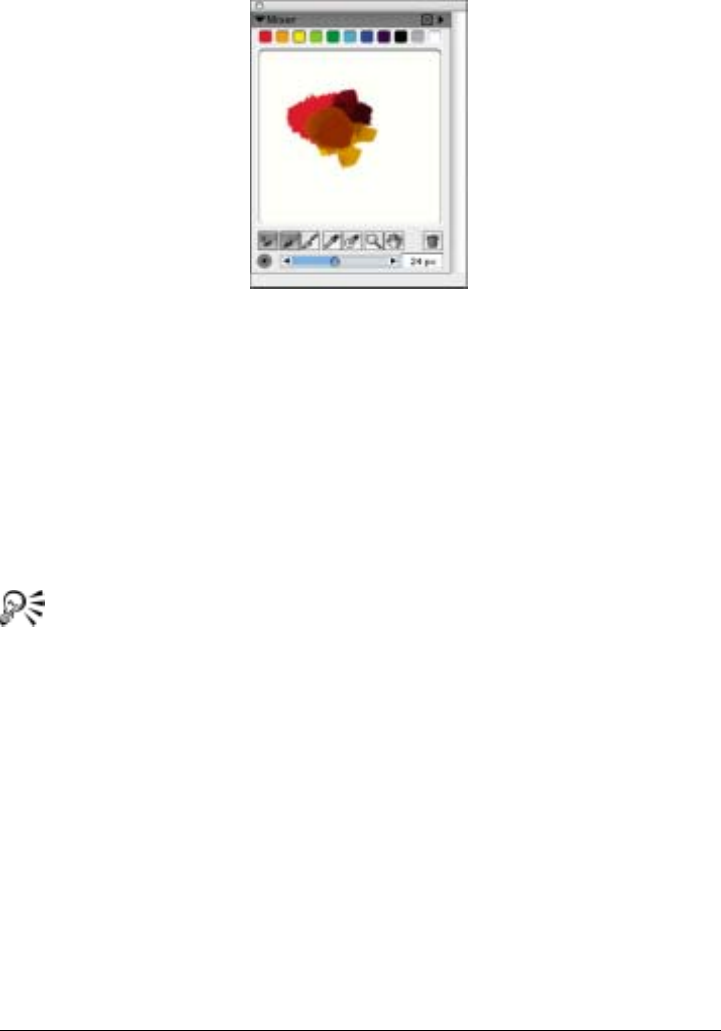
Color 85
The Mixer palette.
Viewing the Mixer Palette
You can view the Mixer palette from the Window menu or with a keyboard shortcut.
You can also change the background of the Mixer pad, the surface on which you mix
color.
To display the Mixer palette
•Choose Window menu > Color Palettes > Show Mixer.
You can also display the Mixer palette by pressing Command + 2 (Mac OS)
or Ctrl + 2 (Windows).
To change the Mixer Pad background
1Choose Window menu > Color Palettes > Show Mixer.
2Click the palette menu arrow, and choose Change Mixer Background.
3In the Color dialog box, choose a background color.
Understanding the Mixer Palette Tools
The tools on the Mixer palette are used to apply, mix, sample, and clear color on the
Mixer pad.
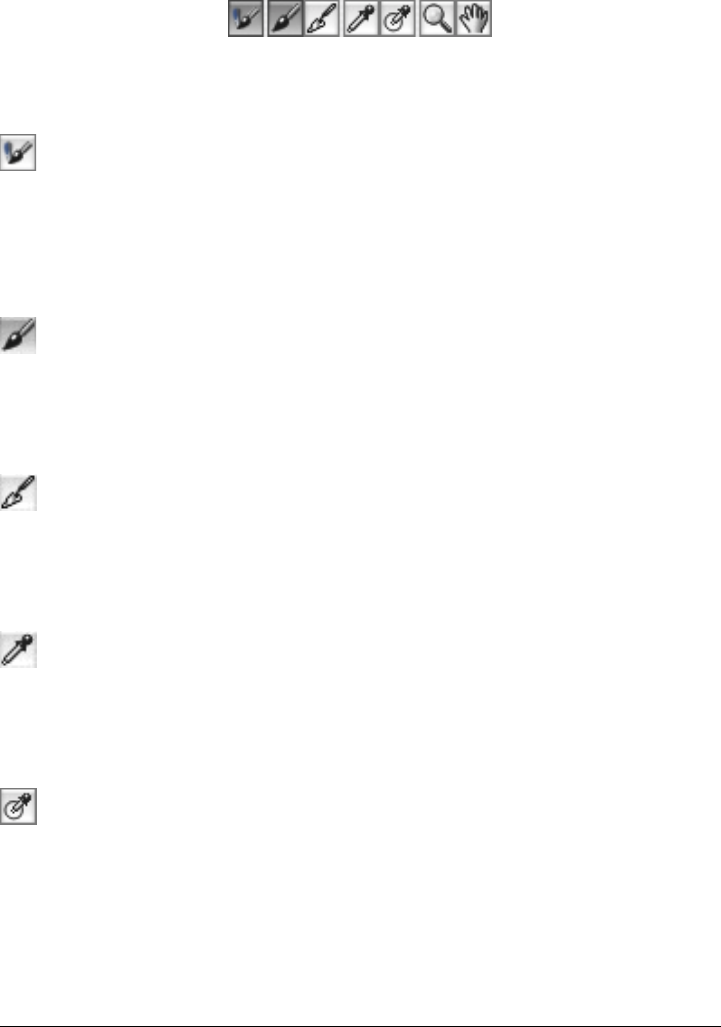
86 Corel Painter User Guide
The Mixer palette tools.
The Dirty Brush Mode Tool
When using an Artists’ Oils brush variant, the Dirty Brush Mode tool lets you apply
colors mixed in the Mixer palette to the canvas. The Dirty Brush Mode tool is active by
default.
Apply Color Tool
The Apply Color tool acts as a loaded paint source, applying color to the Mixer pad.
Color loaded on it also blends with color already on the Mixer pad.
The Mix Color Tool
The Mix Color tool mixes colors already on the Mixer pad. It does not add new colors
to the Mixer pad.
The Sample Color Tool
The Sample Color tool samples color on the Mixer pad for use on the canvas. The
sampled color becomes the main color on the Colors palette.
The Sample Multiple Colors Tool
The Sample Multiple Colors tool samples multiple colors on the Mixer pad. The size of
the sample area is determined by the Change Brush Size slider. You can then use the
sampled color on the canvas with an Artists’ Oils brush.
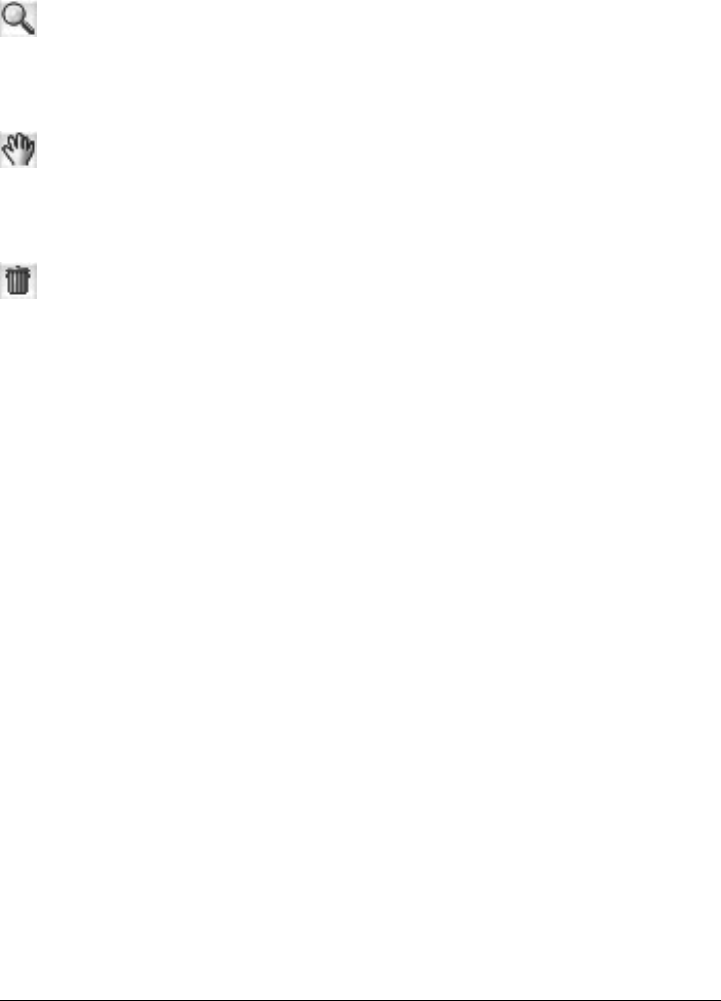
Color 87
The Zoom Tool
The Zoom tool lets you zoom in and out of areas on the Mixer pad.
The Pan Tool
The Pan tool lets you scroll through the Mixer pad.
The Clear and Reset Canvas Tool
The Clear and Reset Canvas tool erases the contents of the Mixer pad and resets the
zoom level to 100%.
The Brush Size Slider
The Change Brush Size slider lets you increase or decrease the size of the Apply Color
tool and the Mix Color tool. The Change Brush Size slider also lets you set the size of
the sample area on the Mixer pad when sampling with the Sample Multiple Colors
tool. If you adjust the Change Brush Size slider, the new value is retained when you
reopen the application.
Using the Mixer Palette Colors
You can store commonly used colors in mixer swatches at the top of the Mixer palette
and then use these colors on the Mixer pad. A series of colors appears by default;
however, this color series can be changed to suit the individual preferences of the artist.
Mixer colors can be saved, loaded, and reset to the default.
To change Mixer palette colors
1Choose Window menu > Color Palettes > Show Mixer to display the Mixer
palette.
If the Mixer palette is not expanded, click the palette arrow.
2Choose Window menu > Color Palettes > Show Colors to display the Colors
palette.

88 Corel Painter User Guide
3On the Colors palette, choose a color.
4On the Mixer palette, choose the mixer swatch you want to change on the Mixer
Color selector.
5In the color well, press Command + click (Mac OS) or Ctrl + click (Windows).
The new color appears in the mixer swatch.
To save Mixer palette colors
1Choose Window menu > Color Palettes > Show Mixer to display the Mixer
palette.
2Click the palette menu arrow, and choose Save Mixer Colors.
3In the Save Mixer Colors dialog box, type a name for the mixer colors and choose
where you want to save the mixer swatches (MSW) file.
4Click Save.
To load Mixer palette colors
1Choose Window menu > Color Palettes > Show Mixer to display the Mixer
palette.
2Click the palette menu arrow, and choose Load Mixer Colors.
3In the Load Mixer dialog box, choose the mixer swatches (MSW) file you want to
load.
4Click Open.
You can also load a color set in the Mixer palette. Click the palette menu
arrow, and choose Load Mixer Colors. In the Load Mixer dialog box, go to the
Corel Painter IX\Color Sets folder, and double-click a color set.
To reset the Mixer palette colors
1Choose Window menu > Color Palettes > Show Mixer to display the Mixer
palette.
2Click the palette menu arrow, and choose Reset Mixer Colors.

Color 89
Mixing Colors
Using the Mixer pad, the mixer swatches, and the Apply Color, Mix Color, Sample
Color, Sample Multiple Colors, and Dirty Brush Mode tools, you can create new colors
for use in your images.
When you have finished mixing and sampling colors, you can clear the Mixer pad, or
save it as a Mixer pad (MXS) file that you can open and use later.
To mix colors
1Choose Window menu > Color Palettes > Show Mixer to display the Mixer
palette.
2Click the Apply Color tool in the Mixer palette.
3Choose a color from the mixer swatch, and paint on the Mixer pad.
4Choose a second color from the mixer swatch, and paint on the Mixer pad.
5Do one of the following:
• Use the Apply Color tool to add to and blend the colors.
• Use the Mix Color tool to blend the colors.
You can toggle between the Apply Color and Mix Color tools by holding down
Command (Mac OS) or Ctrl (Windows).
When working with the Apply Color or Mix Color tool, you can access other
Mixer palette tools as you work. Holding down Spacebar activates the Pan
tool . Holding down Spacebar + Command (Mac OS) or Spacebar + Ctrl
(Windows) activates the Zoom tool in zoom-in mode. Holding down
Spacebar + Command + Option (Mac OS) or Spacebar + Ctrl + Alt
(Windows) activates the Zoom tool in zoom-out mode. When you release the
keys, the Apply Color or Mix Color tool is reactivated.
To sample a color from the Mixer Pad
1Choose Window menu > Color Palettes > Show Mixer to display the Mixer
palette.
2Click the Sample Color tool .
3On the Mixer pad, click the color you want to sample.
The sampled color becomes the main color in the image.
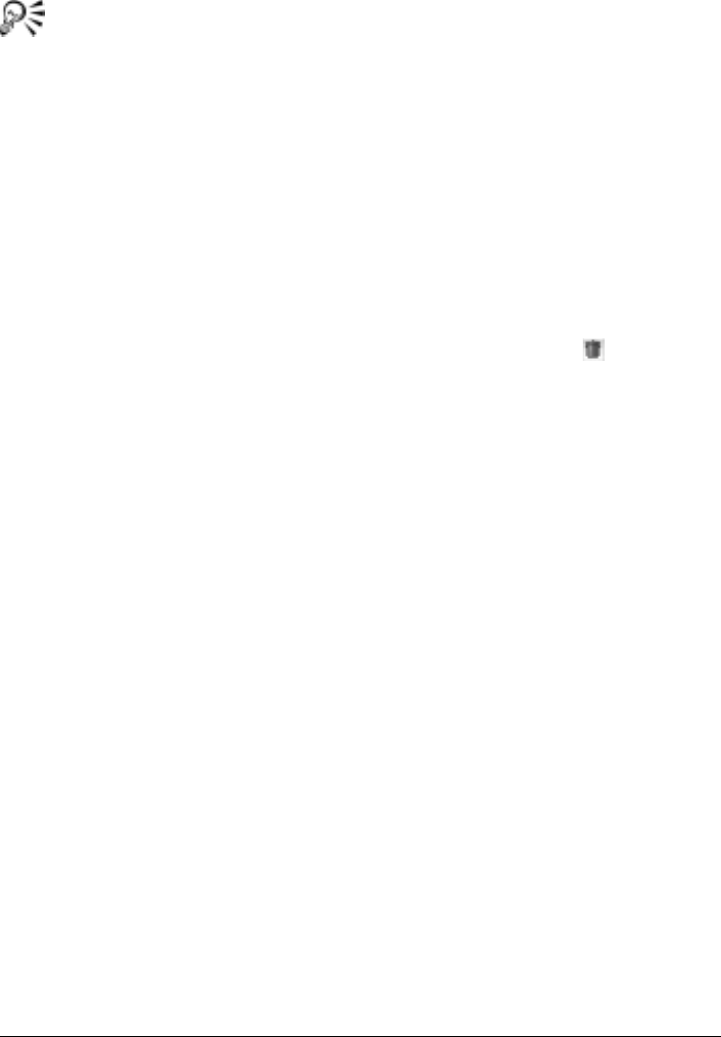
90 Corel Painter User Guide
When painting with an Artists’ Oils brush, you can sample multiple colors
from the Mixer pad. You can also mix Artists’ Oils paint on the canvas with an
Artists’ Oils palette knife variant. Unlike palette knives in other brush
categories, Artists’ Oil palette knives do not apply color. For more
information, see “To sample multiple colors” on page 91.
To clear the Mixer Pad
1Choose Window menu > Color Palettes > Show Mixer to display the Mixer
palette.
2Do one of the following:
• Click the palette menu arrow, and choose Clear Mixer Pad.
• On the Mixer palette, click the Clear and Reset Canvas button .
To save a Mixer Pad
1Choose Window menu > Color Palettes > Show Mixer to display the Mixer
palette.
2Click the palette menu arrow, and choose Save Mixer Pad.
3In the Save Mixer Pad dialog box, type a name for the mixer colors, and choose
where you want to save the Mixer Pads (MXS) file.
4Click Save.
To load a Mixer Pad
1Choose Window menu > Color Palettes > Show Mixer to display the Mixer
palette.
2Click the palette menu arrow, and choose Open Mixer Pad.
3In the Open Mixer Pad dialog box, choose the Mixer Pads (MXS) file you want to
open.
4Click Open.

Color 91
Mixing Artists’ Oils Paint
On its own, the Mixer palette mimics the traditional experience of mixing color on a
palette. When used in tandem with an Artists’ Oils brush variant, the Mixer palette
offers digital artists as much color-mixing flexibility as its traditional counterpart. You
can create a color on the Mixer palette and apply it to the canvas. You can also sample
and paint with multiple colors.
To paint with Artists’ Oils color from the Mixer palette
1Mix the color you want on the Mixer palette.
The Dirty Brush Mode tool is active by default. If it isn’t, click the Dirty Brush
Mode tool.
2On the Brush Selector bar, choose an Artists’ Oils brush variant.
3Paint in the document window.
The last color on the Apply Color tool or Mix Color tool is used in the brush
stroke.
You can also mix Artists’ Oils paint on the canvas with an Artists’ Oils palette
knife variant. Unlike palette knives in other brush categories, Artists’ Oil
palette knives do not apply color.
To sample multiple colors
1Mix the color you want on the Mixer palette.
2Move the Change Brush Size slider to set the size of the sample area.
The size to the sample area is displayed to the right of the slider and measured in
pixels.
3Click the Sample Multiple Color tool , and click the click the area of the Mixer
pad you want to sample.
Creating Mixer Swatches
If you have mixed colors that you are particularly happy with, you can save them as
mixer swatches and add them to color sets. For more information about color sets, see
“Using Color Sets” on page 92.
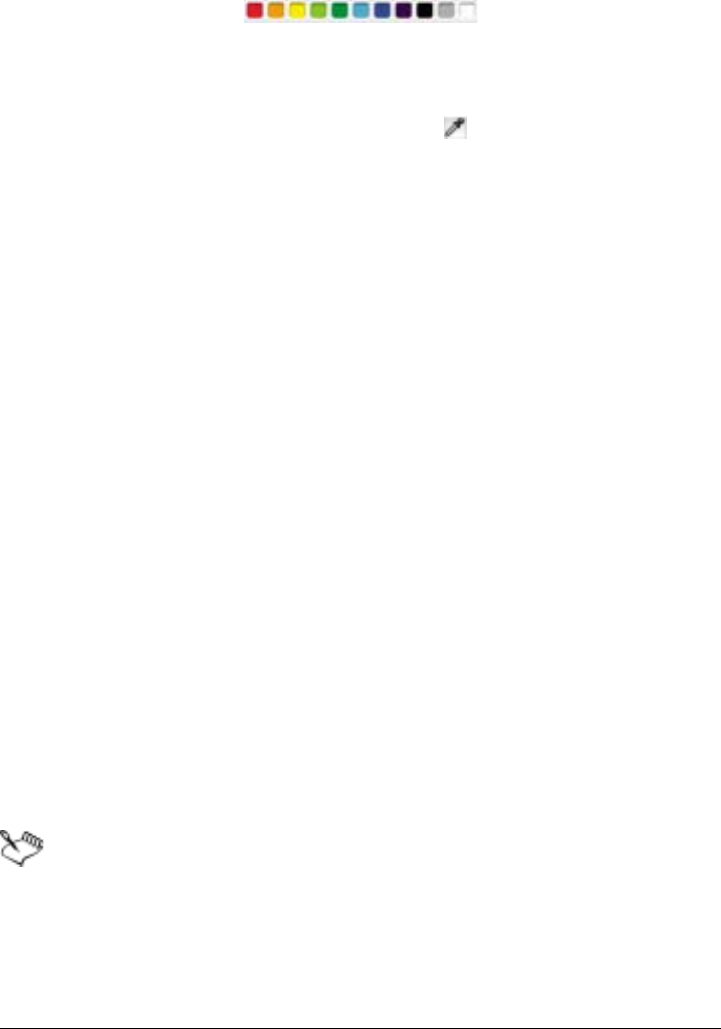
92 Corel Painter User Guide
Mixer swatches that you create on the Mixer palette can be saved.
To add a mixer swatch to the color set
1On the Mixer palette, click the Sample Color tool , and choose the mixer swatch
that you want to save to a color set.
2Click the palette menu arrow, and choose Add Swatch to Color Set.
The selected color is added to the current color set.
To create a color set from the Mixer Pad
1Choose Window menu > Color Palettes > Show Mixer to display the Mixer
palette.
2Click the palette menu arrow, and choose New Color Set from Mixer Pad.
3To access the new colors, choose Window menu > Color Palettes > Show Color
Sets.
Working with Color Sets
Corel Painter uses color sets to organize groups of colors. Some color sets are organized
by both name and color relationship.
Using Color Sets
Corel Painter provides several color sets — Corel Painter Colors, Mac OS and
Windows system palettes, and the PANTONE MATCHING SYSTEM® are a few.
The default color set is Artists’ Colors, which is based on the color values of real-world
oil paints. Only one color set can be open at a time, but you can easily load a different
set.
When Corel Painter starts, it references a file (called “Painter Colors”) in the
user folder to determine which color set to load. If Corel Painter cannot
determine which color set to open, it loads the default color set from the
application folder.
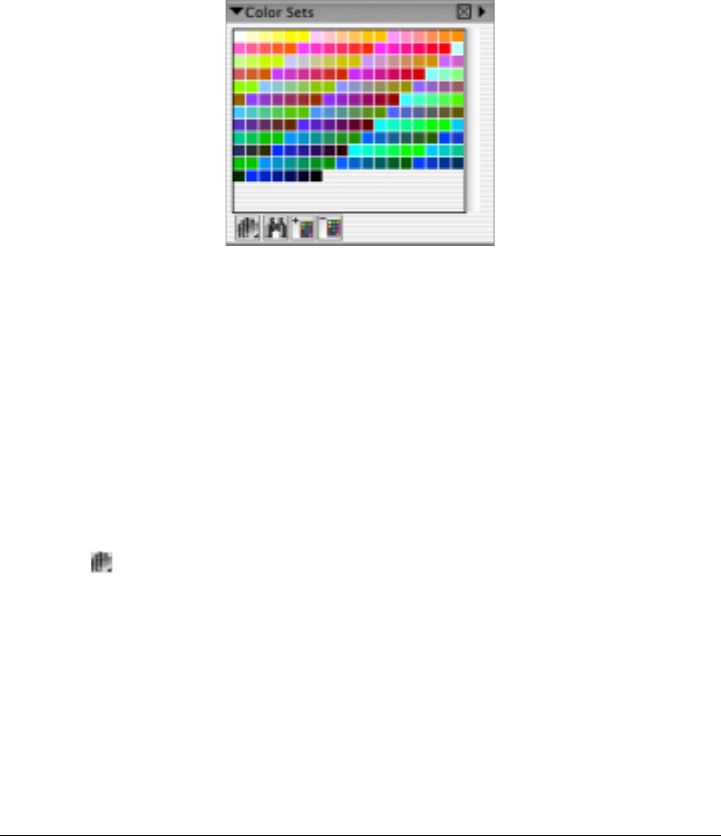
Color 93
When you open a new color set, and the current color set is one you’ve
created or modified, Corel Painter prompts you to decide whether to append
to or overwrite the contents of the Painter Colors file, allowing Corel Painter
to load this new color set by default in the future.
Corel Painter provides two methods to find a particular color in a color set. You can
search for the color by name or have Corel Painter find the color that comes closest to
matching the current color.
The Color Sets palette.
To display the Color Sets palette
•Choose Window menu > Color Palettes > Show Color Sets.
To choose a color from a color set
•On the Color Sets palette, click a color.
To open a different color set
1On the Color Sets palette, click the palette menu arrow or the Library Access
button , and choose Open Color Set.
2In the Select Color Set dialog box, do one of the following:
• (Mac OS) Click the Color Sets folder, choose a color set, and click Open
• (Windows) Choose a color set, and click Open.
You can set a default color set in the Preferences dialog box. For more information,
refer to “Setting Preferences” on page 32.

94 Corel Painter User Guide
To save a color set
1On the Color Sets palette, click the palette menu arrow or the Library Access
button, and choose Save Color Set.
2In the Enter Color Set Name dialog box, choose where you want to save the file.
3Type a name for the color set in the File Name box.
4Click Save.
To find a color in a color set
1On the Color Sets palette, do one of the following:
• Click the Search for Color button .
• Click the palette menu arrow, and choose Find Swatch.
2In the Find Color dialog box, do one of the following:
• Enable the By Name option, and type a name in the box.
• Enable Closest to Current Color.
3Click Begin.
4Click OK when the desired color is found.
If the color set is visible, Corel Painter surrounds the found color with a selection
frame.
If you search for a color by name, but a color with that name is not found, the OK
button is not available (it is grayed out).
Customizing Color Set Layouts
You can arrange colors in a color set in various ways. You can sort by hue, luminance,
and saturation; determine the size of color swatches; decide whether to have grid lines;
and indicate whether the colors in the set are named. You can change a color set until
it’s exactly the way you want it.
To change how colors are sorted
1On the Color Sets palette, click the palette menu arrow and choose Sort Order.
2Choose one of the following options:
• Saved sorts colors in the order in which they were originally entered.
• HLS sorts colors by hue, luminance, and saturation.
• LHS sorts colors by luminance, hue, and saturation.

Color 95
• SHL sorts colors by saturation, hue, and luminance.
To adjust color swatch size
1On the Color Sets palette, click the palette menu arrow, and choose Swatch Size.
2Do one of the following:
• Choose a pixel value.
• Choose Customize.
3If you choose Customize, move the Width and Height sliders in the Customize
dialog box, or type values in the Width and Height boxes.
To turn the grid on or off
•On the Color Sets palette, click the palette menu arrow, and choose Show Grid to
toggle the display of the grid on and off.
Turning the grid off eliminates lines between colors. You can see more colors, but
the separations between colors are not as distinct as when the grid is on.
To turn color names on or off
•Click the palette menu arrow, and choose Display Name to toggle the display of
color names on or off.
Creating Color Sets
You can create your own color sets to control the colors in particular projects or to
create groups of favorite painting colors. Creating clearly named color sets can be very
useful. For example, you could name a color set Shades of Purple, Hero Image, My
Crayons, or Rollover Buttons — all offering you easy access to recognizable color sets.
You can create color sets from
• the Colors palette
•an image
• a selection on an image
•a layer
• the Mixer palette
Before you create a new color set, you may be prompted to save the current color set.
For more information, see “To save a color set” on page 94.
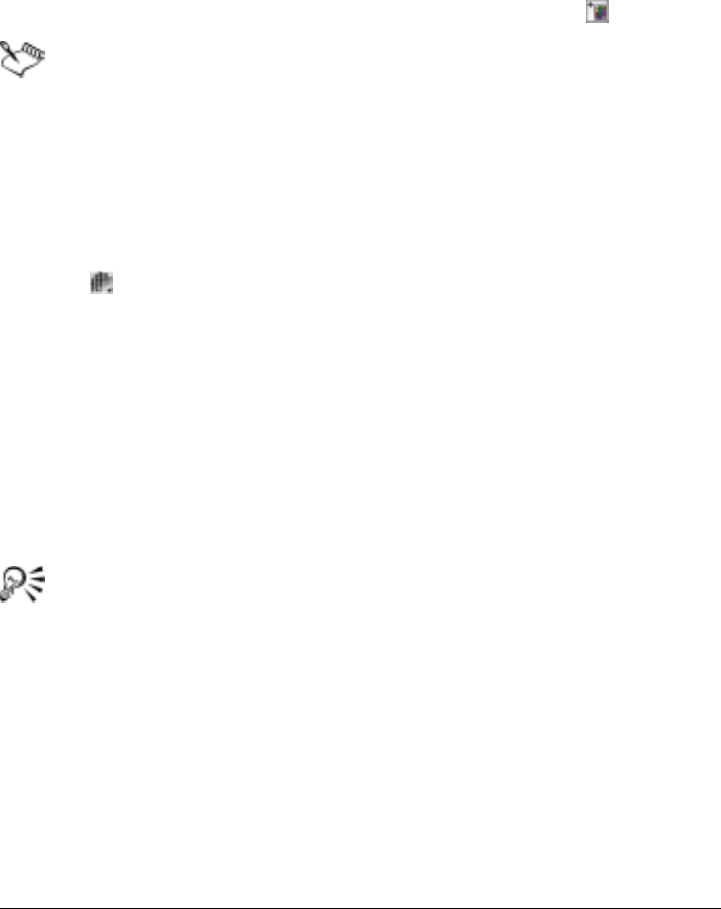
96 Corel Painter User Guide
To create a new color set by using the Colors palette
1On the Color Sets palette, click the palette menu arrow, and choose New Empty
Color Set.
2On the Colors palette, choose a color.
3On the Color Sets palette, click the Add Color to Color Set button .
For information about adding colors to a color set, see “Editing Color Sets” on
page 96.
For more information about selecting colors, see “Using the Colors Palette” on
page 78.
To create a color set from an image, selection, or layer, or the Mixer palette
•On the Color Sets palette, click the palette menu arrow or the Library Access
button , and choose one of the following:
• New Color Set from Image is available only if you have an image open. A color
set appears, containing all the colors in the image.
• New Color Set from Layer is available only if an active layer is selected in your
image. A color set appears, containing all the colors in the active layer.
• New Color Set from Selection is active only if you have an active selection on
your image. A color set appears, containing all the colors in the selected area of
the image.
• New Color Set from Mixer creates a color set, containing all the colors used in
the Mixer palette.
When working on Web pages, you can reduce the number of colors used in an
image (and reduce the subsequent image size) by creating a color set and
using only colors in that set.
Editing Color Sets
You can customize color sets by adding, deleting, or replacing colors. You can also
append colors to a color set. This is useful if you want to use colors from multiple color
sets. In addition, you can name or rename individual colors in a color set.
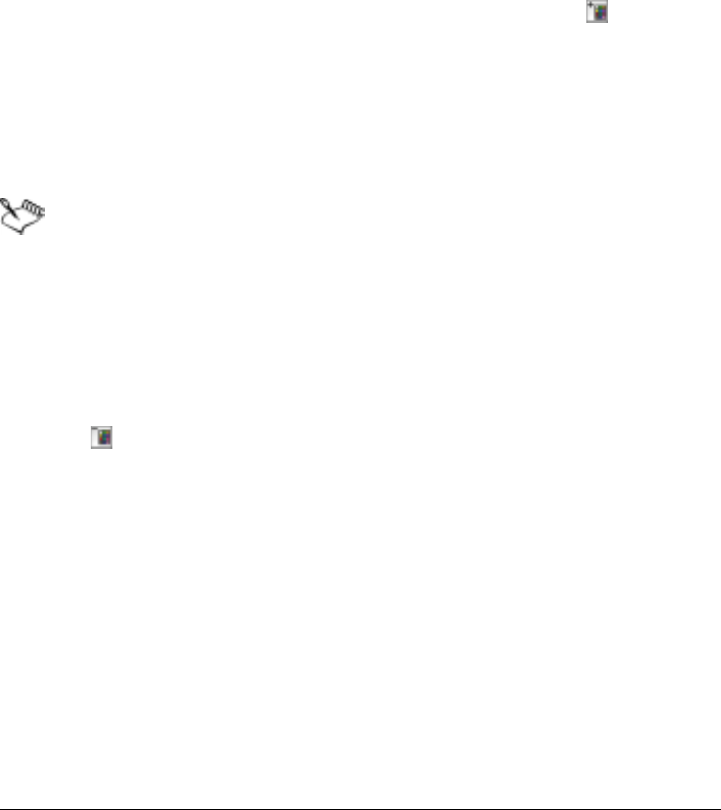
Color 97
Naming colors in a color set can be useful. You can then search for a color by name, or
annotate the colors you use, right in the document window. For more information on
searching for a color, refer to “To find a color in a color set” on page 94. For more
information about annotating colors, refer to “Annotating Colors” on page 98.
To add a color
1Choose the color you want to add from the Colors palette, a color set, or an existing
image.
2On the Color Sets palette, click the Add Color to Color Set button .
The color is added to the current color set.
3If you like, double-click the color swatch to enter a name for the color.
You can change the name later by double-clicking on the swatch again and
entering a new name.
4Repeat this procedure for all colors you want to add.
Because Corel Painter closes the current color set before displaying a new one,
select the color you want to add from the existing color set before you open
the destination set.
To delete a color
1Choose Window menu > Color Palettes > Show Color Sets.
2On the Color Sets palette, choose a color and click the Delete Color from Color Set
button .
3In the warning dialog box, click Yes.
Corel Painter deletes the chosen color from the color set.
To replace a color
1Choose the color you want to add from the Colors palette, a color set, or an existing
image.
2Hold down Command (Mac OS) or Ctrl (Windows), and click the color you want
to replace.
The new color replaces the old one in the color set.
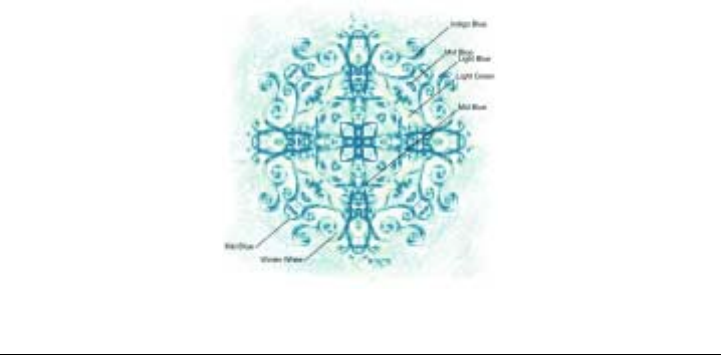
98 Corel Painter User Guide
To name or rename a color
1Choose Window menu > Color Palettes > Show Color Sets.
2Double-click a color swatch on the Color Sets palette.
3Type a color name in the Set Color Name dialog box.
Color names can contain up to 31 characters.
To append colors to a color set
1On the Color Sets palette, click the palette menu arrow, and choose Append Color
Set.
2In the Select Color Set dialog box, select the Color Set you want to use, and click
Open.
The new colors from the selected color set are appended to the active Color Set List.
Annotating Colors
The Annotation feature uses color names as labels for the colors in your images. Labels
are small text boxes connected to lines that point to an individual color in your on-
screen or printed image. Annotating colors in an image can help you track, and limit,
which colors are used, which can help you control image size. After you create
annotations, you can hide, show, or delete them.
You must name color swatches in the active color set to generate useful annotations.
You can change color names after you have added them as annotations. For
information about naming color sets, see “To name or rename a color” on page 98.
Create labels or annotations for individual colors in your image.

Color 99
Annotations are kept in a separate layer on top of the image and can be saved in RIF
format with your image. Annotations are included when you record a script and are
properly scaled when you play the script back at a different resolution.
When you move a layer, its annotations go with it. If you move an annotated layer on
top of another, the visible annotation might actually belong to the underlying layer,
even though it appears to be labeling the top one.
When you annotate a color that doesn’t exactly match a color in the active color set —
for example, when you annotate brush strokes applied at less than 100% opacity —
Corel Painter approximates the color, displays the name of the nearest match, and adds
an asterisk after the color name to indicate a near match.
When you refill an annotated area, the annotation is updated to reflect the new color.
Refer to “Filling an Area with Media” on page 163 for more information.
To create annotations
1Use a color set that includes names for the colors.
2Choose Canvas menu > Annotations > Annotate.
3Position the cursor on the color you wish to annotate and drag to an area outside
the color’s boundaries.
A color name appears, attached to a line that points to the annotated color.
4After you annotate as many colors as you need, click Done in the Annotation dialog
box.
To delete an annotation
1Choose Canvas menu > Annotations > Annotate.
2Click the annotation (color name) to select it.
3Press Delete (Mac OS) or Backspace (Windows).
To show or hide annotations
•Choose Canvas menu > Annotations > Show Annotations or Hide Annotations.
To change color names after annotating an image
1Choose the annotation you want to rename.
2Press Delete (Mac OS) or Backspace (Windows).

100 Corel Painter User Guide
3On the Color Sets palette, double-click the color swatch of the color you want to
rename.
4Type a new name in the Set Color Name dialog box.
5Choose Canvas menu > Annotations > Annotate.
6Re-create the deleted annotation.
7Repeat the procedure for each annotation you want to rename.
Setting Color Variability
Color variability allows you to create brush strokes of more than one color. Variability
can be used to enhance the Natural-Media appearance of your work.
The Color Variability Palette
The Color Variability palette contains sliders to adjust color variability values. Color
variability can be set for HSV or RGB mode, and it can be based on the current
gradient or color set.
The Color Variability palette.
To display the Color Variability palette
•Choose Window menu > Brush Controls > Show Color Variability.
To set color variability in HSV mode
1On the Colors palette, choose a main color.
2Choose Window menu > Brush Controls > Show Color Variability to display the
Color Variability palette.
3Choose In HSV from the pop-up menu.
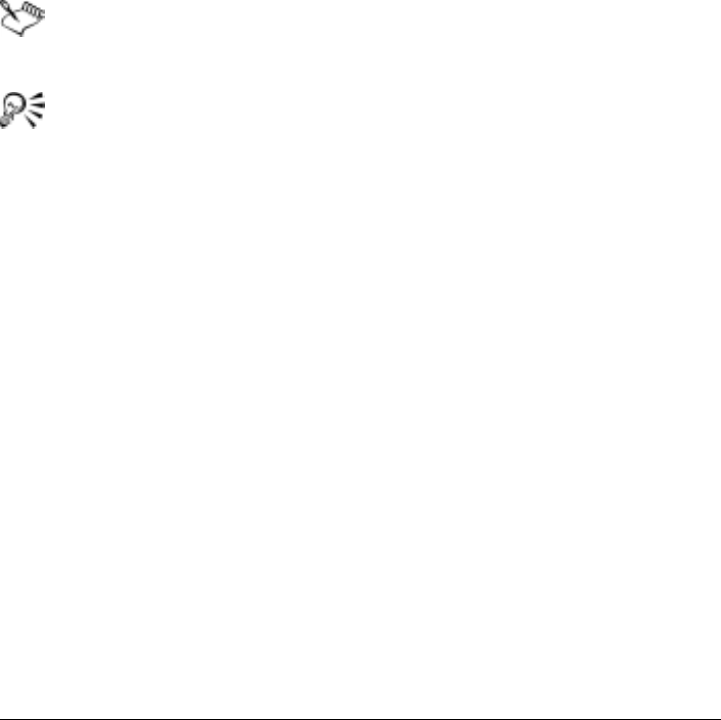
Color 101
4Adjust the Hue, Saturation, and Value sliders to control hue, saturation, and value
ranges for color variability:
• Moving the ±Hue slider to the right increases the number of hues in the
resulting brush stroke. These colors are the ones adjacent to the selected color
on the color wheel.
• Moving the ±Saturation slider to the right increases variability in the color
intensity of the brush stroke.
• Moving the ±Value slider to the right increases variability in the brightness of
the brush stroke.
You can try different ±HSV settings with any of the brushes to produce interesting
results.
When you save a brush variant, the current color variability setting is also
saved.
When working with brushes like the Loaded Oils brush or the Van Gogh and
Seurat variants of the Artists brush, you can add natural, almost 3D-looking
effects to your Web page images by moving the Hue, Saturation, and Value
settings to the right.
To set color variability in RGB mode
1On the Colors palette, choose a main color.
2Choose Window menu > Brush Controls > Show Color Variability to display the
Color Variability palette.
3Choose In RGB from the pop-up menu.
4Move the R, G, and B sliders to control color variability of red, green, and blue
values.
To set color variability based on the current gradient
1On the Colors palette, choose a main color.
2Choose Window menu > Brush Controls > Show Color Variability to display the
Color Variability palette.
3Choose From Gradient from the pop-up menu.
Color variability is now based on random colors from the current gradient.
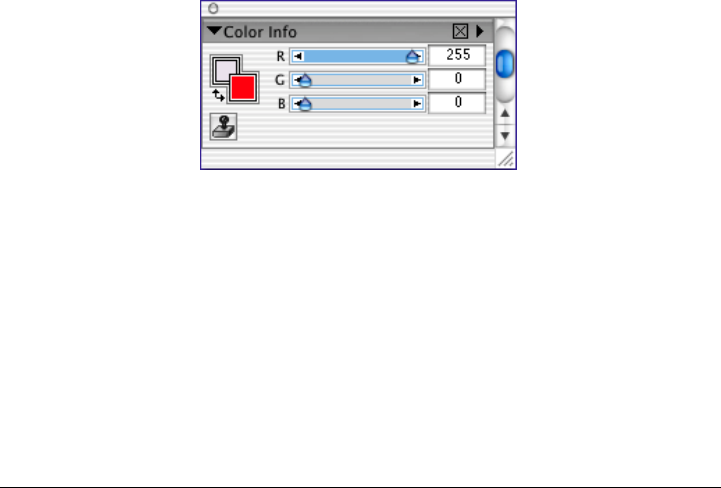
102 Corel Painter User Guide
To set color variability based on the current color set
1On the Colors palette, choose a main color.
2Choose Window menu > Brush Controls > Show Color Variability to display the
Color Variability palette.
3Choose From Color Set from the pop-up menu.
Color variability is now based on random colors from the current color set.
Viewing Color Information
Color information for a selected color is available on the Color Info palette.
The Color Info Palette
The Color Info palette shows the HSV and standard RGB values for the selected color.
Corel Painter can also display RGB values in decimal format. These values can be
adjusted by moving the sliders, or by typing new values in the corresponding boxes.
You can also use the Color Info palette to enable the Clone Color option. For more
information on clone color, see “Using Clone Color” on page 288.
The Color Info palette.
To display the Color Info palette
•Choose Window menu > Color Palettes > Show Color Info.
To set RGB or HSV values
1On the Color Info palette, click the palette menu arrow and choose one of the
following:
• Display as RGB.

Color 103
• Display as HSV.
2Move the sliders to adjust the values, or type new values in the boxes.
You can preview the new color in the Main Color and Additional Color squares on
the Color Info palette.
You can display hexadecimal RGB values on the Colors palette by pressing
Shift + click in the HSV/RGB square. Hexadecimal RGB values can be useful
when you create graphics for the Web.
Setting Color Expression
Color expression determines where Corel Painter should use the main or additional
color in an image.
The Color Expression Palette
The Color Expression palette lets you introduce input (such as direction) that controls
output when you apply two-color brush strokes.
The Color Expression palette.
To display the Color Expression palette
•Choose Window menu > Brush Controls > Show Color Expression.
To set Color Expression controls
1Choose Window > Show Color Expression to display the Color Expression palette.
2From the Controller pop-up menu, choose one of the following options:
• None applies no adjustment to the color expression.
• Velocity adjusts the color expression based on the dragging speed.
• Direction adjusts the color expression based on the direction of the stroke, and
according to the value you set with the slider or in the box.
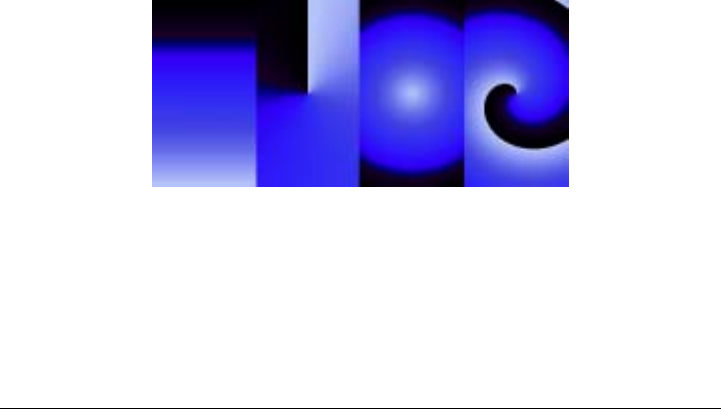
104 Corel Painter User Guide
• Pressure adjusts the color expression based on stylus pressure.
• Wheel adjusts the color expression based on the wheel settings on an airbrush
stylus, specifically the Wacom Intuos Airbrush stylus.
• Tilt adjusts the color expression based on the angle of the stylus from the tablet.
• Bearing adjusts the color expression based on the direction in which the stylus
points.
• Rotation adjusts the color expression based on the rotation of the stylus.
• Source adjusts the color expression based on the luminance of the clone source.
• Random adjusts the color expression at random.
3If you want to switch the main and additional colors, enable the Invert check box
next to the Controller pop-up menu to invert the color expression.
Working with Gradients
A gradient is a gradual transformation from one color into another. Sometimes
gradients are called blends or fountains.
Using Gradients
Corel Painter provides several different types of gradients: linear, radial, circular, and
spiral.
Left to right: linear, radial, circular, and spiral gradients.
You can use gradients to
• Fill an image selection, layer, or channel. For more information, see “Layers” on
page 43, and “Selections” and “Alpha Channels” in the Help.
• Control a Pop Art Fill effect. (Other effects work best when you use a filled mask.)
For more information, see “Applying Pop Art Fill” in the Help.
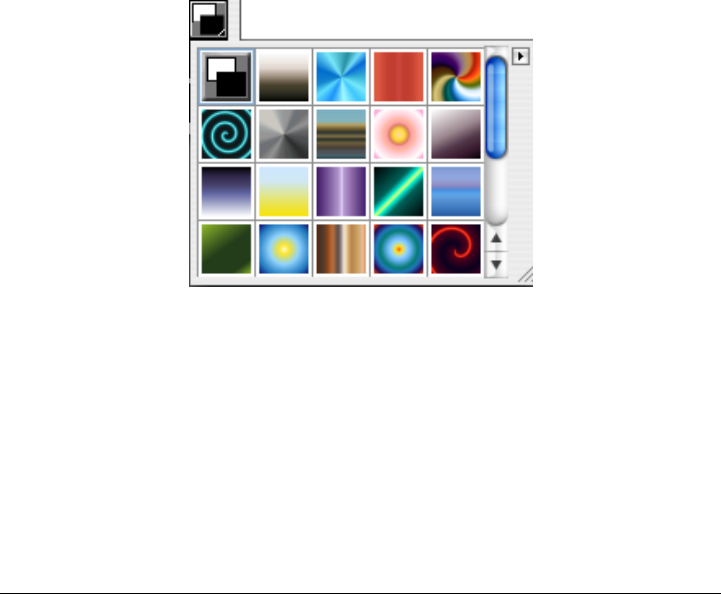
Color 105
• Express the gradient in an existing image by mapping gradient colors to image
luminance. For more information, see “Using Image Luminance to Create Texture”
on page 297.
• Brush with a gradient with one of the computed brushes (using one of the
following dab types: line airbrush, projected, or rendered). For more information,
see “Dab Types” on page 205.
Although Corel Painter comes with libraries full of gradients, you’ll invariably want to
create some of your own. You can easily create a gradient between any two colors that
you define.
You can also capture gradients from existing images or create your own libraries of
gradients. Use the options on the Gradients palette to select and adjust Corel Painter
gradients.
Gradients are stored in libraries. You can load alternate libraries of gradients to
increase your choices. For more information about working with libraries, refer to
“Creating a Library” in the Help.
The Gradient Selector on the Gradients palette.
To select a gradient
1Choose Window menu > Library Palettes > Show Gradients to display the
Gradients palette.
If the Gradients palette is not expanded, click the palette arrow.
2Click the Gradient Selector, and choose a gradient.
3Click one of the gradient types on the right of the palette: Linear Gradient, Radial
Gradient, Spiral Gradient, or Circular Gradient.

106 Corel Painter User Guide
The Gradient Preview Window shows how current settings affect a selected
gradient.
To change gradient order
1Choose Window menu > Library Palettes > Show Gradients to display the
Gradients palette.
2Click one of the gradient order buttons at the bottom of the palette to determine
how the gradient behaves:
• Left to Right Gradient
• Mirrored Right to Left Gradient
• Double Left to Right Gradient
• Right to Left Gradient
• Mirrored Left to Right Gradient
• Double Right to Left Gradient
The Gradient Order Preview strip (above the gradient orders) shows the selected
gradient order.
Examples of gradient orders.
To change a gradient angle
1Choose Window menu > Library Palettes > Show Gradients to display the
Gradients palette.
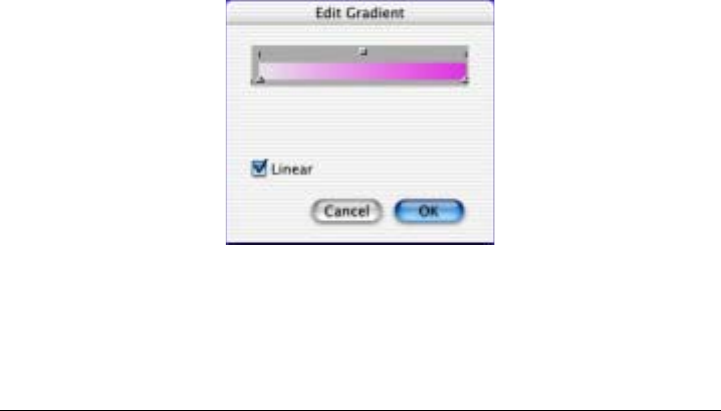
Color 107
2Drag the red ball in the Gradient Angle Ring, or click once anywhere on the ring
to change the gradient angle.
A corresponding numeric value appears below the Gradient Preview Window.
To change spiral tension
1Choose Window menu > Library Palettes > Show Gradients to display the
Gradients palette.
2Do one of the following:
• Hold down Command (Mac OS) or Ctrl (Windows) while you drag the red ball
in the gradient angle ring. This changes how tightly wound the spiral gradient
becomes.
• Click inside the Gradient Preview Window. Corel Painter rotates the gradient
for you.
Click anywhere outside the Gradient Preview Window to stop the rotation.
Creating and Editing Gradients
You can create very simple to very complex gradients. For a simple two-point gradient,
you only need to choose a main and an additional color and then have Corel Painter
create a gradient between them. For more complex gradients, you can use the Edit
Gradient dialog box or capture gradients from existing artwork. Color control points
in the Edit Gradient dialog box specify the point at which a new gradient starts.
Use the Edit Gradient dialog box to create or edit gradients.
You can save gradients and use them to fill a selected object. For more information on
filling an object, refer to “Filling an Area with Media” on page 163.

108 Corel Painter User Guide
To create a two-point gradient
1Choose Window menu > Color Palettes > Show Colors to display the Colors
palette.
2On the Colors palette, click the Main Color square, and choose a main color.
3Click the Additional Color square, and choose an additional color.
4Choose Window menu > Library Palettes > Show Gradients.
5Choose Two-Point from the Gradient Selector.
To edit or create a complex gradient
1Choose Window menu > Library Palettes > Show Gradients to display the
Gradients palette.
2Click the palette menu arrow, and choose Edit Gradient.
The color ramp bar across the top of the Edit Gradient dialog box displays the
current gradient. The pointed gray markers along the bottom of the color ramp bar
are color control points. You can position these pointed markers to change the color
of the blend at individual gradient points.
3Click a color control point to select it.
4On the Colors palette, click the Main Color square, and choose a main color.
5Repeat steps 3 and 4 for each color control point you want to edit.
To add color control points
1Choose Window menu > Library Palettes > Show Gradients to display the
Gradients palette.
2Click the palette menu arrow, and choose Edit Gradient.
3In the Edit Gradient dialog box, click anywhere in the color ramp bar.
The control point is added, without affecting color.
4Click the new color control point to select it.
5Open the Colors palette and choose a color.
For a two-point gradient, you set a color for the right control point and then
set a color for the left control point.
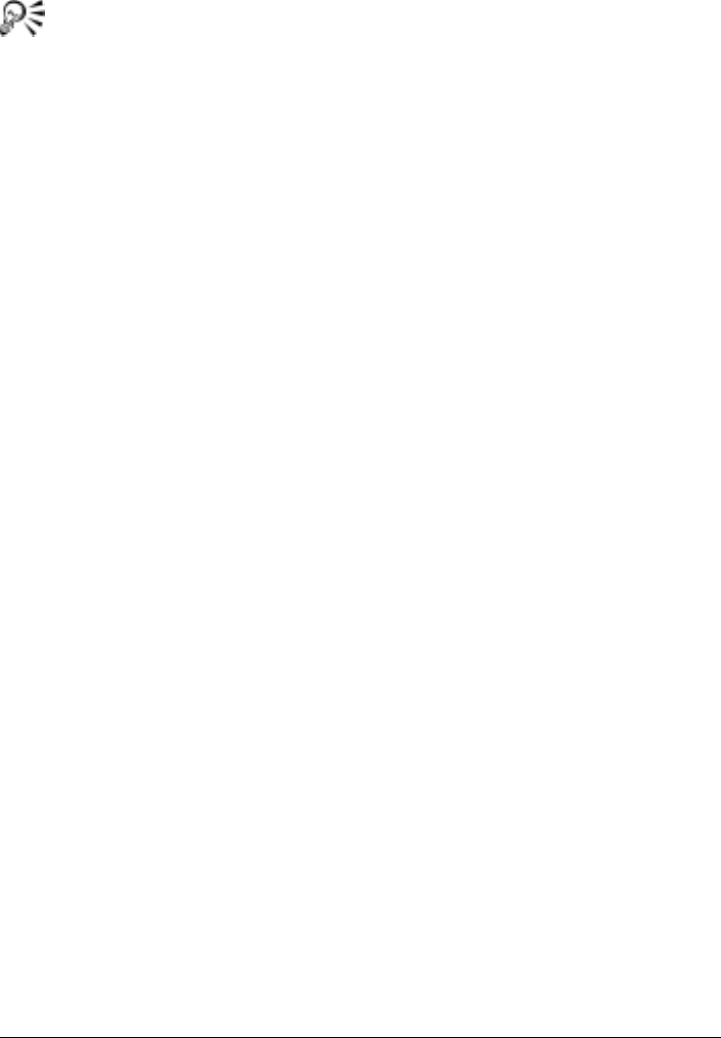
Color 109
You can press Option + click (Mac OS) or Alt + click (Windows) in the color
ramp bar to create a control point that is set to the current color.
You can create interesting gradient effects by selecting two additional colors
in between the end colors.
To delete a control point
1Choose Window menu > Library Palettes > Show Gradients to display the
Gradients palette.
2Click the palette menu arrow, and choose Edit Gradient.
3In the Edit Gradient dialog box, click a control point to select it.
4Press Delete (Mac OS) or Backspace (Windows) to delete a selected color control
point.
To save a gradient
1Choose Window menu > Library Palettes > Show Gradients to display the
Gradients palette.
2Click the palette menu arrow, and choose Save Gradient.
3In the Save Gradient dialog box, enter a name for the gradient.
Creating Blending Ramps
Blending ramps determine whether a gradient blends linearly or nonlinearly.
To create ramps that blend linearly
1Choose Window menu > Library Palettes > Show Gradients to display the
Gradients palette.
2Click the palette menu arrow, and choose Edit Gradient.
3In the Edit Gradient dialog box, enable the Linear check box.
Linear is the default option.
To create nonlinear gradients
1Choose Window menu > Library Palettes > Show Gradients to display the
Gradients palette.
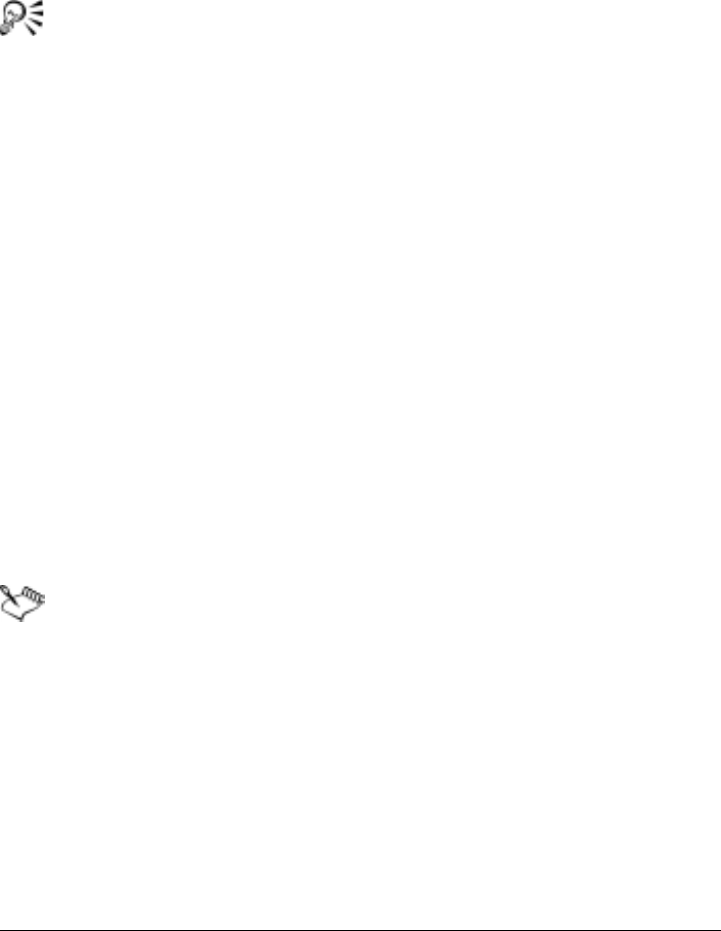
110 Corel Painter User Guide
2Click the palette menu arrow and choose Edit Gradient.
3Disable the Linear check box.
All ramps within the gradient are now blended nonlinearly, with smooth curves.
When using nonlinear ramps, use the Color Spread slider to control the color
smoothness at each color control point.
Changing Gradient Color Hue
Color hue is represented in the Edit Gradient dialog box by boxes located at the
midpoints between the adjacent color control points. They allow you to change the
hue of the blend within that segment.
To change the color hue
1Choose Window menu > Library Palettes > Show Gradients to display the
Gradients palette.
2Click the palette menu arrow, and choose Edit Gradient.
3In the Edit Gradient dialog box, click a square box above the color ramp bar.
4Select an option from the Color Hue pop-up menu:
• RGB blends directly between the red, green, and blue components of the two
colors.
• Hue Clockwise and Hue Counterclockwise blend between the endpoint colors
by rotating around the color wheel.
For a better understanding of this concept, refer to the standard display of the
Colors palette (Hue Ring and Saturation/Value Triangle), and note the order
of the colors on the Hue Ring. Notice that as you change parameters within
the Edit Gradient dialog box, gradient previews are updated on the Gradients
palette.
Capturing a Gradient from an Image
You can use any existing image as a source for creating new gradients. You could
capture the colors in a photo of a sunset, or paint your own range of colors as the
content of a gradient.

Color 111
To make perfect blends between a series of colors, it is better to
work with a row of single pixels than a large piece of an image.
To capture a gradient
1Select a horizontal or vertical area, making the selection as narrow as possible.
If the selection is horizontal, Corel Painter uses the first row of pixels starting at the
upper left for the gradient.
If the selection is vertical, Corel Painter uses the first column of pixels, starting at
the upper left for the gradient.
2Choose Window menu > Library Palettes > Show Gradients to display the
Gradients palette.
3Click the palette menu arrow, and choose Capture Gradient.
4In the Save Gradient dialog box, type a name for the gradient.
The new gradient is saved in the current library. In the future, you can choose it by
name from the Gradients palette.
For information about working with libraries, refer to “Libraries and Movers” in the
Help.
Once a gradient is captured, it can no longer be edited. To change a captured
gradient, change the artwork from which it was captured, and then recapture
the gradient.

112 Corel Painter User Guide
Mapping a Gradient to Luminance in an Image
You can map a gradient to an existing image, replacing an image’s colors with those of
the gradient. This effect applies gradient colors to the pixels of the image, based on
their luminance values.
Corel Painter allows you to apply a gradient based on the luminance value of existing colors.
To express a gradient in an image
1Open the image you want to use.
Select part of the image, or use the entire image.
2Choose Window menu > Library Palettes > Show Gradients to display the
Gradients palette.
3Select a gradient.
4Click the palette menu arrow, and choose Express in Image.
5In the Express in Image dialog box, adjust the Bias slider to define how the
gradient is mapped.
Corel Painter replaces the colors in the image with the colors in the gradient, based
on matching luminance.
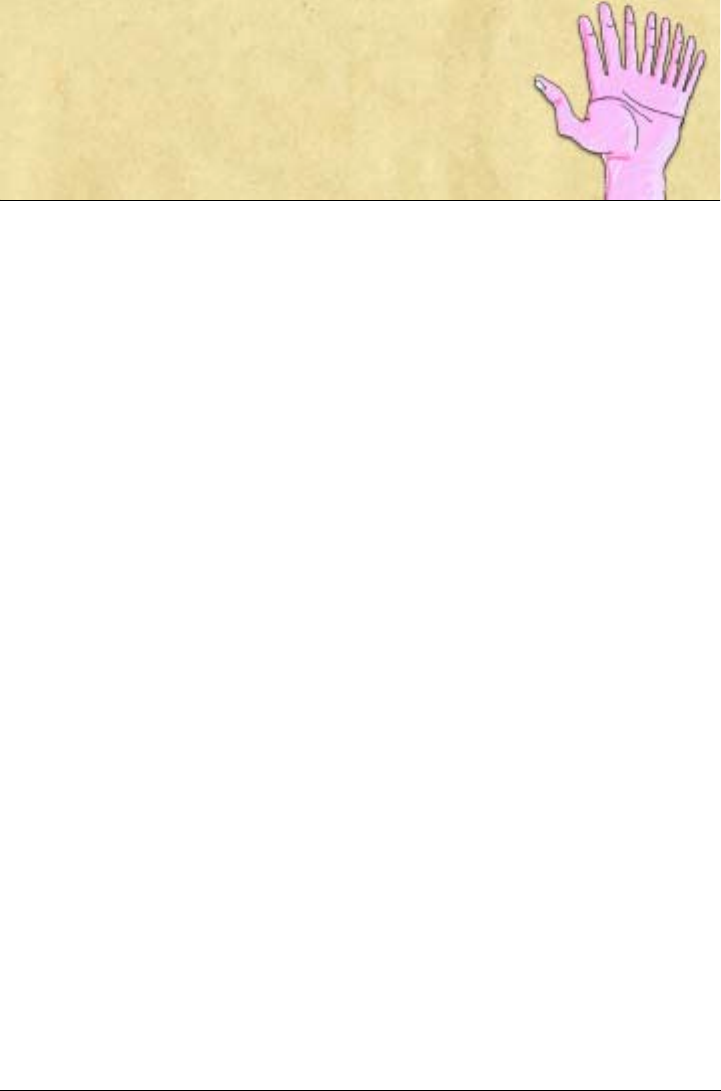
Textures, Patterns, and Weaves 113
Textures, Patterns, and Weaves
In Corel Painter, paper textures, gradients, patterns, and weaves can all be applied to
your image. You can brush some of them on, get them to interact with each other,
spray them, smear them, and even create your own. Best of all, you never have to run
to the store in the middle of creating to get a new tube of paint or the right kind of
paper.
You’ll use these items in several ways:
• to load a Brush tool with media for painting
• to fill selections with the Effects menu > Fill command or the Paint Bucket tool
• to control certain image effects, like Apply Surface Texture
This chapter explains how to select, customize, and create textures, patterns, and
weaves, as well as how to save them to a library for future use.
Papers, patterns, and weaves all reside in libraries. The default libraries offer sample
materials. You’ll find more libraries, with additional materials, on the Corel Painter CD
and on the Corel Web site. For more information about libraries, including how to load
alternate libraries, create your own libraries, and manage library content, see “What
Are Libraries?” in the Help.
Using Paper Texture
In the real world, a marking tool has different results when applied to surfaces with
different textures. Corel Painter allows you to control the texture of the canvas to
achieve the results you’d expect from natural media on a given surface — pencil on
water color paper, felt pens on cotton paper, chalk on the sidewalk, and so on.
Of course, some brushes, like those in the Airbrush category, don’t reveal paper texture
in their strokes. This behavior follows that of the natural tool.

114 Corel Painter User Guide
Most of the brushes interact with the current paper texture.
You can use paper textures in many ways. Brushes interact with paper “grain,” just as
natural tools react with the texture of the surfaces beneath them. Working with paper
grains is useful when you use the Apply Surface Texture command or other effects,
such as Glass Distortion. You can select different paper textures, modify them,
organize them in libraries, and even create your own custom textures.
In Corel Painter, brushes that react with paper texture have a “grainy” method. For
more information about brush methods, see “Methods and Subcategories” on
page 211.
The terms “paper grain” and “paper texture” are used here synonymously.

Textures, Patterns, and Weaves 115
Choosing Paper Textures
The Papers palette is where all paper textures are stored. In addition to using it to
select papers, you can use this palette to invert, resize, or randomize paper grain;
control brightness and contrast; or open other paper libraries. For more information on
working with libraries, see “Creating a Library” in the Help.
The Paper Selector on the Papers palette.
To choose a paper texture
1Choose Window menu > Library Palettes > Show Papers to display the Papers
palette.
If the Papers palette is not expanded, click the palette arrow.
2In the Papers palette, click the Paper Selector to display the available paper
textures.
3Choose a paper texture from the Paper Selector.
The Papers palette shows the dimensions, in pixels, of the selected paper.
Corel Painter tiles the paper to cover as much canvas as needed.
You can also choose a paper texture from the Paper Selector in the toolbox.
Corel Painter uses the currently selected texture. You can make a few strokes,
and then change the paper and make a few more strokes to get different
results.
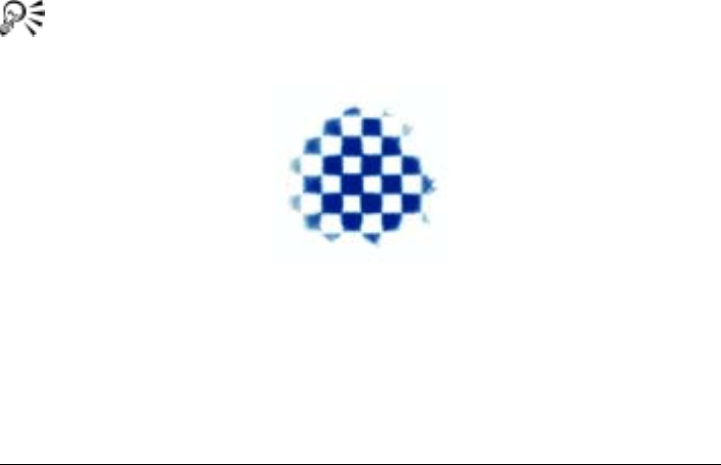
116 Corel Painter User Guide
Creating Paper Textures
The Make Paper command lets you make your own paper textures. The Capture Paper
command lets you turn a section of an image into a paper texture. Once you save
textures, they are available from the Papers palette.
To create a paper texture
1Choose Window menu > Library Palettes > Show Papers.
2On the Papers palette, click the palette menu arrow, and choose Make Paper.
3In the Make Paper dialog box, choose a pattern from the Pattern pop-up menu to
use as the basis of your paper texture.
4Adjust the Spacing slider.
Moving the Spacing slider to the right opens up space between rows and columns
in the selected pattern.
5Adjust the Angle slider.
Moving the Angle slider changes the direction in which the pattern’s rows are lined
up.
6When you like the look of the texture, enter a name, and click OK.
Your new texture appears as the last item in the Paper Selector.
You can also use the Paper Selector in the toolbox to create paper. Click the
Paper Selector, click the selector menu arrow, and choose Make Paper.
The Make Paper dialog box allows you to create your own
textures based on patterns in the Pattern pop-up menu.
To capture paper texture
1Open or create an image.
2Select all or a piece of your source image.
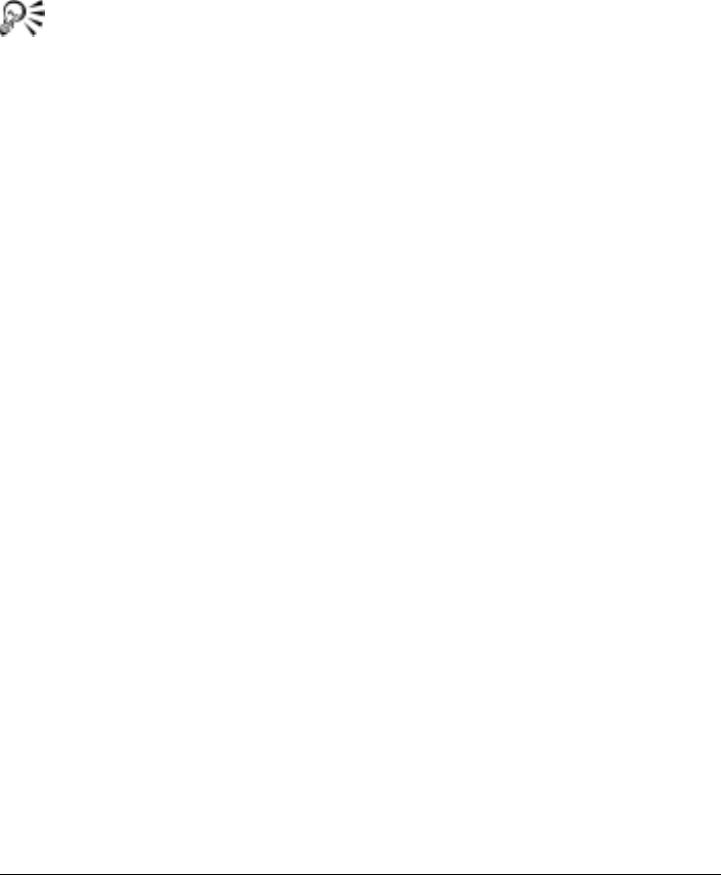
Textures, Patterns, and Weaves 117
3On the Papers palette, click the palette menu arrow, and choose Capture Paper.
If you want to blend the distinction between tile borders, move the Crossfade slider
in the Save Paper dialog box to the right.
4Type the name of your new texture, and click OK.
Your texture now appears in the Paper Selector and is added to the current library.
You can also use the Paper Selector in the toolbox to capture paper texture.
Click the Paper Selector, click the selector menu arrow, and choose Capture
Paper.
The Make Fractal Pattern feature creates excellent textures. Some weaves also
produce good textures. For more information, see “Creating Fractal Patterns”
on page 126.
Controlling Brightness and Contrast of Paper Texture
Brightness can be thought of as controlling the depth of the paper grain. Paper that is
less bright acts as if the grain is shallow.
Contrast can be thought of as controlling the steepness of the paper grain. The grain in
higher-contrast paper changes from high to low more quickly and with fewer
intermediate levels than the grain in lower-contrast paper.
To change paper texture brightness
1Choose Window menu > Library Palettes > Show Papers.
2On the Papers palette, adjust the Paper Brightness slider to modify the brightness
of the grain.
To change paper texture contrast
1Choose Window menu > Library Palettes > Show Papers.
2On the Papers palette, adjust the Paper Contrast slider to modify the contrast of
the grain.
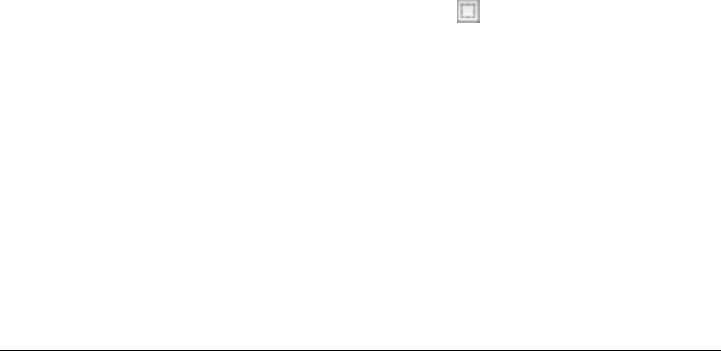
118 Corel Painter User Guide
Adjusting the Grain
When you choose a brush that interacts with paper grain, you see the results with each
stroke. When you find a brush and paper combination that you really like, you can
save it as a new look in the Look Selector.
If you have a stylus and tablet, you can adjust paper grain by changing the stroke of
the stylus on a pressure-sensitive tablet. In most cases, a light stroke colors only the
peaks and ridges of the grain. A heavy stroke fills color deep into the pockets and
valleys. You can also affect paper grain by using the Grain settings on the Stroke
Designer tab of the Brush Creator.
When you want paper grain to appear uniformly across an image, create your artwork
first, and then apply the grain as a surface texture. If you apply paper texture before
you create an image, the texture is erasable, and you cannot erase brush strokes
without erasing paper texture at the same time. You’ll find that adding paper texture
as the last step in developing your image, not the first step, often works best.
Normally, paper grain is fixed, which means that the texture is in the same position
each time you apply a brush stroke. You can change this when you want grain to be
applied randomly.
You can also have the paper grain interact with stroke direction to affect the look of
brush strokes. This option works best when you use certain papers and brushes and
when you paint with a stylus.
To save a look in the Look Selector
1On a blank canvas, create an image to use as a new look.
2In the toolbox, click the Rectangular Selection tool .
3Drag in the image to select the look you want to save.
4In the toolbox, open the Look Selector, and click the selector menu arrow.
5Choose New Look.
6In the New Look dialog box, type a name in the Save As box.
To randomize paper grain
1Choose Window menu > Show Brush Creator.
2Click the Stroke Designer tab, and choose Random.
3Enable the Random Brush Stroke Grain option.
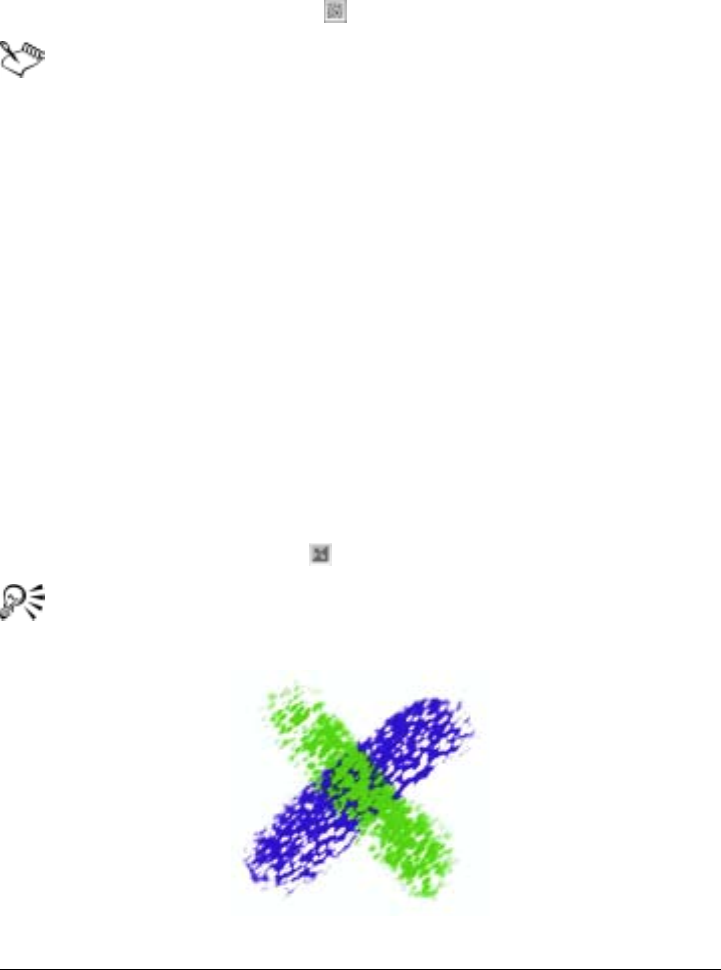
Textures, Patterns, and Weaves 119
To enable directional paper grain
1Choose Window menu > Library Palettes > Show Papers.
2Click the Directional Grain button .
Factors such as stylus pressure, paper, and brush variant affect the appearance
of brush strokes when the Directional Grain option is enabled. Papers with
pronounced grain, such as Wood Grain and Gessoed Canvas, yield the best
resuts.
Inverting and Scaling Paper Textures
Think of paper texture as a three-dimensional landscape. Usually, brushes react to
paper texture by coloring peaks and ignoring valleys. You can enable the Invert Paper
option to make color fill the valleys instead of the peaks. You can also adjust the paper
texture scale to resize the paper texture. Scaling paper grain affects how the grain
appears in brush strokes and images.
To invert paper grain
1Choose Window menu > Library Palettes > Show Papers.
2On the Papers palette, do one of the following:
• Click the palette menu arrow, and choose Invert Paper.
• Click the Invert Paper button .
You can also use the Paper Selector in the toolbox to invert paper grain. Click
the Paper Selector, click the selector menu arrow, and choose Invert Paper.
Two brush strokes overlapping. The green one was painted with the grain inverted.

120 Corel Painter User Guide
To change paper texture scale
1Choose Window menu > Library Palettes > Show Papers.
2On the Papers palette, use the Paper Scale slider to resize the paper grain.
As you move the slider, the Paper Preview Window updates to display the new
grain size. You can scale texture down to 25% or up to 400%.
Scaling large textures can use a great deal of RAM. Most textures in
Corel Painter are from 50 to 400 pixels square at 100% scaling.
Brush strokes on paper grains with different scale values.
Using Patterns
A pattern is a repeating design. The smallest unit of a pattern is known as a “tile.”
When you fill an area with a pattern, the tile is repeated across the selected area.
With patterns, you can
• fill selections with an image
• paint patterns directly onto your image with computed brushes that use rendered
dab types
• paint using a cloning brush
• control image effects
You’ll find a sampling of patterns in the default Pattern library. You’ll find other
pattern libraries on the Corel Painter IX CD.
Choosing Patterns
The Patterns palette shows a preview of the pattern, gives tile image dimensions, and
gives you options for scaling and arranging the tile in fills.
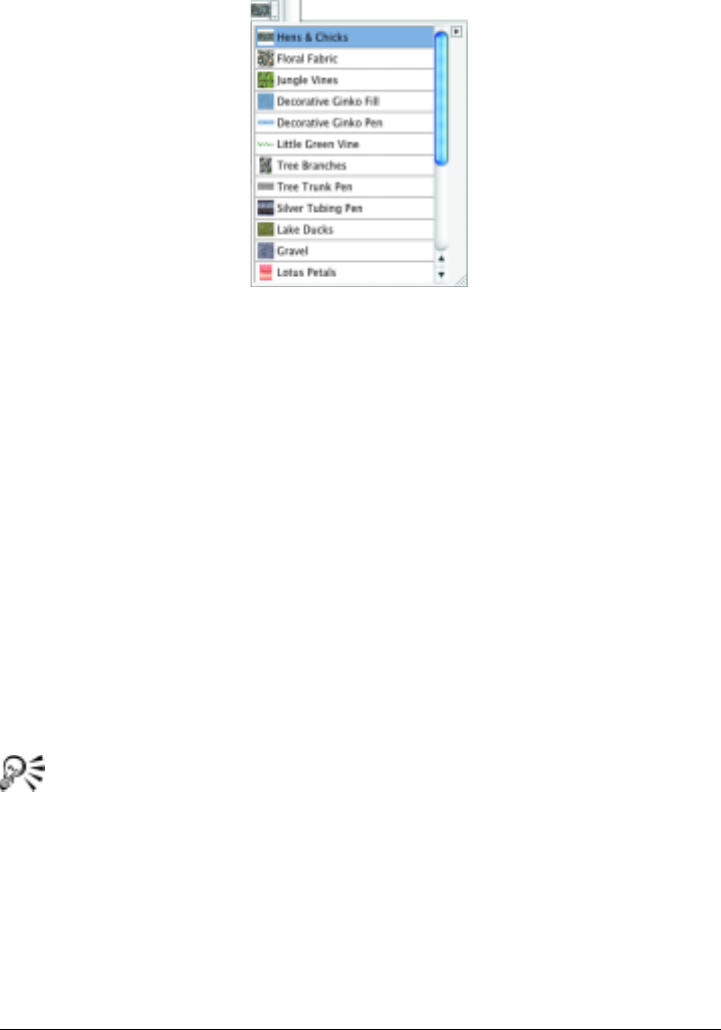
Textures, Patterns, and Weaves 121
The Pattern Selector on the Patterns palette.
Patterns are created by repeating a rectangular image tile across an area. Ideally,
images intended to be tiled are created so that they tile seamlessly. Corel Painter
provides ways to help you generate seamless tiles.
You can capture a pattern after you create it and manipulate it to be a half-drop
design, traditionally used in wallpaper designs. Your patterns can be added to the
Pattern library.
Fractal patterns can be used to create interesting landscapes in Corel Painter.
To choose a pattern
1Choose Window menu > Library Palettes > Show Patterns.
If the Patterns palette is not expanded, click the palette arrow.
2On the Patterns palette, click the Pattern Selector.
3Choose a pattern from the list.
You can also choose a pattern from the Pattern Selector in the toolbox.
To adjust the appearance of a pattern
1Choose Window menu > Library Palettes > Show Patterns.
2Choose a pattern from the Pattern Selector.
3Enable one of the following options:

122 Corel Painter User Guide
• Rectangular Pattern Type places the tiles in a rectangular grid for fills. The
Pattern Offset slider does not apply.
• Horizontal Pattern Type offsets the tiles in subsequent rows. The Pattern
Offset slider controls the amount of offset.
• Vertical Pattern Type offsets the tiles in subsequent columns. The Pattern
Offset slider controls the amount of offset.
4Adjust the Pattern Scale slider to control the dimensions of the pattern.
After setting these options, the pattern is ready to use.
To fill an image with pattern tiles
1On the Patterns palette, choose a pattern.
2Choose Effects menu > Fill.
3In the Fill dialog box, choose Pattern.
To see tiling in an image, the image must be larger than the tile.
To paint with a pattern
1From the Brush Selector bar, choose a brush that applies media to a document.
2On the Stroke Designer page of the Brush Creator, choose General.
3From the Source pop-up menu, choose one of the following:
• Pattern paints with a pattern containing no mask information.
• Pattern with Mask paints using mask data contained in the pattern.
• Pattern as Opacity paints with the pattern at a reduced opacity.
4Choose Window menu > Library Palettes > Show Patterns.
5Choose a pattern from the Pattern Selector.
6Paint in the image.
If you have not set a clone source, Corel Painter uses the current pattern in
any operation referring to clone source colors or luminance. This means you
can paint with a pattern using a Cloner brush.
If the Source option is not available (grayed out), the selected brush can apply
color only. In that case, select a rendered brush, or choose Rendered from the
Dab Type pop-up menu.

Textures, Patterns, and Weaves 123
When painting with a pattern, keep in mind that direction matters.
Corel Painter flips the pattern you’re painting when you change directions, so
apply strokes in the same direction for a uniform effect.
Creating and Capturing Patterns
Corel Painter offers three ways to create patterns:
• Define the current image as a pattern, then add it to the Pattern library.
• Create a rectangular selection, then capture it as a pattern. For more information
about creating selections, see “Creating Selections” in the Help.
• Make a fractal pattern, then add it to the library. For more information on creating
fractal patterns, see “Creating Fractal Patterns” on page 126.
After creating a pattern tile, you’ll probably want to refine it so that it tiles seamlessly.
Refer to “Creating Seamless Tiles” on page 128.
Images that you turn into patterns and save in RIF format maintain their pattern
characteristics even after being saved and reopened. To keep the Pattern Selector
manageable, it’s a good idea to keep libraries small. Use the Patterns Mover to create
new libraries and delete unwanted patterns. You can switch libraries whenever you
want to use a different set of patterns. For more information about movers, refer to
“Creating a Library” in the Help.
If a pattern preview isn’t detailed enough or you want to edit an existing pattern, you
can open the pattern tile in its own window. By loading a pattern as a file, you can
view the pattern closely and modify it.
Once a pattern becomes a tile, you can paint off one side of the canvas and watch your
stroke appear on the opposite side of the canvas, automatically wrapping to the other
side. Refer to “Creating Seamless Tiles” on page 128 for more information about
editing pattern tiles.
You can also create masked patterns to use with the Pattern Pens Masked brush
variant.
To create a pattern
1Open the image file you want to use in creating a pattern.
2Choose Window menu > Library Palettes > Show Patterns to display the Patterns
palette.
3Click the palette menu arrow, and choose Define Pattern.

124 Corel Painter User Guide
4On the Patterns palette, click the palette menu arrow, and choose Add Image to
Library.
5In the Save Image dialog box, type a name for the pattern.
With the Grabber tool selected, you can hold down the Shift key and drag the
seams to the center of the image in the document window. For best results, do
this at 100% scale.
To capture a pattern
1Using the Rectangular Selection tool , select the area of the image you want to
use as a pattern.
Remember, selection edges meet when the image is tiled, so select carefully.
2Choose Window menu > Library Palettes > Show Patterns to display the Patterns
palette.
3Click the palette menu arrow, and choose Capture Pattern.
4Enable one of the following options:
• Rectangular Tile places the tile in a rectangular grid for fills. The Bias slider
does not apply.
• Horizontal Shift offsets the tiles in subsequent rows. The Bias slider controls the
amount of offset.
• Vertical Shift offsets the tiles in subsequent columns. The Bias slider controls
the amount of offset.
As you try different tile arrangements and Bias settings, the Pattern Preview
Window shows the result.
5Enter a descriptive name for the pattern.
Corel Painter captures the pattern and saves it to the current library.

Textures, Patterns, and Weaves 125
The Capture Pattern dialog box lets you decide how
much to offset pattern tiles and in which direction.
To edit a pattern tile
1On the Patterns palette, choose a pattern from the Pattern Selector.
2Click the palette menu arrow, and choose Check Out Pattern.
Corel Painter opens the selected pattern tile in its own document window.
You can now edit the pattern tile as you would any image. To put the modified pattern
back in the palette, you must save it to the Pattern library. For more information about
saving patterns to a library, refer to “Adding Patterns to the Pattern Library” on
page 130.
To create and use a masked pattern
1Make a selection to capture the area of an image that you want to use as a pattern.
2On the Patterns palette, click the palette menu arrow, and choose Define Pattern.
3On the Patterns palette, click the palette menu arrow, and choose Add Image to
Library.
4In the Save Image dialog box, type a name for the pattern, and click Save.
5On the Brush Selector bar, choose Pattern Pens from the Brush Category selector,
and choose Pattern Pen Masked from the Brush Variant selector.
On the Patterns palette, choose the masked pattern you saved in step 4.

126 Corel Painter User Guide
Creating Fractal Patterns
The Make Fractal Pattern command is a pattern generator that creates interesting
landscapes. These topographic patterns can be filled with color, or even embossed
using a paper texture.
When you create fractal patterns, the following options allow you to fine-tune your
creation:
• Size sets the exact size of the tile you are creating. If your computer has a lot of
memory, you can make a large file with a high resolution. Depending on how much
memory your computer has available to Corel Painter, some of the size options may
not be available.
• Power controls the intricacy of the pattern’s definition, as if you were “zooming” in
and out on a textured surface with a microscope. Move the Power slider to the right
to zoom out and see many small patterns. Move the Power slider to the left to zoom
in and see fewer large patterns.
The Power slider determines the degree of detail.
Left=-200%, Right=0%.
• Feature Size defines the number of prominent features within the tile. Moving the
slider to the left increases the number of repetitions per tile.
The Feature Size slider determines the number of repetitions per tile.
Left=90%, Right=20%.
• Softness adjusts the edge softness of the pattern.
• Angle changes the direction from which you view the fractal.

Textures, Patterns, and Weaves 127
• Thinness emphasizes the direction suggested by the lines of the fractal pattern.
Thinner lines produce a more linear look.
Low Thinness settings show the fractal as streaks. Use
the Angle slider to change the direction of streaking.
Corel Painter uses four channels to store graphic information: Red, Green, Blue, and
Alpha.
You can place information other than color values in these channels. Channel options
allow you to visualize this information in different ways.
• Height as Luminance displays pseudo-height information as luminance. White
areas are represented as peaks, and dark areas become depressions. Images
generated with this option can be used with the Apply Surface Texture effect.
• Gradient Bearing uses the Red channel to display the bearing of the down angle of
a height field.
• Surface Normal uses the Green and Blue channels to represent the X and Y
components of the surface normal (angle perpendicular to the surface at a given
point) of the height field (Green=X, Blue=Y).
These two latter options for viewing a fractal texture are offered for purely aesthetic
reasons. One way to take advantage of them is to create color variations of the texture
with the Adjust Colors feature.
You can also turn a fractal pattern into a paper texture that will be saved to the Paper
library.
To create fractal patterns
1On the Patterns palette, click the palette menu arrow, and choose Make Fractal
Pattern.
2In the Make Fractal Pattern dialog box, adjust the fractal options.
Changes you make appear in the Pattern Preview Window.
3When you are satisfied with your selections, click OK.
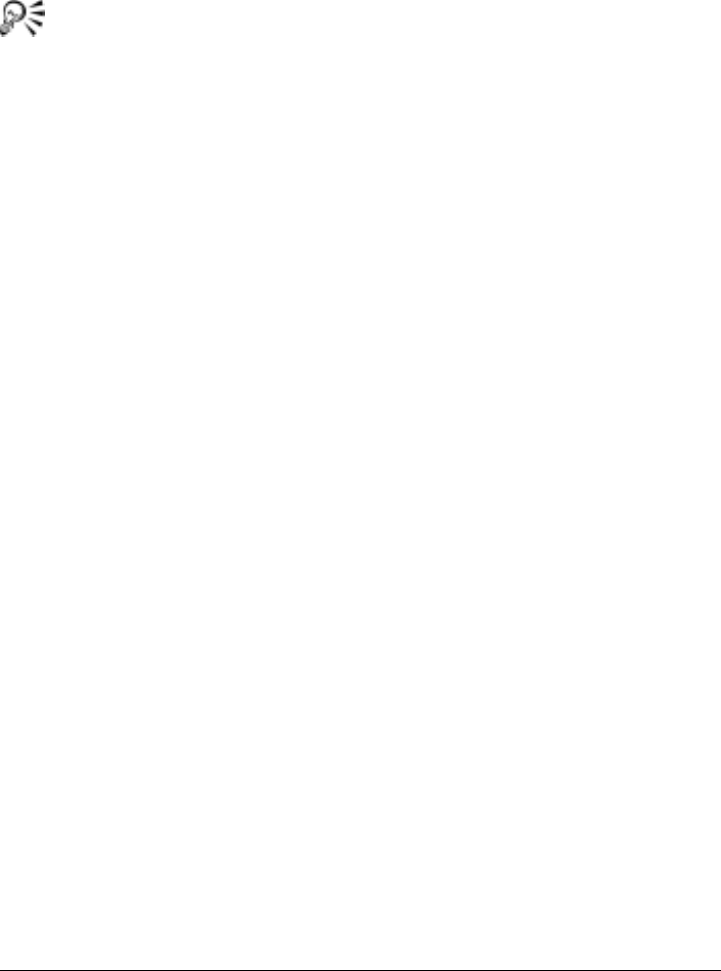
128 Corel Painter User Guide
Give Corel Painter a little time to create your new pattern file. When your pattern
file is ready, it is displayed in its own document window.
To colorize a fractal pattern, choose an appropriate gradient and use the
Express in Image feature.
You can also create interesting patterns by choosing a colorful gradient and
using the Express in Image command on the Gradients palette.
To convert a fractal pattern to a texture
1On the Patterns palette, click the palette menu arrow and choose Check Out
Pattern.
The pattern is displayed in a new image window.
2Choose Effects menu > Tonal Control to adjust image elements such as brightness,
contrast, and luminance.
3When you’re satisfied with the tonal balance, choose Select menu > All.
4Choose Window menu > Library Palettes > Show Papers to display the Papers
palette.
5Click the palette menu arrow and choose Capture Paper.
6In the Save Paper dialog box, set the crossfade to 0.00.
7Name the paper texture.
Creating Seamless Tiles
Patterns are created by repeating a rectangular image tile across an area. To develop
patterns, you create images that will be tiled. Ideally, those images must tile
seamlessly. That is, the eye should not be able to distinguish tile edges. Corel Painter
provides ways to help you generate images that will tile easily.

Textures, Patterns, and Weaves 129
The wrap-around colors feature lets you paint off
one side of an image and onto the other side.
To help in making seamless tiles, Corel Painter gives documents defined as pattern tiles
two special characteristics: wrap-around colors and wrap-around seams.
• With wrap-around colors, a brush stroke dragged off one edge of an image appears
on the other side. This makes it easier to paint seamless, self-tiling patterns.
• The wrap-around seams feature lets you move the edges of pattern tiles to the
center of the image, where their tonal differences are more apparent and easier to
correct.
To minimize seams
1On the Patterns palette, click the palette menu arrow and choose Define Pattern.
2In the toolbox, click the Grabber tool .
3Hold down the Shift key and drag inside the image.
You’ll see a horizontal line and a vertical line where the image edges meet.
4Drag until the crosshairs are centered. When the crosshairs are centered, release.
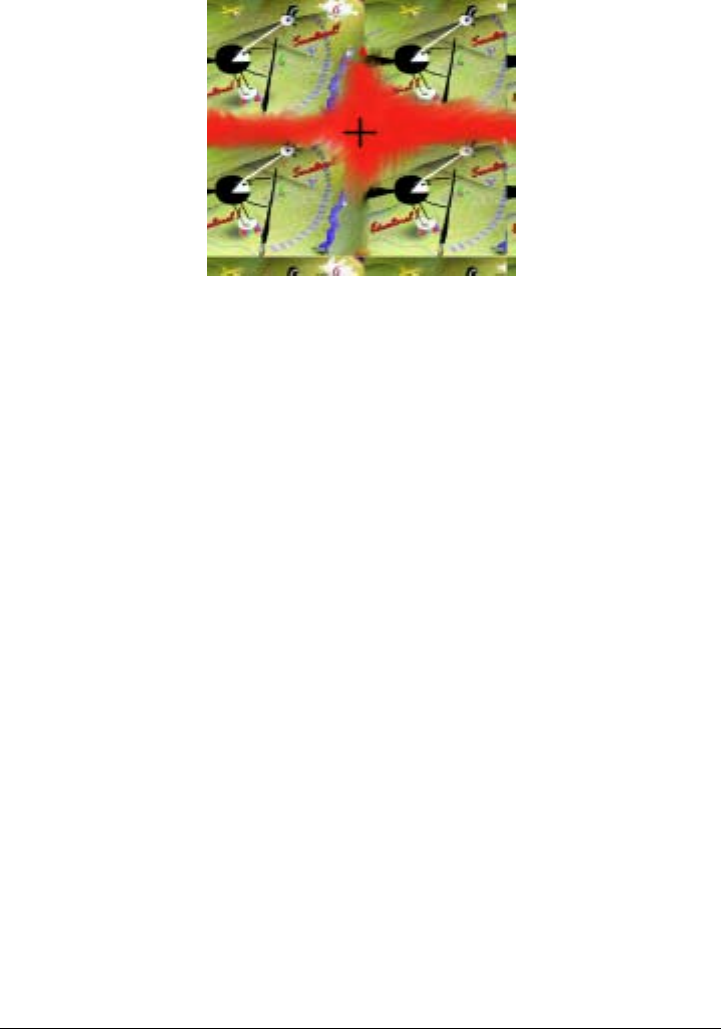
130 Corel Painter User Guide
The wrap-around seams feature lets you move the pattern
tile edges to the middle so that you can edit them.
To remove edge lines
•Do one of the following:
• To preserve detailed images, set the Straight Cloner brush to clone from
somewhere inside the image. For more information about cloning, see “Painting
in the Clone” on page 278.
• Paint out edge lines using any color brush.
• Smear across edge lines with a brush that uses Water or Drip brush methods.
• Copy a selection to a layer and move it over the line. Feather the layer, and
reduce opacity, to help produce clean transitions. Drop the layer when you’re
satisfied with the result. Refer to “Layers” on page 43 for more information
about working with layers.
Adding Patterns to the Pattern Library
You can add any image to the current Pattern library as a pattern tile.
To add a pattern to the library
1On the Patterns palette, click the palette menu arrow and choose Add Image to
Library.
2In the Save Image dialog box, give the pattern a descriptive name.
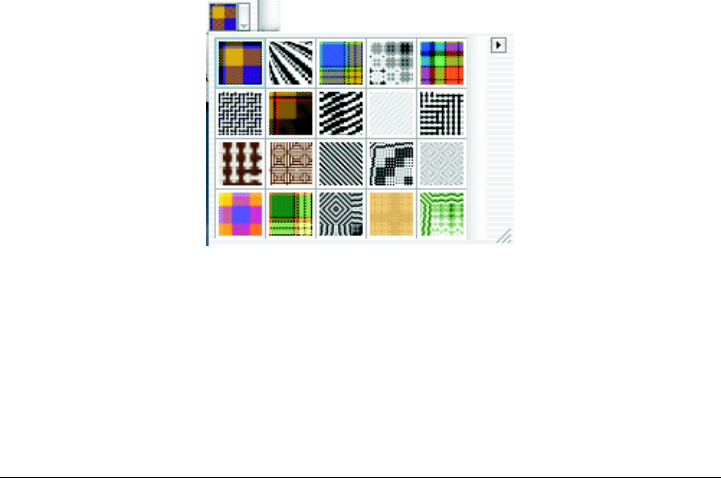
Textures, Patterns, and Weaves 131
If a pattern with that name already exists in this library, you are prompted to
replace it. If you don’t want to replace the existing pattern, click No to give the
pattern a different name.
Using Weaves
The Weaves palette is, in effect, a virtual loom that you can use to create weaves to use
as fill patterns. Weave libraries are included with Corel Painter. You can modify a
weave by changing the way it displays the scaling and thickness of its threads, or by
changing its colors. You can also create and save weaves of your own, and you can
preview your changes before you apply them.
Choosing Weaves
You can choose weaves from the Weave Selector on the Weaves palette. In addition,
you can change the way a weave displays at any time. You can also use the four sliders
at the bottom of the Weaves palette to control the thickness of threads and the spacing
between them. The top two sliders control horizontal dimensions; the bottom two
control vertical dimensions. By adjusting these sliders, you can create a wide variety of
weaves with any one of the patterns supplied.
The Weave Selector on the Weaves palette.
Corel Painter can display a weave as two-dimensional or show the interwoven threads
three-dimensionally, complete with shadows.
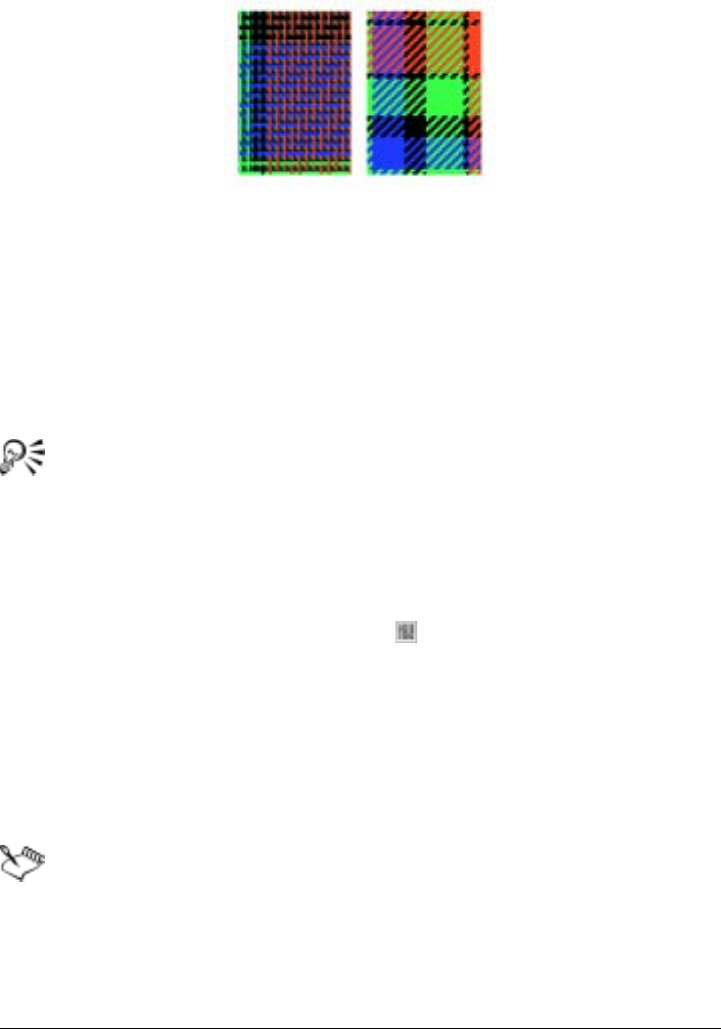
132 Corel Painter User Guide
A weave’s appearance changes, depending on whether you
display it as two-dimensional or three-dimensional.
To choose a weave
1Choose Window menu > Library Palettes > Show Weaves.
If the Weaves palette is not expanded, click the palette arrow.
2On the Weaves palette, click the Weave Selector.
3Choose a weave from the list.
You can also choose a weave from the Weave Selector in the toolbox.
To adjust scaling and thickness
1On the Weaves palette, choose a weave from the Weave Selector.
The weave displays in the Weave Preview Window.
2Click the Three-Dimensional Weave button to show a three-dimensional weave.
For most weaves, you won’t see a change in the preview until you adjust the scale
and thickness values.
3Adjust the horizontal and vertical scale sliders to increase the scale, thus enlarging
the weave.
4Adjust the horizontal and vertical thickness sliders to reduce the thickness.
You should begin to see a change in the Weave Preview Window.
Thickness sliders affect the three-dimensional display only. When you select a
two-dimensional display, the thickness sliders have no effect.
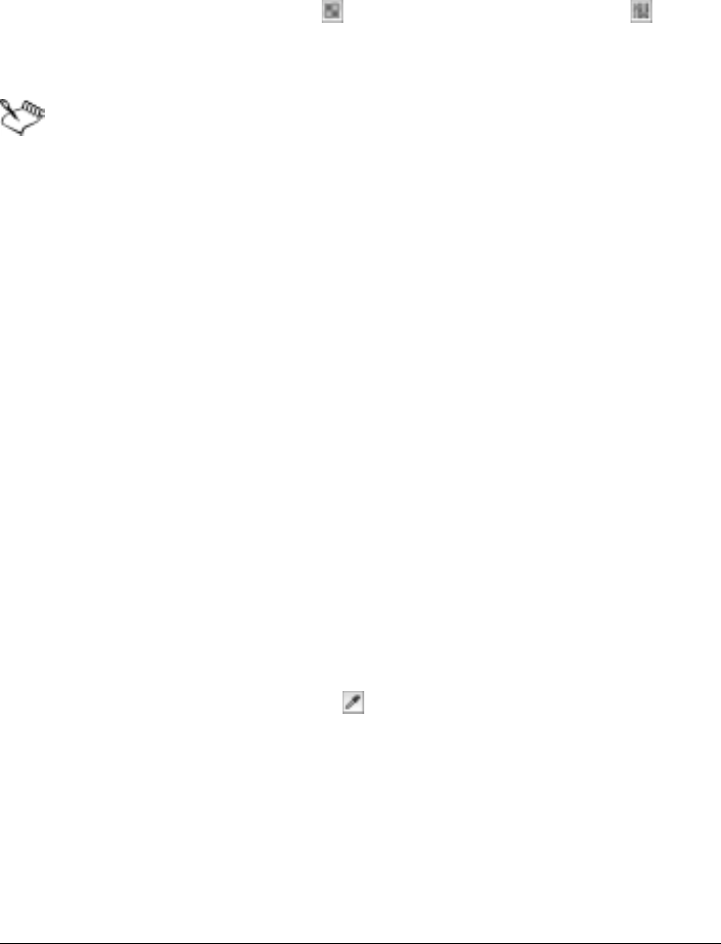
Textures, Patterns, and Weaves 133
To change how a weave is displayed
1Choose Window menu > Library Palettes > Show Weaves to display the Weaves
palette.
2Click the Two-Dimensional Weave or the Three-Dimensional Weave button.
The Weave Preview Window changes to show either a two-dimensional (Blocks) or
three-dimensional (Fibers) weave.
Depending on which weave is selected, you may or may not see a change in
the Weave Preview Window. For different two- and three-dimensional effects,
you can adjust the scaling and thickness sliders at the bottom of the Weaves
palette.
Editing Weave Colors
Each weave uses its own color set. You can display the color set used for a weave,
change the colors in the set, and apply the changed colors to the weave. Remember
that you can open several palettes and rearrange them to make it easier to see the
controls you need. For more information about color sets, see “Using Color Sets” on
page 92.
To display the color set for a weave
1On the Weaves palette, choose a weave from the Weave Selector.
2Click the palette menu arrow, and choose Get Color Set.
The color set for the selected weave appears in the Color Sets palette.
To change weave colors
1Choose a new color from the Colors palette or from the Color Sets palette, or
sample a color with the Dropper tool .
2Choose Window menu > Library Palettes > Show Weaves to display the Weaves
palette.
3On the Weaves palette, choose a weave from the Weave Selector.
4Click the palette menu arrow, and choose Get Color Set.
5On the Color Sets palette, hold down Command (Mac OS) or Ctrl (Windows), and
click the color swatch that you want to replace.

134 Corel Painter User Guide
The new color replaces the old one.
6On the Weaves palette, click the palette menu arrow, and choose Put Color Set.
The Preview window shows the weave with the new colors. If you fill an image with
the weave pattern, Corel Painter now uses the new color set.
Saving Weaves
After altering the scaling, thickness, or color of a weave, you can save your changes as
a new weave.
To save a weave
1On the Weaves palette, click the palette menu arrow and choose Save Weave.
2In the Save Weave dialog box, type a name for the weave.
If you don’t type a new name, Corel Painter replaces the existing weave with the
changed weave. The new weave pattern appears in the current Weaves library.
Advanced Weaving
Corel Painter lets you create woven fabrics of virtually any description. You can create
fabrics for wallpapers, carpets, clothes, and furniture.
To create your own weaves
1On the Weaves palette, click the palette menu arrow and choose Edit Weave.
2In the Edit Weave dialog box, adjust the controls for drafting a weave on the
8-harness, 8-treadle loom.

Jeremy Sutton, a San Francisco-based artist, author and educator, with a degree in Physics from
Oxford University, has drawn and painted in traditional media for over 40 years and used Painter
since 1991. Jeremy has written a number of books, including Painter IX Creativity: Digital
Artist’s Handbook and Fractal Design Painter Creative Techniques and has produced other Painter
training materials, such as video and DVD tutorials.
Art by Jeremy Sutton: Digital portrait painting
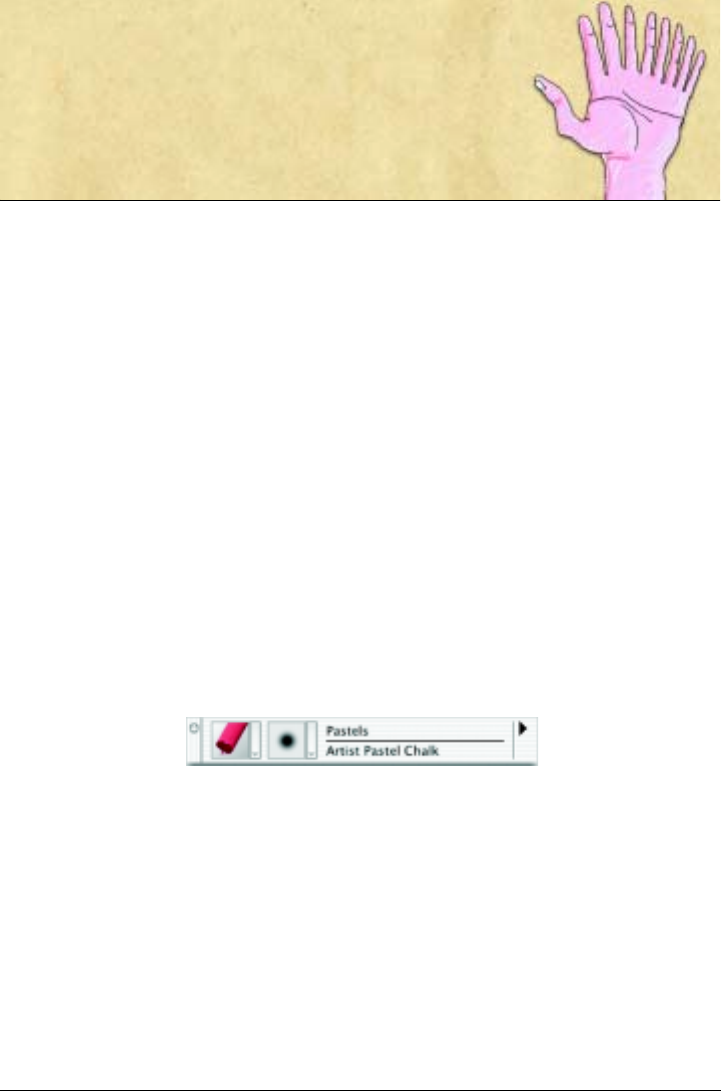
Painting 137
Painting
The Corel Painter application lets you draw and paint as you might with real artists’
tools and media. In your studio, you use brushes, pens, pencils, chalk, airbrushes, and
palette knives to make marks on a canvas or piece of paper. With Corel Painter, an
infinite variety of marks are possible. Like a fully stocked art store, Corel Painter
supplies you with many different brushes and drawing tools, each with modifiable
characteristics.
Exploring Brushes
The Corel Painter Brush tool offers users a wide range of preset painting and drawing
tools called brush variants. Brush variants are organized into categories, such as
Airbrushes, Artists’ Oils, Calligraphy, Pencils, and Watercolor. They are designed
with real media in mind, so you can select a tool with an expectation of how it will
behave. For example, you’ll find a 2B Pencil brush variant in the Pencils category, and
a Fine Camel brush variant in the Watercolor category. The Brush Selector Bar lets you
choose a category and brush variant quickly and easily.
The Brush Selector Bar lets you choose a brush category
(left) and a brush variant (right) quickly and easily.
You can use the Corel Painter brush variants as they are, or you can adjust them to suit
your purposes. Many artists use Corel Painter brush variants with only minor
adjustments — to size, opacity, or grain (how much color penetrates paper texture).
If you want to make more extensive modifications to a brush or create a totally new
brush variant, you can do just that by using brush controls.
Most Corel Painter brushes apply media (a color, gradient, or pattern) to an image.
Some brushes, however, do not apply media. Instead, they make changes to media
already in the image. For example, the Just Add Water brush variant (in the Blenders
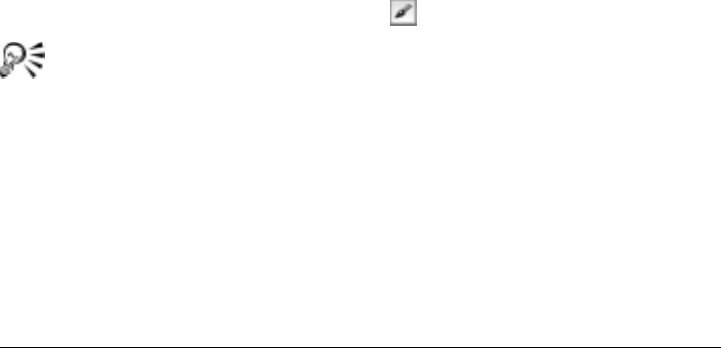
138 Corel Painter User Guide
brush category) smudges and dilutes existing colors in the image with smooth,
anti-aliased strokes. Using one of these brushes on a blank area of the canvas has no
effect.
Corel Painter includes a batch of Natural-Media brushes that use a media application
method called “rendered dab types” to produce “computed” brush strokes. These
brushes create wonderfully realistic, continuous, smooth-edged strokes. They are fast
and more consistent because the strokes are computed as you draw, not created by
applying dabs of color. In fact, you can’t draw fast enough to leave dabs or dots of color
in a stroke. These brushes allow for rich features that are not possible with dab-based
media application. You can take better advantage of tilt and angle, and you can paint
with patterns or gradients. For information about using rendered dab types when
customizing brushes, refer to “Dab Types” on page 205.
If you’re looking for a brush from a previous version of Corel Painter, you can reload
the old version’s brush library.
Selecting a Brush
On the Brush Selector bar, you can choose from brush variants that are arranged in
recognizable categories. Corel Painter brushes are built to emulate Natural-Media
tools, which lets you select a tool with a reasonable expectation of how it will behave.
In an art store, if the tools in one aisle don’t produce the results you want, you can try
a different aisle. Similarly, with Corel Painter, you can try different brush categories to
find the tool you want.
To show the Brush Selector bar
• In the toolbox, double-click the Brush tool .
You can also show the Brush Selector bar by choosing Window menu > Show
Brush Selector Bar.
To choose a brush
1On the Brush Selector bar, choose a brush category from the Brush Category
selector.
2Choose a variant from the Brush Variant selector.

Painting 139
Choosing Brush Settings
Basic brush controls for size, opacity, and grain are located on the property bar. The
property bar may also contain additional controls for the selected brush category, such
as resaturation, bleed, and jitter.
When a brush is selected and positioned over the canvas, the cursor changes, by
default, into a “ghost” of the brush — mirroring size and shape — so you can see the
area that you’re about to paint. This ghost brush provides a handy way to see if a
change in size is required.
The Brush Creator contains other controls, depending on the selected variant.
Eventually, you’ll want to learn about these and other advanced controls. For example,
the Brush Creator offers more sophisticated controls for resizing and shaping brushes,
including a minimum (Min) size setting. When a brush takes advantage of the Min
size setting, you’ll see strokes taper and widen as stylus pressure or direction is varied.
For complete information about using the Brush Creator, refer to “Customizing
Brushes” on page 197. For more information on saving customized brushes as custom
variants, refer to “Saving Brush Variants” on page 263.
Setting Brush Size
The Size slider on the property bar determines the size of a single brush dab. The text
field next to this slider lets you enter a specific size (in pixels).
To set brush size
1Choose the Brush tool from the toolbox.
2Choose a brush from the Brush Selector bar.
3On the property bar, type a value in the Size box, or adjust the pop-up slider.
Corel Painter may need to rebuild the brush after you resize it. Automatic
rebuilding of modified brushes is the default in Corel Painter. Expect a short delay
while Corel Painter is rebuilding the brush.
To use the resize shortcut
1Hold down Command + Option + Shift (Mac OS) or Ctrl + Alt + Shift
(Windows).
2With the Brush tool, drag in the image window.

140 Corel Painter User Guide
A circle representing the brush size is displayed beside the pointer. When the circle
is the size you want, release the mouse button.
3Click the image to reactivate the Brush tool.
A handy way to set brush size is to use the keyboard shortcut:
Command + Option + Shift (Mac OS) or Ctrl + Alt + Shift (Windows).
You can also adjust brush size “on the fly” by using the square bracket keys:
To increase brush size incrementally, click the right square bracket ( ] ) key. To
decrease brush size incrementally, click the left square bracket ( [ ) key.
Adjusting Opacity and Grain
The Opacity slider controls the degree to which a stroke “covers” or “builds up” on the
underlying pixels.
80% opacity (top) and 20% opacity (bottom).
The Grain slider controls how much color penetrates into the paper texture. Lower
settings show more of the grain.
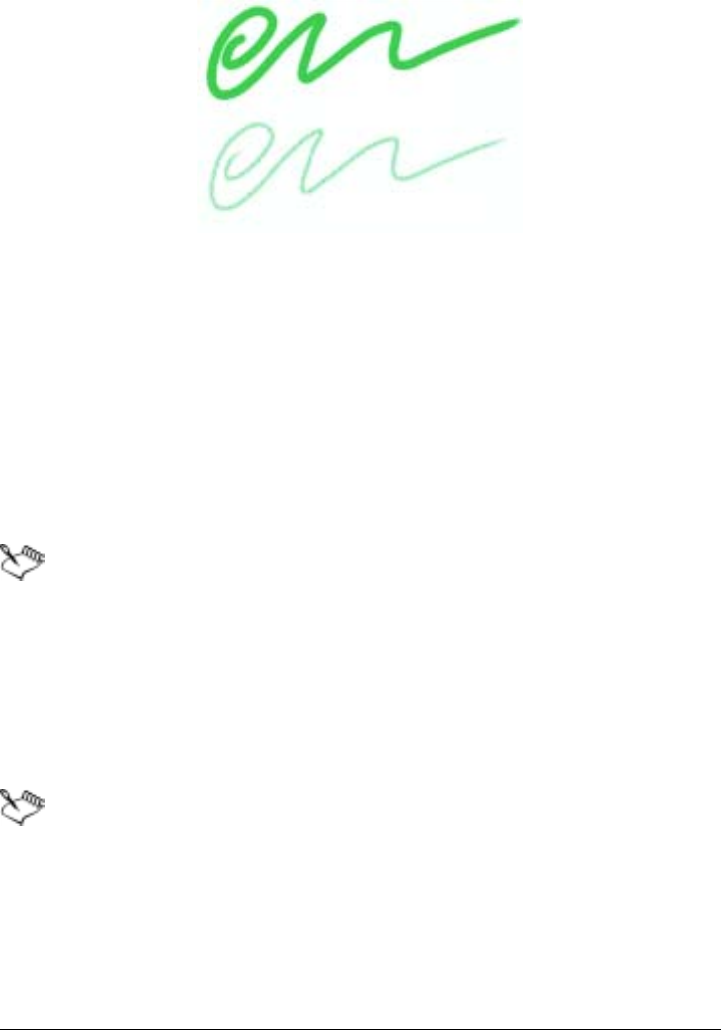
Painting 141
89% grain (top), and 12% grain (bottom).
To set opacity
1Choose the Brush tool from the toolbox.
2Choose a brush from the Brush Selector bar.
3On the property bar, type a percentage in the Opacity box, or adjust the pop-up
slider.
When Opacity setting is low, the applied color is thin, allowing you to see through
to the underlying colors. When the setting is high, the applied color covers
underlying pixels more completely.
Some methods and dab types do not allow for adjustments in opacity.
To set grain
•On the Brush property bar, type a percentage in the Grain box, or adjust the
pop-up slider.
Move the slider to the left to reduce penetration and reveal more texture. Move it
to the right to increase penetration and reveal less grain.
For liquid media brushes, Grain controls the amount of “pull.” For
Image Hose brushes, Grain controls the mixture with the additional color. For
other brushes, such as airbrushes, the Grain slider is not available.

142 Corel Painter User Guide
Using a Stylus or Mouse
When you reach for a wide, flat brush, you expect the stroke you make to depend on
how you hold the brush. A stroke using the face of the brush comes out wide. A mark
using the edge is narrow.
Paint with the face of a flat brush for a wide stroke; use the edge for a narrow stroke.
Corel Painter produces realistic brush strokes that fade in and out; change width, tilt,
and angle; and penetrate based on the stylus input. Brush variants that use computed
brushes, such as the Smeary Flat variant in the Oils category, also react to stylus tilt
(how close to vertical the stylus is held) and bearing (the compass direction in which
the stylus is pointing).
Tilt can significantly affect brush strokes. If you get unexpected results, especially with
bristle-type brushes or airbrushes, you can try reducing the tilt of your stylus. Extreme
tilt angles are usually undesirable.
Many Corel Painter brushes also respond to stylus pressure (how hard you press with
the stylus). Depending on variant settings, greater stylus pressure can increase the
width of a brush stroke, the penetration of color, or the degree of other effects. The
Corel Painter airbrushes also respond to the fingerwheel on the Wacom Intuos
airbrush, simulating a needle control that adjusts how much ink is sprayed.
You can link brush settings (such as size, opacity, and angle) to stylus input data (such
as velocity, direction, pressure, airbrush fingerwheel, tilt, and bearing). Refer to
“Expression Settings” on page 262 for more information about linking brush settings
to stylus input controls.
In theory, a mouse has no pressure information. A mouse button is either “on” (button
down) or “off” (button up). Corel Painter introduces mouse controls that let you
simulate stylus pressure, tilt, bearing, and fingerwheel settings.

Painting 143
If you are using a mouse with Corel Painter, you can compensate for the lack of
pressure information by adjusting size, opacity, and grain on the property bar. For
example, reducing opacity or grain can produce the same results as pressing more
lightly with a stylus.
The content CD contains brushes designed specifically for use with a mouse. For
information about loading alternate brush libraries, refer to “Loading Alternate
Libraries” in the Help.
Corel Painter lets you record brush strokes, save them, and later use the saved stroke
data. This makes it possible to record a stylus-created brush stroke, save it, and then
use a mouse to reproduce the stroke that you made originally with the stylus. Refer to
“Recording and Playing Back Strokes” on page 161 for more information about
recording brush strokes to further enhance mouse functionality.
To adjust pressure, tilt, and bearing when using a mouse
1On the Stroke Designer page of the Brush Creator, click Mouse.
2Move the Pressure slider.
A 100% setting uses maximum pressure.
3Move the Tilt slider.
A 90° setting simulates a stylus that is perpendicular to the tablet.
4Move the Bearing slider.
A setting of zero indicates that if a stylus were in use, it would be pointing left.
To see the effect of the tilt setting, use the Fine Spray variant of the Airbrush
category.
To adjust fingerwheel settings when using a mouse
1On the Stroke Designer page of the Brush Creator, click General.
2Choose Wheel from the Expression pop-up menu.
3Choose Mouse.
4Move the Wheel slider.
A 90% setting indicates that if a stylus were in use, it would be perpendicular to
the tablet.

144 Corel Painter User Guide
Marking the Canvas
You can paint on the canvas or on a layer above the canvas. When you select a layer on
the Layers palette, that layer becomes the target for your brush strokes.
If you are using a Water Color brush, you can paint only on a Water Color layer. If you
are using a Liquid Ink brush, you can paint only on a Liquid Ink layer. For more
information, refer to “Working with the Watercolor Layer” on page 170 and “Working
with the Liquid Ink Layer” on page 175.
If you try to paint on a shape, dynamic layer, or reference layer, you must commit it to
a standard layer so that your brush strokes are accepted.
You can also select a channel or a layer mask as the target for your brush strokes. For
more information, refer to “Managing and Editing Channels” and “Creating Layer
Masks” in the Help.
When you have an active selection, painting is confined to the selection by default.
Refer to “Selections” in the Help for more information about selections.
In all cases, your brush strokes go to the selected target, so you should check that it
matches your intended destination before you start to paint.
You mark the canvas by selecting the Brush tool and dragging in the document
window with a brush variant that applies media. Each time you drag, you create a
brush stroke.
When you use complex brush variants, you see a dotted line on the canvas before the
mark appears. For example, the Gloopy variant of the Impasto brush requires complex
computations that delay the stroke’s appearance on the screen. When you experience a
delay, you can queue up strokes, without losing any stroke data.
Freehand vs. Straight-Line Drawing
You can draw unconstrained lines by using the freehand drawing style, or you can
draw straight lines. Options on the property bar let you choose the drawing style.
When you use Freehand Strokes, you can drag with any motion or in any direction.
The stroke follows your drag path.

Painting 145
With the Freehand Stroke option, you drag to create strokes.
When you use Straight Line Strokes, Corel Painter connects points with a straight line.
With the Straight Line Strokes option, you click to create
the first point and then click or drag to create a stroke.
To draw freehand lines
1On the Brush property bar, click the Freehand Strokes button .
2Drag on the canvas.
You can use shortcut keys to toggle between the freehand and straight line
drawing styles. Press B to choose the freehand style, or V to choose the
straight-line style.
To draw straight lines
1On the Brush property bar, click the Straight Line Strokes button .
2Click a point on the canvas where you want to start your line.
3Do one of the following:
• Click the point where you want to end the line.
• Drag to place the end point exactly where you want it.
Corel Painter connects the first and second points with a straight line.
4To continue drawing from the second point, click or drag to create additional
points on the canvas.

146 Corel Painter User Guide
Corel Painter connects each point with a straight line.
5To end a line, do one of the following:
• Press Return (Mac OS) or Enter (Windows) to close the polygon. The final point
is connected to the origin with a straight line.
• Click the Freehand Strokes button to return to the freehand drawing style
without closing the polygon.
• Press V to end the current polygon without closing it, so that you can begin a
new one.
Constraining, Fading, and Undoing Strokes
In either drawing style, you can constrain your strokes to 45° angle increments. With
the Freehand Strokes option, each stroke is constrained to a straight line, with the
angle depending on the orientation of the stroke. With the Straight Line Strokes
option, points are connected with lines at 45° angle increments.
If you apply a stroke, but want it to be less opaque or faded.
You can use the Undo command to remove it. You can repeat the command to remove
previous strokes and set how many individual strokes can be undone. For more
information, refer to “Undo Preferences” on page 38.
To constrain strokes to 45° angle increments
•Hold down Shift as you drag or click.
In Straight Line mode, you can also constrain lines to the grid by enabling the
Snap to Grid option. Choose Canvas menu > Grid > Snap to Grid.
To fade a stroke
1Choose Edit menu > Fade.
2Set the Undo Amount slider for the opacity you want, and click OK.
The Preview window shows the results of your selection.
To undo a stroke
•Choose Edit menu > Undo Brush Stroke.
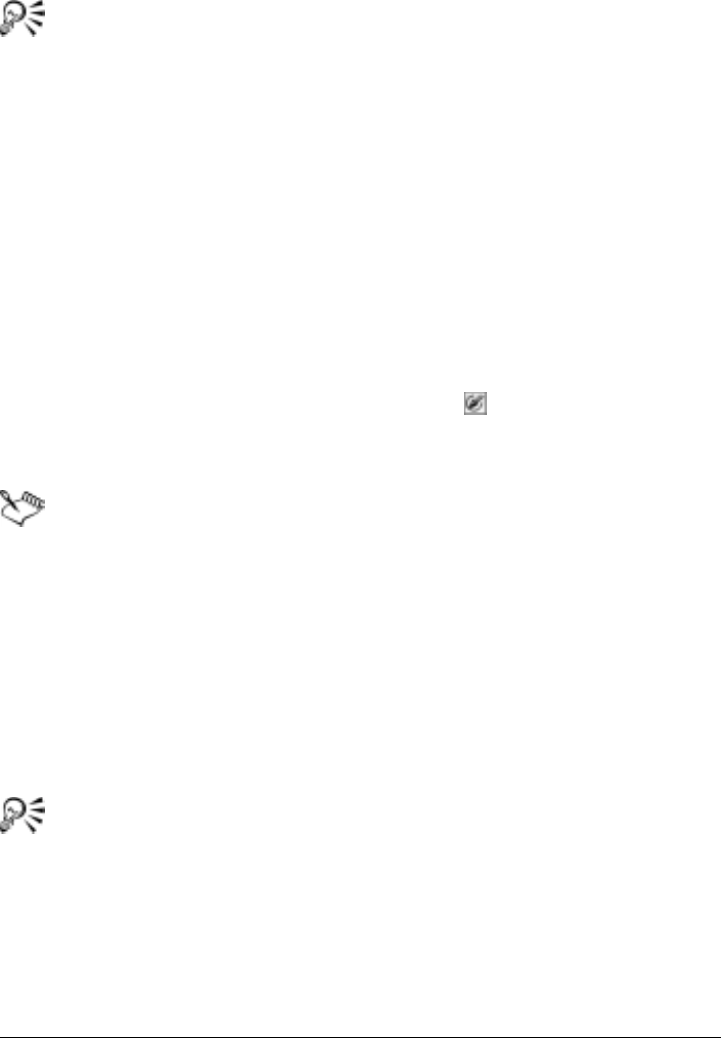
Painting 147
You can also undo a stroke by pressing Command + Z (Mac OS) or Ctrl + Z
(Windows).
Aligning Brush Strokes to Paths and Shapes
You can automatically align a brush stroke to a path or the edge of a shape. You do this
by determining the tolerance area, or how close the brush stroke must be to the path
or shape for automatic alignment to occur. If the brush stoke is within the tolerance
area, the brush stroke snaps to the path or shape; if the brush stroke is outside of the
tolerance area, no brush stroke is applied.
To align a brush stroke to a path or shape
1Choose a brush from the Brush Selector bar.
2On the property bar, click the Align to Path button .
Brush strokes within the tolerance area of a path or shape are automatically
aligned.
If there are multiple shapes within the tolerance area, the brush stroke is
aligned to the shape on the selected layer.
To set the tolerance area for brush stroke alignment
1Choose one of the following:
• (Mac OS) Corel Painter IX menu > Preferences > Shapes
• (Windows) Edit > Preferences > Shapes
2In the Align to Path area, type a number in the Tolerance box.
The tolerance area is measured in pixels and must be between 1 and 999.
If you want to align a brush stroke with a hidden shape or path, enable the
Paint Hidden Shapes check box.
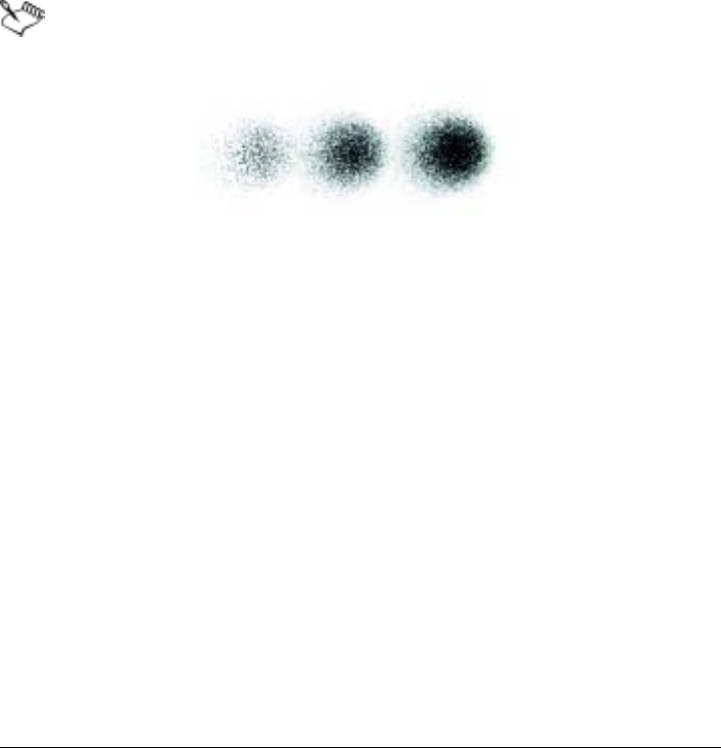
148 Corel Painter User Guide
Letting Media Pool
Corel Painter computed brushes allow media to build up or “pool” when you move a
brush slowly. Pooling creates very realistic strokes, especially with airbrushes. You can
also cause media to pool by simply touching and pausing with the selected brush. You
can enable this feature in the Brush Creator.
To enable media pooling
1On the Stroke Designer page of the Brush Creator, click Spacing.
2Enable the Continuous Time Deposition check box.
When the Continuous Time Deposition check box is disabled, you must move
the brush (even just slightly) to cause media to be deposited.
With an airbrush, paint pools when you pause in a stroke for
1 second (left), 4 seconds (middle), and 7 seconds (right).
Making 360° Strokes
Because there are no restrictions on bearing (stylus direction) in Corel Painter, you can
create full 360° strokes with noncomputed brushes by completing an arc without
interruption. Computed brushes use bearing, with the exception of those that use the
Rendered dab type, so you cannot use them to create 360° strokes.
Exploring Painting
Many Corel Painter brush variants are digital equivalents of real-life brushes you might
already use. Others let you create images that aren’t possible with real-life tools.

Painting 149
Corel Painter features “computed” brushes that create smooth, continuous strokes.
You can use these brushes to apply color, brush on gradients, or paint with patterns.
For more information about computed brushes, refer to “Using a Stylus or Mouse” on
page 142.
Corel Painter brushes can be changed in many ways to create the look you desire. For
example, you can start with a pencil and then change the settings until the tool works
like an airbrush. You can also modify an oil pastel to create a pastel brush, or make a
leaky pen act like a camel hair brush. Suddenly, the art store has unlimited aisles and
floors, giving you the freedom to create whatever you imagine. For more information
about using controls to customize brushes, refer to “Customizing Brushes” on
page 197.
The result of any single mark or stroke you make with a Corel Painter drawing tool
depends on the following:
• The brush category (or drawing tool) you choose. Refer to “Understanding Brush
Categories” in the Help for more information.
• The brush variant you select within the brush category. Refer to “Selecting a Brush”
on page 138 for more information about selecting a specific brush variant.
• Controls such as brush size, opacity, and the amount of color penetrating paper
texture. Refer to “Choosing Brush Settings” on page 139 for more information.
• The current paper texture. Refer to “Choosing Paper Textures” on page 115 for
more information about selecting paper.
• The color, gradient, or pattern you use as media. Refer to “Painting with Color” on
page 149 and “Painting with Gradients and Patterns” on page 153 for more
information about choosing media.
• The brush method. Refer to “Methods and Subcategories” on page 211.
Painting with Color
Before actually painting, you must choose which media to apply. Most often, you may
choose to apply a color, but selecting a color is just the beginning. Corel Painter offers
a powerful range of color features, including random color variability and color sets.
For more detailed information about using color, refer to “Getting Started with Color”
on page 77.
To paint with color
1Select a brush that applies media to a document.
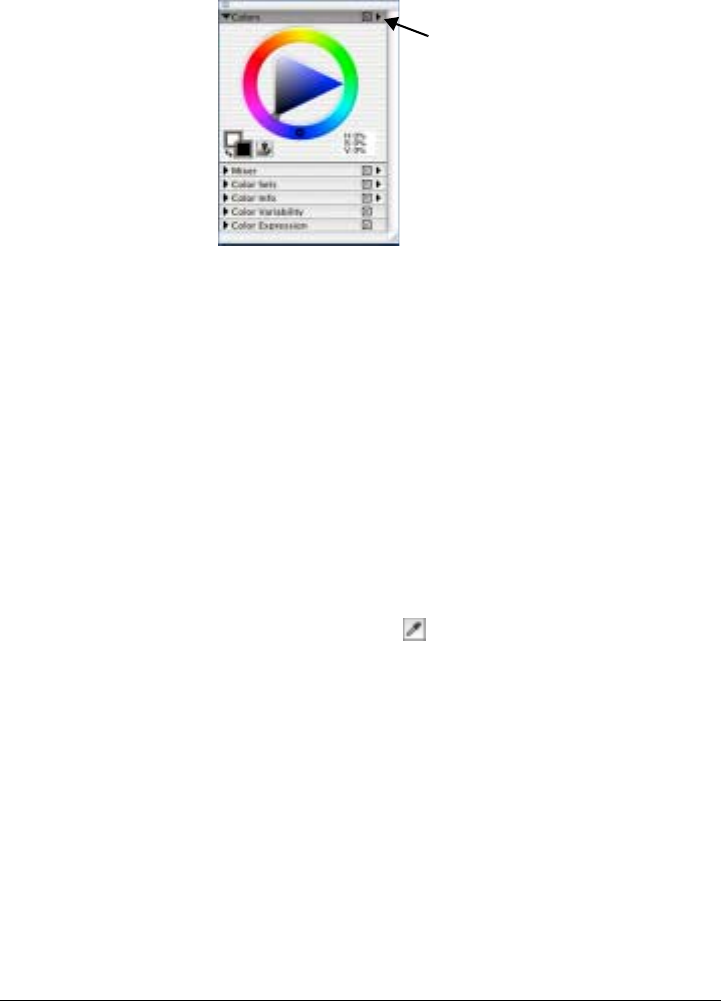
150 Corel Painter User Guide
2On the Colors palette, click the palette menu arrow, and choose Standard Colors.
3Drag or click in the Hue Ring to select a hue.
4Drag or click in the Saturation/Value Triangle to pick the saturation.
The color you select becomes the main color and is displayed in the front square
below the Hue Ring. The back square shows the additional color. The additional
color is not the canvas color; it is used to create two-color brush strokes and
two-point gradients. Refer to “Understanding Main and Additional Colors” on
page 80 for more information.
5Paint in the document window.
To paint with a color already in the image
1Select a brush that applies media to a document.
2Hold down Option (Mac OS) or Alt (Windows), and click a color in the image.
The Brush tool switches to the Dropper tool . The color is “picked up” by the
Dropper tool and becomes the main color. Refer to “Understanding Main and
Additional Colors” on page 80 for more information about using the Dropper tool.
3Paint in the document window.
Creating Two-Color Brush Strokes
Usually, you work with only the main color — the front square of the two overlapping
squares on the Colors palette. Using one color produces a solid, one-color brush stroke.
By selecting an additional color, you can create a two-color brush stroke.
To set up a two-color brush stroke
1On the Brush Selector bar, choose a brush category.
Palette menu
arrow

Painting 151
Not all brushes can create two-color brush strokes. Among those that can are
Acrylics, Calligraphy, and Chalk.
2From the Brush Variant selector, choose a variant with a noncomputed dab type —
for example, the Circular dab type.
A noncomputed dab type is dab-based, as opposed to rendered. For more
information, see “Dab Types” on page 205.
3On the Colors palette, click the palette menu arrow, and choose Standard Colors.
If the Colors palette is not displayed, choose Window menu > Color Palettes >
Show Colors.
4Click the Main Color (front) square .
5Choose a color on the Colors palette or the Color Sets palette.
The front square changes according to your selection.
6Click the Additional Color (back) square .
7Choose a color on the Colors palette or the Color Sets palette.
The back square changes according to your selection.
8Click the Main Color (front) square.
This step reactivates the main color for the next time you pick a color.
9Choose Window menu > Brush Controls > Show Color Expression to display the
Color Expression palette.
If the palette is not expanded, click the palette arrow.
10 On the Color Expression palette, choose Direction from the Controller pop-up
menu.
11 Paint a “T” in your document. Draw some loops and circles to see how the
transition between colors depends on brush stroke direction.
For information about using the Color Sets palette to choose a color, refer to
“Using Color Sets” on page 92.
For different results, try different Controller settings. For example, choose
Pressure to create color transitions based on the pressure you apply with your
stylus.

152 Corel Painter User Guide
Loading Multiple Colors
Imagine the ability to load color at a bristle level, picking up different colors with each
“hair” of a brush — as though filling tiny ink wells. Imagine also the ability to move
multiple colors along with a palette knife, dragging them across your canvas or paper.
The Brush Loading feature affects how paint comes off a brush and what happens to
the pixels underneath.
When Brush Loading is not active, brushes interact with previously applied colors by
sampling underlying pixels and then loading the brush with one new color — the
average of those that were sampled. With Brush Loading active, brushes can literally
“pick up” existing colors, hair by hair. This capability offers truer color interaction,
astounding color variations, and better cloning results.
To paint with multiple colors
1Choose a brush.
2On the Stroke Designer page of the Brush Creator, click General.
3Choose Static Bristle from the Dab Type pop-up menu.
4Choose Multi from the Stroke Type pop-up menu.
5On the Stroke Designer page, click Well, and enable the Brush Loading check box.
This step activates the brush’s ability to pick up underlying colors.
6Adjust the Resaturation and Bleed sliders.
The Bleed setting determines how much underlying paint is affected by the brush
stroke. A higher Bleed setting, combined with a low Resaturation setting, can
enhance the Brush Loading feature. A resaturation value of 0, combined with
different levels of bleed, will cause your brush to smear image color, rather than
deposit it. In this case, the lower the bleed, the longer the smear.
7On the Stroke Designer page, click Spacing, and adjust the Spacing and
Min Spacing sliders to create fewer “echo” artifacts in your smeared stroke.
8Drag a brush stroke through existing paint to see how the paint is “picked up”
from the underlying pixels and moved across the canvas.
It is easier to see the Brush Loading feature if the canvas is not white. To fill
the canvas with another color, refer to “Filling an Area with Media” on
page 163.

Painting 153
You can tie brush controls like Bleed to the Controller setting on the
Color Expression palette. For example, if you choose Pressure, each stroke
bleeds more or less, depending on how hard you press the stylus. For more
information, refer to “Expression Settings” on page 262.
Troubleshooting
Why doesn’t your brush stroke appear? What to check:
• Main color — On the Colors palette, what color is the Main Color (front) square? Is
it a color that will show up when applied to your image? If not, click the Main
Color square to be sure it’s selected, and then set a different color.
• Opacity — Check the Opacity setting on the property bar and, if necessary, adjust
the pop-up slider to increase opacity.
•Brush method — The brush method determines the basic nature of a brush. To
check the brush method, click General on the Stroke Designer page of the Brush
Creator. If you’re drawing with a light color on a dark background, the method
must be set to Cover, in order to show the lighter color.
• Drawing mode — If you have made a selection, the drawing mode determines
what part of the selection is protected. Refer to “Selecting a Drawing Mode” in the
Help for more information.
• Layers — Are you drawing on the canvas with a layer blocking your view of the
brush stroke? On the Layers palette, close the visibility eye of each layer to view
only the canvas.
Painting with Gradients and Patterns
With the Corel Painter computed brushes, you can brush on gradients, which are
gradual transformations of one color into another. Refer to “Working with Gradients”
on page 104 for more information. You can also use the Corel Painter computed
brushes to brush on patterns (repeating designs). Refer to “Using Patterns” on
page 120 for more information.
When you paint with a pattern, you can adjust the pattern’s scale. Scale affects a
pattern brush stroke in a special way by determining the resolution of the painted
patterns.
Small scale causes blurry computed brush strokes; large scale causes sharper strokes.
Here’s why: The brush stroke is always drawn as the entire pattern, sized to fit in the
current dab size. Scaling the pattern down very small (for example, to 20%) makes the

154 Corel Painter User Guide
brush stroke appear blurry, because the dab is significantly bigger than the pattern.
Scaling the pattern up to 100% makes the dab as clear as it can get. Settings higher
than 100% have no effect on the appearance of the brush stroke.
You can picture this process by imagining that the current pattern is 100 pixels across
and the current brush size is 50 pixels across. With the pattern set to 100%,
Corel Painter shrinks 100 pixels into a 50-pixel area, which it can easily do without
visible loss of accuracy. If you scale the pattern up to 200%, it looks as clear as the
original, so that fitting it into the 50-pixel brush size creates a brush stroke that looks
the same as when the pattern was scaled at 100%. If you scale the pattern to 50%, the
original will be the same size as the brush, so there is still no difference in the resulting
brush stroke.
Now, keep scaling downward. As the size of the pattern is scaled below the size of the
brush, Corel Painter must increase the size of the pattern to fit the 50-pixel area of the
brush stroke. When images are scaled up, after first being scaled down, the image
becomes blurry. This is especially noticeable if you scale the pattern well below brush
size. At 20%, the pattern now consists of only 20 pixels and has lost 80% of the
original data. When Corel Painter expands that to 50 pixels (the brush stroke size), the
loss of data becomes very visible. Lower settings in scale result in even blurrier brush
strokes. If you scale down to 2%, the pattern is only 2 pixels across and is able to
contain, at most, four colors (two across and two down). When Corel Painter expands
the image to fit the brush stroke, you won’t see any of the original pattern, just a fairly
uniform color, across the dab.
To paint with a gradient
1Select a brush that applies media to a document.
If the Gradients palette is not displayed, choose Window menu > Library Palettes
> Show Gradients.
If the Gradients palette is not expanded, click the palette arrow.
2On the Gradients palette, choose a gradient from the Gradient Selector.
In the center of the palette, the Gradient Preview Window shows the selected
gradient.
3Click one of the following Gradient Order buttons:
• Left to Right Gradient
• Mirrored Right to Left Gradient
• Double Left to Right Gradient
• Right to Left Gradient
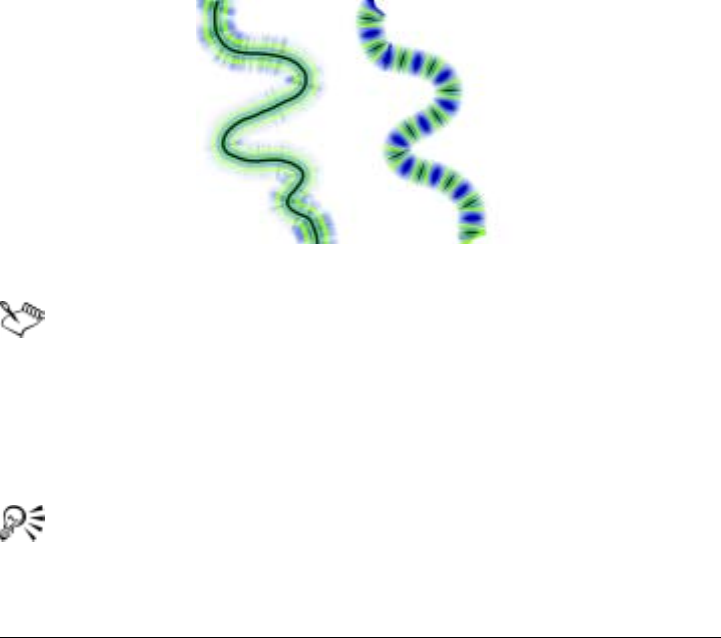
Painting 155
• Mirrored Left to Right Gradient
• Double Right to Left Gradient
The Gradient Preview Window above the Order buttons illustrates how the
selected order affects the gradient. Refer to “Working with Gradients” on page 104
for more information about gradient order.
4On the Stroke Designer page of the Brush Creator, click General.
5From the Dab Type pop-up menu, choose a dab type that activates the Source
pop-up menu (for example, Rendered).
6Choose one of the following from the Source pop-up menu:
• Gradient, which applies the current gradient across the width of the stroke.
• Gradient Repeat, which repeats the current gradient along the length of the
stroke.
7Paint in the document window.
Painting with a gradient by using Gradient (left) and Gradient Repeat (right).
If the Source pop-up menu is not available (appears grayed out), the selected
brush can apply color only. In that case, select a computed brush or choose a
dab type that activates the Source pop-up menu.
Although you can choose a gradient type (Linear, Radial, Circular, or Spiral)
on the Gradients palette, you always use a Linear gradient type when painting
with a gradient.
You can also choose a gradient from the Gradient Selector in the toolbox.
Corel Painter uses the current gradient order.
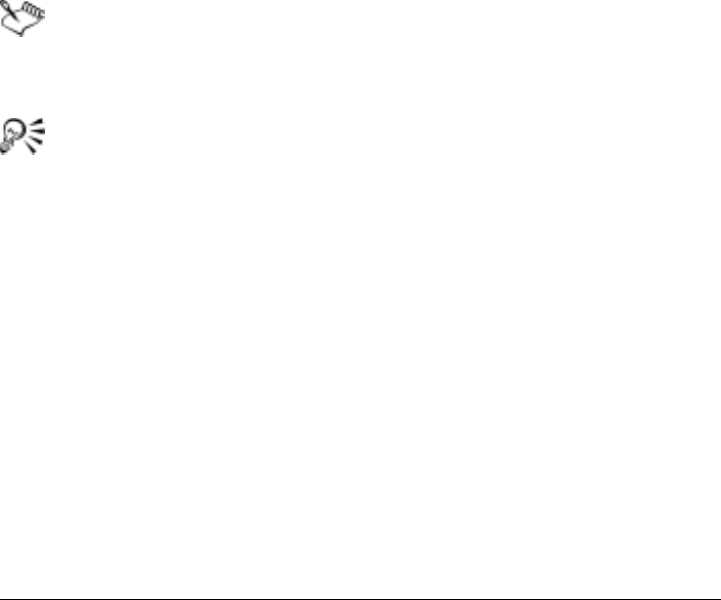
156 Corel Painter User Guide
Keep in mind that direction matters when you paint with a gradient.
Corel Painter flips the gradient when you change direction, so apply strokes in
the same direction for a uniform effect.
To paint with a pattern
1Select a brush that applies media to a document.
2On the Patterns palette, choose a pattern from the Pattern Selector.
3Adjust the Pattern Scale slider.
4On the Stroke Designer page of the Brush Creator, click General.
5From the Dab Type pop-up menu, choose a dab type that activates the Source
pop-up menu (for example, Rendered).
6Choose one of the following from the Source pop-up menu:
• Pattern, to paint with a pattern containing no mask information.
• Pattern with Mask, to paint by using mask data contained in the pattern.
If the Source option is not available (appears grayed out), the selected brush
can apply color only. In that case, select a computed brush, or choose a dab
type that activates the Source pop-up menu.
Keep in mind that direction matters when you paint with a pattern.
Corel Painter flips the pattern when you change direction, so apply strokes in
the same direction for a uniform effect.
To paint with pattern opacity
1Select a brush that applies media to a document.
2On the Patterns palette, choose a pattern from the Pattern Selector.
3On the Stroke Designer page of the Brush Creator, click General.
4From the Dab Type pop-up menu, choose a dab type that activates Source (for
example, Rendered).
5Choose Pattern As Opacity from the Source pop-up menu.
Pattern As Opacity is the only computed dab type that responds to methods (Cover
and Buildup), allowing it to respond to Graininess.
6Paint on your image.

Painting 157
Corel Painter applies the current color, using luminance in the pattern to control
opacity. Light colors in the pattern are rendered as transparent (or as having very
low opacity). Dark colors in the pattern are rendered as very dark (or as having
high opacity).
Painting with Airbrushes
The Corel Painter computed airbrushes are so realistic, you feel as though you’re using
the real thing. Taking advantage of computed dab-type technology, most airbrush
functionality is now available. For more about computed brushes, refer to “Dab Types”
on page 205.
The best way to get used to the Corel Painter airbrushes is to play with them. Select
each variant and spray paint onto the canvas without worrying about running out of
compressed air. With computed airbrushes, you can paint with color, patterns, or
variants. One variant blows hairlike strokes; another variant just blows existing paint
around on the canvas, like a hose without an airbrush attached.
Try using the Fine Spray variant in the Airbrushes category for an example of how
Bearing and Flow settings combine to give realistic airbrush results.
For information about the Airbrush controls in the Brush Creator, refer to “Airbrushes”
in the Help.
Conic Sections
Previous versions of digital airbrushes projected a thin mist of dots (or paint dabs) onto
the canvas. The Digital Airbrush variant (named Fat Stroke in previous versions of
Corel Painter) is included in the default brush library. With a digital airbrush, dots are
laid down, or sprayed, within a circular area, resembling the circle thrown by a
flashlight that is perfectly perpendicular to a piece of paper. The area of application
remains circular, regardless of tilt, bearing, or stylus pressure. Density, or flow,
adjustments can be mimicked with adjustments to the Opacity setting.
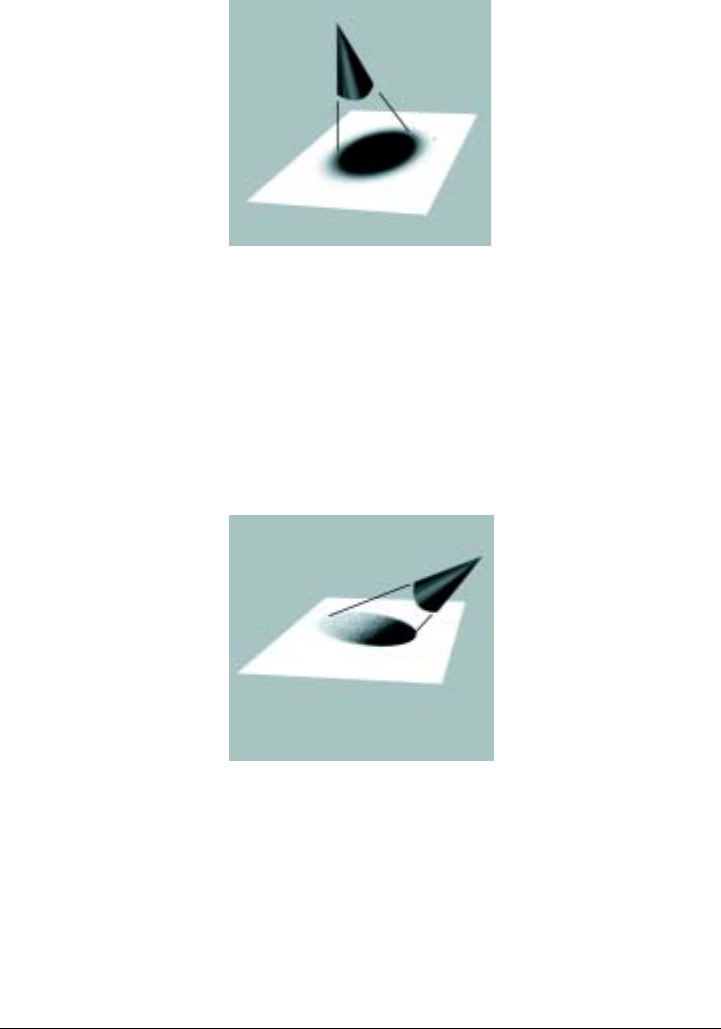
158 Corel Painter User Guide
Previous versions of airbrushes sprayed a thin layer of dots within an area that was always
circular, like a circle of light from a flashlight that is perpendicular to a piece of paper.
Now, airbrushes respond to angle (tilt), bearing (direction), and flow (fingerwheel
setting) data from a stylus, allowing for a truly realistic brush stroke. For example, as
you tilt your stylus, specks of media land on the paper in a way that reflects that tilt.
Imagine, again, the circle of light thrown by a flashlight. The moment the flashlight is
no longer perpendicular to the paper — rather, the shape of the cone of light changes,
creating a conic section. In the same manner, Corel Painter airbrushes create conic
sections that mirror your stylus movements.
Angle and tilt determine the shape and size of the conic section created
by Corel Painter airbrushes, which resembles a circle of light from a
flashlight that is no longer perpendicular to the paper.
Extreme-tilt angles affect large areas of the canvas. This can slow the brush down as it
tries to squirt paint too far from the stylus.
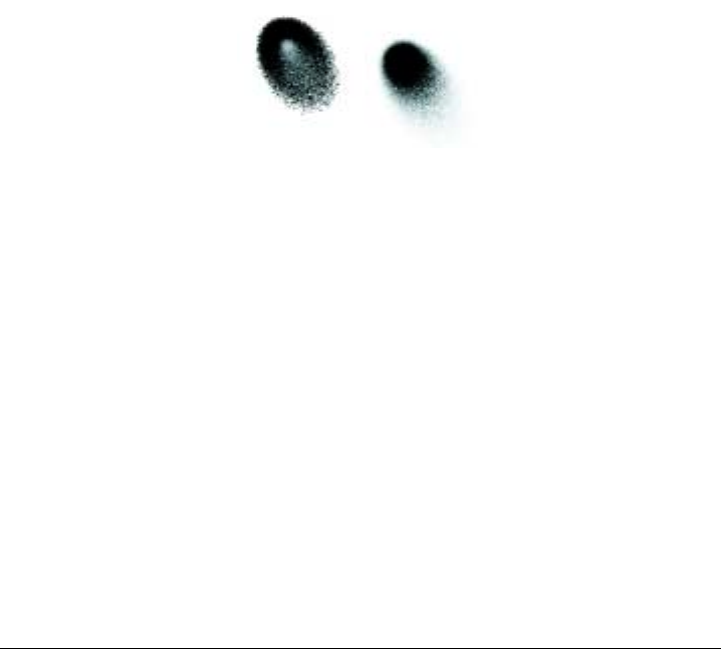
Painting 159
Adjusting Spread
You can adjust airbrush spread in the Brush Creator. Airbrush spread affects how paint
spreads out as it is applied. In other words, it sets the size of the cone of spread from
the tip of the airbrush or spray can.
A good range for the Spread setting is 30° to 40°. Narrow settings for Spread and
Angle can cause problems. Combined with a very tilted stylus, a narrow setting for
Spread can cause paint to be deposited away from the cursor.
Varying Edges
You can vary the edges of the paint sprayed from an airbrush to achieve desired
softness. You do this by selecting a brush tip or “profile” in the Brush Creator. Each
profile gives you a different edge to the paint you spray. For more information, refer to
“Brush Tip Profiles” on page 217.
Airbrush edges created with the Water Color profile (left) and the Medium profile (right).
Adjusting Flow
Although you can still adjust Opacity to apply fainter or darker dots of media, some
Corel Painter airbrushes, for example, the Fine Wheel Airbrush variant, take
advantage of stylus fingerwheel controls. Like the needle control on real airbrushes, the
wheel fingerwheel control adjusts airbrush flow — that is, how much media is applied.
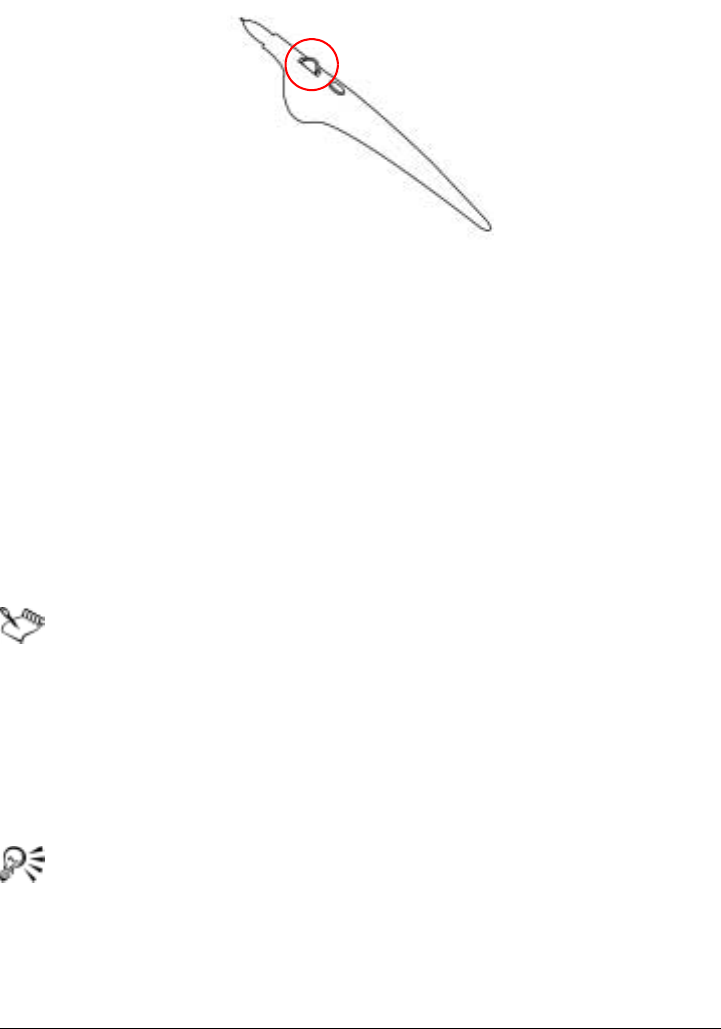
160 Corel Painter User Guide
Adjust airbrush flow with the fingerwheel control on many airbrush styluses.
Controlling Droplet Size
You can control the size of the airbrush droplets. This is not the same as adjusting the
size of the brush (the larger the brush, the more droplets are sprayed).
To change the size of airbrush droplets
1On the Stroke Designer page of the Brush Creator, click General.
2Choose Airbrush from the Dab Type pop-up menu.
3Choose Size from the left column.
4Move the Feature slider left for smaller droplets, or right for larger droplets.
Very large droplets may produce unexpected results.
The Feature setting is not available for variants using the Pixel Airbrush or
Line Airbrush dab types.
To increase or decrease media flow from an airbrush
• Move the stylus fingerwheel toward the tip, or forward, to decrease flow. Move it
away from the tip, or backward, to increase flow.
You can also control media flow from an airbrush on the Stroke Designer page
of the Brush Creator, by clicking Airbrush and adjusting the Flow and Min
Flow sliders. Flow sets the maximum flow. Min Flow sets the minimum
amount of flow as a percentage of Flow.
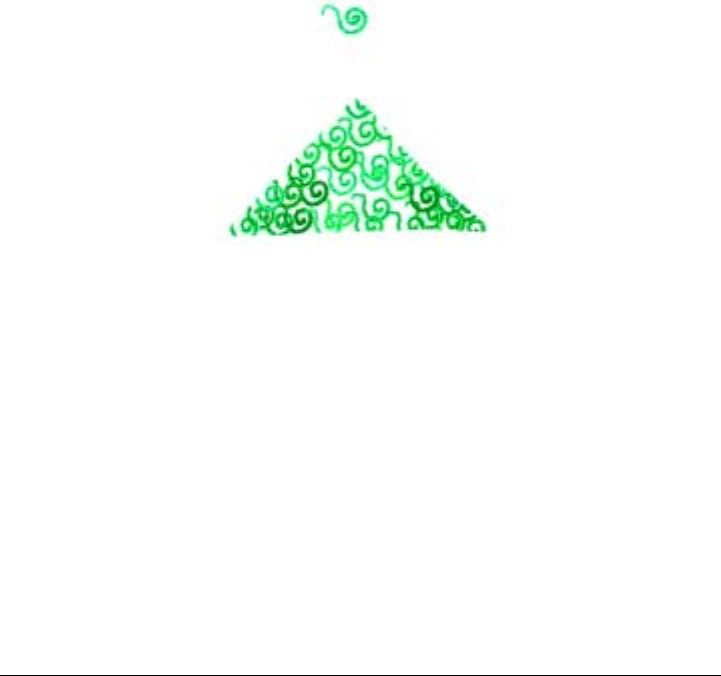
Painting 161
Depending on the Airbrush variant, you can reverse the effect of moving the
airbrush fingerwheel by enabling the Invert check box on the Color
Expression palette, or by enabling the Invert Flow Expression check box on
the Stroke Designer page of the Brush Creator.
In the Brush Creator, you can also determine flow based on stylus
information, such as velocity or pressure, by choosing an expression from the
Flow Expression pop-up menu.
Recording and Playing Back Strokes
Corel Painter will play back any stroke you record, wherever you click in the document
window. In this way, you can easily create a series of identical strokes — for example,
when you create hatching effects.
A brush stroke (top) is recorded and played back within a triangular selection.
Another way to use a recorded stroke is with Auto Playback, which lets you repeat the
recorded stroke at random positions on the page.
You can also save recorded strokes for later use. You can play back saved strokes, and
you can paint with the data from a saved stroke. This way of working can be
particularly useful if you work sometimes with a stylus and sometimes with a mouse:
you can record the brush strokes you make with a stylus, save them for later use, and
then use a mouse to obtain the data from that stroke, allowing stylus-quality results.
Corel Painter has a number of brush stroke scripts that can be played back on their
own or used in conjunction with an original brush stroke. When you use a brush stroke
script, your freehand brush strokes adhere to the stroke data in the script. This allows
you to emulate features of a tablet and stylus while using a mouse.

162 Corel Painter User Guide
To record a stroke
•On the Brush Selector bar, click the menu arrow, and choose Record Stroke.
The next brush stroke you make is saved in memory.
To play back a stroke
1On the Brush Selector bar, click the menu arrow, and choose Playback Stroke.
2Click where you want to repeat the stroke.
Corel Painter centers the stroke on the point on which you click. You can repeat the
stroke as many times as you want.
3On the Brush Selector bar, click the menu arrow, and choose Playback Stroke to
turn off playback.
To play back strokes randomly
•On the Brush Selector bar, click the menu arrow, and choose Auto Playback.
Corel Painter repeats the stroke at random positions until you click.
To save a stroke
1On the Brush Selector bar, click the menu arrow, and choose Save Stroke.
2In the Save Stroke dialog box, type a name.
Corel Painter adds the stroke to the list of saved strokes.
To select a saved stroke
•On the Brush Selector bar, click the menu arrow, choose Strokes, and choose a
saved stroke.
The selected stroke is used when you play back strokes or use stroke data.
To use stroke data
1On the Brush Selector bar, click the menu arrow, then choose Strokes, and choose
one of the following:
• Pressure Modulate varies the stylus pressure in a brush stroke.
• 360° Bearing Rotate rotates the stylus bearing by 360°.
• Size/Bearing Modulate varies the size of the brush tip and stylus bearing in a
brush stroke.

Painting 163
• Size/Tilt Modulate varies the size of the brush tip and tilt of the stylus in a brush
stroke.
• Fade In/Out fades the start point and endpoint of a brush stroke.
• Short Stroke decreases the length of a brush stroke.
• Bearing Rotate rotates stylus bearing in a brush stroke.
You can also base stroke data on brush strokes that you’ve already saved.
2On the Brush Selector bar, click the menu arrow, and choose Use Stroke Data.
3Draw brush strokes.
Working with Fill
Corel Painter gives you many options for filling images with media. You can use a
gradient, pattern, weave, or color to fill an area of an image. You can apply a fill to
only part of an image, to a layer of an image, to an alpha channel, or to an entire
image. You can also use the Paint Bucket tool to fill image areas based on pixel color.
Filling an Area with Media
You can fill an area of an image with a gradient, pattern, weave, or color.
What about filling with paper? The paper is a texture; it has no color by itself. You can
apply texture to an image, however, with various image effects. Many surface control
effects let you use paper as the control medium. For more information about surface
control effects, refer to “Working with Surface Texture” on page 291 and “Using Other
Surface Control Effects” in the Help.
To fill an area of an image
1Do one of the following:
• If you want to fill only part of an image, select the area of the image you want
to fill.
• If you want to fill a layer, select the layer on the Layers palette.
• If you want to fill an alpha channel, select the channel on the Channels palette.
• If you want to fill the entire image, make sure there are no selections.
2Choose Effects menu > Fill, or press Command + F (Mac OS) or Ctrl + F
(Windows).
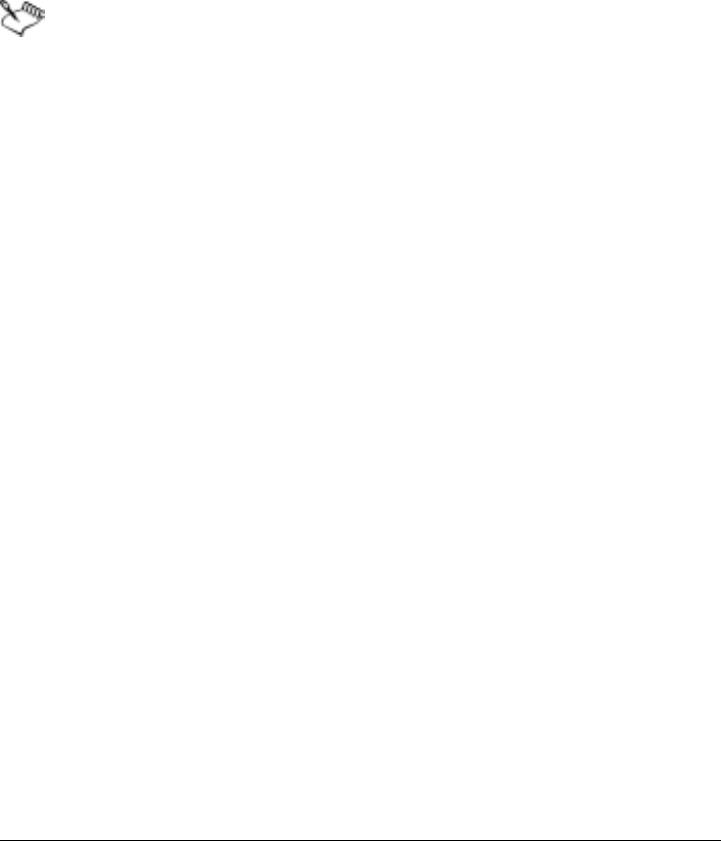
164 Corel Painter User Guide
3In the Fill dialog box, enable one of the following filling options:
•Current Color
• Pattern
•Gradient
•Weave
4Adjust the Opacity slider.
Corel Painter uses the current color, pattern, gradient, or weave. Before
filling, choose the media you want from the corresponding selector in the
toolbox.
Filling Images Based on Color
You can use the Paint Bucket tool to fill image areas based on pixel color. This method
can be used on the canvas or in a channel. Corel Painter fills areas based on color
boundaries and the current Tolerance and Feather settings.
Tolerance sets the amount of variance allowed from the color of the pixel you choose.
With a low Tolerance setting, the Paint Bucket fills only contiguous pixels that are
very close to your chosen pixel color. With a high Tolerance setting, the Paint Bucket
fills a greater range of colors.
Feathering softens the edges of the fill by controlling the fill opacity for pixels with
colors outside the Tolerance range. With Feather set to zero (the default), only pixels in
the Tolerance range are filled. With a low Feather setting, pixels with colors just
outside the Tolerance range receive partial fill. Increasing the Feather setting increases
the range of colors that receive partial fill. Pixels with colors farther from the Tolerance
range receive a more transparent fill. Typically, when Feather is set high, Tolerance is
set low.
The Lock Out Color feature protects areas of a given color from accidental filling. You
can choose a color that will not accept filling when clicked with the Paint Bucket.
Black is the default locked-out color.
You can use the Paint Bucket tool to fill the interior of areas bounded by lines. This is
especially good for producing solid fills of regions bounded by anti-aliased lines. If you
want to fill regions completely, without affecting the lines, you can first copy the lines
to a selection. Then, when you fill the cells, the lines are protected.
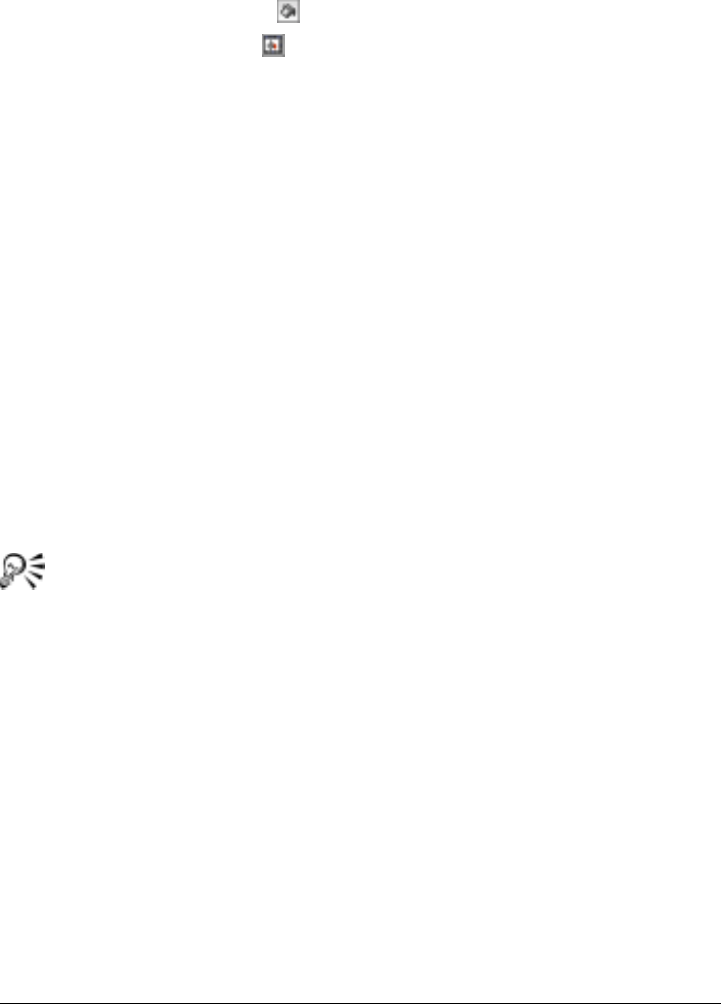
Painting 165
To fill an image based on color
1Choose the Paint Bucket tool from the toolbox.
2Click the Fill Image button on the property bar.
3Choose one of the following options from the Fill pop-up menu:
• Current Color, which fills with the selected color.
• Gradient, which fills with the selected gradient.
• Clone Source, which fills with the current clone source image. If you haven’t
defined a clone source, Corel Painter fills with the current pattern.
• Weaves, which fills with the selected weave.
4Choose the specific material you want from the Select Fill pop-up menu.
5Type a value in the Tolerance box, or adjust the pop-up slider, to specify the range
of colors to be filled.
6Type a value in the Feather box, or adjust the pop-up slider, to specify the fill
opacity for pixels outside the Tolerance range.
If you want to create intermediate fill values on the boundaries, enable the
Anti-Alias check box. This gives soft edges to the fill. Anti-aliasing is desirable
when the Feather setting is zero or extremely low. Click the area of the image you
want to fill.
If the result is not what you want, undo the fill, change the settings, and try again.
You can constrain the fill to a rectangular area by dragging with the
Paint Bucket tool.
To choose a lock-out color
1On the Colors palette, choose the color you want to protect.
2Double-click the Paint Bucket tool in the toolbox.
3In the Lock Out Color dialog box, click Set.
The color swatch updates to the new color, and the Lock Out Color check box is
enabled.
To copy lines to a selection
1Choose Select menu > Auto Select.
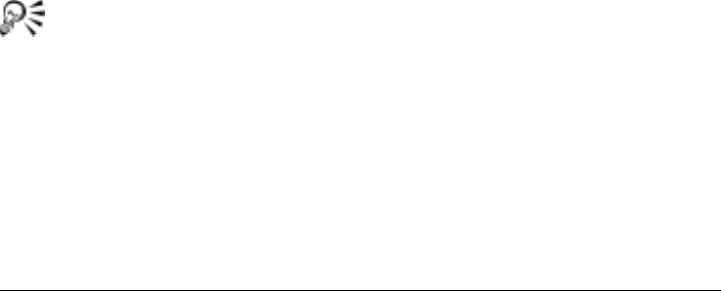
166 Corel Painter User Guide
2In the Auto Select dialog box, choose Image Luminance from the Using pop-up
menu.
3Click OK.
Corel Painter creates a selection that will protect the dark lines.
When you protect anti-aliased or non-black lines in this way, the lines in the
selection have varying levels of transparency, depending on the pixel luminance.
The mask threshold lets you compensate for the semitransparency of the selection,
allowing you produce just the fill you want.
Limiting and Preventing Leakage
In complex drawings, lines don’t always meet. This can create fill leaks into areas you
don’t want to be filled — sometimes through the whole image. You can’t always tell if
there’s a leak just by looking at your image. If you click a small area and see the
prompt, “Now Looking for Extent of Fill,” there’s probably a leak, and Corel Painter is
preparing to fill a bigger area than you had in mind. In this case, you can abort the fill.
You can limit leakage to a specific rectangular area. In typical cartoon line work,
unbounded areas — for example, hair, tail feathers, and brush bristles — sometimes
must be filled. By limiting leakage to a specific area, you can close off these items. You
can also close leaks by copying the lines to a selection (refer to “To copy lines to a
selection” on page 165), saving the selection to a channel, editing the channel, and
then reloading it to the selection. For more information about editing channels, refer
to “Managing and Editing Channels” in the Help.
To abort a fill
•Press Command + . (period) (Mac OS), or Ctrl + . (period) (Windows).
If you don’t catch the fill in time, choose Edit menu > Undo Paint Bucket
Fill, or press Command + Z (Mac OS), or Ctrl + Z (Windows), to undo a fill
that has leaked outside of the boundaries.
To limit leakage
1Choose the Paint Bucket tool from the toolbox.
2On the property bar, click the Fill Cell button or the Fill Image button.
3Drag to create a rectangle that just covers the area you want to fill.
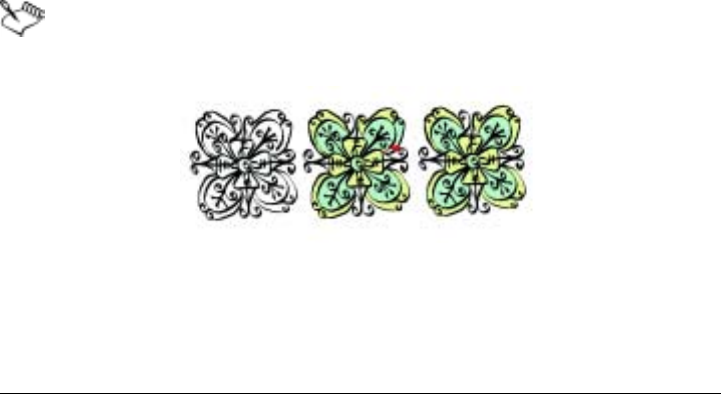
Painting 167
If there is no leak, only the area within the lines is filled. If there is a leak, the fill
goes outside the area, but not beyond the constraints of your rectangle.
To close a leak
1Copy the lines to a selection.
See “To copy lines to a selection” on page 165.
2Choose Select menu > Save Selection.
3In the Save Selection dialog box, choose New from the Save To pop-up menu.
4Click OK.
A new channel is displayed on the Channels palette.
5On the Channels palette, display and select the channel.
6On the Brush Selector bar, choose the same brush you used to create the lines.
7On the Colors palette, set Black as the current main color.
8Paint in the channel to close the gaps.
9Choose Select menu > Load Selection.
10 In the Load Selection dialog box, choose the modified channel from the Load From
pop-up menu.
11 Enable the Replace Selection option to replace the original with the edited version.
If you want to adjust the mask threshold, double-click the Paint Bucket tool in the
toolbox, and move the slider.
The channel does not have to be selected to contain the fill. If you deselect the
channel on the Channels palette, the loaded selection is still in effect.
Edit the channel to close leaks. Remember to load the channel back into the selection after editing.

Watercolor 169
Watercolor
Corel Painter features two ways to work with watercolors: the Watercolor layer and
Digital Watercolor.
Getting Started with Watercolor
Watercolor brushes paint into a watercolor layer, which enables the colors to flow and
mix and absorb into the paper. In Corel Painter, you can edit the Watercolor layer as
you would any other layer — even erase and blur — without changing anything in the
image layer. For example, you can draw pencil outlines in the image layer and then
overlay watercolor shading without smudging the pencil lines.
You can sketch on one layer and paint with watercolors on a separate watercolor layer.

170 Corel Painter User Guide
Working with the Watercolor Layer
You can transfer, or lift, information from the canvas to the Watercolor layer. This is
useful if you want to apply Watercolor effects to a photograph, for example. You can
also wet the entire Watercolor layer, which activates a diffusion process that you can
control. Unless a Watercolor layer is already selected, a new Watercolor layer is
automatically created when a Watercolor brush is applied to an image.
The Watercolor layer is represented on the Layers palette by a blue water droplet icon.
When the icon is falling, it indicates that the drying process is underway. It is a good
practice to monitor the Watercolor icon while painting with Watercolor brushes. If too
many strokes are made within a short period, particularly with slow-drying brushes,
the application can become slower. In this situation, it is best to wait for the drying
process to finish before continuing.
To create a new Watercolor layer
1Choose Window menu > Show Layers to display the Layers palette.
If the Layers palette is not expanded, click the palette arrow.
2Do one of the following:
• On the Layers palette, click the palette menu arrow, and choose
New Watercolor Layer.
• Click the New Watercolor Layer button at the bottom of the Layers palette.
To lift the canvas to the Watercolor layer
1Apply one or more strokes to the canvas with a Watercolor brush variant.
2Choose Window menu > Show Layers to display the Layers palette.
3Click the palette menu arrow, and choose Lift Canvas to Watercolor Layer.
To wet the Watercolor layer
1Apply one or more strokes to the canvas with a Watercolor brush variant.
2Choose Window menu > Show Layers to display the Layers palette.
3Click the palette menu arrow, and choose Wet Entire Watercolor Layer.
To stop the diffusion process, click the palette menu arrow on the Layers
palette, and choose Dry Watercolor Layer.
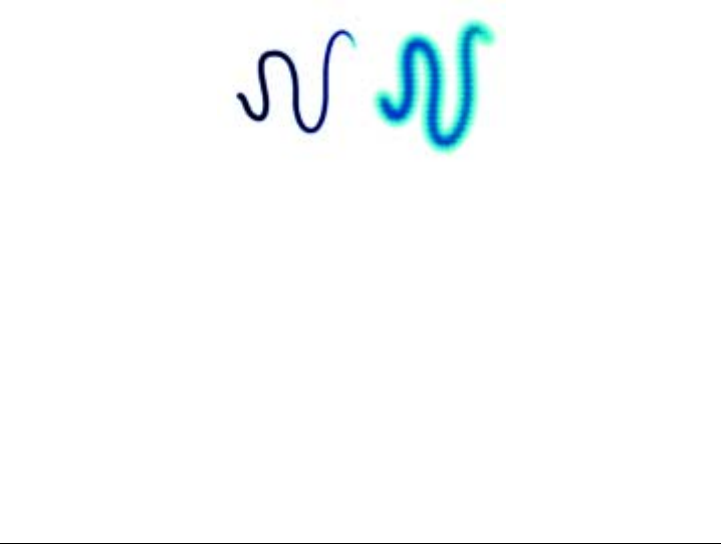
Watercolor 171
Working with Watercolor Brush Variants
The Watercolor brush variants produce natural-looking watercolor effects. All
Watercolor brush variants, except Wet Eraser, interact with the canvas texture.
Stylus pressure affects the width of the brush stroke for all Watercolor brush variants
except Wet Eraser. Increased pressure widens a brush stroke; less pressure narrows a
stroke.
Watercolor Dab Types
Refer to “Dab Types” on page 205 for more information about Watercolor Dab Types.
Water Controls
You can adjust the Water controls when you have selected a Watercolor brush from the
Brush Selector bar. Located on the Stroke Designer page of the Brush Creator, or the
Brush Controls palette, the Water controls allow you to specify various settings for
your Watercolor brushes. For example, you can adjust brush size, control diffusion, and
determine how the paper texture will interact with the brush strokes. Refer to “Water
Controls” on page 245 for more information.
A watercolor stroke before (left) and after (right) diffusion.
Applying a Paper Texture
The Watercolor brushes interact with paper grain — the colors flow, mix, and are
absorbed into the paper. The luminance information of the current paper grain is used
to determine how the paint diffuses into the paper and how it dries.
You can experiment with adjusting the sliders on the Papers palette and seeing their
effect on the Watercolor brushes. The Scale slider controls the size of the grain. The
Contrast slider, as it applies to the Watercolor layer, controls the height of the grain
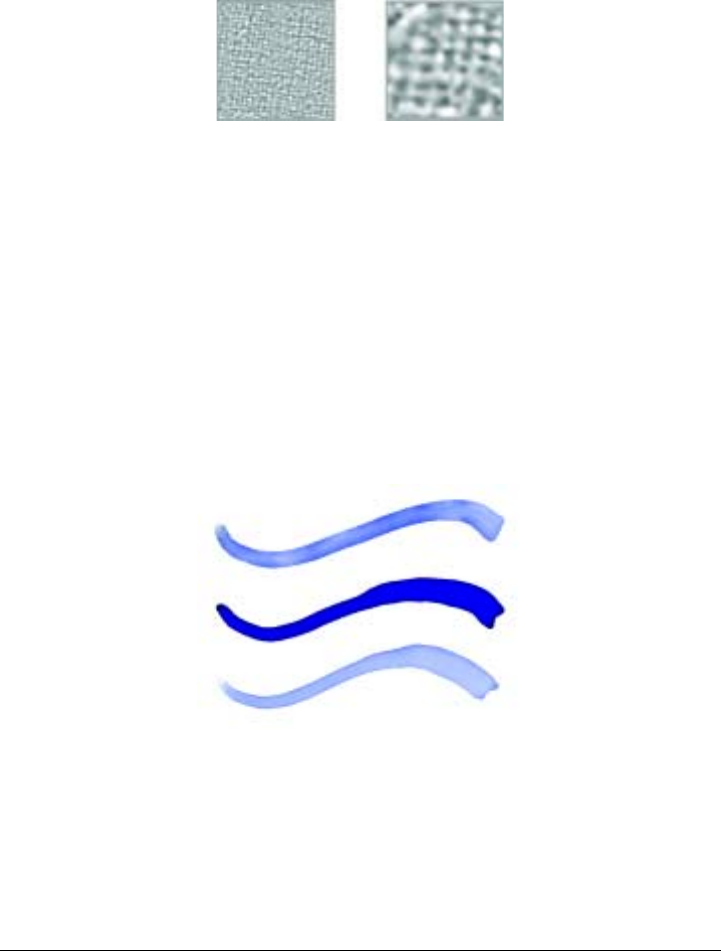
172 Corel Painter User Guide
surface. Adjusting the Contrast slider to the right increases the height of the grain and
adds more texture as a result. Refer to “Using Paper Texture” on page 113 for more
information.
The Scale slider controls the size of the paper grain. Left=50%, right=200%.
Working with Digital Watercolor
The Digital Watercolor brushes paint directly on both the Canvas layer or a default
layer so you can create effects similar to those of Watercolor brushes without using a
separate layer. The watercolor behavior of Corel Painter 6 has been integrated with
Digital Watercolor, which allows for the dynamic adjustment of the wet fringe.
Corel Painter IX and Corel Painter 8 handle digital watercolor differently.
Corel Painter 8 can open any Corel Painter IX file containing digital watercolor, but
the file’s contents might look different. To ensure that the image looks the same in
Corel Painter 8, you should first dry the digital watercolor in Corel Painter IX.
You can use Digital Watercolor brushes to create effects similar to those produced
with Watercolor brushes, without having to create a separate layer. Settings
such as Diffusion, Opacity, and Wet Fringe control the appearance of the stroke.
Digital Watercolor Diffusion
Digital Watercolor brushes also use diffusion to create soft, feathery edges on the brush
strokes. You can adjust the amount of diffusion using the controls on the property bar.
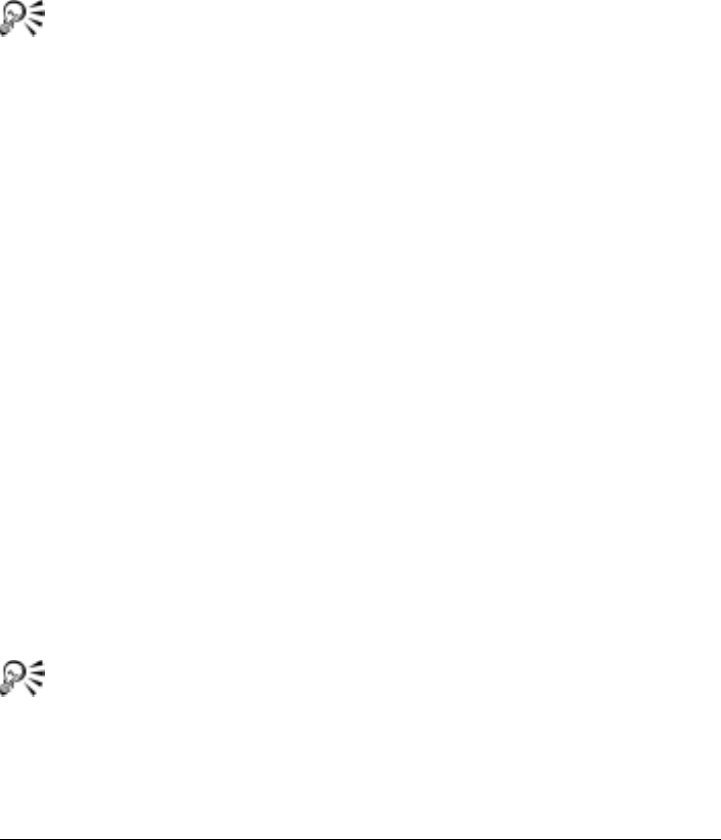
Watercolor 173
To adjust diffusion
1Apply one or more strokes with a Digital Watercolor variant.
If you would like to restrict the diffusion to a region, make a selection with any
selection tool. The diffusion effect will apply only within the selection.
2On the property bar, adjust the Diffusion pop-up slider.
Drag the slider to the right to increase diffusion, to the left to decrease diffusion.
You can also adjust diffusion before applying brush strokes by adjusting the
Diffusion slider.
The Diffusion slider is also accessible on the Brush Controls palette and in the
Digital Watercolor area of the Stroke Designer page of the Brush Creator.
Wet Fringe
The Wet Fringe slider controls the amount of pooling of water and paint at the edges
of Digital Watercolor brush strokes. You can dynamically adjust the wet fringe on any
Digital Watercolor brush stroke before you dry it. Dynamically adjusting the Wet
Fringe affects every wet Digital Watercolor brush stroke, which remains wet until you
dry it. Once you’re satisfied with the wet fringe, it’s a good idea to dry Digital
Watercolor brush strokes. This allows you to dynamically adjust the Wet Fringe on
future Digital Watercolor brush strokes without affecting existing brush strokes that
you’re satisfied with.
To adjust wet fringe
1Apply one or more strokes with a Digital Watercolor variant.
If you would like to restrict the diffusion to a region, make a selection with any
selection tool. The pooling effect will apply only within the selection.
2On the property bar, adjust the Wet Fringe slider.
Drag the slider to the right to increase pooling, to the left to decrease pooling.
You can also adjust wet fringe before applying brush strokes by adjusting the
Wet Fringe slider.
The Wet Fringe slider is also accessible on the Brush Controls palette and in
the Digital Watercolor area of the Stroke Designer page of the Brush Creator.

174 Corel Painter User Guide
To dry Digital Watercolor brush strokes
•Choose Layer menu > Dry Digital Watercolor.
Once you dry a Digital Watercolor brush stroke, you can no longer adjust its
wet fringe.

Liquid Ink 175
Liquid Ink
Liquid Ink brushes in Corel Painter create liquid paint effects that simulate traditional
ink-based media.
Working with the Liquid Ink Layer
Liquid Ink layers are displayed on the Layers palette. They are identified by an ink
droplet icon.
Creating a New Liquid Ink Layer
Unless you have a Liquid Ink layer already selected, a new Liquid Ink layer is
automatically created when a Liquid Ink brush is applied to an image.
To create a new Liquid Ink layer
1Choose Window menu > Show Layers to display the Layers palette.
If the Layers palette is not expanded, click the palette arrow.
2Do one of the following:
• On the Layers palette, click the palette menu arrow, and choose New Liquid Ink
Layer.
• Click the New Liquid Ink Layer button at the bottom of the Layers palette.
Adjusting Attributes of the Liquid Ink Layer
You can experiment with the settings in the Liquid Ink Layer Attributes dialog box,
which let you control the appearance of depth and adjust the threshold of the edges of
the ink.

176 Corel Painter User Guide
To adjust Liquid Ink layer attributes
1On the Layers palette, double-click the Liquid Ink layer you want to modify.
2In the Liquid Ink Layer Attributes dialog box, do one or more of the following:
• Type a name for the layer in the Name box.
• Adjust the position of the layer in the Top and Left boxes.
• Type layer information in the Notes box.
• Adjust the Threshold slider to increase or decrease the width of the brush
stroke.
• Adjust the Amount slider to increase or decrease the height, or
three-dimensional appearance, of the brush stroke.
Using Liquid Ink Controls
You can adjust the Liquid Ink controls when you have selected a Liquid Ink brush from
the Brush Selector bar. The controls on the Stroke Designer page of the Brush Creator
allow you to specify various settings for your Liquid Ink brushes. For example, you can
select Liquid Ink brush type, size, smoothness, and stroke volume. Refer to “Liquid Ink
Controls” on page 250 for more information.
Size
The Feature slider in the Size area of the Stroke Designer page lets you determine the
space between bristles. You can experiment with the Feature slider and its effect on
different Liquid Ink brushes; the higher the setting, the farther apart the bristles
appear. Lower settings produce more solid strokes. With Liquid Ink brushes, the
adhesion of the bristles minimizes the appearance of individual bristles.
The Feature slider and its effect on Liquid Ink brush strokes.

Liquid Ink 177
Expression
You can use the Expression settings in the Liquid Ink area of the Stroke Designer page
to vary Liquid Ink effects. For example, you can vary the stroke volume by adjusting
controllers such as Direction or Velocity. You can also use the Pressure controller to
create layered Liquid Ink strokes. Refer to “Expression Settings” on page 262 for more
information.
Light pressure is used to apply overlapping strokes (left).
Increased pressure produces a heavier layering effect (right).
Lighting Effects
You can use the Surface Lighting controls to add light sources and change lighting
angles to give the appearance of height to a Liquid Ink brush stroke. Refer to “Using
Lighting” in the Help for more information about applying lighting effects.
By adjusting lighting angles and adding multiple light sources,
you can add height to Liquid Ink brush strokes.
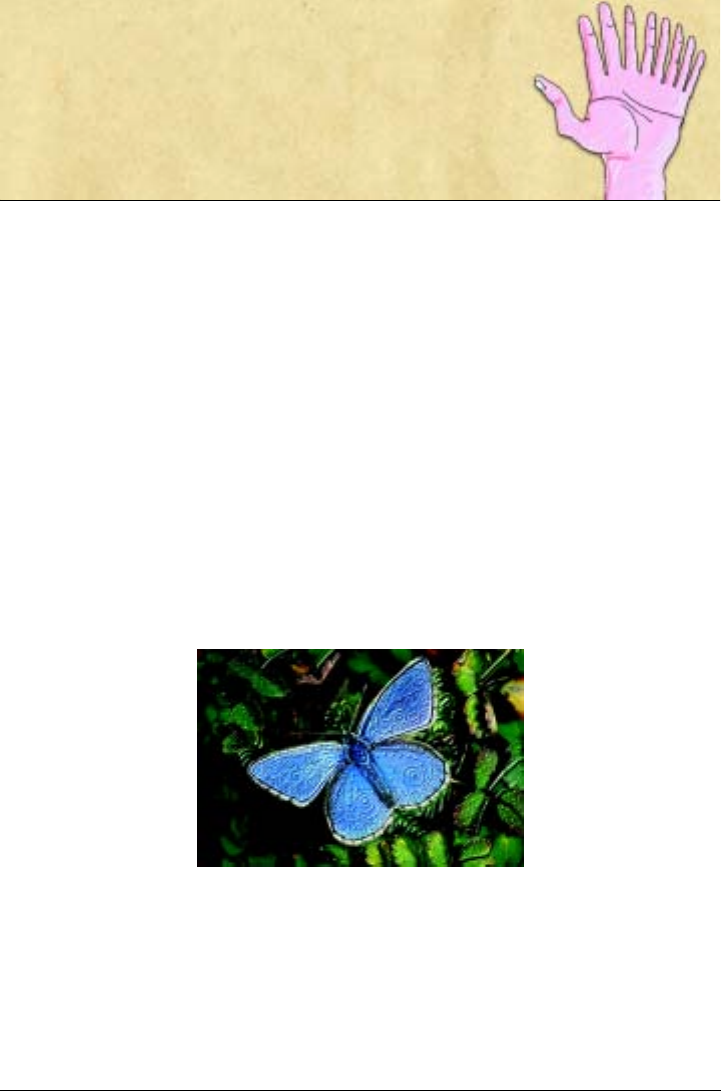
Impasto 179
Impasto
Impasto is the classic technique of applying thick paint on a canvas to create depth. In
Corel Painter, impasto refers to the brush feature that allows brushes to paint with the
illusion of depth. You can use different brushes to simulate different types of natural
media, such as thick oil paint or chalk with texture.
Getting Started with Impasto
To create an impasto effect, you must first activate the Impasto layer. Next, you choose
the Impasto brush category and a brush variant. Impasto brush strokes appear
textured and three-dimensional. You can alter the appearance of impasto brush strokes
by using depth and lighting controls.
In Corel Painter, you can transform most brush variants into custom impasto brushes
by using the Brush Creator or the Brush Controls palettes.
With Impasto, you can create wonderfully textured paintings.
Working with the Impasto Layer
When you use an Impasto brush, you paint on a virtual Impasto layer that
accumulates depth information as you paint. The Impasto layer is not part of the layer
hierarchy and does not appear on the Layers palette.
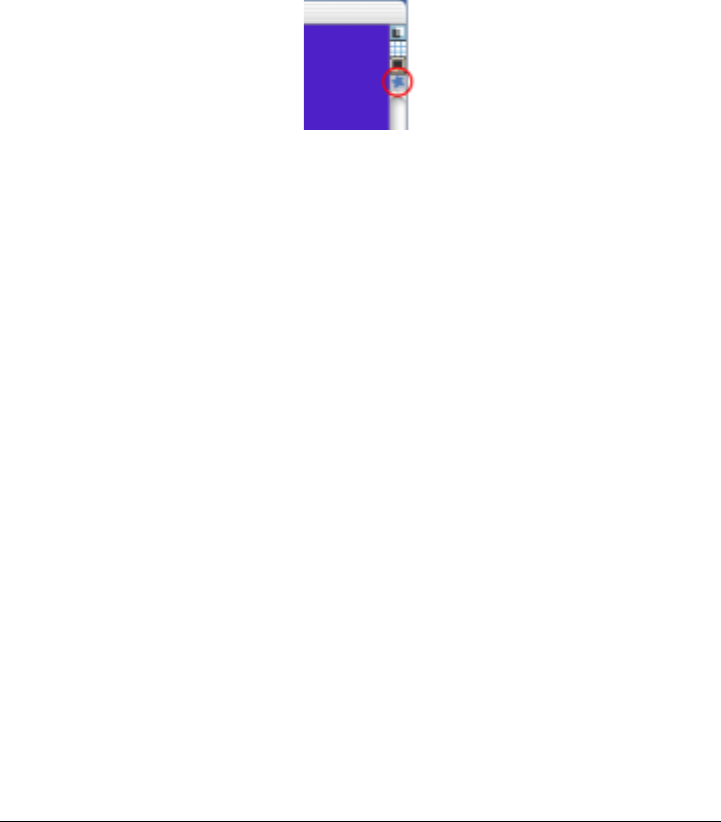
180 Corel Painter User Guide
The Canvas layer holds the depth information for the entire image, including any
additional layers. When the Impasto layer is active, it also shows how the Impasto
Lighting affects your strokes.
To activate or deactivate the Impasto layer
•To activate the Impasto layer, click the Impasto icon on the document window.
•To deactivate the Impasto layer, click the icon again.
The Impasto icon on the document window.
To clear the Impasto layer
•Choose Canvas menu > Clear Impasto.
Creating an Impasto Effect
You can apply a variety of Impasto brush strokes by using an Impasto brush variant.
These brushes simulate different types of depth effects achieved with natural media,
such as thick oil paint. You control the Impasto effect by changing the paint thickness,
or depth. Refer to “Impasto Controls” on page 241 for more information.
You can control the appearance of depth using the Amount, Picture, Shine, and
Reflection settings in the Surface Lighting dialog box. At any time, you can change
these settings to produce different texture effects:
• The Amount setting affects the thickness of the entire Impasto layer. It does not
affect individual brush strokes, nor does it affect other Impasto strokes.
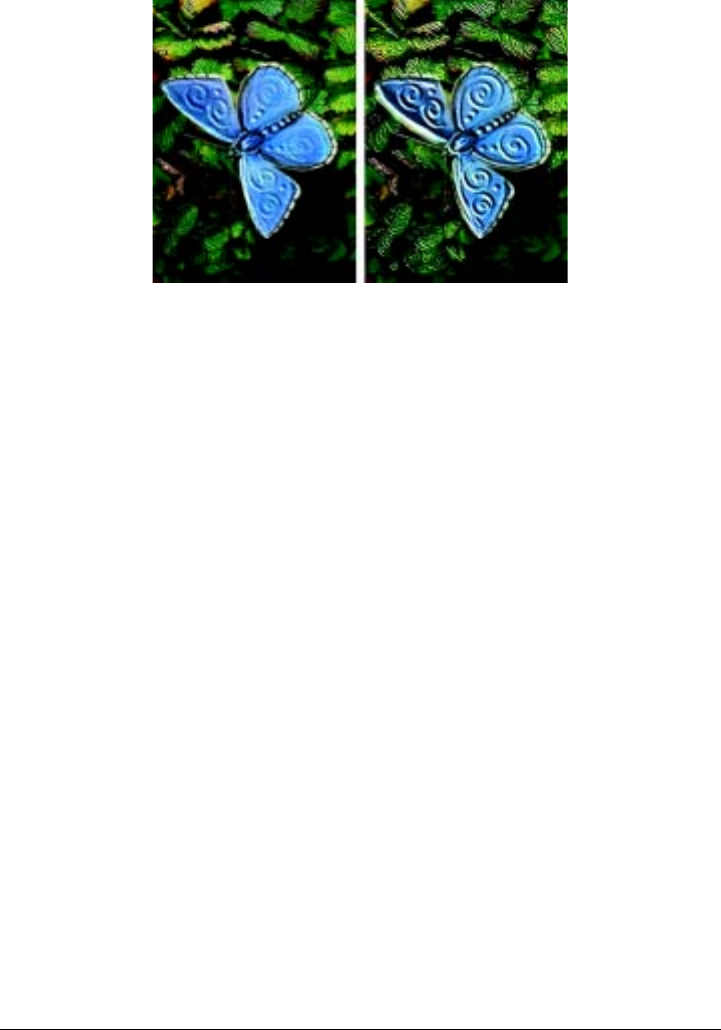
Impasto 181
You can control the appearance of depth in the entire
Impasto layer by adjusting the Amount slider.
• The Picture setting controls how much color appears in the image. At its lowest
value, all color is washed out, leaving only the highlights.
• The Shine setting controls how much highlight appears on the surface of strokes.
Higher Shine values make the stroke look metallic.
• The Reflection setting maps a clone source image or pattern onto the texture at a
variable percentage. Refer to “Working with Reflection Maps” on page 301 for
more information.
Adjustments affect the entire Impasto layer. To change the depth of individual brush
strokes, you can vary stylus settings or build up media. Refer to “Controlling the
Depth Interaction of a Medium” on page 183 for more information.
You can also set how light sources shine on the Impasto brush strokes, add or delete
lights, and change light color and position. Refer to “Adjusting Surface Lighting” on
page 187 for more information.
If you want to create your own custom brush variants, use the Brush Creator to adjust
brush properties. Refer to “Creating Custom Impasto Brushes” on page 182 for more
information.
To create an Impasto effect
1Click the Impasto icon on the upper-right corner of the document window.
2Choose Impasto from the Brush Selector bar.
3Choose a brush variant from the Brush Variant selector.
4Choose Canvas menu > Surface Lighting.

182 Corel Painter User Guide
5In the Surface Lighting dialog box, use the sliders to set attributes for
Appearance of Depth and Light Controls.
6Paint on the canvas or layer.
Creating Custom Impasto Brushes
Using the Impasto brush settings in the Brush Creator, most brush variants can
become Impasto brushes. The controls let you set drawing and depth methods, the
amount of depth applied, and the brush interaction. The Impasto settings act
identically to other brush settings, in that they can be saved as part of a brush variant
or applied to any active brush. For more information on creating new brush variants,
see “Customizing Brushes” on page 197.
Setting Drawing Method
All of the drawing methods affect the next strokes you make in the document.
Impasto has three drawing methods:
• The Draw to Color method applies color. You can set the color on the Colors
palette.
• The Draw to Depth method applies depth to the image.
• The Draw to Depth and Color method applies both color and depth to the image.
Setting Depth Method
The Depth Method pop-up menu lets you choose a control medium for applying
depth. Corel Painter uses the luminance (brightness) information in the control
medium to determine how much depth is applied within a stroke. Light areas of the
medium receive more depth; dark areas receive less. Black areas appear flat.
For example, when you use Paper as the Depth Method, the bright and dark areas of
the paper grain determine where grooves and bumps appear in the stroke.
This Impasto stroke is produced when Paper is used as the Depth Method.

Impasto 183
You can choose from five depth methods:
• The Uniform method applies depth evenly. Strokes have little texture.
• The Erase method levels the depth layer. If you’ve created texture strokes that you
don’t like, you can use this setting to remove them.
Erase applies only to depth, not to color. With the Depth and Color drawing
method, the Erase method removes depth while applying color.
The amount of depth removed depends on the value of the Depth slider. If you
want to remove the entire Impasto stroke, set Depth to 0.
• The Paper method uses the current paper method to control depth. You can choose
different papers and change their scale by using the Paper Selector in the toolbox.
Refer to “Inverting and Scaling Paper Textures” on page 119 for more information.
• Original Luminance uses a clone source’s luminance to control depth. Refer to
“Using Clone Source Luminance to Create Texture” on page 298 for more
information.
• Weaving Luminance controls depth using the current Weave. You can choose
different weaves by using the Weaves Selector in the toolbox.
Inverting a Depth Method
You can invert the depth method by using the Invert option. When a method is
inverted, the negative of the source is used in the stroke. For example, using the Invert
option with Weave luminance switches the luminance values of the current weave so
that light areas of the weave become dark and vice versa. This change results in an
inverted texture within the Impasto brush strokes.
Controlling the Depth Interaction of a Medium
When you use a depth method, you paint with a new medium that has texture and
builds up depth as you layer brush strokes.
The Impasto sliders in the Brush Creator let you set how much depth is applied with a
stroke, the amount of texture applied within a stroke, and how each stroke interacts
with other Impasto brush strokes.
• The Depth slider controls the depth of individual strokes. Higher values produce
strokes that have deeper grooves.
• The Smoothing slider controls the transition of the texture applied to a stroke.
• The Plow slider controls how much a stroke interacts with other Impasto brush
strokes.
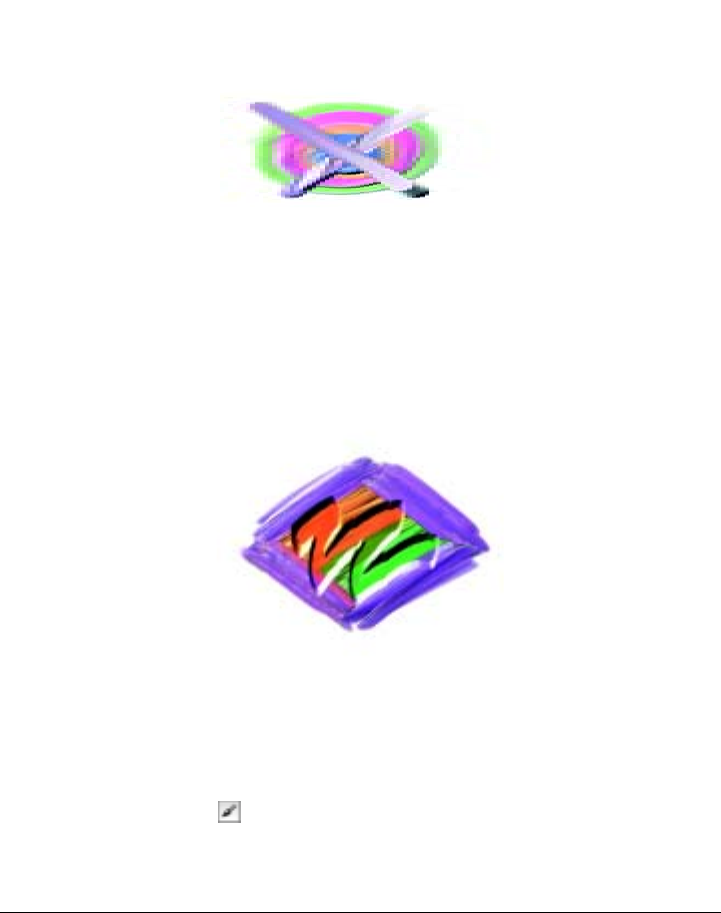
184 Corel Painter User Guide
When a stroke with a high Plow value encounters another Impasto stroke, it
displaces the depth of the existing stroke. In essence, your brush stroke “plows”
through existing strokes.
By adjusting the Plow slider, you can produce incredibly realistic effects.
The effects of high (left) and low (right) Plow settings.
• The Negative Depth option changes the direction of depth. When Negative Depth
is enabled, the brush digs valleys instead of raising ridges.
Normally, Impasto raises ridges and bumps. The Negative
Depth option forces Impasto to excavate instead.
To create an Impasto brush variant
1Choose the Brush tool from the toolbox.
2On the Stroke Designer page of the Brush Creator, click Impasto.
3Choose a drawing method from the Draw To pop-up menu.

Impasto 185
4Choose an application method from the Depth Method pop-up menu.
5Adjust the Depth slider to set how much depth the brush applies.
6Adjust the Smoothing slider to set the transitions in the texture.
Higher Smoothing values produce less textured strokes.
7Adjust the Plow slider to control how much a depth stroke displaces other strokes
that it intersects.
Varying Input to Control Depth
In addition to the Impasto controls, you can also use the Depth slider in the
Brush Creator to add more complexity to your strokes. The Depth slider can alter the
flow of depth as you paint. Using one of the nine input controllers, you can control the
flow of depth based on pressure, velocity, or bearing. Refer to “Impasto Controls” on
page 241 for complete descriptions of controllers.
To use the Depth brush feature
1On the Stroke Designer page of the Brush Creator, click Impasto.
2Choose Depth from the Draw To pop-up menu.
3Choose a depth method from the Depth Method pop-up menu.
4Adjust the Depth slider, and choose an expression from the Expression pop-up
menu.
For a realistic effect, try varying Depth inversely with Pressure. Set the
Expression pop-up menu to Pressure, and enable the Invert option. This lets
you apply paint more thickly when you press lightly, but more thinly when
you press firmly, just as if you were using real paint.
Blending Impasto with Other Layers
You can control how Corel Painter blends Impasto brush strokes with images on other
layers by selecting a composite depth method on the Layers palette.
The Composite Depth menu provides the following methods for combining Impasto
brush strokes:
• The Add method combines depth information between layers. Brush strokes on
different layers build up where they overlap.
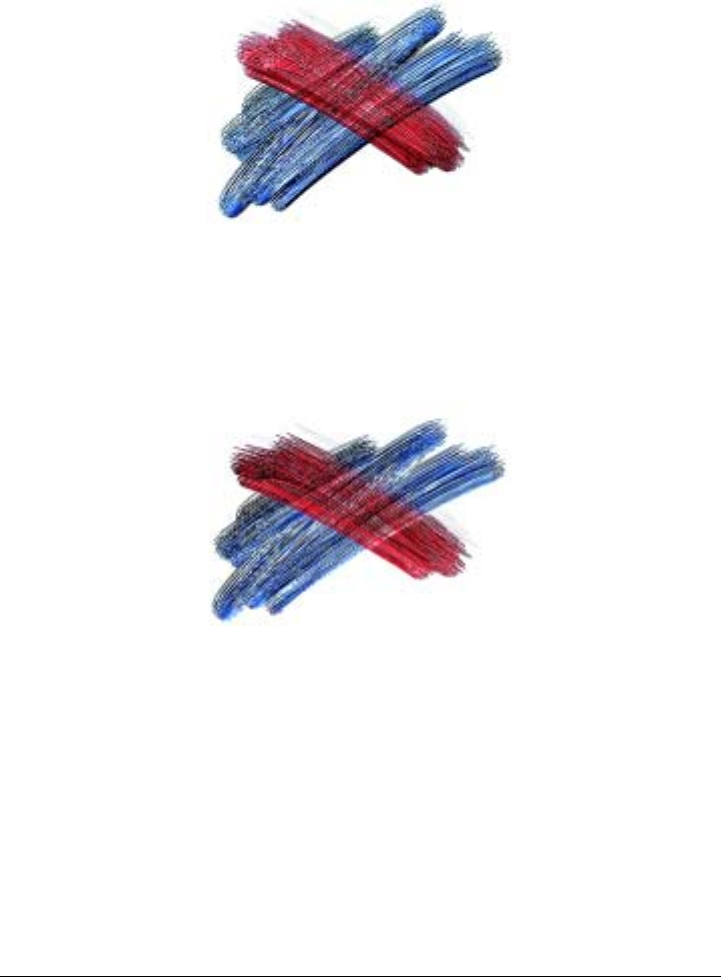
186 Corel Painter User Guide
If the composite depth method is set to Add and you paint with an Impasto brush
variant on a layer, the composite depth setting does not change.
An example of the Add composite depth method.
• The Subtract method removes depth information between layers. Impasto brush
strokes on top layers create grooves in the image data beneath them.
If the composite depth method is set to Subtract and you paint with an Impasto
brush variant on a layer, the composite depth method does not change.
An example of the Subtract composite depth method.
• The Replace method uses layer masks to replace the depth information from lower
layers with information from top layers. Wherever strokes overlap, only the top
strokes are visible; the lower strokes are completely covered.
If the composite depth method is set to Replace and you paint with an Impasto
brush variant on a layer, the composite depth method does not change.

Impasto 187
An example of the Replace composite depth method.
• The Ignore method prevents impasto brush strokes from interacting with image
data on different layers. With the Ignore method active, the display of depth for
the layer is turned off, even when the View Depth icon on the document window is
active. This makes it possible to disable display of depth for individual layers.
If the composite depth method is set to Ignore and you paint with an Impasto
brush variant on a layer, the method changes back to Add.
Ignore is the default composite depth method.
You can set a different composite depth method for every layer in a document. Refer to
“Blending Layers by Using Composite Methods” on page 71 for more information.
Adjusting Surface Lighting
Lighting can be a big part of the overall depth effect that Impasto creates. Just as the
right lighting can bring out the deep-textured look of a stroke, the wrong lighting can
wash out the effect altogether. The Surface Lighting controls let you set up the
position and attributes of light sources that shine on your Impasto brush strokes.
These controls are global — they affect all the Impasto brush strokes on all layers.
Setting Light Position
The lighting sphere shows all of the possible surface angles and how the lights
illuminate them. The light indicators on the sphere show the current positions of all of
the light sources.

188 Corel Painter User Guide
The lighting sphere with a light indicator.
The Display slider beneath the sphere controls the brightness of the sphere, so that it’s
easier to see light positions. It does not affect the lights themselves. The Show Light
Icons check box lets you show or hide the light indicators on the sphere.
To change a light’s angle
1Choose Canvas menu > Surface Lighting.
2In the Surface Lighting dialog box, drag a light indicator on the sphere.
Adding and Deleting Lights
You can add as many light sources as your system’s memory allows. Remember, each
light interacts with all the Impasto brush strokes, so be careful not to set up colored
lights that clash with the colors in your composition or light sources that create
unwanted shadows.
To add a light
1Choose Canvas menu > Surface Lighting.
2In the Surface Lighting dialog box, click on the lighting sphere.
A new light indicator (small circle) appears where you click.
To delete a light
•In the Surface Lighting dialog box, click on a light indicator and press Delete.

Impasto 189
Setting Light Properties
The three Light Controls sliders let you set the intensity and brightness of a light
source.
• The Brightness slider indicates how much light the light source contributes to the
overall lighting color.
• The Conc (concentration) slider adjusts the spread of the light over the surface.
• The Exposure slider globally adjusts the overall lighting amount from darkest to
brightest.
You can also change a light’s color using the Light Color control. You can have
multiple colored lights interact with the depth to produce different textural effects.
The image above uses two different colored light sources.
To change light color
1In the Surface Lighting dialog box, click a light indicator.
2Click the Light Color icon.
3Choose a color from the Color dialog box.
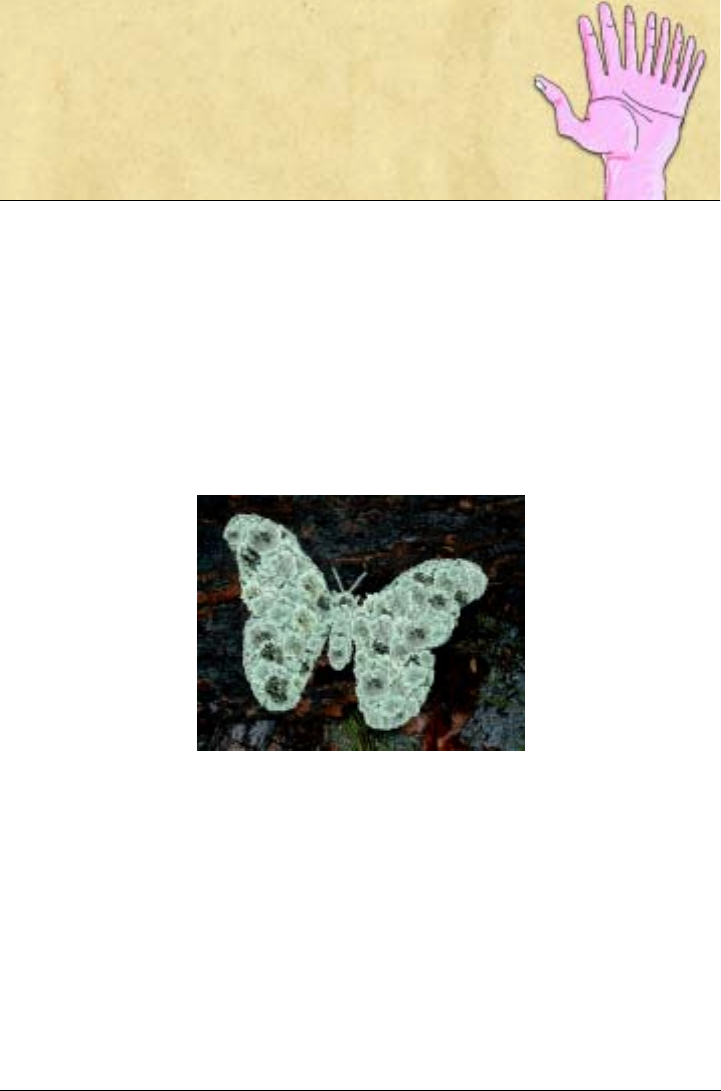
Image Hose 191
Image Hose
The Image Hose is a milestone in the evolution of art tools. Instead of painting with
color, the Image Hose paints with images — not just one or two at a stroke, but a
variety of changing images.
The images flowing from the hose change as you make a brush stroke. The Image
Hose lets you control the image output. For example, by increasing stylus pressure,
you can paint larger or more colorful images. By changing the direction of the stroke,
you can change the angle of the images. This is just a sample of the possible controls.
By creating your own set of images, you can paint with a unique image series.
The Image Hose feature allows you to paint with images.
The Image Hose deposits 24-bit images with an 8-bit mask. The mask enables you to
layer the images gently, without aliased edges or artifacts.
You can load the Image Hose with images of any description — leaves, bark, grass,
stones, people, or whatever you want. When you paint with these image elements, you
can build them into coherent shapes, such as a tree, hill, cobblestone street, or crowd of
people.

192 Corel Painter User Guide
How the Image Hose Works
The Image Hose is a brush. To use it, you must first load it with images. The images
are kept in special nozzle files. On a garden hose, you attach a nozzle to control the
flow of water; in Corel Painter, you attach a nozzle to the Image Hose to control its
medium — images.
A nozzle file can contain any number of images. Usually, the images are similar and
form a logical series — that is, the images progress along some order. For example, the
images might increase in size or advance in angle. It is not necessary for images to
progress in a logical series, but the Image Hose is more effective when they do.
“Indexing” refers to the method used to select particular images from the many images
in a nozzle file. Which method (indexing rule) to use for selecting nozzle images is
controlled in the Brush Creator by modifying the Image Hose settings on the Stroke
Designer tab. You can hose images sequentially, at random, or based on pressure,
stroke direction, or several other factors.
The images are indexed so that Corel Painter can locate and paint specific images on
request. As you paint with the Image Hose, you can request specific images from the
nozzle index by varying your input value. Increasing an input value takes images from
later in the series. For example, you can set up the nozzle so that by pressing harder
with a pressure-sensitive stylus, you paint with larger images.
You control the images themselves in the nozzle file. If you want more variety in the
images, create more images in the nozzle file. For more information about designing
and creating nozzle files, see “Creating, Loading, and Saving Nozzles for the Image
Hose” in the Help.
As your Image Hose requirements become more exacting, you can create complex
nozzles that involve two progressions — for example, images getting larger and
changing angle. In this case, you’ll use one input factor to determine image size and
use another factor to determine image angle. This creates a 2-Rank nozzle.
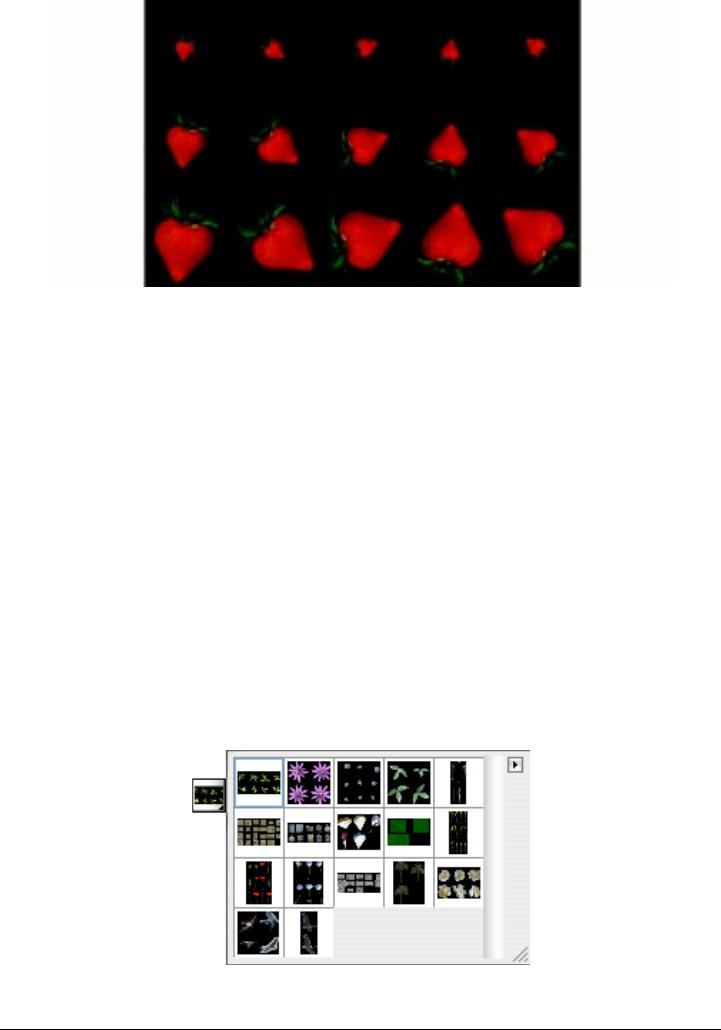
Image Hose 193
A 2-Rank nozzle progresses in two dimensions. In this example, the
first rank changes angle, and the second rank changes size.
Getting Started with the Image Hose
Corel Painter lets you select nozzles containing various images to use with the Image
Hose. You can adjust the opacity, size, color, position, and spacing of the images you
paint.
Image Hose Basics
The Image Hose is easy to use and offers a number of options for the behavior of
“nozzle spray.”
As with other Corel Painter brushes, the Image Hose has several variants. These
built-in variants combine nozzle control factors (indexing rules) with brush settings to
create different hose effects.
The Nozzle Selector in the toolbox.
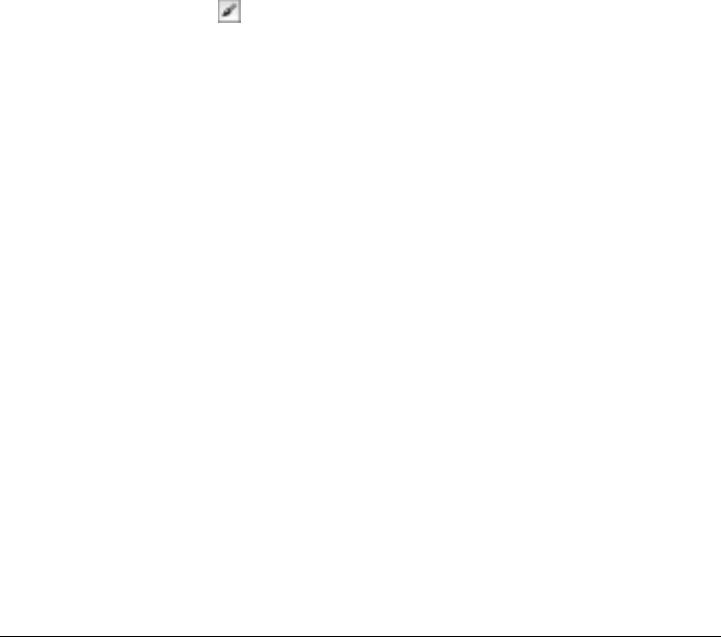
194 Corel Painter User Guide
Variants are divided into two types — Spray and Linear — according to the placement
of images in relation to the stroke. Spray variants scatter images. Linear variants place
images directly on the stroke path. Variants also differ in the way they link the size and
angle of images to factors such as stylus tilt, pressure, and position.
A variant’s name contains important information. For example, the variant’s name
Linear-Size-P Angle-D indicates that this is a Linear variant that links the size of
images you paint to the stylus pressure (P) and places them at an angle based on the
direction (D) of the stroke. The letters R, W, and B in variants’ names signify Random,
Wheel, and Bearing. For more information about these settings, see “Expression
Settings” on page 262 and “Ranks and Indexing Rules” in the Help.
You can use these variants as a starting point and then adjust the brush and nozzle
controls to deliver the images just as you want them.
To select a nozzle and use the Image Hose
1Choose the Brush tool from the toolbox.
2On the Brush Selector bar, choose the Image Hose from the Brush Category
selector.
3Click the Brush Variant selector, and choose a variant.
Each variant delivers the images differently.
4In the toolbox, click the Nozzle Selector, and choose a nozzle.
5Make a brush stroke on the canvas.
For more information about controlling the Image Hose, indexing images, and
working with nozzles, see “Image Hose” in the Help.
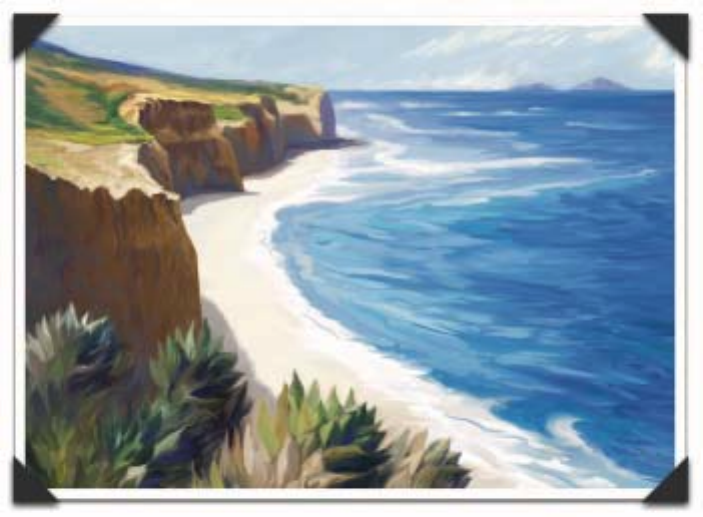
Award-winning artist, author and educator Cher Threinen-Pendarvis began her pioneering work
in digital art in 1987. Her artwork has been exhibited worldwide and her articles and art have
been published in many books and periodicals. Cher is author of all seven editions of The Painter
Wow! Book, including the most recent edition, The Corel Painter IX Wow! Book
Art by Cher Threinen-Pendarvis: Digital landscape painting
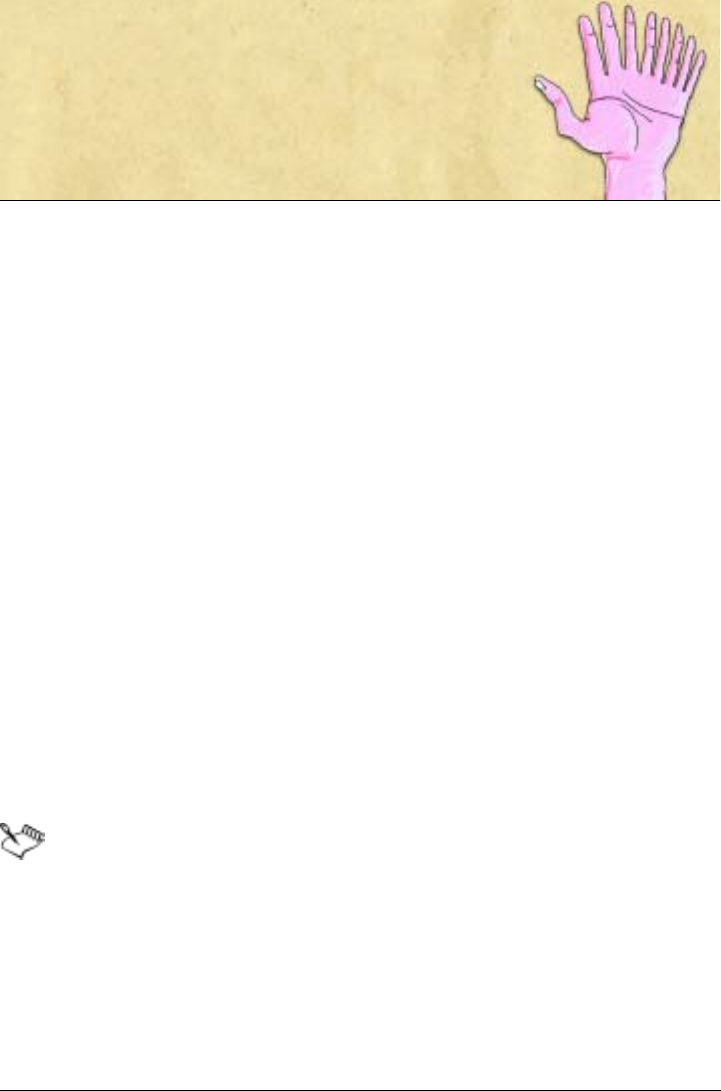
Customizing Brushes 197
Customizing Brushes
The Brush Creator makes it fun and easy to create brush variants in Corel Painter. This
chapter provides descriptions and procedures for building, customizing, and saving the
many parameters of any brush type using the Brush Creator.
Some of the brush settings in the Brush Creator can also be found in the Brush Control
palettes (available from the Window menu). The palettes match the categories on the
Stroke Designer page of the Brush Creator. The Brush Control palettes are ideal for
making small adjustments to a brush variant while you work. However, if you’re
unfamiliar with the settings, and want to preview and adjust a brush variant before
you apply strokes to the canvas, the Brush Creator is a better choice.
You can adjust the Corel Painter brushes in many different ways. In fact, the default
variants in the libraries on the Brush Selector bar are built with the same set of controls
used to build every other variant. They’ve just been adjusted until the results emulate a
real-life drawing tool.
Although these default brushes do excellent work, you’ll probably want to adapt them
to your particular needs, refining them to fit your own style of working. You can
change their size, shape, angle, flow, and much more.
Changes you make to brush variants, including basic controls like Size and Opacity, are
saved until the Restore Default Variant command is selected. Corel Painter also allows
you to save custom brushes as the default, as new variants, or as looks.
When Corel Painter starts, it references a folder (called “Brushes”) in the user
folder. Any customizations made to brushes are saved to this folder and are
referenced by Corel Painter in place of the original default brushes and
settings stored in the application folder. When a user resets a brush variant,
Corel Painter removes only the related files from the user folder.
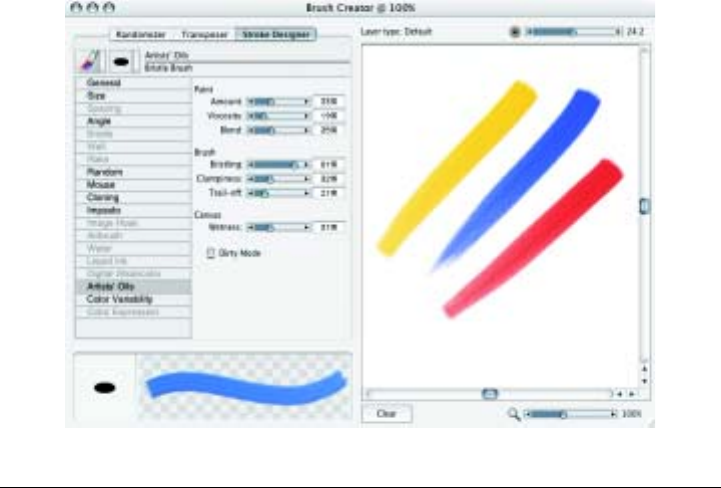
198 Corel Painter User Guide
Getting Started with the Brush Creator
The Brush Creator provides controls for customizing and creating brush variants. The
Brush Creator is integrated tightly with Corel Painter but contains its own tools,
palettes, menus, and workflow. The user interface of the application changes,
depending on whether you are using the main application or the Brush Creator.
There are three elements to the Brush Creator: the Randomizer, the Transposer, and
the Stroke Designer. The Randomizer creates random brush settings for the selected
brush category and variant. The Transposer creates new brush settings based on the
transition from one brush category and variant to another. The Stroke Designer lets
you control the size and shape of the media applied by a brush, the way the dabs are
repeated in a stroke, the media (usually color) that flows from a brush, and how a
brush interacts with underlying pixels.
The Brush Creator Workspace
The main window of the Brush Creator contains three tabs, each with its own user
interface: Randomizer, Transposer, and Stroke Designer. The other components of the
main window are the toolbox, the preview grid and window, the Scratch Pad, and the
palettes.
The main window of the Brush Creator.

Customizing Brushes 199
There are seven palettes used with the Brush Creator: Colors, Tracker, Color
Variability, Color Expression, Papers, Patterns, and Gradients. Color Variability and
Color Expression controls appear in the Brush Creator window (on the Stroke Designer
page); the others are available through the Window menu. The Colors and Tracker
palettes are open by default. You can choose the main and additional colors on the
Colors palette, or you can choose to clone color. For more information, see “Getting
Started with Color” on page 77.
The Tracker palette keeps a visual record of all brush strokes made in the Scratch Pad.
You can choose a brush variant from the Tracker palette to use in Corel Painter. Colors
and brush strokes selected in the Brush Creator apply to Corel Painter as a whole. For
more information, see “Using the Tracker Palette” in the Help.
The preview grid is located on the left side of the main window on the Randomizer and
Transposer pages. It contains a Brush Selector bar, and it displays several variations of
brush strokes for the selected brush. You can use these brush strokes as variants to be
randomized or transposed. The preview window displays the variant you select.
By increasing the size of the main window, you also make more brush strokes available
in the preview grid.
The preview grid.
To open the Brush Creator
•Press Command + B (Mac OS) or Ctrl + B (Windows).
You can also open the Brush Creator by choosing Window menu > Show
Brush Creator.
To access the Randomizer, Transposer, or Stroke Designer page
1Choose Window menu > Show Brush Creator.
2Click one of the following tabs:
•Randomizer
•Transposer
• Stroke Designer
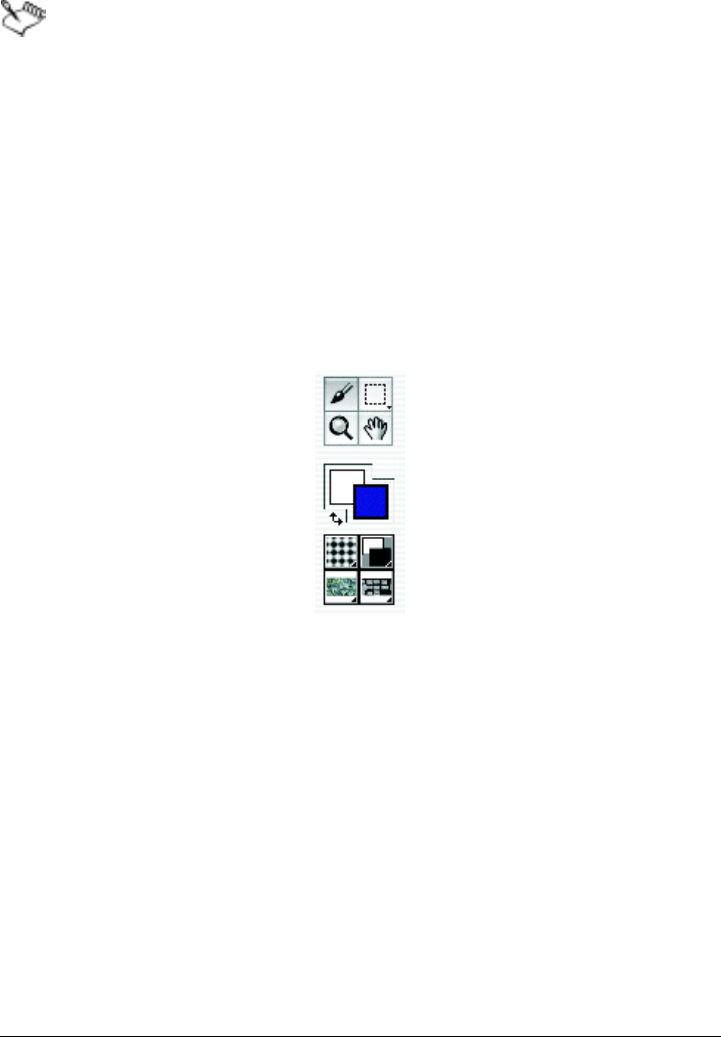
200 Corel Painter User Guide
Throughout the documentation, the steps for accessing these pages are
replaced with a direction to go directly to the particular page; for example,
“On the Stroke Designer page, click General.”
To resize the preview grid
•Drag the resize handle at the bottom-right corner of the main window of the Brush
Creator.
The Brush Creator Toolbox
The Brush Creator toolbox contains tools, color selection squares and access to four
content libraries to use in designing brush variants.
The Brush Creator toolbox.
The Brush tool applies brush strokes to the Scratch Pad, just as it applies brush strokes
to the canvas in Corel Painter. The Brush tool is selected by default when you open the
Brush Creator, and it’s set to the brush you were last using in Corel Painter.
The Rectangular and Oval Selection tools, and the Lasso tool, let you make selections
on the Scratch Pad, just as you would in Corel Painter. The Magnifier tool lets you
zoom in on areas of the Scratch Pad. The Grabber tool lets you scroll around the
Scratch Pad.
The toolbox contains a two overlapping squares for selecting a main color and an
additional color. Double-click either square to open the Color dialog box and choose a
new color.
Four libraries are accessible in the toolbox through the Paper Selector, Gradient
Selector, Nozzle Selector, and Pattern Selector.
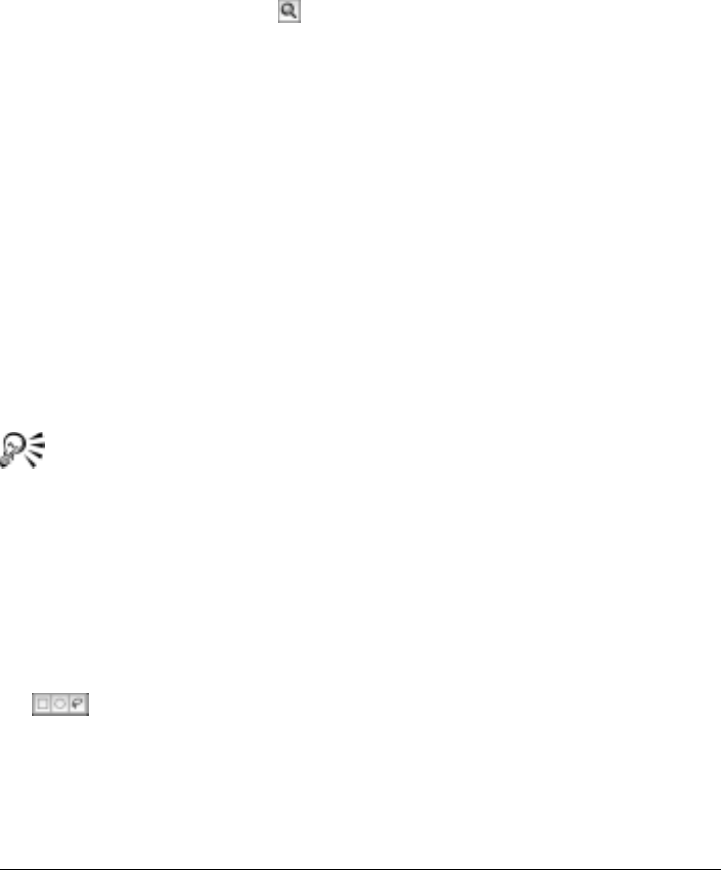
Customizing Brushes 201
When creating new brushes, you can test the brush strokes on the Scratch Pad. You
can zoom in on and zoom out of specific areas of the Scratch Pad, adjust the brush size,
make selections, and clear the Scratch Pad.
To zoom in on the Scratch Pad
1Do one of the following:
• Choose the Magnifier tool in the toolbox.
• Hold down Command + Spacebar (Mac OS) or Ctrl + Spacebar (Windows).
The Magnifier cursor shows a plus sign (+), which indicates that you are increasing
magnification (zooming in).
2Click or drag in the Scratch Pad.
To zoom out of the Scratch Pad
1Do one of the following:
• Choose the Magnifier tool, and hold down Option (Mac OS) or Alt (Windows).
• Hold down Option + Command + Spacebar (Mac OS), or Alt + Ctrl +
Spacebar (Windows).
The Magnifier cursor shows a minus sign (-), which indicates that you are
decreasing magnification (zooming out).
2Click in the Scratch Pad.
You can also adjust the Scale slider in the lower-right corner of the main
window to zoom in and out.
To adjust brush size in the Scratch Pad
•Adjust the Brush Size slider above the Scratch Pad.
To make a selection in the Scratch Pad
1In the toolbox, choose the Rectangular Selection, Oval Selection, or Lasso tool
.
These three selection tools share the same space in the toolbox. Holding down the
tool button provides access to the hidden tools.
2Drag in the document to make your selection.

202 Corel Painter User Guide
For more information about making selections, see “Creating Selections” in the
Help.
To clear the Scratch Pad
•Click Clear.
The Randomizer
The Randomizer takes the current brush category and variant, creates random settings
for them, and displays variants created from these random settings. You can then
choose a new randomized variant from the preview grid to use in the application, or
you can use one of these new variants to create even more randomized variants.
Randomized brush variants.
To create a random brush variant
1On the Randomizer page of the Brush Creator, do one of the following:
• On the Brush Selector bar, choose a brush category and variant.
• Choose a brush stroke from the preview grid.
Random settings are created according to the default settings.
2To fine-tune the settings of the randomized variants displayed in the preview grid,
adjust the Amount of Randomization slider.
Move the slider to the right to increase randomization; move it to the left to
decrease randomization.
3To create a new set of randomized settings, click the Randomize Current Selection
button .
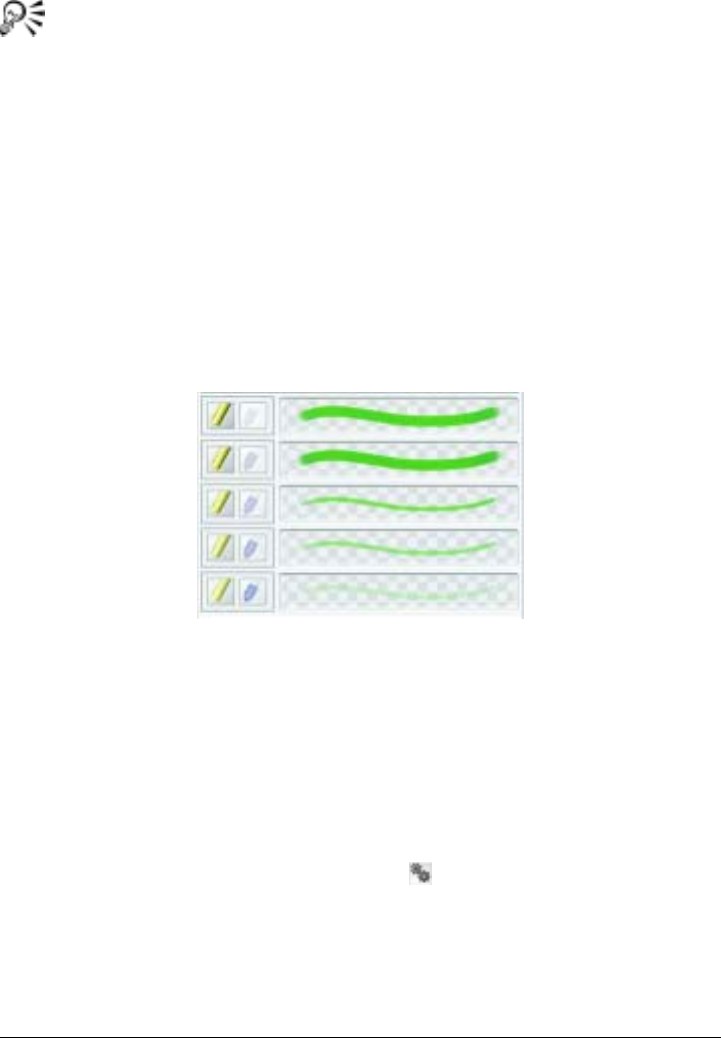
Customizing Brushes 203
You can also choose a brush category and variant in the main application
before you open the Brush Creator.
The Transposer
The Transposer creates new brush variants based on a transition from one variant to
another. For example, you can choose to combine variants from two categories, such as
Pencils and Felt Pens. The Transposer uses the settings from each variant to create new
variants.
The Transposer uses two Brush Selector bars, at the top and bottom of the page. The
top Brush Selector bar is used to choose the From variant; the bottom one is used to
choose the To variant. The Transposer uses these two variants to create a series of new
brush strokes.
Transposed brush variants.
To create a transposed brush variant
1Do one of the following:
•On the Brush Selector bars at both the top and bottom of the Transposer page,
choose a brush category and brush variant.
• Choose a brush stroke from the preview grid.
This brush variant becomes the next variant to be transposed.
2Click the Transpose Current Selection button .
To choose a new brush variant from the preview window
•Click a brush stroke in the preview window.
This brush variant becomes the next variant to be transposed.

204 Corel Painter User Guide
The Stroke Designer
The Stroke Designer lets you tweak the various settings for each brush variant to
create new brushes. A series of controls, each containing its own settings, can be
adjusted on the Stroke Designer page. The Stroke Designer page contains the same
controls available in the Brush Control palettes.
The Stroke Designer controls.
Managing Settings and Controls
You can access settings and controls on the Stroke Designer page of the Brush Creator
to modify and customize brush variants. Some controls are specific to a specific brush
category, such as Artists’ Oils or Impasto. Other controls and settings are specific to a
kind of variant. For example, Rake controls are only active when a rake brush variant is
selected, regardless of brush category.
General Controls
Corel Painter provides extensive control over brush properties and dab types. You can
also choose how brush strokes interact with existing color in the image. Some General
controls work in conjunction with Expression settings. For more information about
Expression settings, see “Expression Settings” on page 262.

Customizing Brushes 205
Dab Types
Dab types are methods of media application. To produce “computed” brush strokes,
Corel Painter uses rendered dab types that are computed during the stroke.
Earlier versions of Corel Painter used “dab-based” media application, in which brushes
applied small dots of media to create brush strokes. With Spacing between dabs set
small, strokes appear smooth. If you zoom in close enough, you can probably tell that
the brush stroke is made up of tiny dabs of color. If you make a rapid brush stroke or
set large spacing between dabs, strokes can become trails of dots.
Rendered dab types create continuous, smooth-edged strokes. They’re fast and less
prone to artifacts than dab-based media application. In fact, you can’t draw fast
enough to leave dabs or dots of color showing in a stroke, because they’re just not
there. Rendered dab types allow rich new features that were not possible with
dab-based media application.
The Scratchboard Tool variant of the Pen brush category illustrates the smooth
stroke that can be accomplished with the Corel Painter rendered Dab Types.
Corel Painter brushes use dab-based or rendered dab types:
Dab-based Dab Type Description
Circular Dabs are controlled by the sliders in the Size
and Angle areas of the Stroke Designer.
Single-Pixel Consists of one pixel only. You can’t change
its size. You use single-pixel brushes when
you zoom in for editing at the pixel level.
Static Bristle Controlled by the sliders in the Size area of
the Stroke Designer. When you select the
Static Bristle dab type, the preview grid
displays a bristly profile.

206 Corel Painter User Guide
A captured dab is for a captured brush. It lets you paint with specific shapes and designs.
Captured Shapes that you create and capture. Refer to
“Capturing Brush Dabs” on page 265.
Rendered Dab Type Description
Camel Hair Creates bristle brushes with circular arrays of
bristles. Individual brush hairs can have their
own color and can pick up underlying colors
independently of the Brush loading option.
By increasing color variability in
Corel Painter, you can make each hair a
separate color. For more information, see
“Setting Color Variability” on page 100.
The Feature slider in the Size area separates
bristles. The higher the setting, the farther
apart hairs appear. Using a low setting
makes the strokes more solid. For more
information about the Size controls, see “Size
Controls” on page 216.
Dab-based Dab Type Description
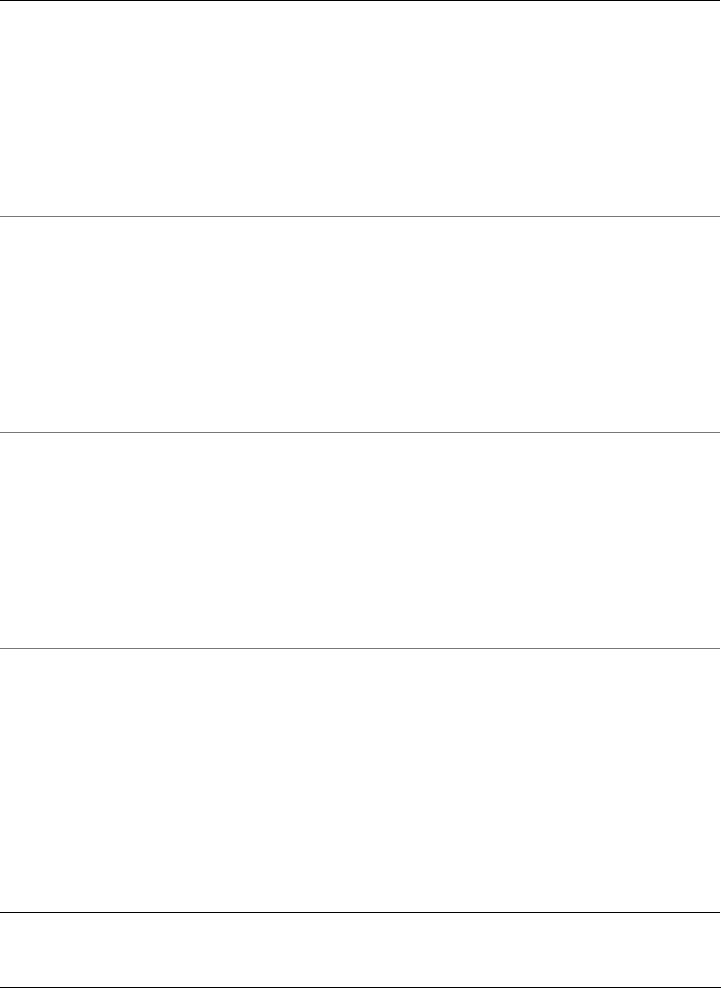
Customizing Brushes 207
Flat Creates flat brushes, like those used to apply
paint to houses or walls. Brushes that use
Flat dabs respond to bearing, allowing for
flat or narrow strokes, depending on how the
stylus is held. Flat dabs are always
perpendicular to the shaft of the stylus.
The Feature setting in the Size area separates
bristles.
Palette Knife Create brushes that are the opposite of Flat
dab brushes. With resaturation set low, you
can use these brushes to scrape, push, pick
up, or rapidly drag colors along. Palette
Knife dabs are always parallel to the shaft of
the stylus.
The Feature setting in the Size area separates
bristles.
Bristle Spray Creates brushes that can use airbrush
controls. These brushes recognize tilt, which
separates bristles on the opposite side of the
tilt. Holding down Option + Shift (Mac
OS) or Alt + Shift (Windows) reverses the
spray direction when you paint.
By adjusting the Feature slider in the Size
area, you can separate bristles.
Airbrush Creates brushes that act like airbrushes.
Bearing (direction) and angle (tilt) affect the
eccentricity of the resulting conic section.
The Feature slider in the Size area controls
the size of the individual droplets of media.
Setting the Feature slider too high might
produce undesirable artifacts.
By holding down Option + Shift (Mac OS),
or Alt + Shift (Windows), you can reverse
the spray direction when you paint.
Rendered Dab Type Description
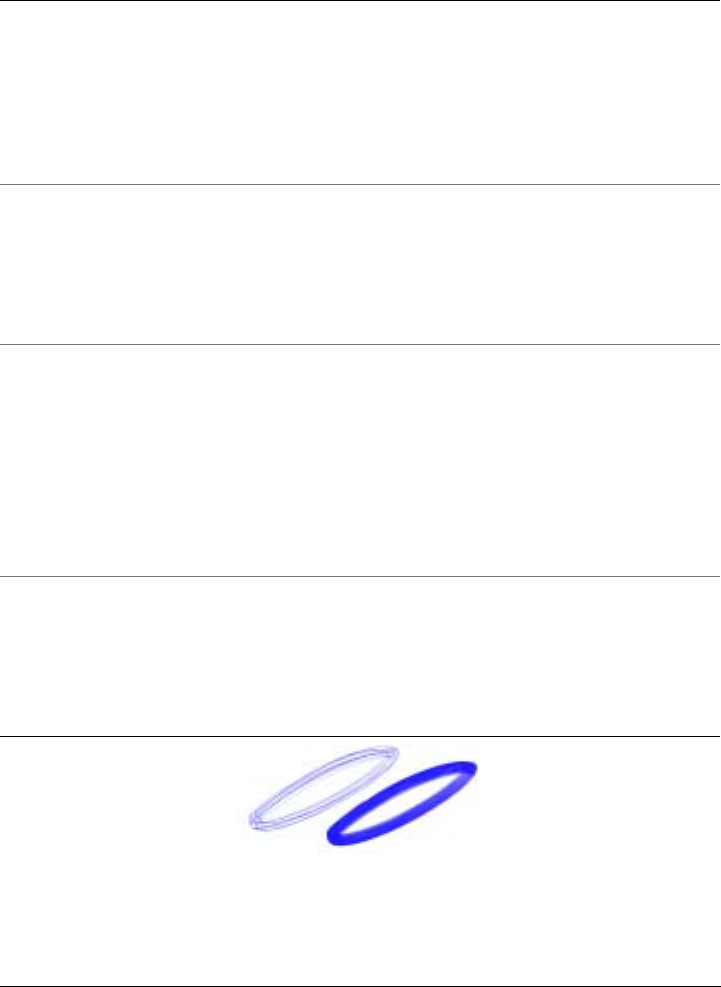
208 Corel Painter User Guide
The effects of Feature on the stroke.
• Liquid Ink dabs create liquid paint effects that simulate traditional ink-based
media. You can give a Liquid Ink brush stroke the appearance of height by
Pixel Airbrush Creates brushes that work like airbrushes.
Brushes that use Pixel Airbrush dabs cannot
use the Feature slider to control the size of
individual droplets of media. Holding down
Option + Shift (Mac OS) or Alt + Shift
(Windows) when painting reverses the spray
direction.
Line Airbrush Creates brushes that work like airbrushes.
Brushes that use Line Airbrush dabs spray
lines instead of droplets of media. By holding
down Option + Shift (Mac OS), or Alt +
Shift (Windows), you can reverse the spray
direction when you paint.
Projected Creates brushes that act like airbrushes.
Brushes created with Projected dabs work
similarly to the airbrush from previous
versions of the application, but react to
bearing and angle data. They create conic
sections with an overall softness. By holding
down Option + Shift (Mac OS), or Alt +
Shift (Windows), you can reverse the spray
direction when you paint.
Rendered Creates brushes that conform the source to a
stroke. Use the Source pop-up menu to
control what is mapped into the computed
brush strokes. For more information, see
“Source, Opacity, and Grain Settings” on
page 215.
Rendered Dab Type Description

Customizing Brushes 209
applying lighting effects. There are five types of Liquid Ink dab types: Liquid Ink
Camel Hair, Liquid Ink Flat, Liquid Ink Palette Knife, Liquid Ink Bristle Spray, and
Liquid Ink Airbrush.
• Watercolor dabs create brushes that work like watercolor brushes. The colors flow
and mix and absorb into the paper. You can control the wetness and evaporation
rate of the paper. There are five types of Watercolor dab types: Watercolor Camel
Hair, Watercolor Flat, Watercolor Palette Knife, Watercolor Bristle Spray, and
Watercolor Airbrush.
• Artists’ Oil dabs produce brushes that work like real-world, high quality oil
brushes.
To choose a dab type
1On the Stroke Designer page of the Brush Creator, click General.
2Choose a dab type from the Dab Type pop-up menu.
Stroke Types
Stroke type determines how media is applied during a brush stroke. Corel Painter
brushes use one of the following stroke types. Some stroke types may be grayed out
depending on the currently selected brush variant and dab type.
• The Single stroke type draws one dab path that corresponds exactly to your brush
stroke.
You can use Static Bristle, Captured, or one of the bristly rendered dab types (such
as Camel Hair) with the Single stroke type to create the effect of multiple bristles.
The Single stroke type has one dab path.
• The Multi stroke type draws a set of randomly distributed dab paths, positioned
around the brush stroke you make. These dabs leave dab paths that are not parallel
and might overlap. The Multi stroke type may produce different results each time
you use it.
Increasing the Jitter value in the Random area spreads out the strokes in a
multi-stroke brush.
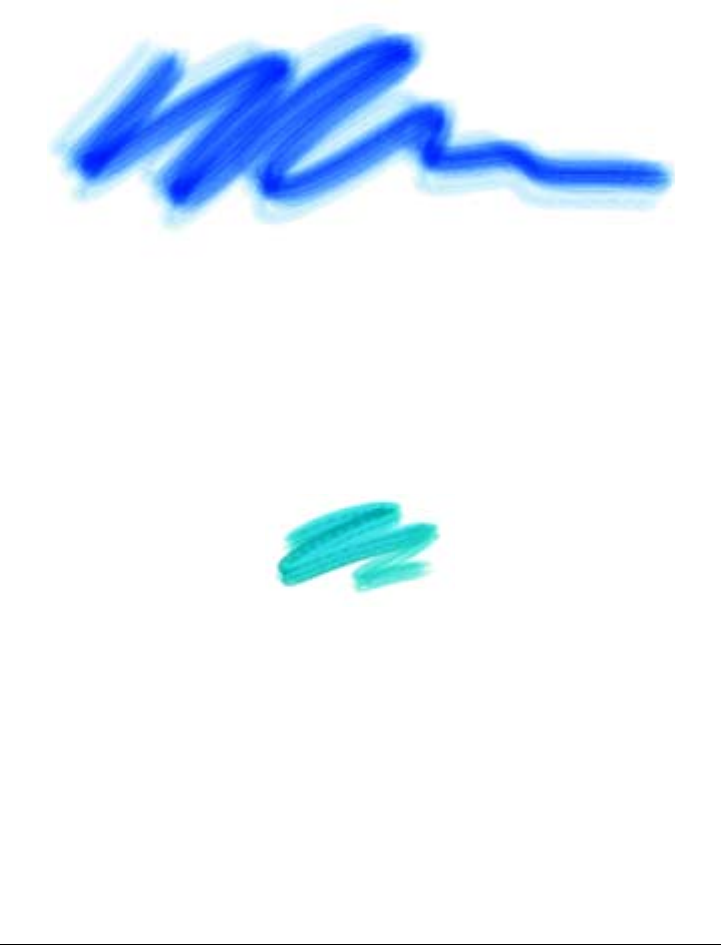
210 Corel Painter User Guide
Multi-stroke brushes must be precomputed, which can generate a delay in their
appearance on the screen. Because of this delay, multi-stroke brushes work best
when you apply them in short, controlled strokes.
The Multi stroke type draws a set of randomly distributed dab paths.
• The Rake stroke type draws a set of evenly distributed dab paths. The several dab
paths in a rake brush stroke are parallel. You can control all other aspects of the
stroke by using settings in the Rake area of the Stroke Designer.
Each bristle in a Rake brush can have a different color. Increasing Color Variability
in Corel Painter causes bristles to be colored differently.
A rake stroke is composed of evenly distributed dab paths.
• The Hose stroke type applies only to the Image Hose. It’s a single stroke composed
of the current Image Hose Nozzle file. To learn more about the Image Hose and
Nozzle files, refer to “Image Hose” on page 191.
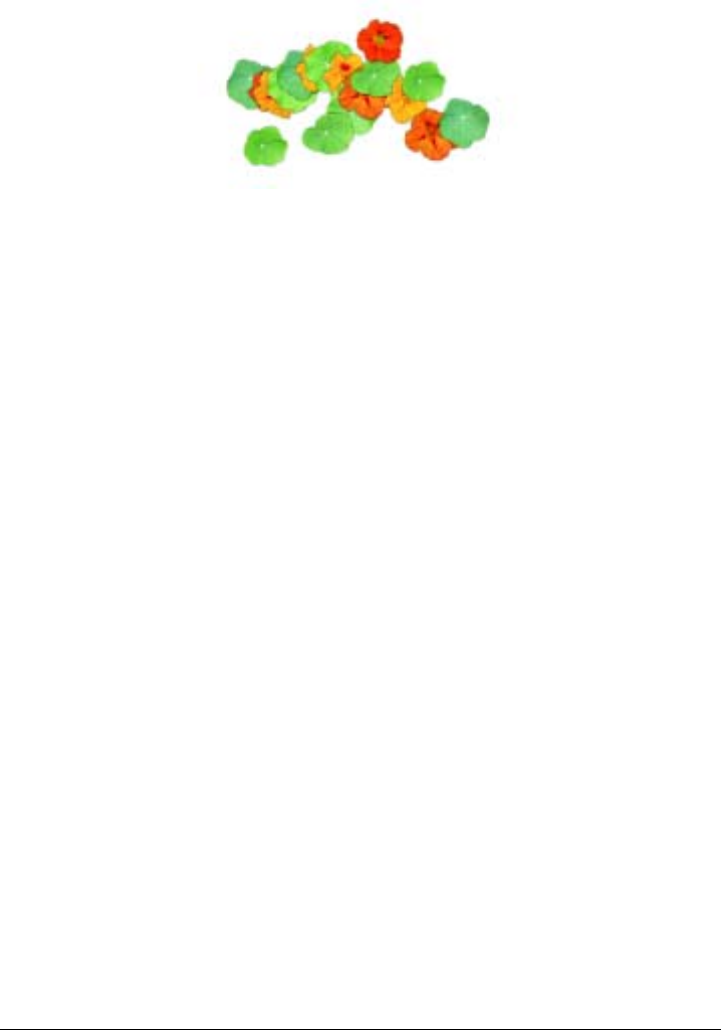
Customizing Brushes 211
The Hose stroke type uses the current Nozzle file as media.
To choose a stroke type
1On the Stroke Designer page of the Brush Creator, click General.
2Choose a stroke type from the Stroke Type pop-up menu.
Methods and Subcategories
The brush method defines the most basic level of brush behavior and is the foundation
on which all other brush variables build. You can think of the method and method
subcategory as attributes of the stroke’s appearance.
Because the method sets a brush variant’s most basic behavior, you can alter a variant’s
behavior by changing its method. For example, suppose you want a stroke that looks
like Charcoal, but instead of hiding underlying strokes, you want the brush strokes to
build to black. You can get this effect by changing the method to Buildup. Perhaps
you want a variant of the Pens brush category to smear underlying colors. You can
change its method from Cover to Drip. Some brush effects are less easily affected by
other methods, and results may differ.
Each method can have several variations, called method subcategories. These
subcategories further refine the brush behavior. The following terms are used in
describing most method subcategories:
• Soft methods produce strokes with feathered edges.
• Flat methods produce hard, aliased strokes with pixelated edges.
• Hard methods produce smooth strokes.
• Grainy methods produce brush strokes that react to paper texture.
• The words “edge” and “variable” are sometimes used to describe a method
subcategory. “Edge” means that strokes are thick and sticky-looking. “Variable”
means that a brush stroke is affected by tilt and direction.

212 Corel Painter User Guide
Combining a method with a method subcategory results in a specific brush style that
you can assign to a given brush. For example, Grainy Hard Coverbrush strokes interact
with paper grain and are semi–anti-aliased so that they hide underlying pixels. Grainy
Hard Cover is the default method for Chalk and Charcoal.
Grainy Hard Buildup was used to create the brush stroke on top.
Soft Variable Buildup was used to create the stroke on the bottom.
Corel Painter supplies the following methods:
• Buildup
•Cover
•Eraser
•Drip
•Mask (Cover)
• Cloning
•Wet
•Digital Wet
•Plug-in
The Buildup methods produce brush strokes that build toward black as you overlay
them. A real-world example of buildup is the felt pen: scribble on the page with blue,
then scribble on top of that with green, and then red. The scribbled area keeps getting
darker, approaching black. Even if you were to apply a bright color like yellow, you
couldn’t lighten the scribble — it would stay dark. Crayons and Felt Pens are buildup
brushes.
An example of the Buildup method.
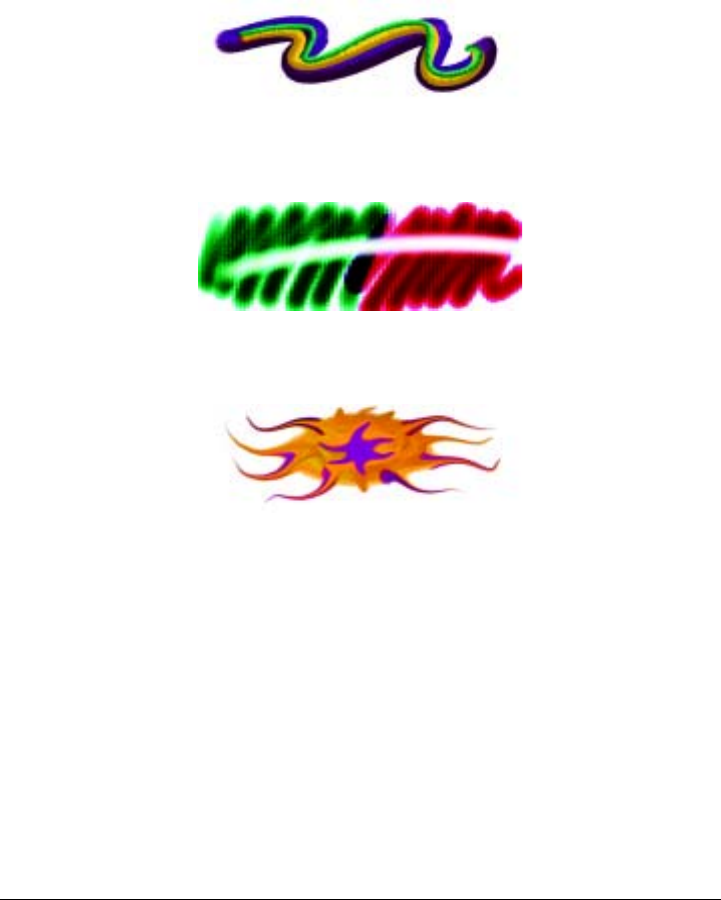
Customizing Brushes 213
The Cover methods produce brush strokes that cover underlying strokes, as oil paint
does in a traditional art studio. No matter what colors you use, you can always apply a
layer of paint that completely hides what’s underneath. Even with a black background,
a thick layer of yellow remains pure yellow. Some Chalk and Pen variants are examples
of brushes that use the Cover method.
An example of the Cover method.
The Eraser methods erase, lighten, darken, or smear the underlying colors.
An example of the Eraser method.
The Drip methods interact with the underlying colors to distort the image.
An example of the Drip method.
You do not normally need to use the Mask method, because the masking capabilities of
Corel Painter are provided by the Cover method. The Mask method is provided only
for compatibility with earlier versions of the application.
The Cloning methods take images from a clone source and re-create them in another
location, often rendering them in a Natural-Media style. For more information about
cloning images, refer to “Cloning Images” on page 273.

214 Corel Painter User Guide
The image on the left was created with a brush that
used the image on the right as the clone source.
Plug-in is a special category of method subcategories. It defines no specific brush
behavior, but is an open door to a wide range of subcategories.
It’s well worth your time to browse through the Plug-in method subcategories. There,
you’ll find methods such as Left Twirl, which gives you a brush with the dab and stroke
of an Impressionist performing left-handed twirls.
You can give any built-in brush the power of a
plug-in by changing its method and subcategory.
The Wet method applies brush strokes to a Watercolor layer. For more information, see
“Working with the Watercolor Layer” on page 170.
The Digital Wet method applies digital watercolor brush strokes to the canvas or a
regular layer. For more information, see “Working with Digital Watercolor” on
page 172.
To choose a method and subcategory
1On the Stroke Designer page of the Brush Creator, click General.
2Choose a method from the Method pop-up menu.
3Choose a subcategory from the Subcategory pop-up menu.

Customizing Brushes 215
Source, Opacity, and Grain Settings
The Source setting specifies the media that is applied by the brush variant. Source
applies only to some dab types, such as Line Airbrush, Projected, and Rendered. Refer
to “Painting with Color” on page 149 for more information about setting a media
source.
Corel Painter brushes use one of the following source types:
• Color applies primary or secondary color.
• Gradient applies the current gradient across the length of the stroke.
• Gradient Repeat applies the current gradient repeatedly along the stroke.
• Pattern paints with a pattern containing no mask information.
• Pattern With Mask paints with a pattern limited by the pattern’s mask.
• Pattern As Opacity paints a pattern in which the luminance of the pattern becomes
the opacity of the stroke.
The Opacity slider determines how Corel Painter should vary the density of the media
being applied. It sets the maximum opacity of the selected brush. The opacity of an
Airbrush variant is often set to be determined by stylus pressure. Heavier pressure
produces more opaque strokes. You can use the Expressions settings on the Stroke
Designer page to link opacity to stylus or mouse data.
The Grain slider determines the maximum amount of paper texture that Corel Painter
should reveal in a brush stroke. Some default variants have their grain component
determined by pressure. Increasing pressure causes the pencil to “dig into” the paper.
You can use the Expressions settings on the Stroke Designer page to link grain to
stylus or mouse data. You can also use the paper’s brightness and contrast settings to
control brush–grain interaction. For more information, see “Using Paper Texture” on
page 113.
To choose a media source
1On the Stroke Designer page of the Brush Creator, click General.
2Choose a source from the Source pop-up menu.
To set brush opacity
1On the Stroke Designer page of the Brush Creator, click General.
2Move the Opacity slider to the left to reduce opacity, or to the right to increase
opacity.
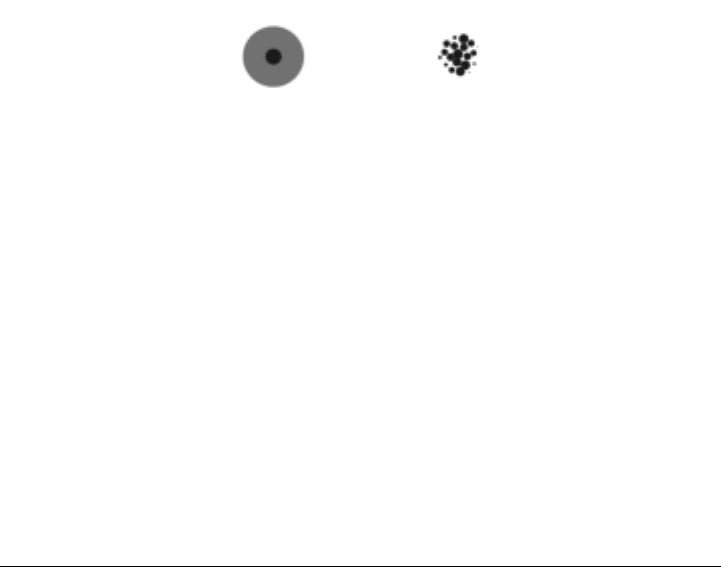
216 Corel Painter User Guide
To set grain
1On the Stroke Designer page of the Brush Creator, click General.
2Move the Grain slider to the left to reduce the penetration into the grain. Move it
to the right to increase the penetration.
Size Controls
The Size brush feature determines how Corel Painter varies the width of the brush
stroke. The range from minimum to maximum is determined by Size and Min Size
sliders in the Size area of the Stroke Designer page. Some Size controls work in
conjunction with Expression settings. For more information about Expression settings,
see “Expression Settings” on page 262.
The Brush Dab Preview Window in the Size area of the Stroke Designer page shows
how your changes affect the brush dab. Clicking in this preview window lets you
toggle between “hard” and “soft” views of the dab. The Preview supports only hard
and soft views of dab based brushes.
Click in the preview window to toggle between “hard” (left) and “soft” (right) views.
In the hard view, concentric circles show the minimum and maximum sizes of a brush.
The inner (black) circle shows the minimum dab width. The outer (gray) circle shows
the maximum dab width. Remember that some brushes vary the line width based on
pressure or stroke speed. The difference between the diameter of the two circles shows
the range in which the stroke width can vary.
In the soft view, shading shows the density distribution of the brush tip. The density
distribution describes how much of the medium is conveyed by a given point on the
brush dab. For example, an individual dab made by an airbrush produces a soft-edged
circular mark with minimum density at the outer edge of the dab. Density increases
inward to a maximum value at the exact center of the dab. The soft view cannot be
used for the Image Hose or rendered dab types.
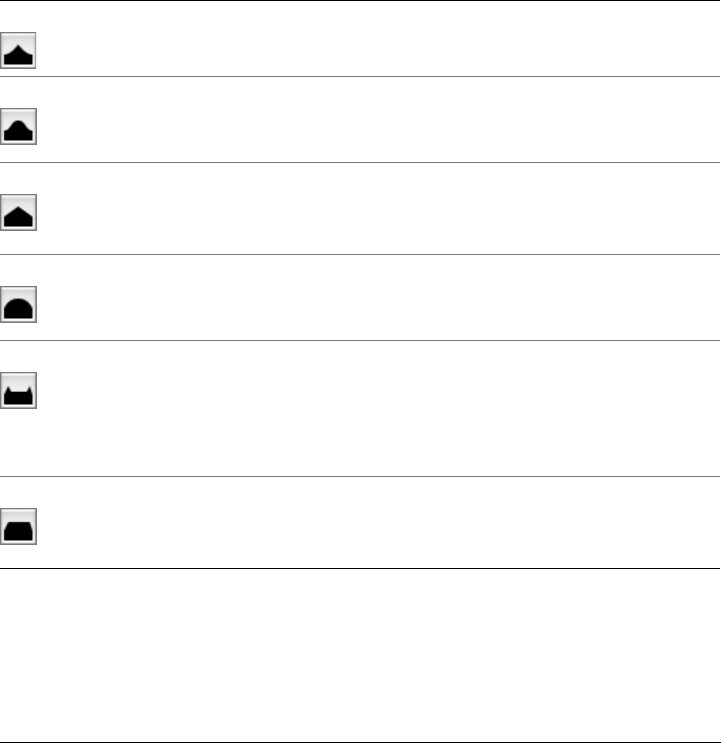
Customizing Brushes 217
Brush Tip Profiles
The brush tip, or “profile,” shows a cross-section of density distribution across the
diameter of the dab. You can think of a brush tip profile as a bell-curve graph
representing the density spread across the brush dab.
Different media have different density distributions. Changes in the density
distribution produce different marking qualities in a brush stroke. For rendered
airbrush dab types, the tip profile controls the concentration of the spray.
Each Corel Painter brush uses one of the following brush tip profiles.
Artists’ Oils Brush Tip Profiles
There are six brush tips designed specifically for Artists’ Oil brushes. You can also use
any brush tip, listed in the table above, with Artists’ Oil brushes.
Pointed Profile Provides maximum density at the center,
with rapid falloff to the edge.
Medium Profile Has a wide area of greater density at the
center, with rapid falloff to the edge.
Linear Profile Provides maximum density at the center,
with even falloff to the edge.
Dull Profile Provides maximum density at the center,
with high density weighting to the edge.
Watercolor Profile Provides maximum density at the outer edge
in a ringlike fashion, with medium internal
density. This tip may be used with the
rendered dab types to yield a hollow dab or a
spray concentration.
1-Pixel Edge 1-Pixel Edge provides maximum density
throughout, with rapid falloff at the edge,
producing a 1-pixel, anti-aliased edge.
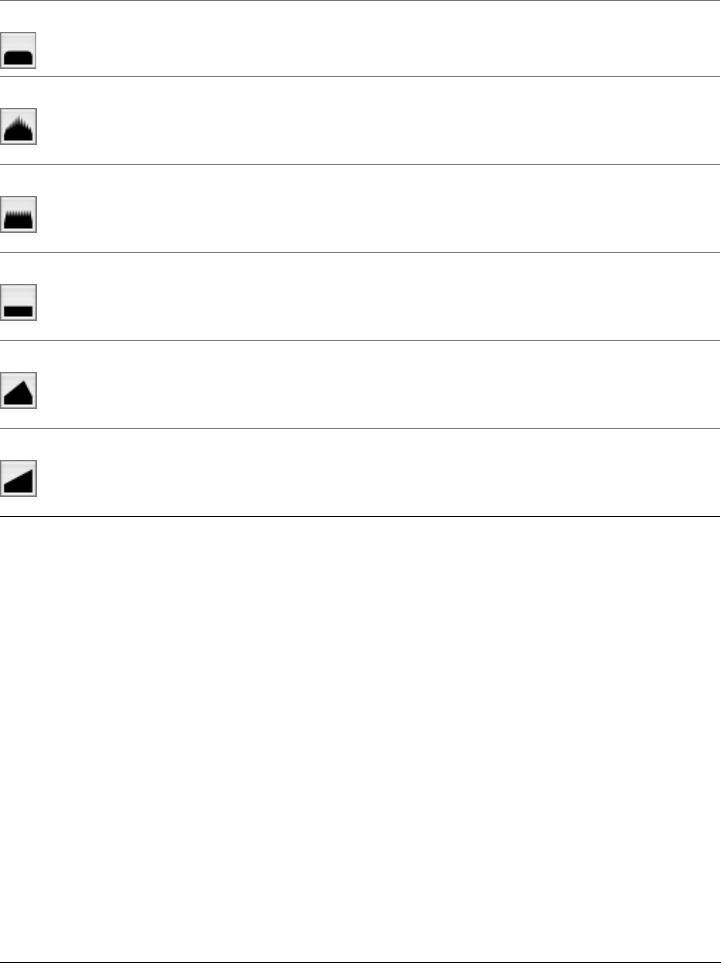
218 Corel Painter User Guide
To choose a brush tip
1On the Stroke Designer page of the Brush Creator, click Size.
2Click the brush tip profile that you want to use.
Stroke Size
The Size slider controls the width of the brush and the brush stroke. As Size changes,
you may need to adjust the Spacing controls for brushes that use nonrendered or dab-
based dab types to prevent gaps from appearing in the stroke.
Soft Round Provides maximum density throughout,
with rapid falloff at the edge.
Pointed Rake Provides a range of bristle lengths, with
bristles longer in the center and tapering in
length toward the edge.
Flat Rake Provides a range of bristle lengths and
maximum density throughout, producing
pronounced, even bristling.
Flat Designed for Artists’ Oil palette knives, it
provides maximum density throughout, with
rapid falloff at the edge.
Chisel Designed for Artists’ Oil palette knives, its
maximum density is off-center, with uneven
falloff.
Wedge Designed for Artists’ Oil palette knives, it
provides maximum density at one edge, with
consistent falloff to the other edge.
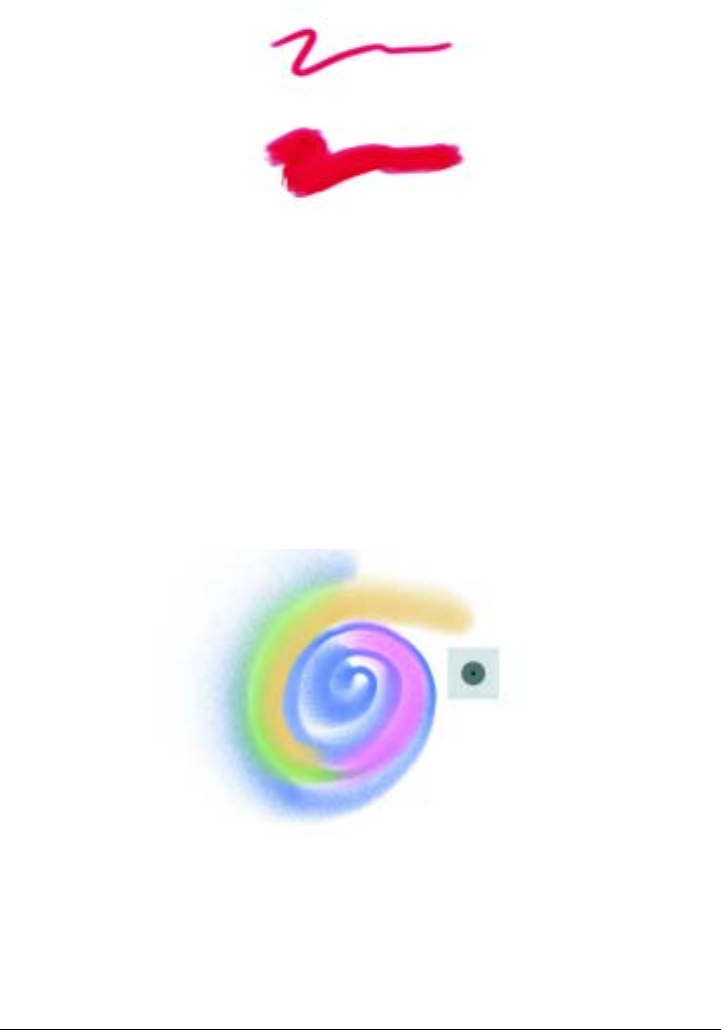
Customizing Brushes 219
The Size slider controls the width of the brush.
In your studio, you expect the pressure you exert on a brush or drawing tool to make a
difference in the width of the resulting brush stroke. The Min Size control allows you
to create a brush stroke that is amazingly realistic. You can set up a brush that
responds to the elegance of subtle hand movements. As stylus pressure eases, brush
strokes taper. As pressure increases, brush strokes widen, just as they would with a real
brush.
Min Size represents the smallest stroke size for the selected brush and is expressed as a
percentage of the Size setting. Knowing that Size sets the largest stroke size and that
Min Size sets the smallest stroke size (in relationship to the Size setting), you can easily
control the overall variation in stroke size.
The minimum and maximum sizes of a stroke can be linked to stylus
settings, such as pressure or velocity. The small black circle shows the
minimum stroke size, and the gray circle shows the maximum stroke size.
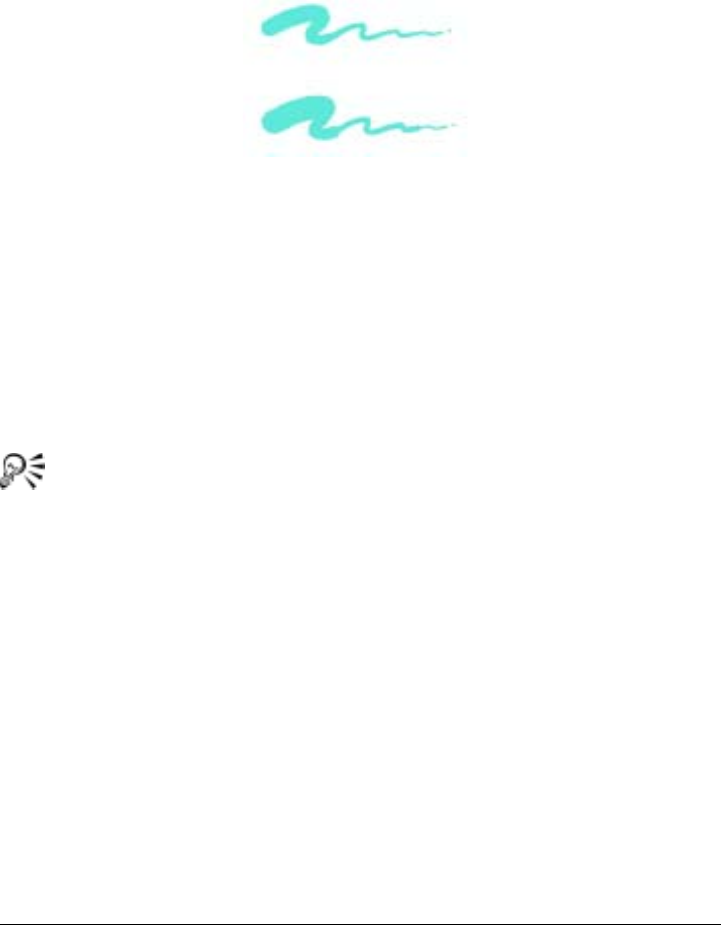
220 Corel Painter User Guide
The Size Step slider controls the transition between narrow and wide sections of a
stroke. Moving the slider to the right makes the transition appear more abrupt.
Moving it to the left makes the transition smoother. Size step is applicable only to
dab-based brushes.
The Size Step slider controls the transition between the narrow and wide
sections of a stroke. Settings shown are 1% (top) and 100% (bottom).
For brushes that use rendered dab types, the Feature slider determines the size of the
dabs of paint applied.
To set brush size in the Stroke Designer
1On the Stroke Designer page of the Brush Creator, click Size.
2Move the Size slider to the right to make the brush larger, or to the left to make it
smaller.
You don’t need to open the Size area of the Stroke Designer page to adjust the
size of a brush. You can type a value in the Size box on the property bar, or
you can adjust the slider on the property bar. For more information on the
property bar, see “Property Bar Basics” in the Help.
You can also press the square brackets, ( [ or ] ), to decrease and increase the
brush size according to the value specified in General Preferences. For more
information, see “General Preferences” on page 32.
To use the brush sizing shortcut
1Hold down Command + Option + Shift (Mac OS) or Ctrl + Alt + Shift
(Windows), and drag in the image window.
A circle that represents the brush diameter appears beneath the cursor.
2When you’ve dragged the circle to the size you want, release the mouse button.
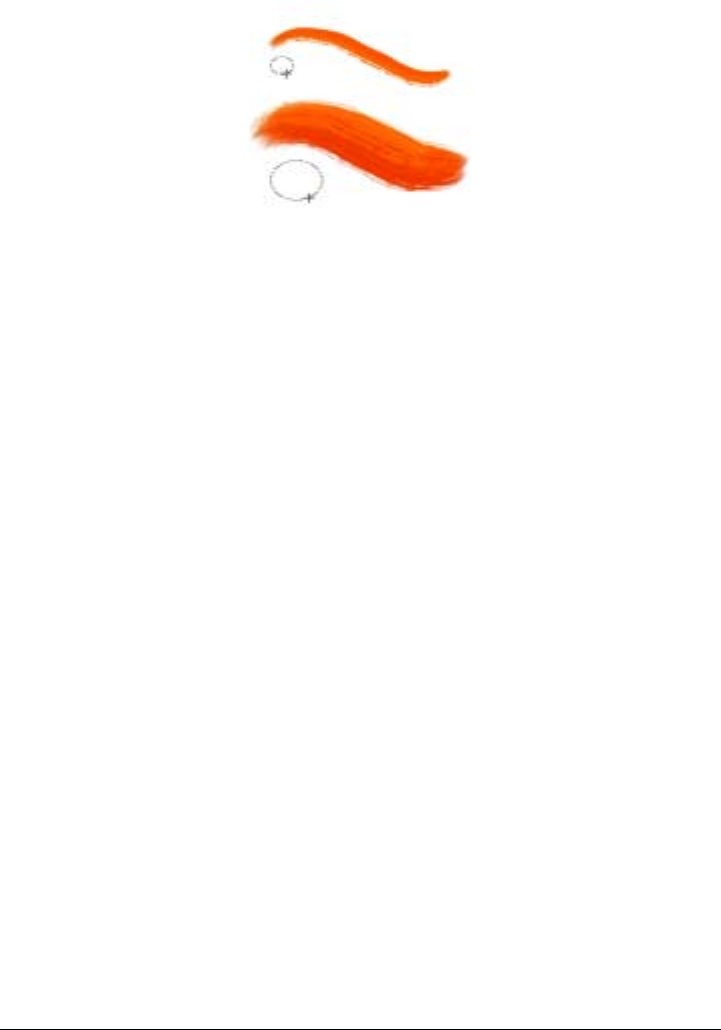
Customizing Brushes 221
The brush sizing shortcut lets you use keyboard commands
to adjust the brush size in the document window.
To set minimum stroke size
1On the Stroke Designer page of the Brush Creator, click Size.
2Move the Min Size slider to the right to increase the minimum brush size. Move it
to the left to decrease the minimum brush size.
To set stroke transition
1On the Stroke Designer page of the Brush Creator, click Size.
2Move the Size Step slider to the right to increase the transition between brush sizes.
Move it to the left to make the transitions smaller.
Spacing Controls
When a brush stroke uses a dab-based dab type, Corel Painter creates the stroke with a
series of dabs. By adjusting the spacing between those dabs, you can control the
continuity of the brush stroke.
The Spacing slider controls the distance between brush dabs in a stroke. The Min
Spacing slider specifies the minimum number of pixels between dabs. If you don’t
want a continuous stroke, you can adjust the Min Spacing to create a dotted or dashed
line. Each dot or dash represents one brush dab.
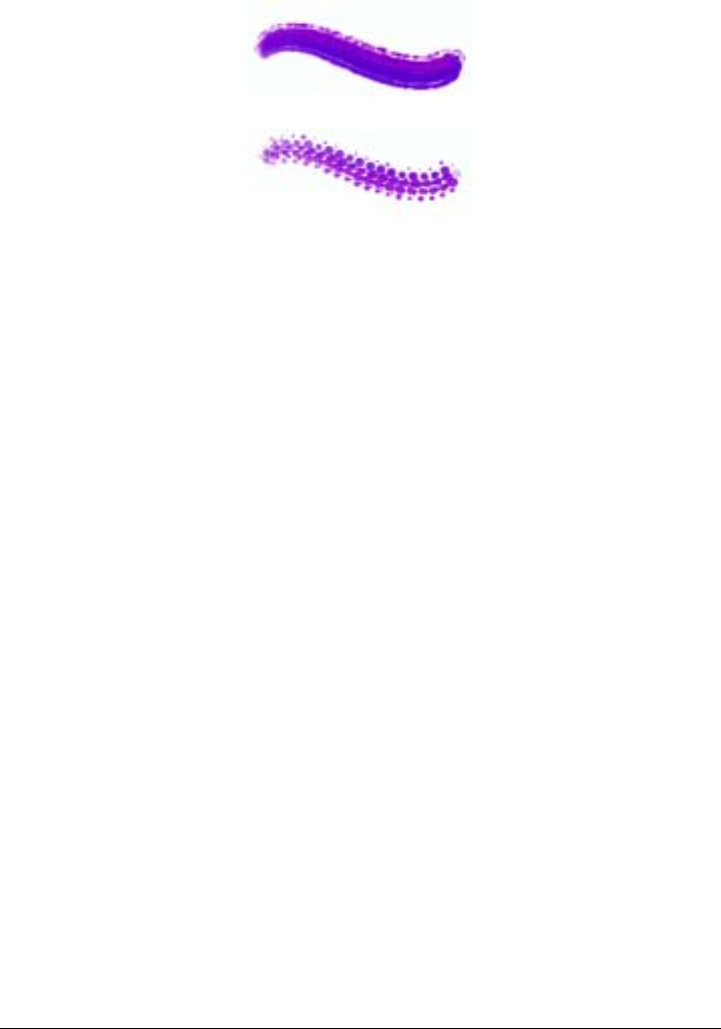
222 Corel Painter User Guide
The Min Spacing slider controls the minimum number of pixels
between dabs. Settings shown are 2.0 (top) and 10.5 (bottom).
Damping is used to smooth otherwise jagged brush strokes for brushes using rendered
dab types. Higher values make the stroke smoother. (Damping suspends a stroke in a
mathematical spring area by using calculations to even out edges and reduce
jaggedness.)
High values of Damping round out corners of a stroke. A value of 50% works best.
Higher values might be necessary for jittery input devices such as a mouse.
Continuous Time Deposition controls whether you must move a brush before a
medium is applied. With Continuous Time Deposition enabled, the medium begins
flowing at the first touch.
Brushes that use rendered dab types take full advantage of this setting, causing the
medium to pool realistically when the stroke is slowed or paused. Brushes that use
dab-based dab types require a full pause in the stroke before the medium begins to
pool. You use Continuous Time Deposition mostly with airbrush tools.
With Continuous Time Deposition disabled, you must move a brush before the
medium flows.
Cubic Interpolation smooths jagged brush strokes by adding points to dab paths,
primarily for brushes that use dab-based dab types. Unlike Damping, which uses
mathematical calculations to smooth jagged edges, Cubic Interpolation inserts
additional points into dab paths, which are used to replot brush strokes.
Cubic Interpolation is best for dab-based dab types, while Damping is best for
rendered dab types.
To set spacing between brush dabs
1On the Stroke Designer page of the Brush Creator, click Spacing.

Customizing Brushes 223
2Do one of the following:
• To increase the spacing between dabs, move the Spacing slider to the right
bringing it closer to the size of the dab itself.
When the Spacing slider is at 100%, the size of the dab equals the spacing. For
example, a dab that is 10 pixels across is repeated every 10 pixels.
• To decrease the distance between dabs, move the Spacing slider to the left until
the dabs begin to overlap.
Overlapping increases the density of the stroke and makes it look more
continuous.
To set minimum dab spacing
1On the Stroke Designer page of the Brush Creator, click Spacing.
2Move the Min Spacing slider to the right to increase the minimum spacing between
dabs. Move it to the left to decrease the minimum spacing between dabs.
To set smooth rendered dab strokes
1On the Stroke Designer page of the Brush Creator, click Spacing.
2Move the Damping slider to the right to even out jagged strokes. Move it to the
left to allow for more ragged transitions between points on the stroke.
To set Continuous Time Deposition
1On the Stroke Designer page of the Brush Creator, click Spacing.
2Enable the Continuous Time Deposition check box.
To set smooth strokes by adding path points
1On the Stroke Designer page of the Brush Creator, click Spacing.
2Move the Points slider to the right to add points and even out jagged strokes. Move
it to the left to decrease the number of additional points.
Angle Controls
Corel Painter gives you extensive control over brush shape. Some Angle controls work
in conjunction with Expression settings. For more information about Expression
settings, see “Expression Settings” on page 262.
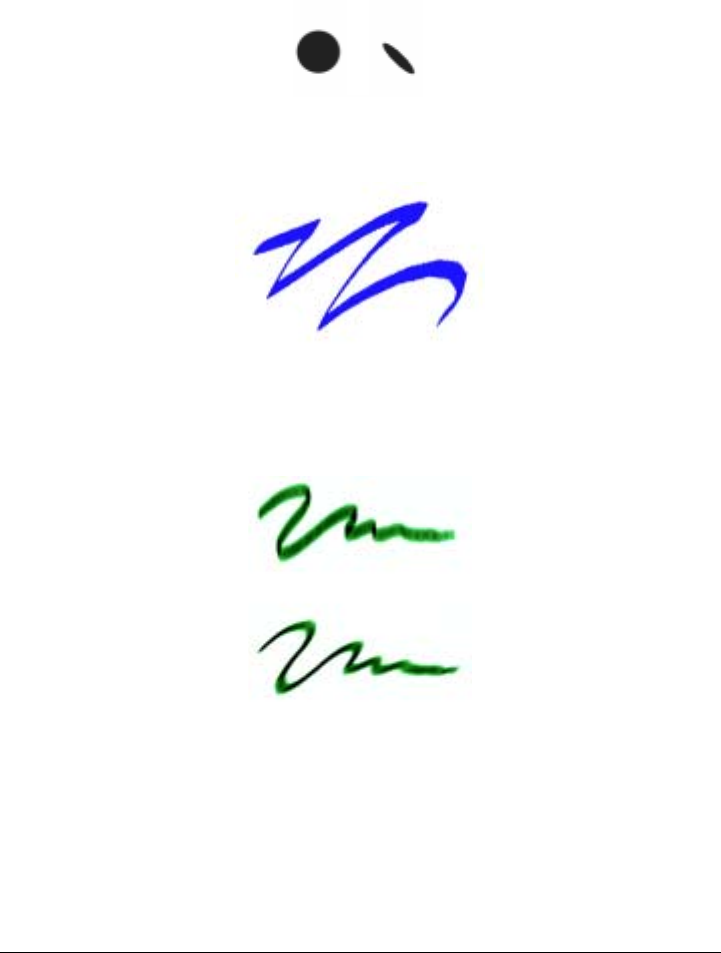
224 Corel Painter User Guide
The Squeeze slider controls the shape of the brush dab. Squeezing a brush changes it
from round to elliptical. You use Squeeze controls with Circular and Captured dab
types.
The Squeeze slider controls the shape of the brush dab.
Settings shown are 100% (left) and 25% (right).
Examples of Squeeze used to create a Calligraphy effect with a Pen brush.
The Angle slider controls the angle of an elliptical brush dab and the length of the
ellipse. You use Angle controls with Circular and Captured dab types.
The Angle slider controls the angle of an elliptical brush dab. It is significant only for dabs
with Squeeze settings under 100%. Angle settings shown are 90° (top) and 45° (bottom).
For dab-based brushes, the Ang Range slider lets you specify a range of dab angles that
may appear in a brush stroke. To take advantage of this feature, you must use the
Expression settings on the Stroke Designer page to base the angle on some factor, such
as stroke direction or bearing.

Customizing Brushes 225
The Ang Range slider controls the range of dab angles that can appear
in a brush stroke. Settings shown are 0° (left) and 180° (right).
For dab-based brushes, the Ang Step slider controls the increment of change for
brushes with an Ang Range setting greater than 0°. For example, setting the Ang Step
to 5° produces a brush dab every 5° within the current Ang Range setting.
The Ang Step slider controls the increment of change for brushes with an Ang
Range setting greater than 0°. Settings shown are 0° (left) and 90° (right).
To set brush shape
1On the Stroke Designer page of the Brush Creator, click Angle.
2Move the Squeeze slider to the left to make the Brush dab more elliptical. Move it
to the right to make it rounder.
To set elliptical brush dab angle
1On the Stroke Designer page of the Brush Creator, click Angle.
2Move the Angle slider to the right to rotate the dab counterclockwise. Move the
slider to the left to rotate the brush clockwise.

226 Corel Painter User Guide
To set brush dab angle range
1On the Stroke Designer page of the Brush Creator, click Angle.
2Move the Ang Range slider to the right to increase the range of angles that can
appear in a dab. Move the slider to the left to reduce the range of angles that can
appear in a stroke.
Setting this slider to 360° allows for any angle in your stroke.
To set brush angle increment
1On the Stroke Designer page of the Brush Creator, click Angle.
2Move the Ang Step slider to the right to produce fewer angles between dabs. Move
it to the left to create more angles between dabs.
Bristle Controls
Bristles create the look of a real brush stroke, complete with the striations that hairs on
a real brush make. Use the controls in the Bristle area of the Stroke Designer page to
design the many individual bristles in a single brush dab.
The best place to see the effect of the Bristle sliders is on the Brush Control palettes. If
you open the Bristle and Size sections, you can click in the preview window of the Size
section to show the “soft” view of the dab. The bristled dab changes as you move
bristle control sliders in the Bristle section. For more information about Size controls,
see “Size Controls” on page 216.
If you choose Rake as the stroke type, you can adjust brush scale and contact angle in
the Rake area of the Stroke Designer page. For more information on the Rake controls,
refer to “Rake Controls” on page 231.
The Thickness slider controls the diameter of separate bristles.
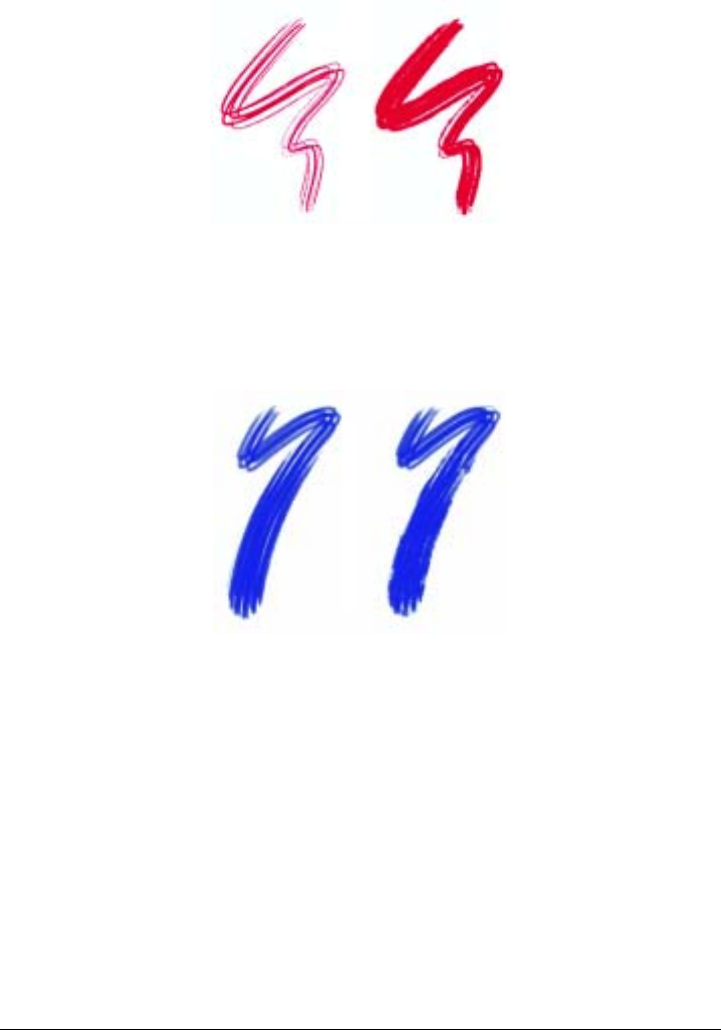
Customizing Brushes 227
The Thickness slider controls the diameter of the individual
bristles. Settings shown are 17% (left) and 87% (right).
The Clumpiness slider applies a random variance to the thickness of each bristle, which
makes some of the bristles look like they are clumping together. Clumpiness is
proportional to Thickness.
.
The Clumpiness slider controls how bristles “clump together.”
Settings shown are 0% (left) and 100% (right).
The Hair Scale slider controls the density of bristles in the brush dab and, therefore,
the number of bristles in the dab.

228 Corel Painter User Guide
The Hair Scale slider controls the density of bristles in the brush
dab. Settings shown are 410% (top) and 990% (bottom).
The Scale/Size slider controls the degree of Size variation applied to the bristles of a
brush. At 0%, there is no size change applied to the bristles. Setting this slider to a
value greater than 0% creates a set of scaled iterations of the dab.
At a Scale/Size setting of 100%, when the brush size changes, the bristles scale in
proportion to the size. At a Scale/Size setting of 8%, when the brush size changes, the
bristles remain a constant absolute size. The Scale/Size control is invalid if a size range
is not specified (that is, if Size Min is set to 100%).
The Scale/Size slider controls the degree of Size variation applied
to a bristle set. Settings shown are 0% (top) and 100% (bottom).
To set bristle thickness
1On the Stroke Designer page of the Brush Creator, click Bristle.
2Move the Thickness slider to the left to reduce the density of the medium left by
the stroke. Move it to the right to increase brush density.

Customizing Brushes 229
When the slider is moved fully to the left, the brush will leave a faint stroke —
even if Opacity is set to 100%.
To set clumping of bristles
1On the Stroke Designer page of the Brush Creator, click Bristle.
2Move the Clumpiness slider to the left to reduce bristle clumping. Move it to the
right to increase bristle clumping.
To set bristle density
1On the Stroke Designer page of the Brush Creator, click Bristle.
2Move the Hair Scale slider to the left to reduce the amount of bristle density and
create a fine-hair brush. Move it to the right to increase density.
To scale bristles according to brush size
1On the Stroke Designer page of the Brush Creator, click Bristle.
2Move the Scale/Size slider to the left to reduce the degree of size variation. Move it
to the right to increase size variation.
Well Controls
The Well controls determine how a brush conveys its medium (color) to the paper. The
Resaturation, Bleed, and Dryout controls work together to determine how much color
a brush has at the start and finish of a stroke. Some Well controls work in conjunction
with Expression settings. For more information about Expression settings, see
“Expression Settings” on page 262.
Brush Loading affects how dab-based brushes interact with underlying pixels. When
Brush Loading is active, brushes can literally “pick up” existing colors, hair by hair.
This capability offers truer color interaction, astounding color-variations smearing, and
better cloning results. For more information about dab-based brushes, see “Dab Types”
on page 205.
When Brush Loading is not active, brushes interact with previously applied colors by
sampling underlying pixels and then loading the brush with one new color — the
average of those colors that were sampled. When you use Brush Loading, it’s best to
use a very low setting for spacing. For more information about spacing controls, see
“Spacing Controls” on page 221.
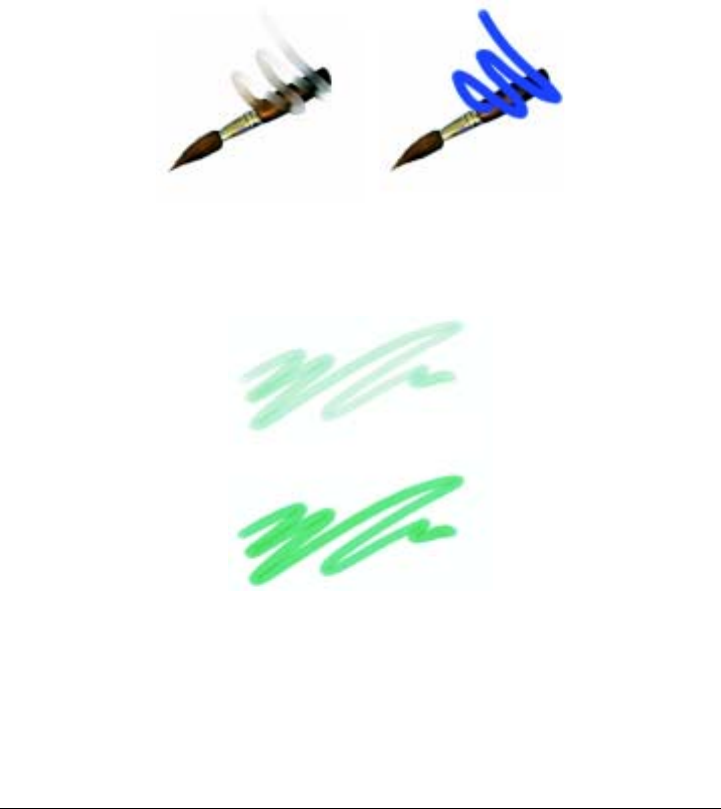
230 Corel Painter User Guide
The Resaturation slider controls the amount of color that is replenished in a stroke. If it
is set at zero, the brush does not produce any color. When Resaturation is less than
10% (and Bleed is less), a brush stroke fades in gently. When the Resaturation slider is
set at zero and Bleed is set high, an airbrush can move underlying colors, as when just
the airbrush hose is used to blow paint around on the canvas.
The Bleed slider controls how much the brush colors smear underlying colors,
including the paper color. When Bleed is higher than resaturation, more color bleeds
than covers, so the stroke never reaches full Opacity.
The Bleed slider controls the amount of underlying color mixed in with
the selected color. Settings shown are 55% (left) and 1% (right).
The Resaturation slider controls the amount of color replenished in
the stroke. Settings shown are 25% (top) and 100% (bottom).
The Dryout control determines how quickly a brush runs out of medium. Dryout is
measured in pixels. Moving the slider to the left makes a brush’s reservoir empty more
quickly. This can produce brush strokes that fade out gently. If Dryout is set high, the
brush never runs out of color.
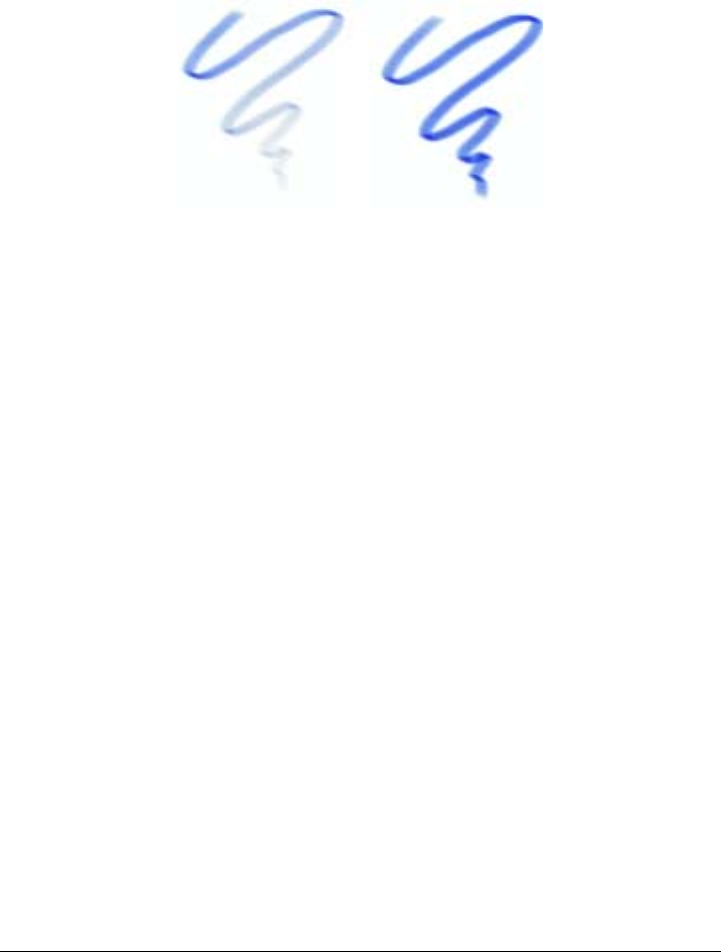
Customizing Brushes 231
Dryout works in conjunction with Bleed, so Bleed must be set above zero if you want
to take advantage of Dryout. You can modulate the Dryout effect by changing the
Bleed setting.
The Dryout slider controls how fast the brush runs out of
medium. Settings shown are 724 (left) and 22026 (right).
To set resaturation
1On the Stroke Designer page of the Brush Creator, click Well.
2Move the Resaturation slider to the left to reduce the amount of color replenished
in a stroke. Move it to the right to increase the amount of color.
To set color bleed
1On the Stroke Designer page of the Brush Creator, click Well.
2Move the Bleed slider to the left to reduce the amount of interaction with
underlying pixels. Move it to the right to increase the interaction.
To set brush dryout
1On the Stroke Designer page of the Brush Creator, click Well.
2Move the Dryout slider to the left to shorten the distance the brush can move
before it dries out. Move it to the right to lengthen the distance.
Rake Controls
The Rake controls lets you control the sophisticated features of a Rake stroke, which
maintains the angle of the brush head as the stroke changes direction. As the brush
turns, bristles come in and out of contact with the painting surface.

232 Corel Painter User Guide
The Contact Ang slider adjusts how much of the brush touches the painting surface —
in other words, the number of rake “tines” that touch the canvas at once.
The Contact Ang controls determine how much of the brush contacts the
painting surface. Settings shown are 180° (left), 125° (middle), and
right=0° (right), with a Brush Scale setting of 450%.
Brush Scale controls the spacing between individual bristles that compose the Rake.
The size of each dab is determined in the Size area of the Stroke Designer page. For
more information, see “Spacing Controls” on page 221.
Brush Scale controls the spacing between individual dabs in
the rake. Higher Brush Scale settings spread the dabs.
Settings shown are 2500% (left) and 0% (right).
When you turn a real brush to paint a curve, bristles at the edges move in and out of
contact with the painting surface, depending on the brush’s location on the curve
(inside or outside). Turn Amount simulates this bristle displacement.
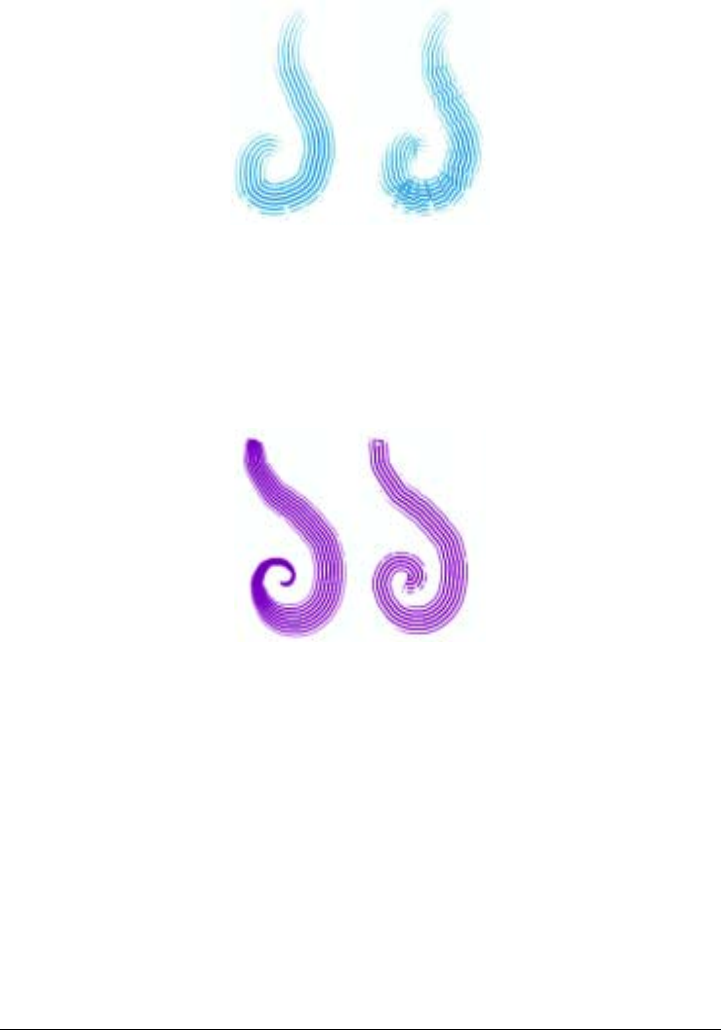
Customizing Brushes 233
The Turn Amount slider controls the displacement of inside and
outside bristles. Settings shown are 0% (left) and 150% (right).
The Bristle controls set the number of bristles or dabs used for Multi and Rake stroke
types.
The Spread Bristles control dynamically adjusts brush scale on the basis of pressure.
The harder you press, the more the brush fans out.
Spread Bristles controls the spacing of bristles, based on stylus pressure. The
harder you press, the more the bristles spread. If you want the spread constant,
disable this option. Enabled (left) and disabled (right) settings are shown.
Soften Bristle Edge makes a brush’s outer dabs semitransparent. This option is
particularly effective when used with Turn Amount.

234 Corel Painter User Guide
Soften Bristle Edge turns the outer dabs semitransparent.
Disabled (left) and enabled (right) settings are shown.
To set brush contact angle
1On the Stroke Designer page of the Brush Creator, click Rake.
2Move the Contact Ang slider to the left to create a low contact angle (few of the
dabs are in contact with the paper). Move the slider all the way to the right to
create a high contact angle (all of the dabs are in contact with the paper).
To set brush scale
1 On the Stroke Designer page of the Brush Creator, click Rake.
2Do one of the following:
• To bring the scale closer to equaling the dab width, move the Brush Scale slider
to the right. When the scale is 100%, the stroke width equals the dab width
multiplied by the number of dabs.
• To cause dabs to overlap, move the Brush Scale slider to the left. When the scale
is less than 100%, the dabs overlap. Overlapping dabs create a natural, subtle
stroke when used with Turn Amount and Soften Bristle Edge.
To set bristle displacement
1 On the Stroke Designer page of the Brush Creator, click Rake.
2Do one of the following:
• To increase the degree to which the displacement changes are based on the
direction of the brush, move the Turn Amount slider to the right.
• To decrease the degree to which the displacement changes are based on the
direction of the brush, move the Turn Amount slider to the left.

Customizing Brushes 235
To set bristle number
1On the Stroke Designer page of the Brush Creator, click Rake.
2Move the Bristle slider to the right to increase, or to the left to decrease, the
number of bristles in the brush.
To set bristle spacing
1On the Stroke Designer page of the Brush Creator, click Rake.
2Enable the Spread Bristles check box.
To soften bristle edge
1On the Stroke Designer page of the Brush Creator, click Rake.
2Enable the Soften Bristle Edge check box.
Random Controls
Corel Painter uses randomness to introduce an “accidental” quality in color and stroke.
Randomness contributes to the appealing, unique look of artwork created in
Corel Painter. You can control brush randomness with settings in the Random area of
the Stroke Designer page. Some Random controls work in conjunction with Expression
settings. For more information about Expression settings, see “Expression Settings” on
page 262.
The Jitter control introduces a randomized jitter to the brush stroke. Instead of
appearing directly along the stroke, dabs appear randomly outside the brush stroke
path.
The Jitter slider creates a randomized jitter in the brush
stroke. Settings shown are 0 (top) and 3.13 (bottom).
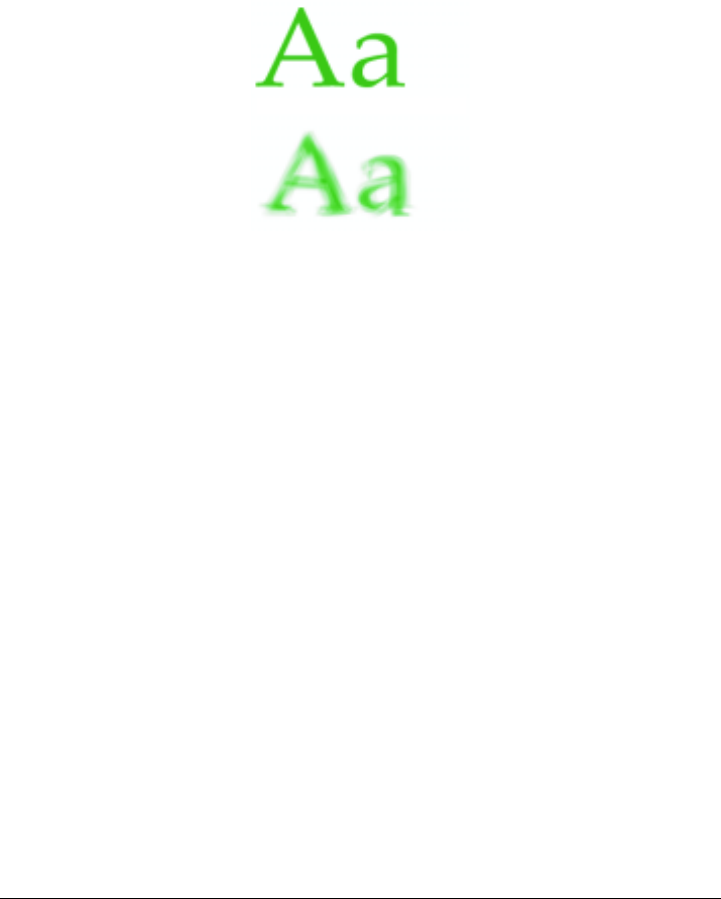
236 Corel Painter User Guide
Both Clone Location sliders work with brushes of the Cloning method. The Variability
control lets you randomly offset the location where the clone brush samples the source.
When Variability is set at zero, the pixels of the source and destination images
correspond precisely — using a cover brush at full Opacity (and no Grain) simply re-
creates the source image.
The Variability slider controls the offset of the clone based on the location
of the source image. Settings shown are 0 (top) and 12 (bottom).
Introducing a degree of randomness disturbs the pixel-to-pixel correspondence. The
resultant variations in the image distance the clone from its photographic source,
which can contribute to a Natural-Media appearance.
The How Often slider controls the period between random offsets.
Normally, when you make a brush stroke, the paper grain is fixed. Strokes repeated
over an area bring out the same grain. The Random Brush Stroke Grain option
randomly moves the paper grain for each dab of each stroke.
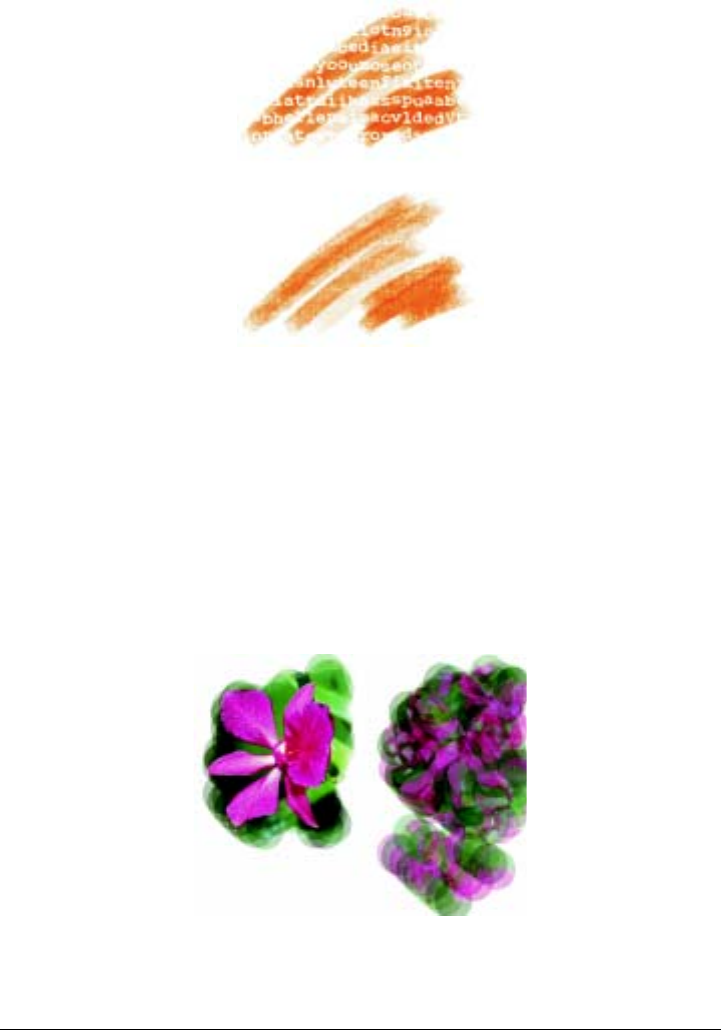
Customizing Brushes 237
The Random Brush Stroke Grain option randomly moves the paper grain for
each stroke. Disabled (top) and enabled (bottom) settings are shown.
Random Clone Source randomly samples the source document and then places strokes
on the clone destination. There is no correspondence between the samples taken from
the source and where they are placed on the clone. The result is a random pattern of
the predominant colors and edges of the source. The brush and stroke determine the
nature of the pattern.
You might use Random Clone Source with a faint stipple brush to add “noise” to an
image. In this case, the clone source image merely contains the “noise” colors you wish
to add.
The Random Clone Source option randomly samples the source
document. Disabled (left) and enabled (right) settings are shown.

238 Corel Painter User Guide
To set Jitter
1On the Stroke Designer page of the Brush Creator, click Random.
2Move the Jitter slider to the left to decrease deviation from the stroke path, or to
the right to increase the deviation.
To set clone location variability
1On the Stroke Designer page of the Brush Creator, click Random.
2Do one of the following:
• To increase the range (distance) that the sample can be offset, move the Clone
Location Variability slider to the right.
• To limit offset so that source and destination images correspond more precisely,
move the Clone Location Variability slider to the left.
Clone location sliders have no effect when Clone Color is enabled in the Colors
palette. They have an effect only when a Clone method is used.
To set the period between random offsets
1 On the Stroke Designer page of the Brush Creator, click Random.
2Do one of the following:
• To offset a greater number of samples and give the clone image a rough,
distorted look, move the How Often slider to the left.
• To offset samples less frequently and keep the clone image more coherent, move
the How Often slider to the right.
The How Often slider controls the period between random
offsets. Settings shown are 0 (top) and 15 (bottom).

Customizing Brushes 239
To choose the Random Brush Stroke Grain option
1On the Stroke Designer page of the Brush Creator, click Random.
2Enable the Random Brush Stroke Grain check box.
To choose the Random Clone Source option
1On the Stroke Designer page of the Brush Creator, click Random.
2Enable the Random Clone Source check box.
Mouse Controls
In theory, a mouse has no pressure information. A mouse button is either “on” (button
down), or “off” (button up). The Corel Painter Mouse controls let you simulate the
following stylus settings: Pressure (how hard you would be pressing with a stylus), Tilt
(how close to vertical the stylus is held), Bearing (the compass direction in which the
stylus is pointing), and Wheel (how much ink is sprayed).
You can record and save brush strokes created with a stylus and then have
Corel Painter use the saved settings for the stroke when you switch to a mouse. Refer
to “Recording and Playing Back Strokes” on page 161 for more information about
using saved brush strokes to further enhance mouse functionality.
To set pressure for the mouse
1On the Stroke Designer page of the Brush Creator, click Mouse.
2 Drag the Pressure slider.
A 100% setting uses maximum pressure.
To set tilt for the mouse
1On the Stroke Designer page of the Brush Creator, click Mouse.
2Drag the Tilt slider.
A 90º setting indicates that if a stylus were in use, it would be perpendicular to the
tablet.
To set bearing for the mouse
1On the Stroke Designer page of the Brush Creator, click Mouse.
2Drag the Bearing slider.

240 Corel Painter User Guide
A setting of zero indicates that if a stylus were in use, it would be pointing left.
To set ink flow for the mouse
1On the Stroke Designer page of the Brush Creator, click Mouse.
2Drag the Wheel slider.
A setting of 100% indicates that maximum flow is in effect.
Cloning Controls
The Cloning controls are specific to cloning method brushes and affect other brushes
only when the Clone Color option is enabled.
The Clone Colorcontrol directs a brush to pick up color from a source image. Clone
Color takes averaged samples of color from the clone source, resulting in an
approximation of the original. The Clone Color option is also available on the Colors
palette. For more information, see “Cloning Color” on page 82.
The Clone Type control lets you choose between several cloning variations. These
variations are arranged according to the number of reference points used. With two or
more reference points, you can apply a transformation (rotate, skew, scale mirror,
perspective) during cloning. For complete information on using the different clone
types, refer to “Cloning Images” on page 273.
The Obey Source Selection option uses any selection in the clone source region to
constrain painting in the destination. If a transform Clone Type is used, the selection is
appropriately transformed. This option is available only with the Cloning method.
When Copy Source Selection is enabled, the Cloner brush reproduces the source
selection information in the destination selection. This option is available only with the
Cloning method.
With the 4-Point Tiling option enabled, your clone source is tiled in a repeating
pattern.
To set Clone Color
1On the Stroke Designer page of the Brush Creator, click Cloning.
2Enable the Clone Color check box.

Customizing Brushes 241
To set Clone Type
1On the Stroke Designer page of the Brush Creator, click Cloning.
2Choose a type from the Clone Type pop-up menu.
To constrain painting in the destination
1On the Stroke Designer page of the Brush Creator, click Cloning.
2Enable the Obey Source Selection check box.
To reproduce the source selection information in the destination selection
1On the Stroke Designer page of the Brush Creator, click Cloning.
2Click the Copy Source Selection check box to enable or disable the option.
To tile clone source
1On the Stroke Designer page of the Brush Creator, click Cloning.
2Enable the 4-Point Tiling check box.
Impasto Controls
Impasto controls let you create brush variants that give the illusion of depth. For more
information about Impasto techniques, see “Impasto” on page 179.
Some Impasto controls work in conjunction with Expression settings. For more
information about Expression settings, see “Expression Settings” on page 262.
There are three Impasto Drawing Methods: Color, which applies only color, Depth,
which applies only depth, and Color and Depth, which applies both color and depth to
the image.
The Depth Methods in Corel Painter use the luminance information in the control
medium to determine how much depth is applied within a stroke. You can use the
Invert and Negative Depth options to affect the stroke’s appearance. For more
information on Depth methods, see “Setting Depth Method” on page 182.
The Depth slider determines how much depth is applied to Impasto brush strokes.
When you set Depth Expression to Pressure and the Invert option is enabled, less
depth is applied as you press harder, just as it would if you were using a real brush. For
more information on painting with depth, see “Creating an Impasto Effect” on
page 180.

242 Corel Painter User Guide
Smoothing controls the transition of the texture applied to a stroke.
Plow controls the degree to which a stroke interacts with other Impasto brush strokes.
In essence, your brush stroke “plows” through existing strokes.
To choose a drawing method
1On the Stroke Designer page of the Brush Creator, click Impasto.
2Choose a drawing method from the Draw To pop-up menu.
To choose a depth method
1On the Stroke Designer page of the Brush Creator, click Impasto.
2Choose a depth method from the Depth Method pop-up menu.
To invert a depth method
1On the Stroke Designer page of the Brush Creator, click Impasto.
2Enable the Invert check box.
To choose the Negative Depth option
1On the Stroke Designer page of the Brush Creator, click Impasto.
2Enable the Negative Depth check box.
To set depth
1On the Stroke Designer page of the Brush Creator, click Impasto.
2Drag the Depth slider to the right to increase depth, or to the left to decrease it.
To set Smoothing
1On the Stroke Designer page of the Brush Creator, click Impasto.
2Move the Smoothing slider to the right to increase the Smoothing effect, or to the
left to decrease it.
To set Plow
1On the Stroke Designer page of the Brush Creator, click Impasto.
2Move the Plow slider to the right to increase the Plow effect, or to the left to
decrease it.

Customizing Brushes 243
Image Hose Controls
The Image Hose controls let you design nozzles designated Rank 1, 2, and 3. Refer to
“Creating, Loading, and Saving Nozzles for the Image Hose” in the Help for more
information.
The settings for each rank consist of the Expression settings plus one additional setting
— Sequential. For more information, see “Expression Settings” on page 262.
Rank 1
The Rank 1control lets you assign an input to locate Rank 1 imagery within an Image
Hose nozzle.
Rank 2
The Rank 2 control lets you assign an input to locate Rank 2 imagery within an Image
Hose nozzle.
Rank 3
The Rank 3 control lets you assign an input to locate Rank 3 imagery within an Image
Hose nozzle.
To choose expression settings for Ranks
1On the Stroke Designer page of the Brush Creator, click Image Hose.
2Choose a setting from each of the Rank pop-up menus.
Airbrush Controls
Airbrush controls adjust Spread, or the amount of media that spreads out as it is
applied, and Flow, or the amount of media that is actually applied. Some Airbrush
controls work in conjunction with Expression settings. For more information about
Expression settings, see “Expression Settings” on page 262.
Spread controls how paint spreads out as it is applied. In other words, it sets the size of
the cone of spread from the tip of the airbrush or spray can. A good range for the
Spread setting is 30% to 40%. Narrow settings for Spread and Angle can cause
problems. Narrow settings for Spread and Tilt can cause paint to be deposited away
from the cursor.

244 Corel Painter User Guide
The Min Spread control determines the smallest amount of paint that can spread out
as it is applied. The Min Spread setting represents a percentage of the Spread setting.
Flow controls how much media is applied by an airbrush stroke. The Flow control acts
like the needle control on a real airbrush. Use the Expression settings on the Stroke
Designer page to tie Flow to the wheel on an airbrush stylus. Because the airbrush dab
types deposit many small dabs to create their spray-paint look, you might need to cut
down on the flow to speed up the airbrush.
The Min Flow control determines the smallest amount of paint flow that can be
applied during a stroke. The Min Flow setting represents a percentage of the Flow
setting.
To set paint spread
1On the Stroke Designer page of the Brush Creator, click Airbrush.
2Move the Spread slider to the left to reduce the amount of spread, or to the right to
increase the amount of spread.
To set minimum paint spread
1On the Stroke Designer page of the Brush Creator, click Airbrush.
2Move the Min Spread slider to the left to reduce the smallest amount of spread
allowed, or to the right to increase the smallest amount of spread allowed.
To set ink flow
1On the Stroke Designer page of the Brush Creator, click Airbrush.
2Move the Flow slider to the left to reduce the smallest amount of media applied
with a stroke, or to the right to increase it.
To set minimum ink flow
1On the Stroke Designer page of the Brush Creator, click Airbrush.
2Move the Min Flow slider to the left to reduce the smallest amount of flow allowed,
or to the right to increase it.

Customizing Brushes 245
Water Controls
Water controls work with Watercolor layers. A Watercolor layer is automatically
created when you apply a stroke with a Watercolor brush. The layer can be edited from
the Layers palette.
Wetness controls the dilution and the spread of paint. As Wetness is increased, the
resulting stroke expands over a larger area, eliminating the appearance of brush hairs.
The Wetness slider controls the dilution and spread of the
paint. Settings shown are 0 (top) and 40 (bottom).
Pickup controls how much dry paint gets picked up during diffusion. Lower values
mean that there is no mixing or leaching of paints. Higher values produce more
leaching.
The Pickup slider controls how much paint gets picked up during
diffusion. Settings shown are 0% (top) and 100% (bottom).
Dry Rate controls the rate at which water dries during diffusion. Lower values cause
greater spread; higher values reduce the amount of spread.
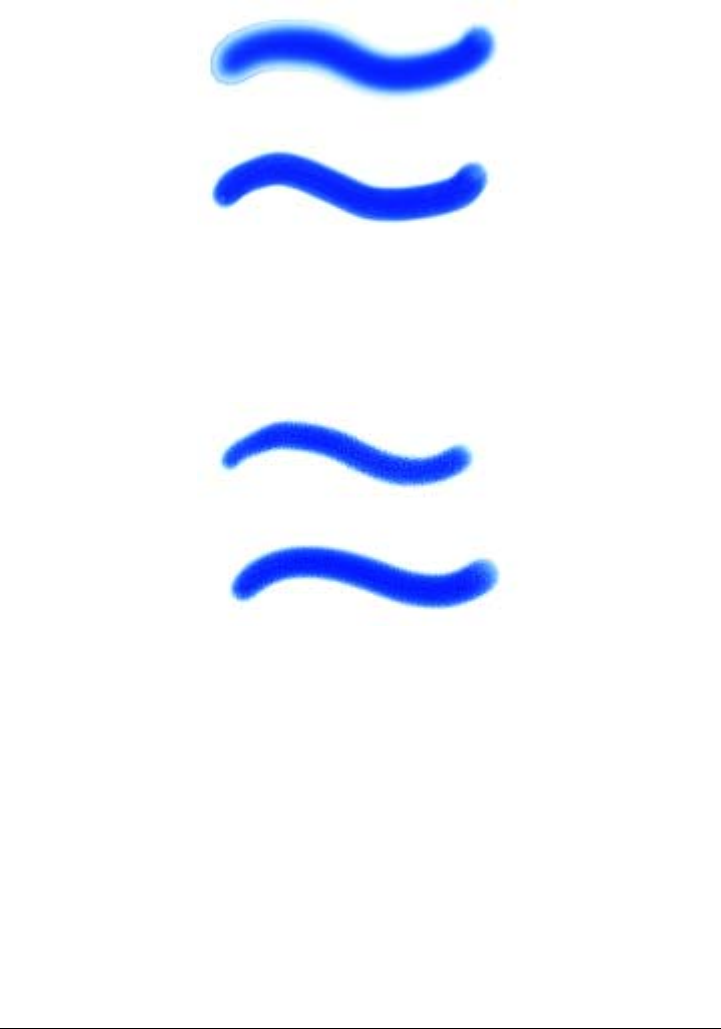
246 Corel Painter User Guide
The Dry Rate slider controls the rate at which water dries during
diffusion. Settings shown are 1% (top) and 50% (bottom).
The evaporation threshold (Evap Thresh slider) controls the minimum amount of
water that can still diffuse. Lower values cause greater spread; higher values reduce the
amount of spread.
The Evap Thresh slider controls the minimum amount of water which
can still diffuse. Settings shown are 1% (top) and 50% (bottom).
The diffusion setting (Diffuse Amt slider) controls the amount of paint diffused. Using
high diffusion creates soft edges that feather into the grain, as though you were
painting on wet absorbent paper. Using low diffusion is similar to painting on dry
paper.
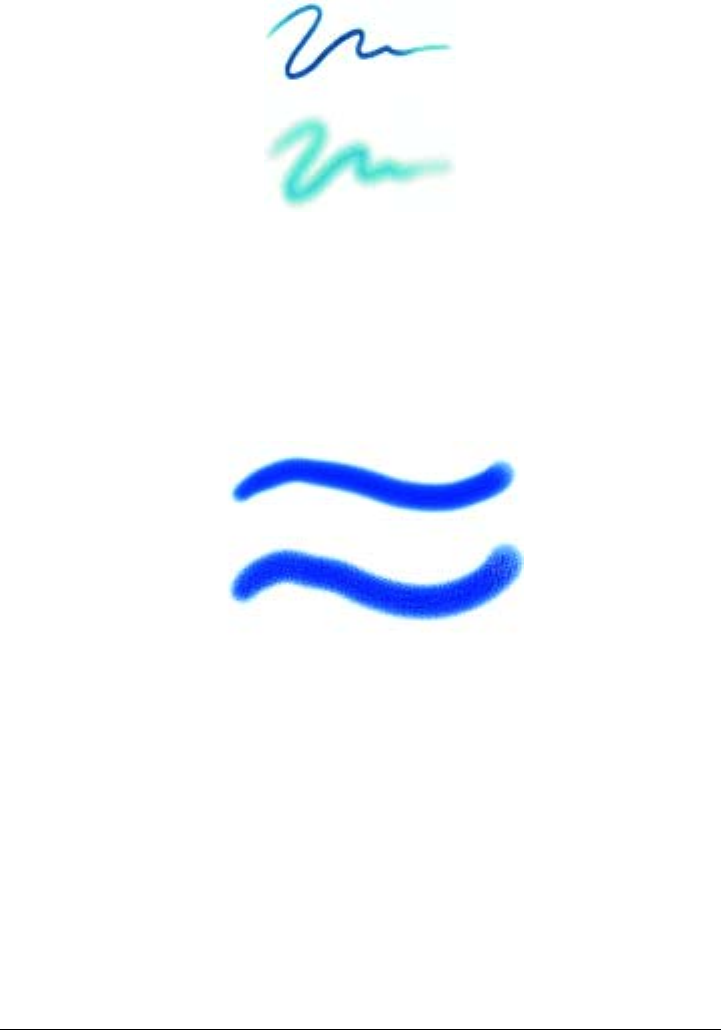
Customizing Brushes 247
The Diffuse Amt slider controls the spread of the stroke.
Settings shown are 0% (top) and 8% (bottom).
The capillary factor (Cap Factor slider) controls the grain’s effect on diffusion. Lower
values result in a smoother edge.
The grain soak-in (Grn Soak-In slider) controls the graininess of soak-in when paint is
drying. You can lower both capillary factor and grain soak-in values to reduce grain
effects.
The Grn Soak-In slider controls the graininess of soak-in when
paint is drying. Settings shown are 0% (top) and 100% (bottom).
Enable the Accurate Diffusion check box to use a smaller diffusion window. Disabling
Accurate Diffusion results in a larger, less accurate window being used.
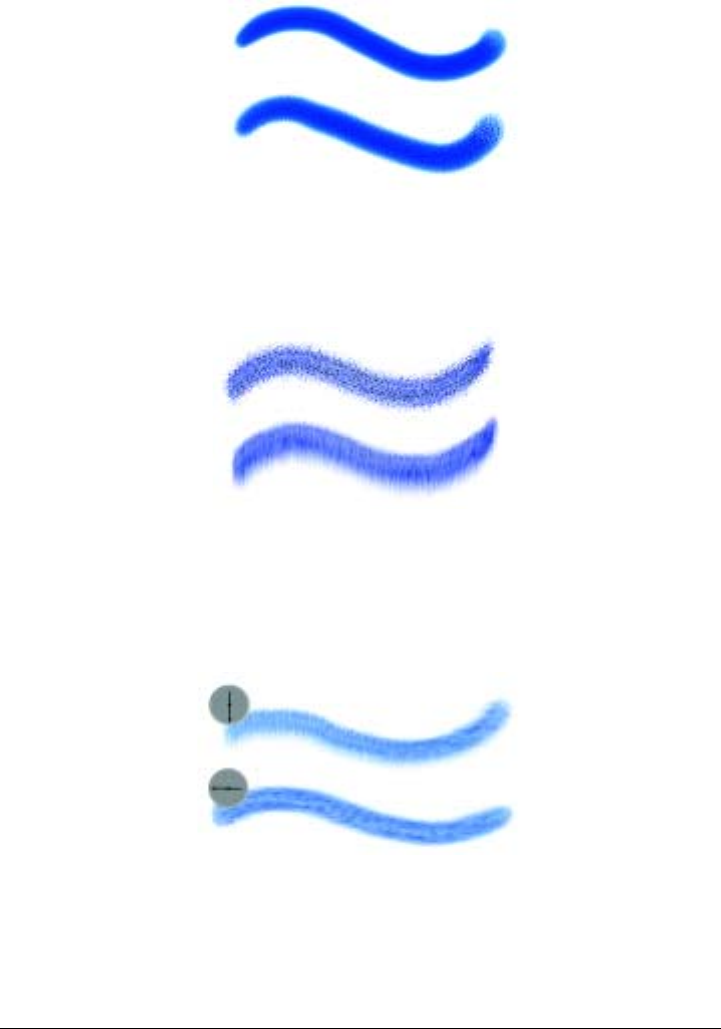
248 Corel Painter User Guide
With Accurate Diffusion enabled, a smaller diffusion window is
used. Enabled (top) and disabled (bottom) settings are shown.
You can specify the amount of wind force exerted on the diffusing particles. Set the
Wind Force slider to zero to turn off directional diffusion.
Wind Force controls the amount of force exerted on diffusing
particles. Settings shown are 0% (top) and 25% (bottom).
You can specify wind direction, which controls the direction in which the particles
diffuse. This can be used to simulate tilting of a wet watercolor image to introduce the
paint migration effects of gravity.
Wind Direction controls the direction in which the particles
diffuse. Settings shown are 270° (top) and 180° (bottom).
To set wetness
1On the Stroke Designer page of the Brush Creator, click Water.

Customizing Brushes 249
2Move the Wetness slider to the left to create a more uniform brush stroke, or to the
right to have the water flow more in the direction of the wind.
To set paint pickup
1On the Stroke Designer page of the Brush Creator, click Water.
2Move the Pickup slider to the right to increase the amount of leaching, or to the
left to reduce it.
To set the dry rate
1On the Stroke Designer page of the Brush Creator, click Water.
2Move the Dry Rate slider to the right to reduce the amount of spread, or to the left
to increase it.
To set the evaporation threshold
1On the Stroke Designer page of the Brush Creator, click Water.
2Move the Evap Threshold slider to the right to reduce the amount of spread, or to
the left to increase it.
To set the diffusion amount
1On the Stroke Designer page of the Brush Creator, click Water.
2Move the Diffuse Amt slider right to create soft edges that feather into the grain,
or to the left to emulate painting on dry paper.
To set the effect of grain on diffusion
1On the Stroke Designer page of the Brush Creator, click Water.
2Move the Cap Factor slider to the right to create rougher edges, or to the left to
create smoother, more continuous results.
To set grain soak-in
1On the Stroke Designer page of the Brush Creator, click Water.
2Move the Grn Soak-In slider to the right to create rougher surfaces, or to the left to
create smoother, more continuous results.
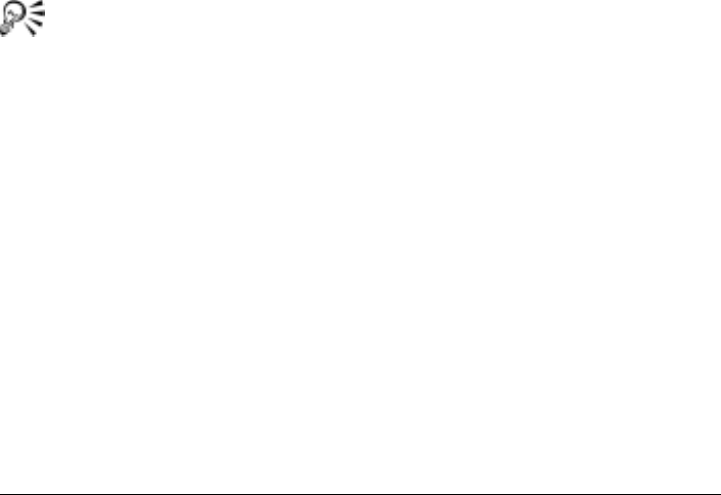
250 Corel Painter User Guide
To set accurate diffusion
1On the Stroke Designer page of the Brush Creator, click Water.
2Click the Accurate Diffusion check box.
To set wind force
1On the Stroke Designer page of the Brush Creator, click Water.
2Move the Wind Force slider to the right to increase wind force, or to the left to
decrease it.
To set wind direction
1On the Stroke Designer page of the Brush Creator, click Water.
2Drag the Wind Direction control to the desired setting.
To delay diffusion
1On the Stroke Designer page of the Brush Creator, click Water.
2Enable the Delay Diffusion check box.
Diffusion begins when you finish the brush stroke.
When you enable the Delay Diffusion check box, you increase the speed of
Watercolor brush variants.
You can also access the Delay Diffusion check box on the Watercolor palette
of the Brush Controls by clicking Window > Brush Controls > Water.
Liquid Ink Controls
Liquid Ink controls work with Liquid Ink layers. Use the Liquid Ink controls to specify
qualities such as type, smoothness, and volume of a brush stroke. You can adjust the
Liquid Ink controls when you have selected a Liquid Ink brush from the Brush Selector
bar. Some Airbrush controls work in conjunction with Expression settings. For more
information about Expression settings, see “Expression Settings” on page 262.
Liquid Ink is divided into two basic properties: Ink and Color. The Ink component
provides the form of the brush stroke, while the Color component applies color to the
Ink form. The Ink and Color components can be used together or controlled
separately.
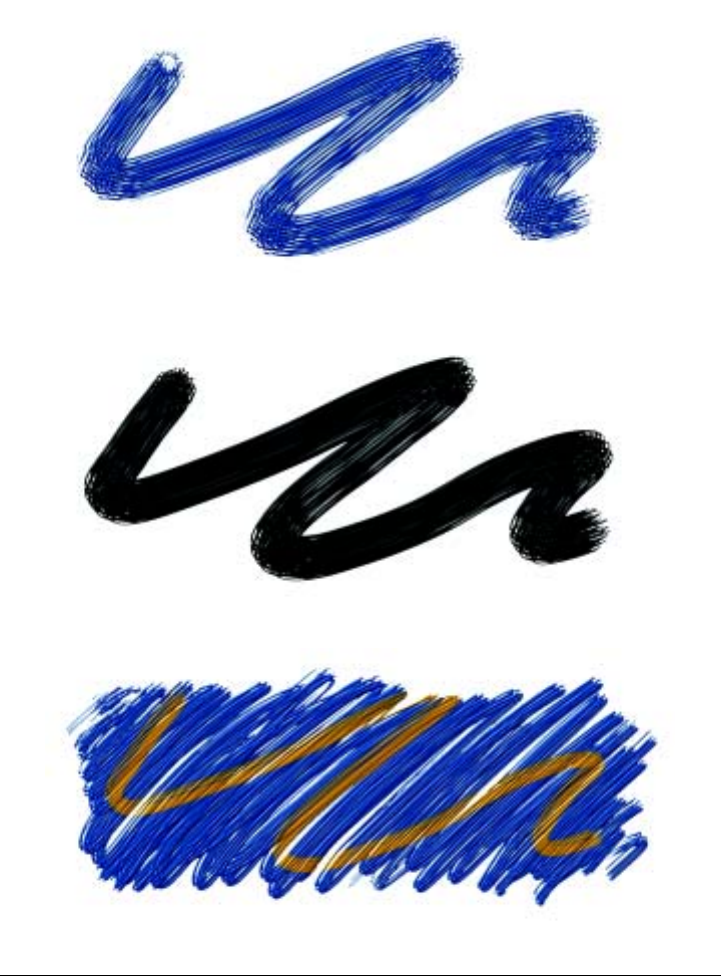
Customizing Brushes 251
You can select from the following Ink types:
• Ink Plus Color applies the currently selected color to the Ink form.
• Ink Only applies only the Ink component.
• Color Only applies only the Color component.
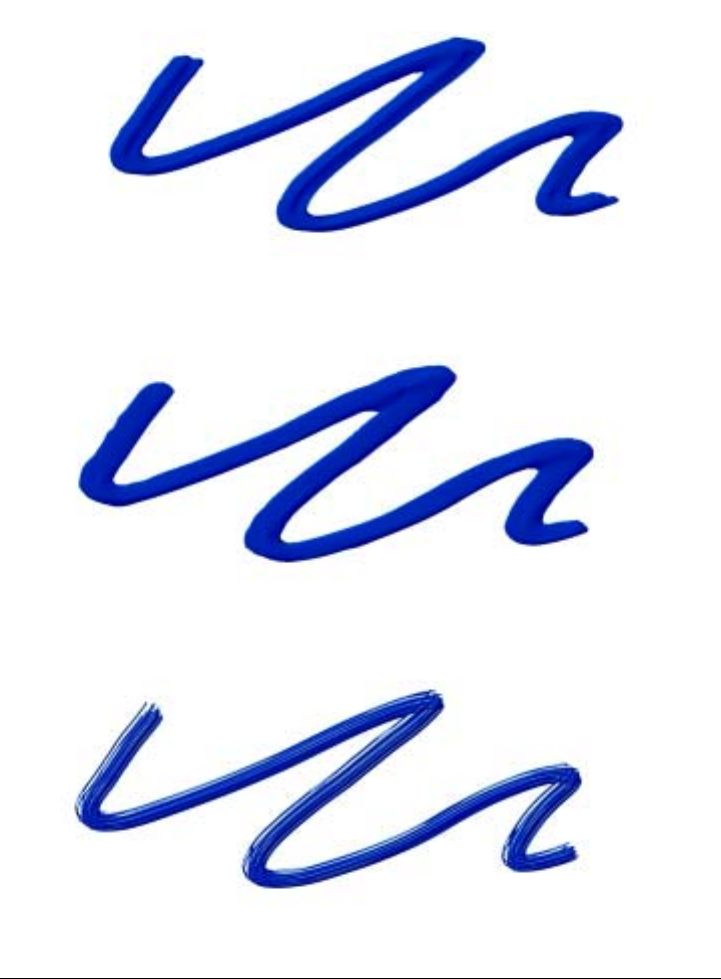
252 Corel Painter User Guide
• Soften Ink Plus Color applies Color to an Ink form, causing inks and colors to blend
into one another.
• Soften Ink Only applies only the Ink component.
• Soften Color Only applies only the Color component.
• Resist repels Ink.

Customizing Brushes 253
• Erase deletes Ink and Color.
• Presoftened Ink Plus Color is applied in conjunction with surface depth effects.
The Smoothness slider controls the “tack” of the brush strokes. Lower values result in
coarser brush strokes. Higher values cause brush strokes to appear smoother.
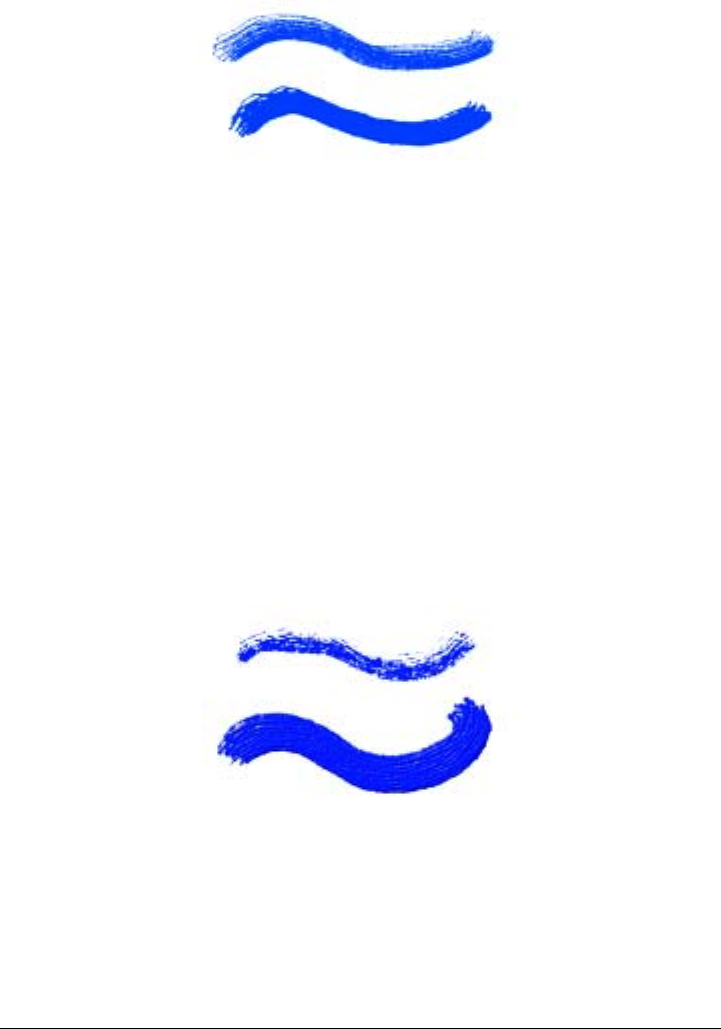
254 Corel Painter User Guide
The Smoothness slider controls the “tack” of brush strokes.
Settings shown are 0% (top) and 100%( bottom).
The Volume slider controls the height of the brush stroke, or the amount of medium
applied to the image. Higher values result in thicker strokes.
The Wheel option in the Expression pop-up menu under the Volume slider allows you
to control the amount of spray from the Liquid Ink airbrush by adjusting the wheel on
the airbrush stylus (especially the Intuos Airbrush Stylus). The wheel on the stylus acts
like a needle control on a real airbrush. Used to control the amount of spray from
Liquid Ink airbrushes when this brush feature is tied to Wheel, adjustments to the
wheel on an airbrush stylus (especially the Intuos Airbrush Stylus) act like a needle
control on a real airbrush.
You can use the Depth controls in the Impasto area of the Stroke Designer to give
Liquid Ink brush strokes the appearance of height. For more information about Depth
controls, see “Impasto Controls” on page 241.
The Volume slider controls the height of the brush stroke.
Settings shown are 100% (top) and 500% (bottom).
The Min Volume slider controls the maximum variation in volume. A value of 100%,
for example, produces no variation in volume during the brush stroke.
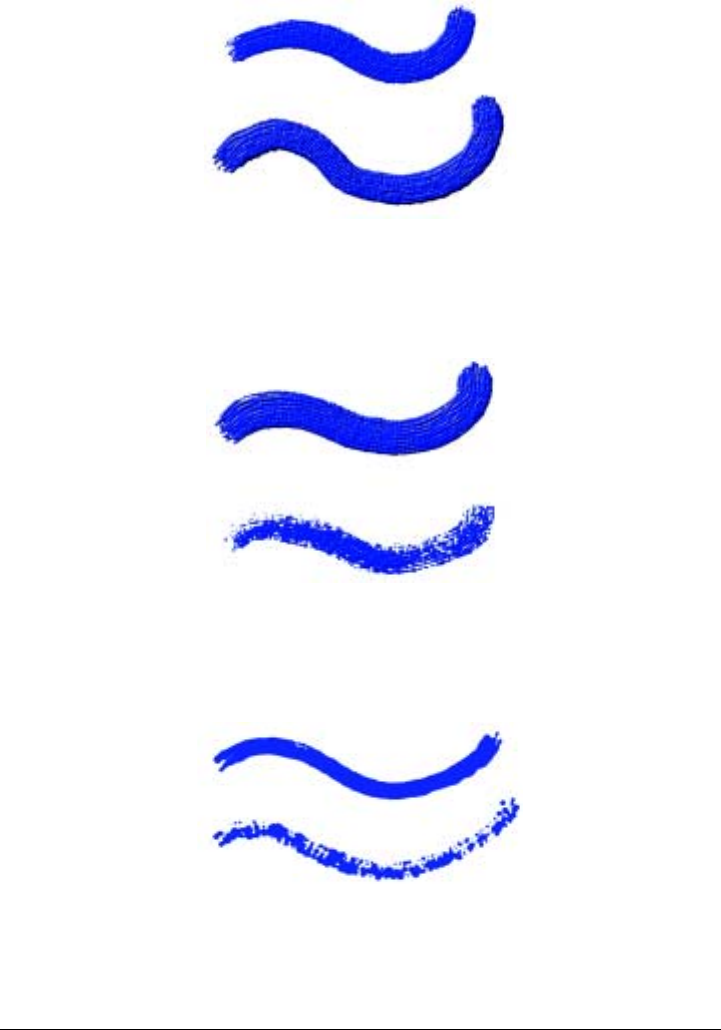
Customizing Brushes 255
The Min Volume slider controls the maximum variation in
volume. Settings shown are 100% (top) and 0% (bottom).
The Rand Vol slider controls the randomness in volume within the brush stroke. A
value of zero results in a perfectly smooth brush stroke.
The Rand Vol slider controls the randomness in volume within the
brush stroke. Settings shown are 0% (top) and 100% (bottom).
The Rand Size slider controls the randomness in size within a brush stroke. A value of
zero results in a perfectly smooth brush stroke.
The Rand Size slider controls the randomness in size within a
brush stroke. Settings shown are 0% (top) and 100% (bottom).

256 Corel Painter User Guide
The bristle fraction (Bristle Frac slider) controls the thickness of the bristles. Higher
values cause the bristles to stick together and result in a smoother brush stroke. Lower
values cause the individual brush strokes to become visible.
The Bristle Frac slider controls the thickness of the bristles.
Settings shown are 3% (top) and 20% (bottom).
The Rand Br Vol slider controls the variation in bristle height. A value of zero signifies
that all of the bristles are of equal height.
The Rand Br Vol slider controls the variation in bristle
height. Settings shown are 0% (top) and 75% (bottom).
The Rand Br Size slider controls the variation in bristle width. A value of zero signifies
that all of the bristles are of equal width.
The Rand Br Size slider controls the variation in bristle
width. Settings shown are 0% (top) and 100% (bottom).
To choose an ink type
1On the Stroke Designer page of the Brush Creator, click Liquid Ink.

Customizing Brushes 257
2Choose a Liquid Ink type from the Ink Type pop-up menu.
To set smoothness
1On the Stroke Designer page of the Brush Creator, click Liquid Ink.
2Adjust the Smoothness slider.
Lower values result in coarse brush strokes. Higher values cause brush strokes to
blend into one another and appear smoother.
To set ink volume
1On the Stroke Designer page of the Brush Creator, click Liquid Ink.
2Adjust the Volume slider.
Higher values result in thicker strokes.
To set maximum variation in volume
1On the Stroke Designer page of the Brush Creator, click Liquid Ink.
2Adjust the Min Volume slider.
If you want volume to respond to stylus pressure, choose Pressure from the
Expression pop-up menu.
To set random volume
1On the Stroke Designer page of the Brush Creator, click Liquid Ink.
2Adjust the Rand Vol slider.
Lower values result in more uniform brush strokes.
To set random size
1On the Stroke Designer page of the Brush Creator, click Liquid Ink.
2Adjust the Rand Size slider.
Lower values result in more uniformly sized brush strokes.
To set bristle fraction
1On the Stroke Designer page of the Brush Creators, click Liquid Ink.
2Adjust the Bristle Frac slider.
Higher values result in strokes in which individual bristles are less visible.

258 Corel Painter User Guide
To set random bristle volume
1On the Stroke Designer page of the Brush Creator, click Liquid Ink.
2Adjust the Rand Br Vol slider.
Higher values result in a greater variation in the length of brush bristles.
To set random bristle size
1On the Stroke Designer page of the Brush Creator, click Liquid Ink.
2Adjust the Rand Br Size slider.
Higher values result in a greater variation in the length of brush bristles.
Digital Watercolor Controls
Digital Watercolor controls let you create effects similar to those of Watercolor brushes
without requiring a separate layer.
The Diffusion slider is used to create soft, feathery edges on the brush strokes. For
more information about diffusion, see “Digital Watercolor Diffusion” on page 172.
The Wet Fringe slider controls the amount of pooling of water and paint at the edges
of Digital Watercolor brush strokes. For more information about wet fringe, see “Wet
Fringe” on page 173.
Artists’ Oil Controls
The Artists’ Oil controls are divided into three critical components: Paint, Brush, and
Canvas. You can control Artists’ Oil brushes’ size and opacity with a tablet expression.
For more information about setting brush size, grain and opacity, see “General
Controls” on page 204. For more information about Expression settings, see
“Expression Settings” on page 262.
The Grain slider on the property bar affects the look of Artists’ Oils by controlling the
level at which paper absorbs paint. When the Grain slider is set to 0%, the paper
absorbs a very limited amount of paint; no paper grain is visible in the stroke and the
paint color appears lighter. When the Grain slider is set to 100%, the paper
completely absorbs the paint; no paper grain is visible, and the paint color appears
darker. Grain is visible with Artists’ Oils when the Grain slider is set between 1% and
99%. As an Artists’ Oils brush runs out of paint, paper grain becomes more visible, so
the the Amount slider also affects how much grain appears.
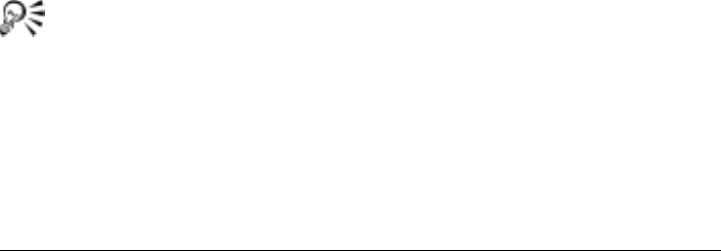
Customizing Brushes 259
Paint
The Amount slider determines how much paint is loaded before each new brush
stroke. The more paint you load, the longer the brush stroke lasts.
The Viscosity slider controls the rate of paint transfer to the canvas. The higher the
viscosity, the faster the brush runs out of paint, creating shorter brush strokes.
The Blend slider controls how the paint color mixes with paint already on the canvas.
High blend levels allow paint on the brush to blend easily with existing paint.
To set the amount of Artists’ Oils paint loaded
1With an Artists’ Oils brush active, click Artists’ Oils on the Stroke Designer page
of the Brush Creator.
2Do one of the following:
• Move the Amount slider to the right to increase the amount of paint loaded for
each brush stroke.
• Move the Amount slider to the left to decrease the amount of paint loaded for
each brush stroke.
To set the viscosity of Artists’ Oils paint
1With an Artists’ Oils brush active, click Artists’ Oils on the Stroke Designer page
of the Brush Creator.
2Do one of the following:
• Move the Viscosity slider to the right to increase the rate at which paint is
transferred to the canvas.
Higher viscosity settings make for a shorter brush stroke.
• Move the Viscosity slider to the left to decrease the rate at which paint is
transferred to the canvas.
You can also set the viscosity of Artists’ Oils on the Viscosity slider on the
Artists’ Oils property bar.
To set Artists’ Oils paint blending
1With an Artists’ Oils brush active, click Artists’ Oils on the Stroke Designer page
of the Brush Creator.
2Do one of the following:
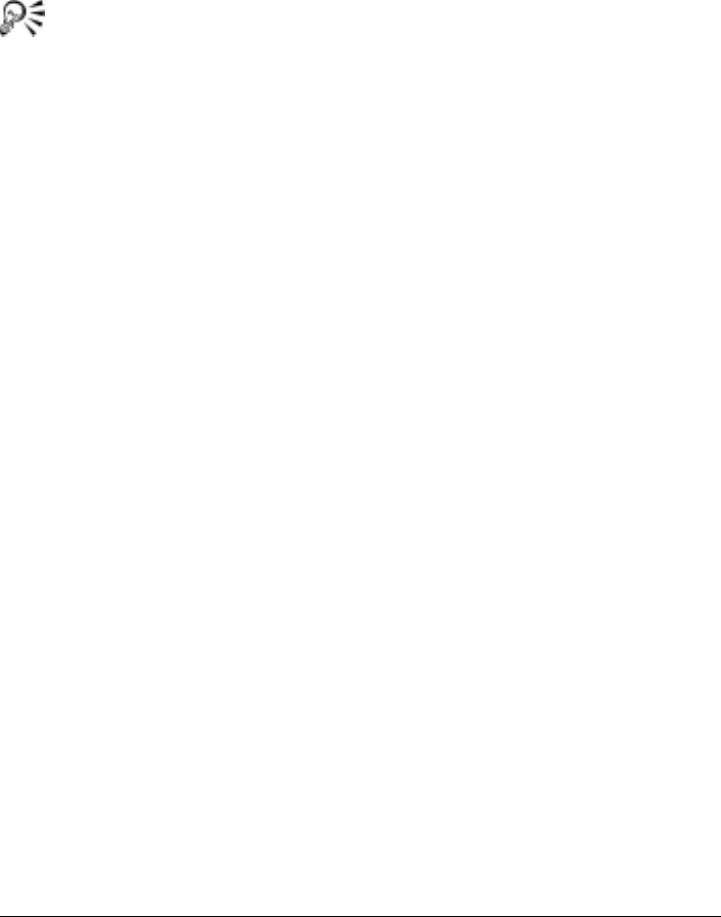
260 Corel Painter User Guide
• Move the Blend slider to the right to increase the blending of brush stroke paint
and existing paint.
• Move the Blend slider to the left to decrease the blending of brush stroke paint
and existing paint.
You can also set how Artists’ Oils paint blend on the Blend slider on the
Artists’ Oils property bar.
Brush
The Bristling slider controls the amount of bristling at the tail and tip of a brush
stroke. The farther to the right you move the slider, the more irregular the bristling.
The Clumpiness slider controls brush bristle fineness. The farther to the right you
move the slider, the greater the amount of brush hair variation, or clumpiness.
The Trail-off slider determines the length of a brush stroke tail when the brush is
running out of paint. This doesn’t change the length of the brush stroke, just the look
of the end of the stroke. The farther to the right you move the slider, the longer the
trail-off of the brush stroke tail.
To set Artists’ Oils brush bristling
1With an Artists’ Oils brush active, click Artists’ Oils on the Stroke Designer page
of the Brush Creator.
2Do one of the following:
• Move the Bristling slider to the right to increase the length of the bristling and
the tip and tail of the brush stroke.
• Move the Bristling slider to the left to decrease the length of the bristling and
the tip and tail of the brush stroke.
To set Artists’ Oils brush stroke trail-off
1With an Artists’ Oils brush active, click Artists’ Oils on the Stroke Designer page
of the Brush Creator.
2Do one of the following:
• Move the Trail-off slider to the right to increase the length of brush stroke
trail-off.
• Move the Trail-off slider to the left to decrease the length of brush stroke
trail-off.
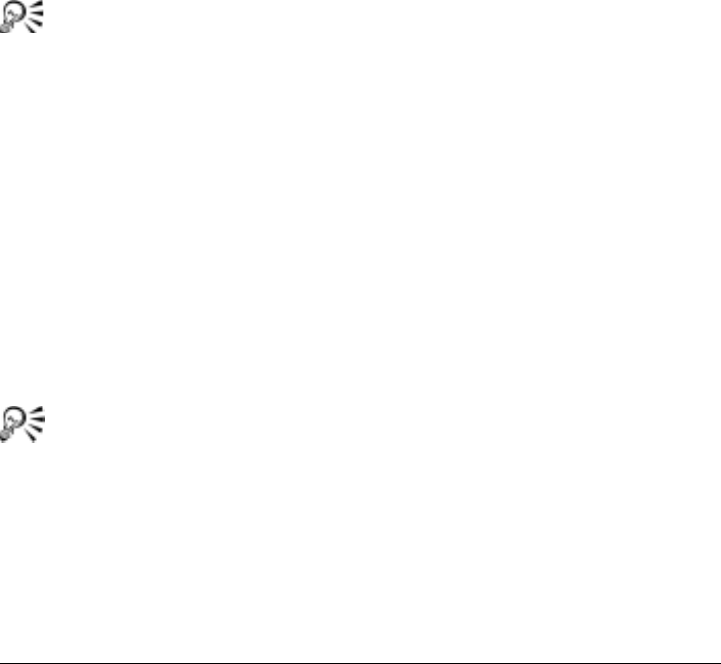
Customizing Brushes 261
Canvas
The Wetness slider determines the wetness of the paint on the canvas. This affects how
paint from a brush stroke interacts with paint already on the canvas.
To set canvas wetness for Artists’ Oils
1With an Artists’ Oils brush active, click Artists’ Oils on the Stroke Designer page
of the Brush Creator.
2Do one of the following:
• Move the Wetness slider to the right to increase the mixing of brush stroke
color and existing color.
• Move the Wetness slider to the left to decrease the mixing of brush stroke color
and existing color.
You can also set how Artists’ Oil paints blend on the Blend slider on the
Artists’ Oils property bar.
Painting in Dirty Mode
Painting in Dirty Mode allows you to further replicate the experience of using artists’
oil paints in the real world. In this mode, any paint remaining on the brush upon
completion of a brush stroke is left to interact with paint loaded for the next brush
stroke. When you select another color, the brush is cleared of remaining paint.
To paint in Dirty Mode
1With an Artists’ Oils brush active, click Artists’ Oils on the Stroke Designer page
of the Brush Creator.
2Enable the Dirty Mode check box.
You can also enable the Dirty Mode check box on the Artists’ Oils property
bar.
Color Variability Controls
The color variability controls in the Brush Creator are identical to those on the
Color Variability palette. For more information, see “Setting Color Variability” on
page 100.

262 Corel Painter User Guide
Color Expression Controls
The color expression controls in the Brush Creator are identical to those on the
Color Expression palette. For more information, see “Setting Color Expression” on
page 103.
Expression Settings
Corel Painter lets you control brush effects along the stroke based on a number of
real-time input factors. For example, many brushes vary their Opacity or Size in
response to changes in stylus pressure. These responses reflect their default settings.
You can use the Expression settings on the Stroke Designer page to vary these effects
in response to other factors, such as stroke direction or velocity.
Expression settings are linked to the individual controls on the Stroke Designer page:
General, Size, Angle, Well, Random, Impasto, Airbrush, and Liquid Ink.
The Direction slider below the Expression pop-up menu adjusts the angle value of the
Direction controller. When the Expression pop-up menu is set to Direction, it specifies
the angle at which a brush stroke narrows or widens, which is particularly useful for
calligraphic effects.
To choose an Expression setting
1On the Stroke Designer page of the Brush Creator, click a control that contains
Expression settings.
2Choose one of the following options from the Expression pop-up menu:
• None applies no adjustment to the brush feature.
• Velocity adjusts the brush feature based on the dragging speed. Dragging
quickly minimizes the setting; dragging more slowly increases it.
• Direction adjusts the selected brush feature based on the direction of the stroke.
• Pressure adjusts the brush feature based on stylus pressure. Greater pressure
increases the setting for that brush feature.
• Wheel adjusts the brush feature based on the wheel setting on an airbrush
stylus, specifically the Intuos Airbrush stylus. The maximum value is set when
the wheel is pushed all the way forward. The minimum is set when the wheel is
pushed all the way back.
• Tilt adjusts the brush feature based on the angle of the stylus from the tablet.
For example, when the stylus is perpendicular to the tablet, Tilt is set at zero.
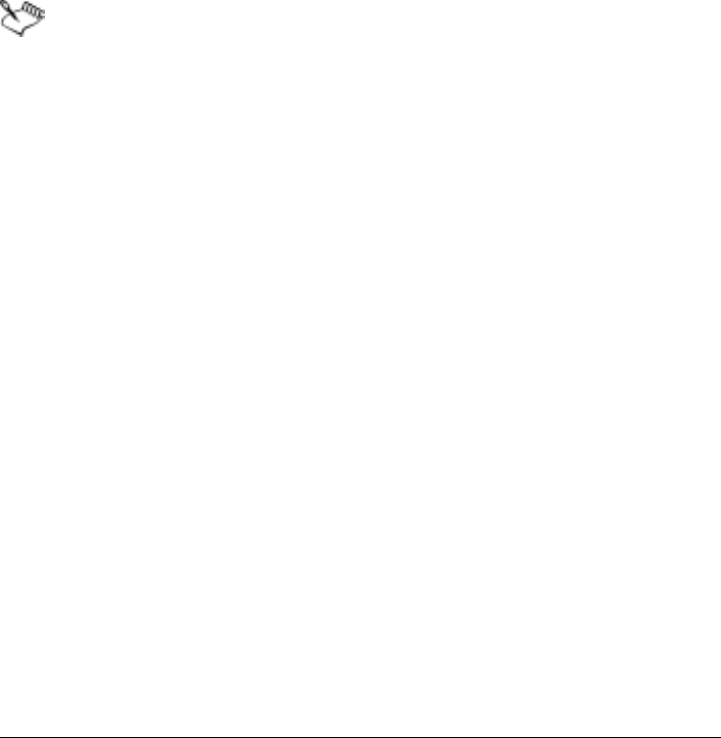
Customizing Brushes 263
• Bearing adjusts the brush feature according to the direction in which the stylus
points.
• Source adjusts the brush feature according to the luminance of the clone source.
Higher luminance (closer to white) increases the setting for that component,
producing, for example, a wider stroke.
• Random adjusts the brush feature on a random basis.
• Sequential applies only to Rank settings for Image Hose brushes. When
enabled, this feature picks out nozzles from the index, in order.
3If you like, enable the Invert check box beside the Expression pop-up menu to
reverse the effect of the Expression setting.
Not all stylus models convey tilt or bearing information.
To set controller direction
1On the Stroke Designer page of the Brush Creator, click a control that contains
Expression settings.
2Choose Direction from the Expression pop-up menu.
3Drag the Direction slider until the desired angle is achieved.
Managing Custom Brushes
After you’ve customized a variant, you can use it immediately. In fact, adjusting
brushes as you paint is something you’ll probably do often. Changes you make to
brush variants are saved until the Restore Default Variant command is selected.
Saving Brush Variants
If you want to keep a customized version of a brush variant, Corel Painter lets you do it
as a new variant or as a Look. Variant settings are included when you save a Look, but
Looks also include paper texture, pattern, gradient, and nozzle data. Refer to “Saving a
Brush Look” on page 267 for more about saving the combined look of a variant.
It’s easier to find a variant when the variant list is short. You can manage the number
of variants in a Brush category by creating new categories in which to save the variants
you create.

264 Corel Painter User Guide
To save current settings as a custom variant
1Do one of the following:
• On the Tracker palette, choose the variant you want to save, click the Tracker
palette menu arrow, and choose Save Variant.
• From outside of the Brush Creator, click the selector menu arrow on the Brush
Selector bar and choose Save Variant.
• From within the Brush Creator, choose Variant menu > Save Variant.
2In the Save Variant dialog box, type a name for the new variant.
The name can have up to 23 characters.
3 Enable the Save Current Colors check box if you want the current main and
additional colors saved with the variant.
If a variant uses the Clone Color option, it is not necessary to enable Save Current
Colors.
Your new variant appears on the variant menu, in the current brush category. A
new XML file is created in the Brushes category folder.
To return the current brush variant to default settings
1Choose the brush variant from the Brush Selector bar.
2Click the selector menu arrow and choose Restore Default Variant.
Choose Restore All Default Variants to reset settings for all brush variants that you
may have adjusted.
To delete a brush variant
1Choose the brush variant from the Brush Selector bar.
2Click the selector menu arrow, and choose Delete Variant.
3Click Yes to delete the variant.
The variant’s related XML file is deleted from the Brushes category folder.
Copying Variants Between Brush Categories
If you create a brush variant and then decide that you want it in a different brush
category, you can copy it there. After copying, you can then delete the original.

Customizing Brushes 265
To copy a variant to a different brush category
1Choose the brush variant you want to copy from the Brush Selector bar.
2Click the selector menu arrow, and choose Copy Variant.
3In the Copy Variant dialog box, choose the destination brush category from the
pop-up menu.
The brush variant is copied to the selected category. (Remember to delete the
variant in the category from which it was copied.)
You can also copy brush variants at the root of the category folder by copying
the XML files to the desired category. Use this method to save time when you
need to copy multiple files.
Capturing Brush Dabs
You can create your own brush dab shapes. Any shape is possible.
When you’ve created a shape you like, select and capture it.
To create a brush dab shape
1On a white background, draw a brush shape in black.
Use shades of gray to define what you wish to be partially transparent areas of the
brush.
To follow stroke direction, a captured brush set must face toward the right side.
2Choose the Rectangular Selection tool from the toolbox .
3Drag across your brush shape to create a square selection.
Corel Painter uses the selected area to map brush size. When the brush is created,
this area is sampled to compute each brush dab.
When the original area must be scaled to the size of the brush dab, sampling can
appear aliased. The greater the scaling, the more aliasing is apparent. To prevent
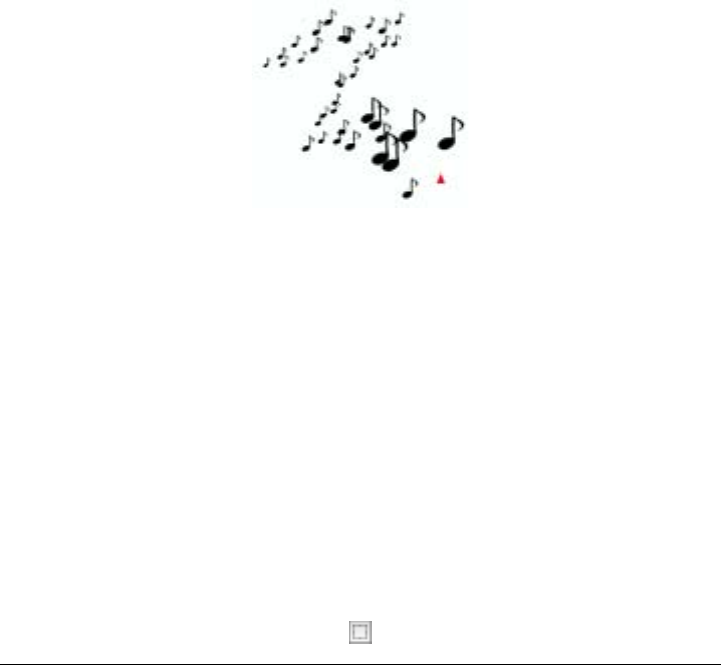
266 Corel Painter User Guide
too much aliasing from appearing, create a shape with soft (grayscale) edges that is
close to the size you’ll be using.
4On the Brush Selector bar, choose the brush category in which you want to save the
variant for the captured dab shape.
5Click the selector menu arrow, and choose Capture Dab.
6On the Stroke Designer page of the Brush Creator, click Size to see the captured
brush dab.
7If necessary, change the Size, Squeeze, and Angle settings.
8Draw with the brush on the canvas.
If you like the results you’ve captured, you can save the brush as a new variant. For
information on how to save brush customizations for later use, see “Saving Brush
Variants” on page 263.
You can paint with a captured brush just as you would with other brushes.
Creating a New Brush Category
The brushes that appear as icons on the Brush Selector bar are really categories for
collections of similar variants. You can add your own brush categories to the Brush
Selector bar.
You might want to create a brush category if you’ve customized a medium and you
want to keep its related tools organized.
To create a new brush category
1Draw a small image to use as the icon for the new brush.
This icon will appear on the Brush Selector bar with the default brush category
icons.
2Choose the Rectangular Selection tool from the toolbox.

Customizing Brushes 267
3Drag across the image to create a square selection.
4Do one of the following:
• On the Brush Selector bar, click the selector menu arrow, and choose Capture
Brush Category.
• In the Brush Creator, choose Brush menu > Capture Brush Category.
5Type a name in the Capture Brush dialog box.
Your new brush and its icon now appear on the Brush Selector bar.
Saving a Brush Look
A Look is a brush variant that has a paper texture, pattern, gradient, or nozzle assigned
to it. A brush variant is not itself associated with data about underlying texture or
other elements. The Look, on the other hand, is associated with additional data about a
particular variant. Regardless of a document’s current libraries, when you select a
Look, you use the elements that are part of that look. If the specific libraries are not
available, Corel Painter prompts you to locate them.
You can save a Look so that you can use it later. A saved Look keeps all variant
settings, plus the paper, pattern, gradient, or nozzle settings.
To save a Brush Look
1Open or create an image, click the Rectangular Selection tool, and select a square
portion of the image.
The selected area will be the icon that appears in the Look Selector for your new
Look.
2With the image selected, click the Brush tool in the toolbox.
3Ensure that all settings for your new Look are satisfactory.
4In the toolbox, click the Look Selector menu arrow, and choose New Look.
5In the New Look dialog box, type a name for your new Look, and click OK.
6Choose Select menu > None to deselect the icon image.
Your new Look appears as the last item in the Look Selector.

268 Corel Painter User Guide
Saved Looks appear in the Look Selector in the toolbox.
In the case of the Image Hose brush, the Look may have a particular nozzle file
attached. For more information about working with the Image Hose and Nozzle files,
refer to “Getting Started with the Image Hose” on page 193.
To use a saved Look
1In the toolbox, choose a look from the Look Selector.
Corel Painter loads the correct variant and materials for the saved Look.
2Paint in the document window.
Using Brush and Look Libraries
Corel Painter comes with several brush libraries. You can also create new libraries for
brushes and Looks and add your custom brushes to them. You can create as many
brush libraries as you need.
Library features are identical for all resource types (Papers, Brushes, Looks, Patterns,
Gradients, Weaves, Scripts, Layers, and Selections). For more information on Library
features, refer to “Libraries and Movers” in the Help.
It’s a good idea to limit the number of tools in a library. This makes it easier to find a
particular tool and helps Corel Painter manage memory.
Corel Painter loads brushes into memory when you launch it, so adding variants to the
default brush library increases the program’s need for RAM. To improve efficiency, you
can organize new brushes into secondary libraries. When you want a different brush
set, you can just switch libraries.

Customizing Brushes 269
When Corel Painter starts, it references a folder (called “Brushes”) in the user
folder. Any customizations made to brushes are saved to this folder and are
referenced by Corel Painter in place of the original default brushes and
settings that are stored in the application folder. The user’s brush library is
built by recalling the information stored in the user folder and supplementing
it with the noncustomized brushes and settings stored in the application
folder.

Don Seegmiller teaches senior-level illustration, traditional head painting, figure drawing, and
digital painting for the Department of Visual Design at Brigham Young University. His traditional
oil painting work has been represented by many major art galleries across the nation, and he has
written a book on digital painting, Digital Character Design and Painting (2003).
Art by Don Seegmiller: Concept character painting
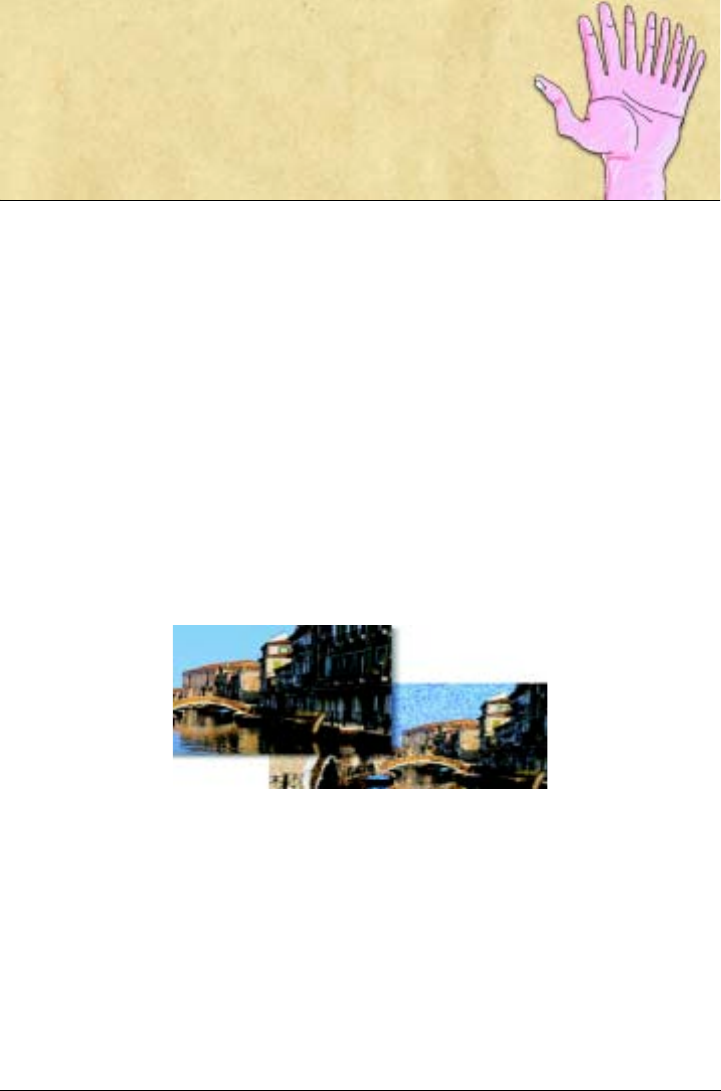
Cloning and Tracing 273
Cloning and Tracing
Cloning can help you create art quickly and easily. Cloning is the process of taking an
image from one area or document (the source) and re-creating it in another area or
document (the destination).
Cloning is a two-step process: First, you set a clone source; then, you work in a
destination area. The source and destination can be in separate documents or in
different areas of the same document.
Cloning Images
Using a cloning-method brush variant is the most common way to develop an image
in a clone destination. The variant re-creates the source image while it effectively
“filters” it, reproducing it in an artistic style, such as pastel chalk or water color.
Cloning allows you to “filter” source images to create Natural-Media renderings.
Advanced, multipoint cloning lets you transform (rotate, scale, slant, or apply
perspective to) an image as you clone it. Corel Painter offers other interesting ways to
take advantage of clone source–destination relationships, such as the Corel Painter
imaginary “light box” method provided by the Tracing Paper feature. Because cloning
can be simple or complex, this chapter begins with basics and then progresses to
advanced cloning techniques.
You can also use the Quick Clone effect automatically sets up everything you need to
clone an image. For more information, see “Using Quick Clone” on page 277.

274 Corel Painter User Guide
Cloning a Document
One way to use the Corel Painter cloning feature is to clone an entire file, creating a
clone source–destination relationship between two documents. The clone of the file is
more than a copy. It maintains a pixel-for-pixel correspondence with its source
document. For this reason, the source must remain open while you work in the clone.
Here are some ways to take advantage of a clone source–destination relationship:
• Trace the source image by using Tracing Paper (the “light box” method). Refer to
“Using Tracing Paper” on page 275 for more information.
• Paint a source image into a destination area by using cloner brushes (Cloners). Refer
to “Painting in the Clone” on page 278 for more information about painting with
cloner brushes.
• Load a brush with color taken from a clone source. Refer to “Cloning Color” on
page 82 for more information.
• Create a mosaic or tessellation by using a source image. Refer to “Mosaics” on
page 307.
• Add three-dimensional effects after setting up a clone source–destination
relationship.
• Control brush features for painting by using variant settings from the source
image.
• Develop a selection or channel. Refer to “Selections” and “Alpha Channels” in the
Help.
To clone a document
1Open the image file you want to clone.
This file is the clone source. A good clone source contains a well-defined image.
2Choose File menu > Clone.
Corel Painter creates a duplicate, or clone, of the source document. The clone
appears in its own document window, with the words “Clone of” preceding the
source document’s name in the title bar.
If a source document has layers, cloning creates a fully composited copy —
that is, all layers in the image are dropped automatically. This aspect of
cloning lets you to flatten an image for faster printing.
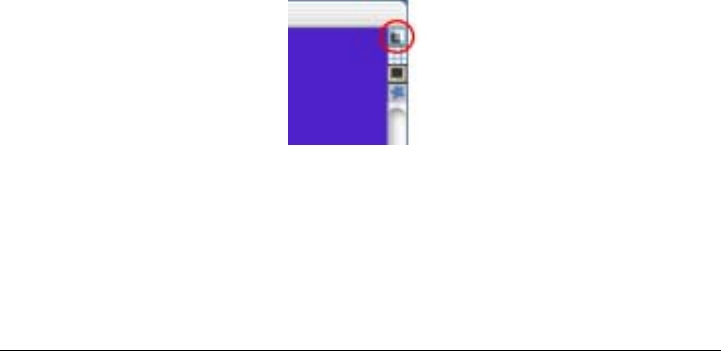
Cloning and Tracing 275
Using Tracing Paper
You can use cloning to help you trace the source image by using Tracing Paper, the
on-screen “light box” in Corel Painter. To use Tracing Paper, the source and clone
documents must be the same size. When Tracing Paper is in use, you see a faded-out
version of the clone source, as if it were displayed under real tracing paper on top of a
light box.
As you trace, brush strokes appear at 50% opacity. When you finish tracing and turn
Tracing Paper off, the faint source image disappears, and your brush strokes appear at
100% opacity.
To trace an image
1Choose File menu > Clone to create a clone of the original document you wish to
trace.
2Choose Select menu > All.
3Press Delete (Mac OS) or Backspace (Windows) to clear the entire canvas.
4Do one of the following:
• Click the Tracing Paper icon in the vertical scroll bar.
• Choose Canvas menu > Tracing Paper.
• Press Command + T (Mac OS) or Ctrl + T (Windows).
A 50% ghost of the source image shows through the tracing paper.
5Trace over the image using any Corel Painter brush variant.
Brush strokes appear at 50% opacity when Tracing Paper is turned on.
Click the Tracing Paper icon to toggle tracing paper on and off.
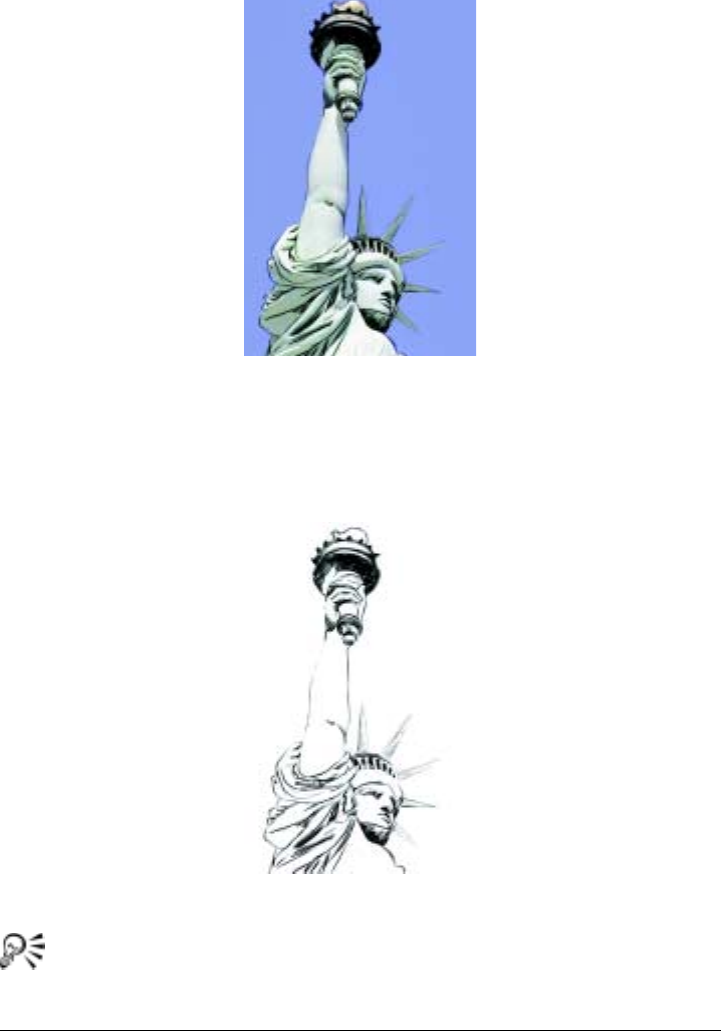
276 Corel Painter User Guide
Use the Tracing Paper feature to view the clone source for tracing.
To turn Tracing Paper off
•Click the Tracing Paper icon again.
The faint source image disappears, and brush strokes appear at 100% opacity.
When you turn Tracing Paper off, you can see what you’ve traced.
You can also turn Tracing Paper on or off by choosing Canvas menu > Tracing
Paper or pressing Command + T (Mac OS) or Ctrl + T (Windows).

Cloning and Tracing 277
To resume tracing
•To resume tracing, turn Tracing Paper back on.
The faint source image returns, and you can continue tracing.
Changing Clone Source
For more flexibility in setting up cloning relationships, Corel Painter lets you set any
open document as a clone source. You can do this to reestablish a source–destination
relationship between two files. You might also do this to choose a special source image
for controlling an image effect.
To set an open document as the clone source
•Choose File menu > Clone Source, and select which of the open documents is the
clone source.
If you forget which document is the clone source, choose File menu > Clone
Source. The filename with a check beside it is the clone source.
To make an open file the clone source for the next file you open
1Hold down Option (Mac OS) or Ctrl (Windows).
2Choose File menu > Clone.
3In the Open dialog box (Mac OS) or Select Image dialog box (Windows), choose a
file to use as the clone destination.
Using Quick Clone
The Quick Clone effect automatically sets up everything you need to clone an image.
Quick Clone can create the clone image, delete its contents, turn on Tracing Paper, and
select the last Cloner brush you used.
To clone using Quick Clone
1Choose File menu > Quick Clone.
2Trace over the image using any Corel Painter brush variant.
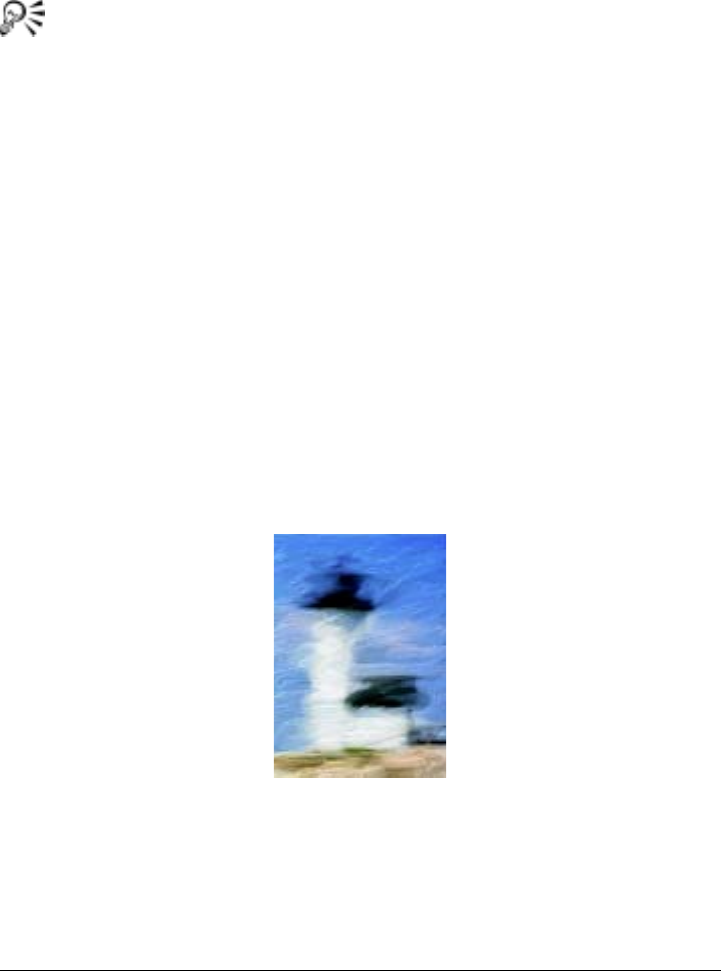
278 Corel Painter User Guide
If you have enabled the Switch to Cloner Brushes check box in the Preferences
dialog box, the last Cloner brush you used is automatically selected.
You can customize the Quick Clone effect. You can choose whether to delete
the image from the clone or to turn on Tracing Paper. You can also select the
last-used Cloner brush or choose to clone color with any brush variant. For
more information, see “Setting Quick Clone Preferences” on page 33.
Using Cloner Brushes
Painting with a cloner brush is similar to painting with any Corel Painter tool, except
that cloner brush variants take their color information from a clone source instead of
from the Colors palette. Some cloner brush variants reproduce a source image directly.
Other cloner brush variants reproduce a source image with low opacity and soft edges,
or use paper grain and specialized dabs, for particular media effects.
Painting in the Clone
When you paint with a cloner brush, it picks up color from the clone source while you
control the size and direction of brush strokes. Painting with a cloner brush is a great
way to obtain Natural-Media renderings from photographic source material.
The Oil Brush Cloner is just one of many interesting cloner brush variants.
You can create new cloner brushes or refine existing cloner brush variants by using the
Brush Creator. For more information about customizing brushes, refer to
“Customizing Brushes” on page 197.
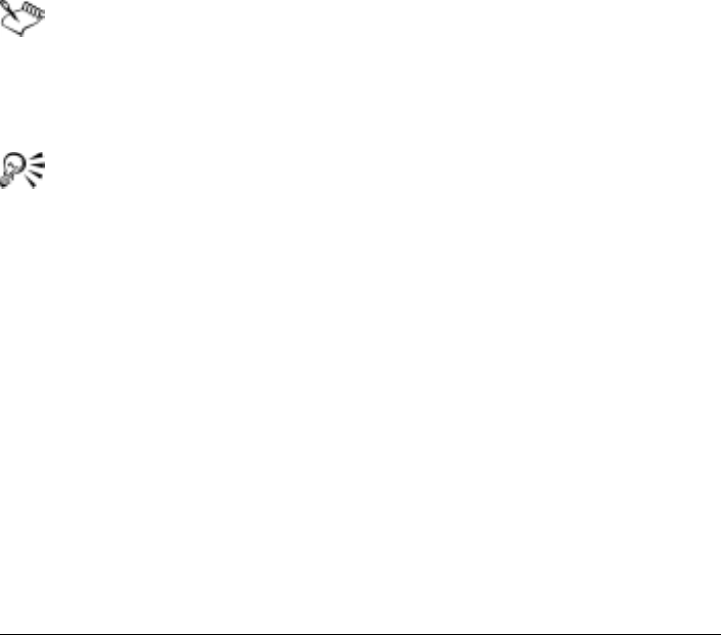
Cloning and Tracing 279
The Corel Painter brushes that use buildup methods, like pencils and felt pens, build
toward black. If you clone with one of these brushes in a dark area of your image, you
may not achieve the desired results. You can use the Opacity pop-up slider on the
property bar to control how rapidly these brushes build up to black. You can also
choose chalk or one of the other tools that cover underlying colors.
To paint with cloner brushes
1Create a clone of the document you wish to paint.
2With the clone selected, choose Select menu > All.
3Press Delete (Mac OS) or Backspace (Windows) to clear the entire canvas.
4Choose a cloner brush variant from the Brush Selector bar.
On the property bar, adjust size, opacity, and grain penetration.
5Paint in the image.
If you don’t set a clone source, cloner brushes paint with imagery from the
currently selected pattern.
For increased color accuracy, you can enable the Brush Loading option. For
more information, see “Using Brush Loading” on page 288.
You can use Edit menu > Fade after clearing the canvas to bring back some of
the image.
Using a cloner brush can take a long time if you’re working on a large area. To
work more quickly, you can have Corel Painter make brush strokes for you,
using the Auto Clone feature. For more information, see “Using Auto Clone”
in the Help. You can also have Corel Painter place directional brush strokes to
produce a Van Gogh–like rendition of a cloned image. For more information,
see “Using Auto Van Gogh” in the Help.
Using Point-to-Point Cloning
Point-to-point cloning lets you clone within a document or between different areas of
separate documents. This type of cloning is also known as “offset cloning.” To apply
point-to-point cloning effects, you must set source and destination reference points.
Source reference points specify the area in the source document that you want to clone.
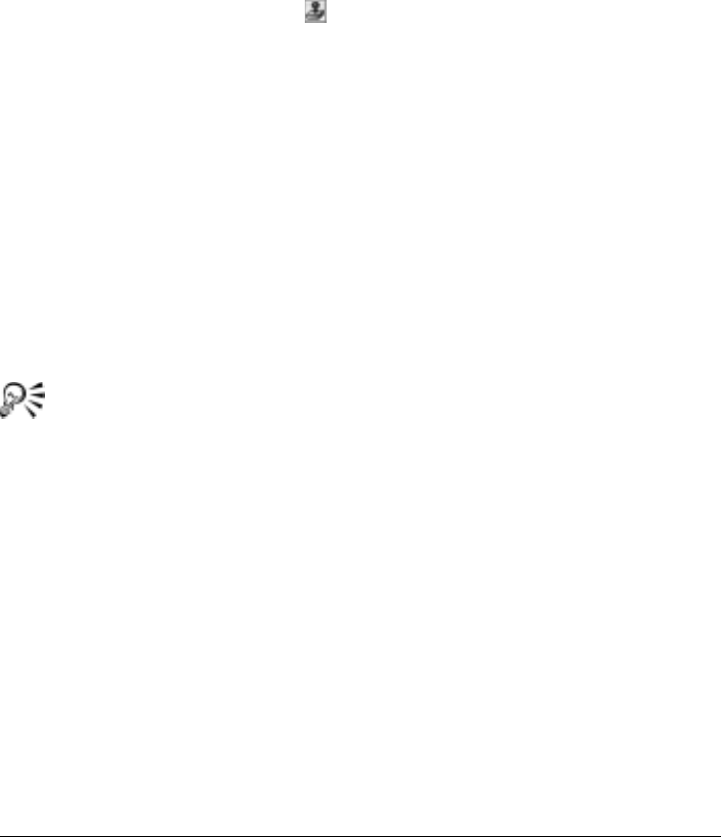
280 Corel Painter User Guide
Destination reference points indicate the area where you want the cloned image to
appear. To indicate the area of the source document you’re cloning, you can turn the
crosshair cursor on.
To clone point to point within a document
1Do one of the following:
• Choose a cloner brush variant from the Brush Selector bar.
• Click the Clone Color button on the Colors palette.
• Click the palette menu arrow on the Colors palette, and choose Use Clone
Color.
2Choose File menu > Clone Source, and choose the image you want to reference.
If no image is set as a clone source, the brush will reference the currently selected
pattern.
3Hold down Option (Mac OS) or Alt (Windows).
A crosshair cursor appears.
4Click inside the source image to set the source reference point.
A green marker appears on the image, indicating the reference point for the source
image.
5Begin painting in the destination area.
You can set the destination area before painting by clicking while holding
down Option + Shift (Mac OS) or Alt + Shift (Windows). A red marker
indicates the destination area.

Cloning and Tracing 281
Cloning within a document with the destination marker showing.
To clone point to point between documents
1Do one of the following:
• Choose a cloner brush variant from the Brush Selector bar.
• Click the Clone Color button on the Colors palette.
• Click the palette menu arrow on the Colors palette, and choose Use Clone
Color.
2Choose File menu > Clone Source, and choose the image you want to reference.
If no image is set as a clone source, the brush will reference the currently selected
pattern.
3Hold down Option (Mac OS) or Alt (Windows), and click inside the source
document to set the reference point for the source area.
A green marker appears on the image to indicate the reference point for the source
image.
4Select the destination document.
5Hold down Option + Shift (Mac OS) or Alt + Shift (Windows), and click inside
the source document to set the reference point for the destination area.
A red marker appears on the image, indicating the reference point for the
destination image.
6Start painting at the point where you want to begin applying the source image.

282 Corel Painter User Guide
To change to a crosshair cursor
1Do one of the following:
• (Mac OS) Choose Corel Painter IX menu > Preferences> General.
• (Windows) Choose Edit menu > Preferences > General.
2In the Preferences dialog box, enable the Indicate Clone Source with Crosshairs
While Cloning option.
The crosshairs indicate which area of the original image you’re cloning as you paint.
Using Multipoint Cloning
Some variants of the Cloners brush category use multipoint cloning to apply a
transformation to the source image when you clone it. To take advantage of the cool
effects you can get with these cloning brush variants, you need to set multiple source
and destination reference points.
Selecting a Clone Type for Multipoint Cloning
Corel Painter lets you establish different kinds of relationships between the clone
source and destination based on the number of reference points you use. The number
of reference points determines which clone type you can select and, therefore, which
transformations you can apply. All clone types are valid for brushes that use the
cloning method and for brushes that use either the Clone Color option or a clone
source. You must set source and destination reference points before using a multipoint
cloning brush.
The number of source and destination reference points required for each of the
following clone types is shown in parentheses:
• Normal (0), or zero-point, cloning references the upper-left corners of the source
and destination documents and patterns. This means that the pixels of the
destination document correspond directly with the pixels of the source document.
This type of cloning, in which no transformations occur, is valid only between
documents. This type of cloning is the basic type of cloning between documents.
Refer to “Cloning a Document” on page 274 for more information about basic
cloning.
• Offset (1) cloning offsets the image from the source. The source and destination
areas can be separate places in the same or different documents. Offset cloning is
basic point-to-point cloning and is useful for retouching photographs. Refer to
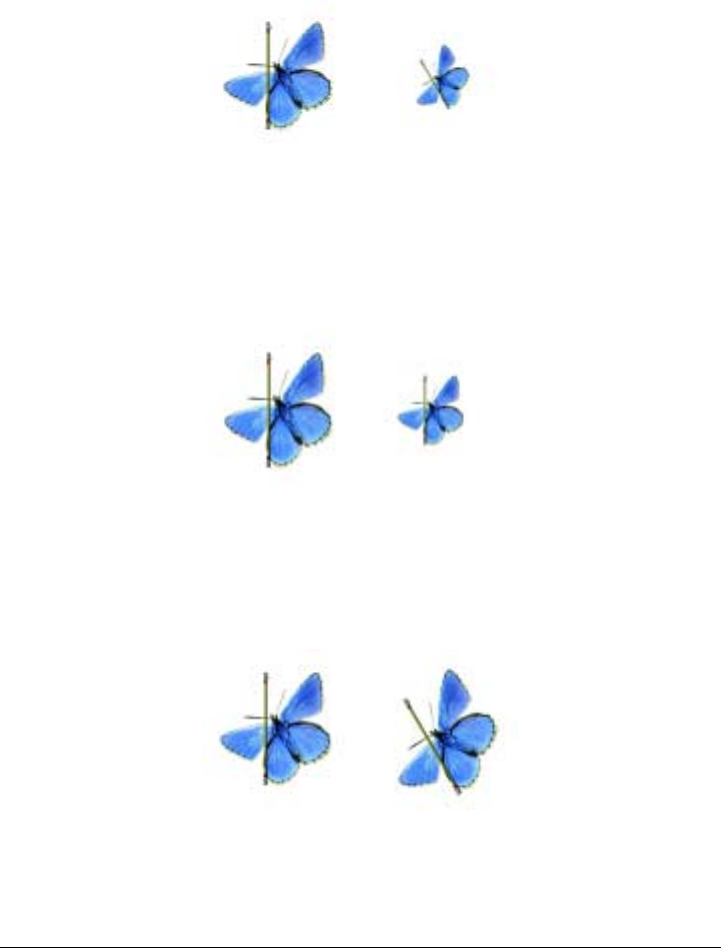
Cloning and Tracing 283
“Using Point-to-Point Cloning” on page 279 for more information about
point-to-point cloning.
• Rotate & Scale (2) cloning rotates and scales the source image.
Rotate & Scale cloning. Note that the source and destination
reference points are numbered and connected by a line.
• Scale (2) cloning scales the source image. The distance between the two destination
points, in relation to the distance between the two source points, determines the
scaling transformation.
Scale cloning.
• Rotate (2) cloning rotates the source image. The line between the two destination
points in relation to the line between the two source points determines the rotation
transformation.
Rotate cloning.
• Rotate & Mirror (2) cloning rotates and mirrors (flips) the source image.
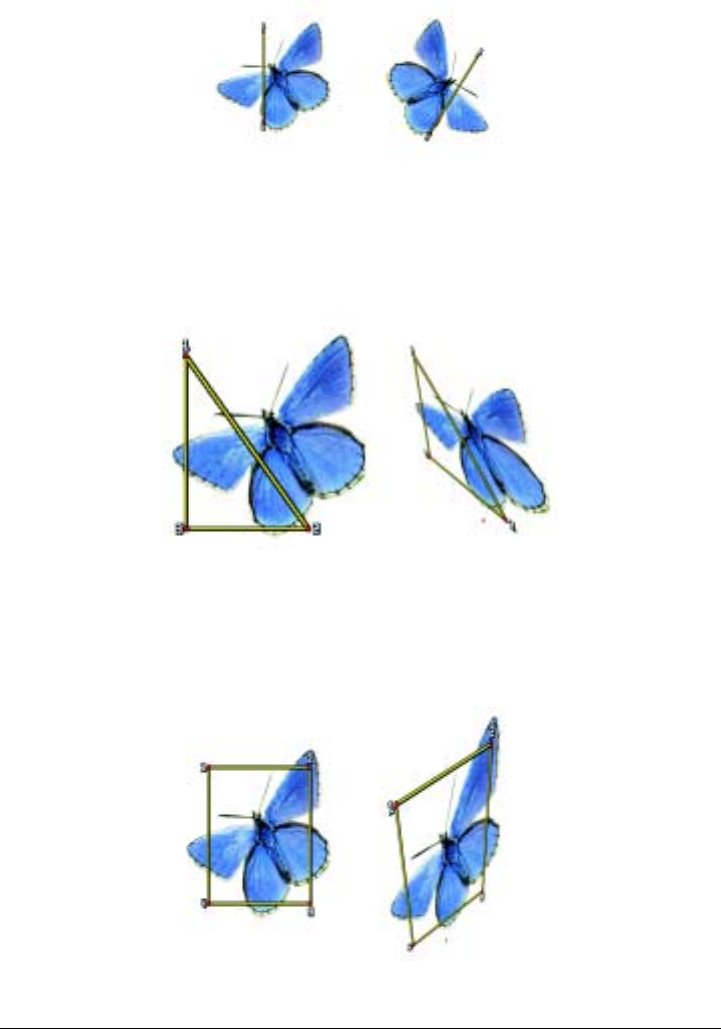
284 Corel Painter User Guide
Rotate & Mirror cloning.
• Rotate, Scale, & Shear (3) cloning rotates, scales, and shears (slants) the source
image. The relative positions of the three source and destination reference points
determine the transformation effect.
Rotate, Scale, & Shear cloning.
• Bilinear (4) cloning applies a bilinear warp to the source image. The relative
positions of the four source and destination points describe the bilinear
transformation.
Bilinear cloning.

Cloning and Tracing 285
• Perspective (4) cloning applies perspective to the source image. The relative
positions of the four source and destination points describe the perspective
transformation.
Perspective cloning.
To set a Clone Type
1Do one of the following:
• Choose a brush variant from the Cloners brush category of the Brush Selector
bar.
• Click the Clone Color button on the Colors palette.
• Click the palette menu arrow on the Colors palette, and choose Use Clone
Color.
2Choose Window menu > Brush Creator.
3On the Stroke Designer page of the Brush Creator, choose Cloning.
4Choose a clone type from the Clone Type pop-up menu.
Setting Reference Points for Multipoint Cloning
Before you can paint with a multipoint cloner brush, you must set the correct number
of source and destination reference points. Source points can be in one document and
destination points in another, or both sets of points can be in the same document.
Multipoint cloner brush variants are indicated by the number of source and destination
reference points required for each clone type beside the variant name. For example, the
xScale 2P variant requires two reference points. Once source and destination reference
points are set, you can start painting with the multi-point cloner brush.
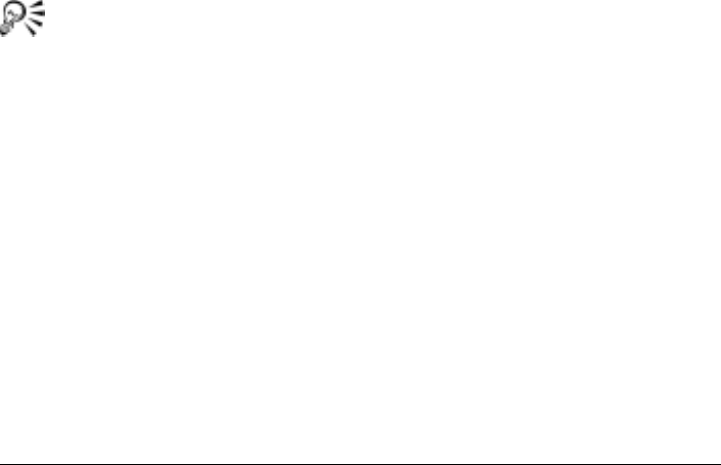
286 Corel Painter User Guide
In some cases, you don’t have to place source points. When you clone source files and
patterns, Corel Painter places source points for you in each corner of the document.
These corner source points are ideal for perspective cloning with 4-point tiling. If you
don’t want to use these default source points, just move them or set source points of
your own. For more information, see “Filling with Transformed Cloning” in the Help.
To set the number of reference points
1Choose Window menu > Brush Creator.
2On the Stroke Designer page of the Brush Creator, choose Cloning.
3Choose the transformation you want from the Clone Type pop-up menu.
The number that follows each option in the Clone Type pop-up menu indicates the
number of required reference points.
To set source reference points
1On the Brush Selector bar, click the Brush Variant selector arrow and choose a
multi-point cloner brush variant.
2Hold down Option (Mac OS) or Alt (Windows), and click in the source area for
each reference point required.
3Points appear in the source image as you click, along with identifying numbers.
You can use other cloner brush variants by selecting a new variant and setting
a clone type. Refer to “Selecting a Clone Type for Multipoint Cloning” on
page 282 for more information.
You can reposition reference points by holding down Option (Mac OS) or Alt
(Windows) and dragging the points to their new position.
To set destination reference points
1Select the destination document.
2On the Brush Selector bar, click the variant selector arrow, and choose a
multi-point cloner brush variant.
3Hold down Option + Shift (Mac OS) or Alt + Shift (Windows), and click in the
destination area for each reference point required.

Cloning and Tracing 287
Two destination reference points are set in preparation for Rotate & Scale cloning.
Sample source–destination reference points are set for Rotate, Scale, & Shear cloning.
Sample source–destination reference points are set for Perspective cloning.
To move source points to a pattern
•On the Patterns palette, click the palette menu arrow, and choose Check Out
Pattern.
Source points are moved into a new “checked out pattern” window. For more
information about checking out patterns, refer to “To edit a pattern tile” on
page 125.
You can reposition reference points by holding down Option (Mac OS) or Alt
(Windows) and dragging the points to their new position.
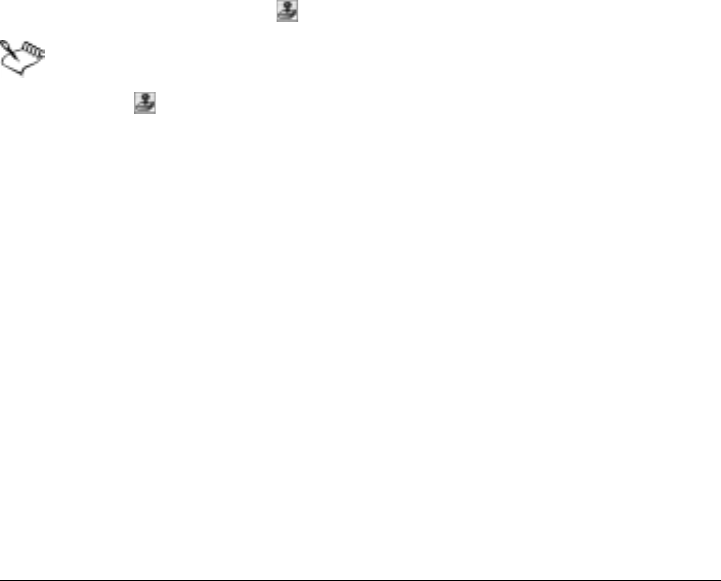
288 Corel Painter User Guide
Turning Other Brushes into Cloners
Corel Painter offers two ways to use other brushes as Cloners:
• the Clone Color button
• the Cloning method
Using Clone Color
You can turn almost any brush into a cloner with the Clone Color button. The
Clone Color button causes a brush to pick up color from the source image while
staying true to its own stroke nature. The Clone Color button is useful for creating
mosaics and tessellations based on a source image.
To use Clone Color
1Choose Window menu > Show Colors to display the Colors palette.
If the Colors palette is not expanded, click the palette arrow.
2Click the Clone Color button .
If you change brushes while cloning images, you must click the Clone Color
button again.
Clicking the Clone Color button in the Colors palette also enables the Clone
Color check box in the Brush Creator.
Using Brush Loading
For greater color accuracy while cloning, you can use the Brush Loading option. This
causes the brush to pick up individual colors in different regions of the brush dab.
Without Brush Loading, the Clone Color option uses a single, averaged color from the
source for each brush dab. This results in an approximation of the original. You can use
the Clone Color button without Brush Loading to create an artistic impression of the
source.
To enable the Brush Loading option
1Choose Window menu > Brush Creator.
2On the Stroke Designer page of the Brush Creator, choose Well.

Cloning and Tracing 289
3Enable the Brush Loading check box.
Choosing a Cloning Method
You can turn almost any brush into a cloner variant by setting its method to Cloning
in the Brush Creator and choosing the Cloning method subcategory appropriate to the
intended media style.
Because the cloning methods use a full set of pixels from the original document for
each brush dab, you get a truer copy of the original than you might by using the Clone
Color button. Unlike the Clone Color option, the cloning methods preserve the
original image texture in the clone. Cloning methods are good to use when you want
to precisely re-create portions of a source image.
The Cloning method subcategories are briefly described here. For a more detailed
discussion of these methods, refer to “Methods and Subcategories” on page 211.
• Hard Cover Cloning results in partially anti-aliased brush strokes that hide
underlying strokes.
• Soft Cover Cloning produces anti-aliased brush strokes that cover layered ones.
• Grainy Hard Cover Cloning works like Hard Cover Cloning, but brush strokes also
interact with paper grain.
• Grainy Soft Cover Cloning works like Soft Cover Cloning, but brush strokes also
interact with paper grain.
• Drip Cloning pushes color around as if it were wet, cloning the original with
distortions based on your stroke.
To adjust a cloning method
1Choose a brush from the Brush Selector bar.
2Choose Window menu > Brush Creator.
3On the Stroke Designer page of the Brush Creator, choose Random.
4Modify the sliders and options to change the character of the brush variant:
• Move the Jitter slider to the right to determine the amount of randomness in
the brush stroke.
• Choose an expression from the Expression pop-up menu to vary the brush
stroke.
• Move the Direction slider to adjust the angle value of the direction control.

290 Corel Painter User Guide
• Move the Variability slider to the right to soften brush strokes. This works best
with bristle brushes, creating an impressionistic effect.
• Move the Variability slider a bit to the right and the How Often slider to the
left to give drawing tools a “sketchy” feel.
• Enable the Random Clone Source check box to make the cloning method
randomly pick up pieces from the source document. Your brush then gives you
random snippets of the source image. This option is not available for all Brush
categories.
• Enable the Random Brush Stroke Grain check box to make the cloning
methods randomly pick up texture from the current paper grain. This option is
not available for all Brush categories.

Image Effects 291
Image Effects
Inspired by traditional artistic methods, the Corel Painter image effects let you do
everything from correcting colors to retouching images to creating a completely new
image from a source. The effects range from practical tools, like the orientation, tonal
control and focus effects, to artistic expressions, like embossing, color overlay, and
posterize. For more information about image effects, refer to “Image Effects” in the
Help.
Working with Surface Texture
The Apply Surface Texture effect lets you add a three-dimensional (3D) surface texture
to your image. You can use this feature to apply a paper texture across the image, to
give depth to the brush strokes of an oil painting, or to create 3D mosaic tiles.
Surface texture is created either by applying a paper texture or by using information
from a clone source to determine depth and height. There are five methods for creating
texture:
• Using a paper texture
• Using the difference from a clone source
• Using image luminance
• Using the luminance from a clone source
• Using a channel or layer mask
The Apply Surface Texture effect also lets you apply a reflection map to your surfaces,
which can make the textured parts of the image look metallic or glasslike. Refer to
“Working with Reflection Maps” on page 301 for more information.

292 Corel Painter User Guide
Examples of effects created with Apply Surface Texture.
Setting Appearance of Depth Properties
The surface texture you apply is made up of a material. That material can be subtle
and blend with the original image, or it can be highly reflective or shiny, distorting the
original image.
The Appearance of Depth sliders on the Apply Surface Texture dialog box let you
control material properties.
• The Amount slider controls how much surface texture is applied to the image.
Moving the slider all the way to the right applies the maximum amount.
• The Picture slider controls how much of the color from the original image is
applied to the texture. At 100%, the full color of the picture shines through.
Moving the slider to the left displays more black, leaving only the shine.
• The Shine slider controls how much highlight appears on the surface of the texture.
Higher Shine values make the texture look metallic.
• The Reflection slider maps a clone source image or pattern onto the texture at a
variable percentage.
©1999, Jack Davis
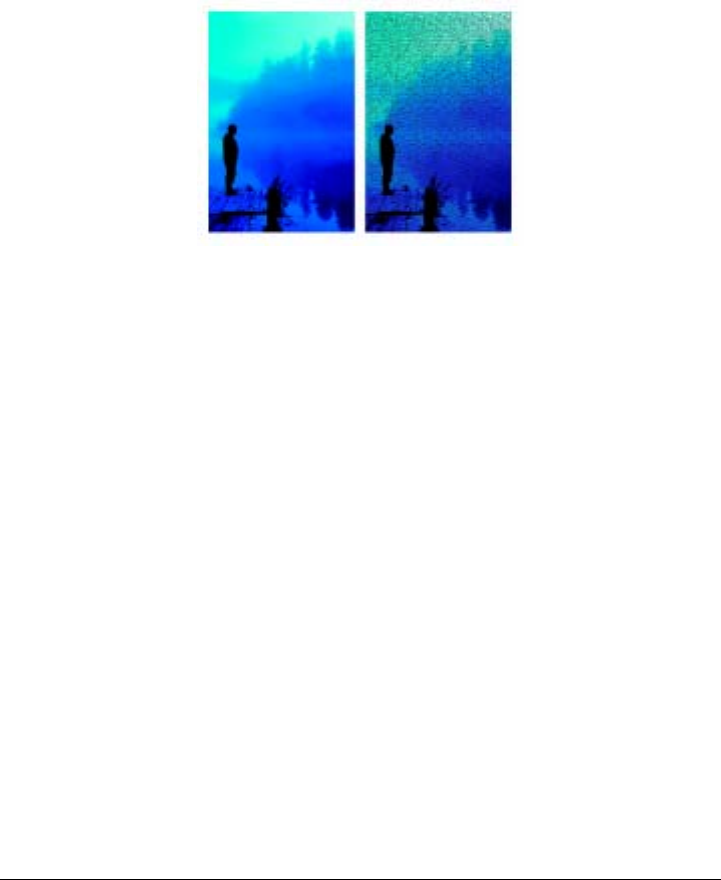
Image Effects 293
Using Paper to Create Texture
When you create a texture using the Paper method, the current paper texture is
applied to your image. If the Papers palette is open, you can choose different papers
and change their scale to try different textures. The Preview window is updated
automatically to reflect paper changes.
Before (left) and after (right) creating texture by using paper grain.
To create surface texture by using paper
1Select a layer or area of the canvas.
If you want to apply the effect to the entire image, do not make a selection.
2Choose Effects menu > Surface Control > Apply Surface Texture.
3In the Apply Surface Texture dialog box, choose Paper from the Using pop-up
menu.
If you want to apply an inverted paper texture, enable the Inverted check box.
4Adjust the Softness slider to control the amount of distortion created by the
texture.
Increasing softness creates more intermediate steps, which produces a smoother
distortion.
5Adjust the Appearance of Depth sliders.
Refer to “Setting Appearance of Depth Properties” on page 292 for more
information.
6Adjust the Light Controls sliders.
For more information, refer to “Applying Lighting to a Texture” on page 303.

294 Corel Painter User Guide
Using 3D Brush Strokes to Create Texture
When you create a texture using the 3D Brush Strokes method, the difference in
luminance between the clone source and the current document is used to determine
the look of the texture.
If you change the colors in the clone or posterize the clone, the texture is based on
color differences. If you paint on the clone, however, you can make the brush strokes
appear three-dimensional, giving them the illusion of oil paints. For information about
cloning, refer to “Cloning Images” on page 273.
An example of the texture created when Posterize
(right) is applied to the clone source (left).
An example of the texture created when brush
strokes (right) are applied to a cloned image (left).
To create surface texture by using 3D Brush Strokes
1Open the original image.
2Choose File menu > Clone.

Image Effects 295
If you want to alter the clone before using the 3D Brush Strokes method, apply an
effect or paint on it.
3Select a layer or area of the canvas.
If you want to apply the effect to the entire image, do not make a selection.
4Choose Effects menu > Surface Control > Apply Surface Texture.
5In the Apply Surface Texture dialog box, choose 3D Brush Strokes from the Using
pop-up menu.
If you want to apply an inverted texture, enable the Inverted check box.
6Adjust the Softness slider to control the amount of distortion created by the
texture.
Increasing softness creates more intermediate steps, which produces a smoother
distortion.
7Adjust the Appearance of Depth sliders.
Refer to “Setting Appearance of Depth Properties” on page 292 for more
information.
8Adjust the Light Controls sliders.
For more information, refer to “Applying Lighting to a Texture” on page 303.
Creating 3D Oils
Because the 3D Brush Strokes method uses the difference between the clone source
and its clone to define a 3D texture, you can create the illusion of dimensional oils by
painting on the clone. The look of the strokes on the clone determines how realistic the
final 3D strokes appear. So, you may want to set up a more complex brush before
painting. For example, you can apply a paper texture to the stroke. Many of the brush
variants reveal the paper texture automatically in their strokes.

296 Corel Painter User Guide
An example of 3D brush strokes with paper texture.
You can apply a paper texture when you first create an image, and then paint or draw
over it to make a textured canvas for your strokes. However, the texture is erasable, so
you might not end up with the same texture across the document surface. As a rule,
you add the paper texture as the last step in producing artwork.
You can also use advanced brush settings to make realistic strokes. For example, you
can use the Brush Loading option to move underlying colors as you make brush
strokes. You can also apply other settings, like Bleed, or adjust brush size to create
complex strokes. Refer to “Customizing Brushes” on page 197 for more information on
these features.
An example of 3D brush strokes with Brush
Loading (left) and Bleed (right) settings applied.

Image Effects 297
Using Image Luminance to Create Texture
When you create a texture using the Image Luminance method, the current image’s
luminance, or lightness, determines where surface texture is added. Light parts of the
image create dents; darker parts create raised areas. The overall effect gives an
embossed look to the edges of the image.
Before (left) and after (right) adding texture based on Image Luminance.
To create surface texture by using Image Luminance
1Select a layer or area of the canvas.
If you want to apply the effect to the entire image, do not make a selection.
2Choose Effects menu > Surface Control > Apply Surface Texture.
3In the Apply Surface Texture dialog box, choose Image Luminance from the Using
pop-up menu.
If you want to apply an inverted texture, enable the Inverted check box.
4Adjust the Softness slider to control the amount of distortion created by the
texture.
Increasing softness creates more intermediate steps, which produces a smoother
distortion.
5Adjust the Appearance of Depth sliders.
Refer to “Setting Appearance of Depth Properties” on page 292 for more
information.
6Adjust the Light Controls sliders.
For more information, refer to “Applying Lighting to a Texture” on page 303.
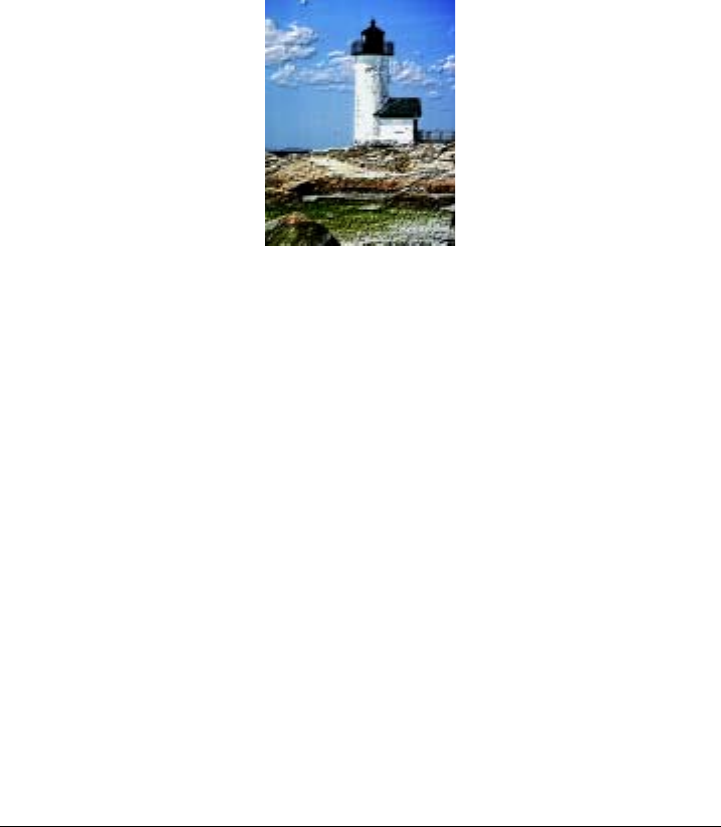
298 Corel Painter User Guide
Using Clone Source Luminance to Create Texture
When you create a texture using clone source luminance, the dents and bumps in the
texture are determined by the light and dark areas in the clone source and are applied
to its clone. What is unique about this method is that you can create interesting
embossed looks by changing the clone source. Any image effects or brush strokes that
you apply to the source result in different textures. For example, you can create raised
areas in the clone by darkening the area in the source image.
Texture based on clone source luminance.
To create surface texture based on clone source luminance
1Open an image.
2Choose File menu > Clone.
3Alter the clone by applying an effect, by painting, or by choosing a pattern or
gradient.
4Select a layer or area of the canvas.
If you want to apply the effect to the entire image, do not make a selection.
5Choose Effects menu > Surface Control > Apply Surface Texture.
6In the Apply Surface Texture dialog box, choose Original Luminance from the
Using pop-up menu.
If you want to apply an inverted texture, enable the Inverted check box.
7Adjust the Softness slider to control the amount of distortion created by the
texture.
Increasing softness creates more intermediate steps, which produces a smoother
distortion.
8Adjust the Appearance of Depth sliders.
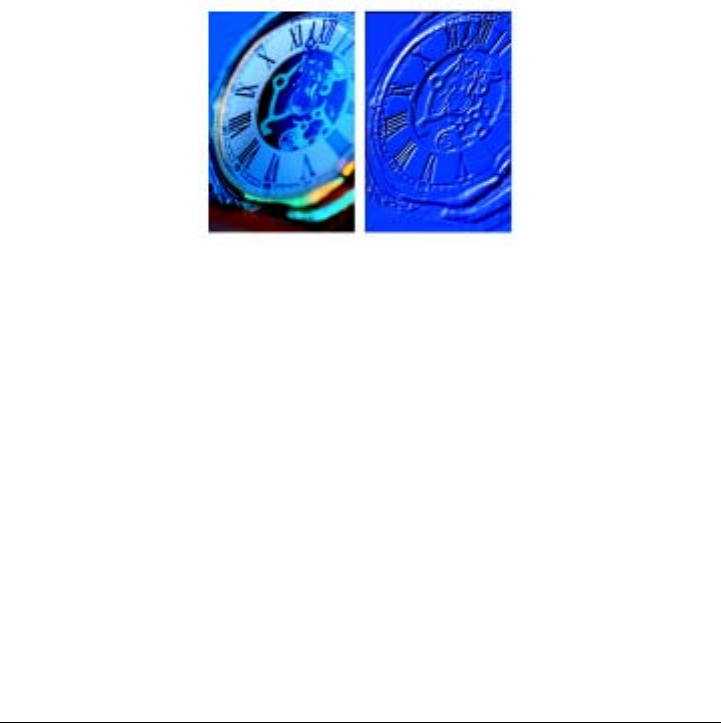
Image Effects 299
Refer to “Setting Appearance of Depth Properties” on page 292 for more
information.
9Adjust the Light Controls sliders.
For more information, refer to “Applying Lighting to a Texture” on page 303.
Creating Embossing Effects
One of the most effective ways of using the Original Luminance method is to create an
embossed image. Unlike standard emboss effects, Apply Surface Texture lets you
control not only the height of the texture, but also the lighting and material properties
of the embossing.
Before (left) and after (right) applying the embossed effect.
To create an embossed effect
1Open an image.
2Choose File menu > Clone.
3Choose a color other than black from the Colors or Color Sets palette.
If you want the embossed image to be white, select all, and then press Delete (Mac
OS) or Backspace (Windows).
4Choose Effects menu > Fill.
5In the Fill dialog box, enable the Current Color option.
6Adjust the Opacity slider to set the opacity of the fill.
7Click OK to fill the clone file with color.
8Choose Effects menu > Surface Control > Apply Surface Texture.

300 Corel Painter User Guide
9In the Apply Surface Texture dialog box, choose Original Luminance from the
Using pop-up menu.
The Preview window shows how the embossed image will look.
10 Adjust any of the Appearance of Depth or Light Controls sliders.
11 Enable a Light Direction option to change the location of highlights and shadows.
If you want to change the light color, click the Light Color chip, and choose a color
from the Color dialog box.
Using Channels and Layer Masks to Create Texture
Corel Painter lets you produce surface texture based on an alpha channel or a layer
mask. You can use this method only if your image has a saved alpha channel or a layer
with a layer mask.
When you choose a channel, the texture is applied around the edges of the channel so
that the area it covers appears raised. When you choose a layer mask, the layer mask is
used to determine the boundaries of the texture. In this case, texture is applied to the
edges of the layer mask. Refer to “Working with Layer Masks” in the Help for more
information on layer masks.
Before (left) and after (right) adding texture based on a saved alpha channel.
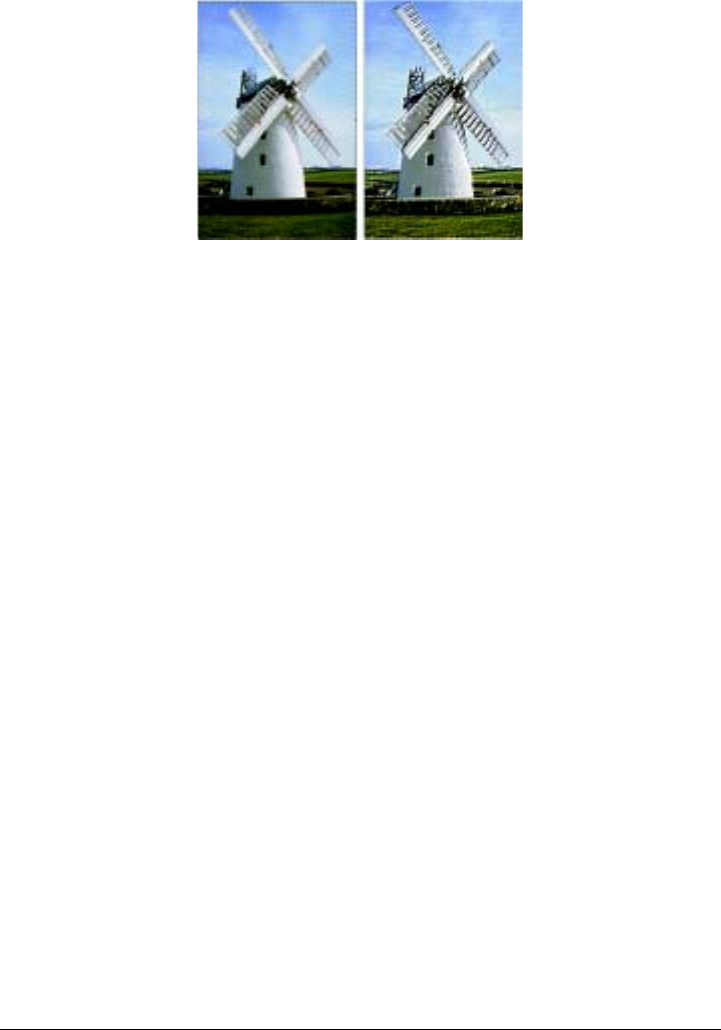
Image Effects 301
Before (left) and after (right) adding texture based on a layer mask.
To create surface texture based on a channel or layer mask
1Select a layer or area of the canvas.
If you want to apply the effect to the entire image, do not make a selection.
If you want to use a layer mask, you must select the layer.
2Choose Effects menu > Surface Control > Apply Surface Texture.
3In the Apply Surface Texture dialog box, choose the channel or layer mask from the
Using pop-up menu.
If you want to apply an inverted texture, enable the Inverted check box.
4Adjust the Softness slider to control the amount of distortion created by the
texture.
Increasing softness creates more intermediate steps, which produces a smoother
distortion.
5Adjust the Appearance of Depth sliders.
Refer to “Setting Appearance of Depth Properties” on page 292 for more
information.
6Adjust the Light Controls sliders.
For more information, refer to “Applying Lighting to a Texture” on page 303.
Working with Reflection Maps
A reflection map is an image mapped onto a texture to produce the illusion that it’s
reflecting light from the surrounding environment. You can use the reflection map
pattern to quickly apply a realistic reflection. In most cases, a reflection map makes
your texture look like chrome or polished metal.

302 Corel Painter User Guide
Before (left) and after (right) applying a typical reflection map.
You can use either a pattern or a clone source image as a reflection map. By adjusting
the Reflection slider, you control how much of the image appears in the texture. If your
image has a clone source, the source image is mapped onto the texture. Otherwise,
Corel Painter uses the current pattern as the reflection map.
You can use the Image Warp effect to approximate the reflection from a curved
surface. For more information, refer to “Warping an Image” in the Help.
To create a reflection map from a clone source
1Open an image or create a new image to use as the reflection.
If you want to approximate the reflection from a curved surface, apply the
Image Warp effect.
2Choose File menu > Clone Source > [filename].
3Select the area that you want to be reflective.
4Choose Edit menu > Cut.
5Choose Edit menu > Paste in Place.
A new layer is created.
6On the Layers palette, select the layer, and click the Create Layer Mask button .
Using a layer mask simplifies the process because the layer mask exactly matches
the shape of the reflection area. Refer to “Working with Layer Masks” in the Help
for more information.

Image Effects 303
A selected layer, ready to become reflective.
7Choose Effects menu > Surface Control > Apply Surface Texture.
8In the Apply Surface Texture dialog box, choose the layer mask from the Using
pop-up menu.
9Adjust the Reflection slider to control the amount of reflection you want.
10 Adjust the Softness slider to control the mapping from the edges of the layer’s
image.
Increasing Softness gives a rounder, more 3D look to the surface.
The resulting chrome-plated butterfly.
Applying Lighting to a Texture
A large part of the final look of your textures is determined by the lighting you apply.
Bad lighting can obscure details in a pattern or surface. Good lighting can add
interesting highlights and enhance reflections.
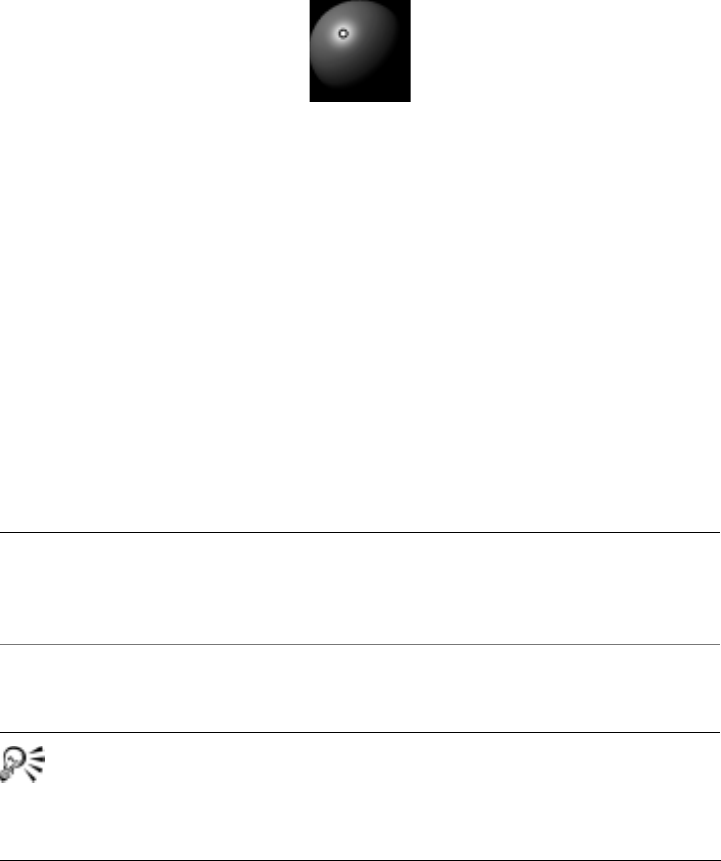
304 Corel Painter User Guide
You can add, delete, and position light sources, and you can set light properties. You
can also position lights by enabling one of the Light Direction options, which represent
eight different preset lighting angles. You can also create a custom lighting setup by
working in the sphere.
The lighting sphere shows all possible surface angles and how they are illuminated.
The light indicators on the sphere show the current positions of each light source.
The lighting sphere with a light indicator.
The Display slider beneath the lighting sphere controls the brightness of the sphere so
that it’s easier to see light positions. It does not affect the lights themselves.
Sliders for the three Light Controls let you set the properties of a light source. You can
also change a light’s color.
• The Brightness slider indicates the intensity of the light.
• The Conc (concentration) slider adjusts the spread of the light’s shine over the
surface.
• The Exposure slider globally adjusts the overall lighting amount from darkest to
brightest.
To add or delete a light
The Show Light Icons check box lets you hide or show the light indicators.
To Do the following
Add a light In the Apply Surface Texture dialog box,
click the lighting sphere. A new light
indicator (a small circle) is added to the
lighting sphere.
Delete a light In the Apply Surface Texture dialog box,
click a light indicator, and press Delete (Mac
OS) or Backspace (Windows).
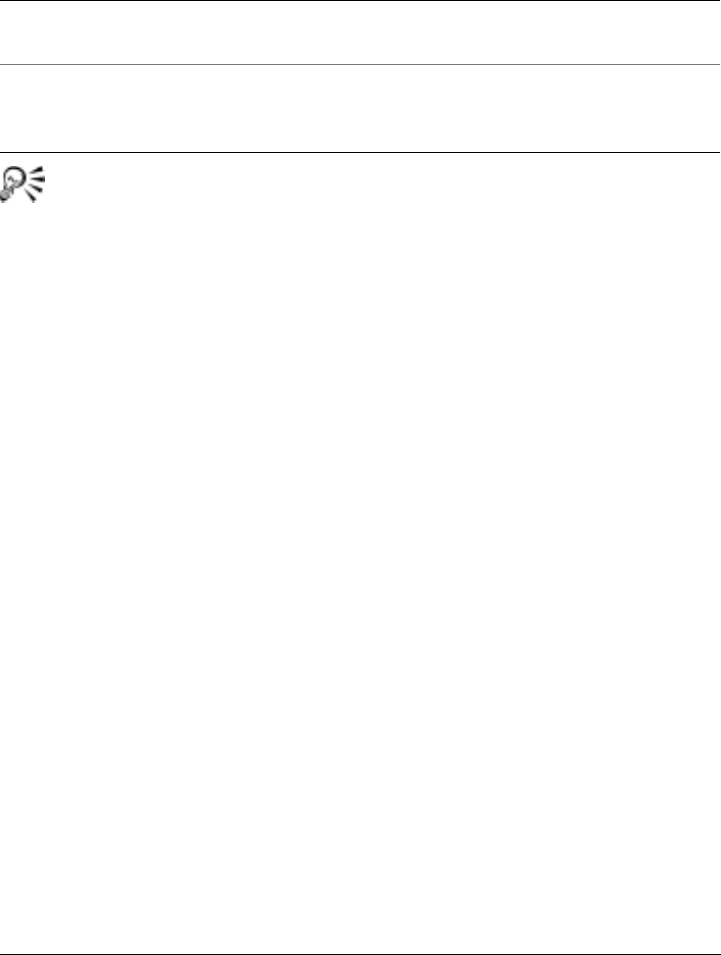
Image Effects 305
To change a light’s position or color
You can also change a light’s position by selecting a light indicator on the
sphere and enabling one of the Light Direction options.
To Do the following
Change light position In the Apply Surface Texture dialog box,
drag a light indicator on the lighting sphere.
Change light color In the Apply Surface Texture dialog box,
click the Light Color chip. In the Color
dialog box, choose a new color.
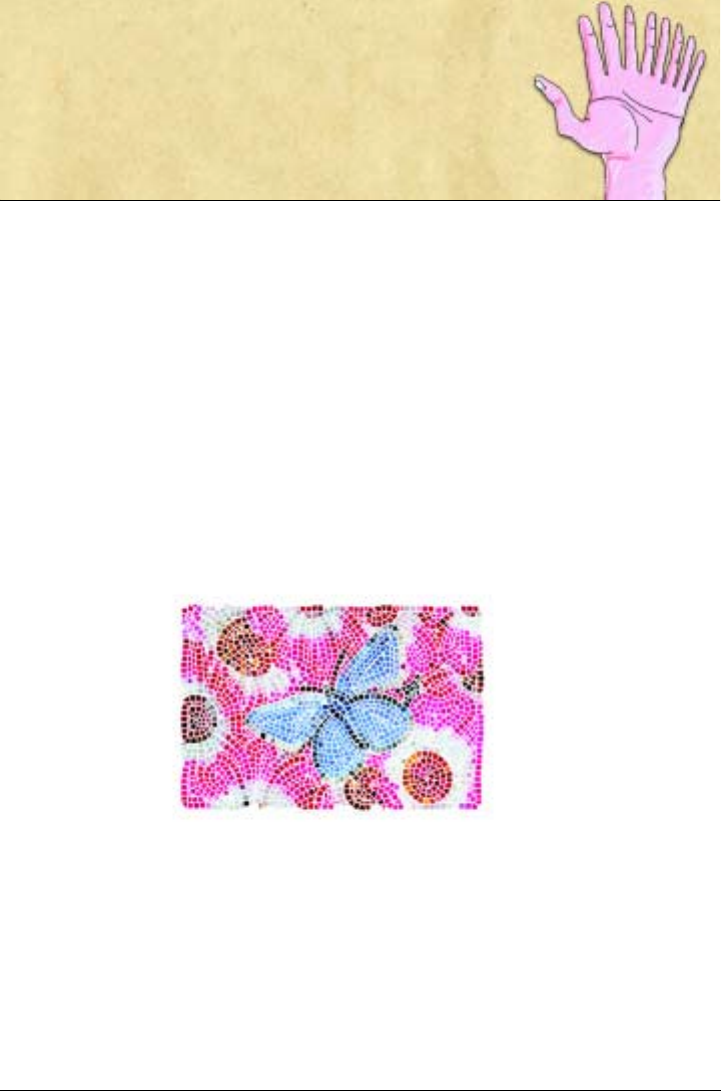
Mosaics 307
Mosaics
Making mosaics is a classical art technique that creates pictures from colored tiles and
grout. In Corel Painter, the Make Mosaic feature and its companion, Make
Tessellation, let you create tile mosaics and stained-glass window formations.
The Make Mosaics feature lets you paint with a mosaic medium. In essence, you’re
painting with tiles. The medium you paint with can be simple colored tiles or colors
cloned from an original image. In this way, you can paint an original image on a blank
canvas or re-create an image from a cloned photo.
Each tile is an independent object and carves its shape so that it fits perfectly with
surrounding tiles. You can erase and/or reshape tiles to create the perfect mosaic
design.
A mosaic image.
After creating a mosaic, you can give it a three-dimensional (3D) appearance. You can
also apply brush strokes to the mosaic. A brush such as Distortion will smear the tile
colors. For instructions on adding dimension to the tiles, refer to “Giving Tiles a 3D
Look” on page 319.

308 Corel Painter User Guide
Getting Started with Mosaics
The Mosaic feature differs from the other Natural-Media tools in Corel Painter. With
the mosaics medium, you’re actually working in a different mode. This means that you
must have the Make Mosaic dialog box open, and you cannot access any other tools or
features — except for the Colors palette.
When in Mosaics mode, you can add, remove, and reshape mosaic tiles. You can choose
a color to paint with or use the Clone Color option on the Colors palette. You can also
set grout thickness.
The Make Mosaic dialog box provides all the controls needed for working in this
medium. When painting with mosaic tiles, you work with one of four tools: Apply
Tiles, Remove Tiles, Change Tile Color, or Select Tiles.
Whether you are cloning from an existing image or creating a mosaic design from
scratch, you may find the following guidelines helpful:
• Use your first few courses of mosaic tiles to delineate the most important contours
of your subject — just as if you were drawing with a pencil. Describe the most
important lines of your scene first. Additional courses of tiles should follow the
initial contours.
Tiles applied to the outline of an image.
• Use larger tiles in areas of flat color and smaller tiles in regions where you must add
more detail. In flat-color areas, you may want to introduce some color variability
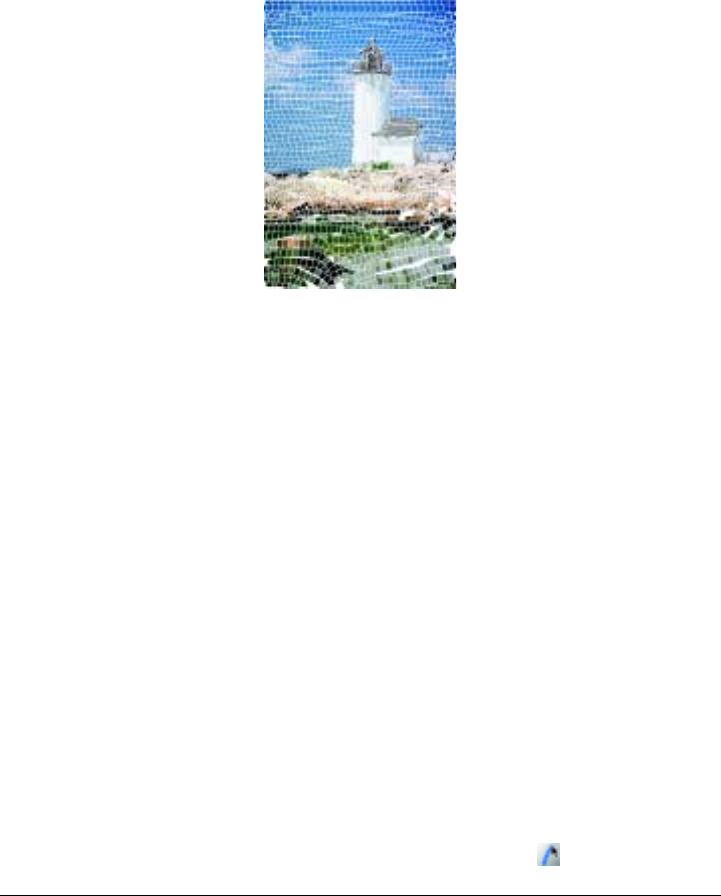
Mosaics 309
for a more realistic effect. Tiles used in traditional mosaics rarely have uniform
color.
• If you’re working in a clone, turn on the Tracing Paper feature by enabling the Use
Tracing Paper check box in the Make Mosaics dialog box. This helps you follow the
source images.
Clone without source images showing (the Use Tracing Paper
check box in the Make Mosaic dialog box is disabled).
Creating a Mosaic Effect
Once you create a mosaic, keep the Make Mosaic dialog box open so that you can
continue to work on the mosaic. After you apply tiles to a mosaic, you can select or
deselect tiles to change their color or apply effects to them.
To display the Make Mosaic dialog box
1Do one of the following:
• Start a new document by choosing File menu > New.
• Clone an existing document by choosing File menu > Open and locating the
file that you want to clone. Then, choose File menu > Quick Clone.
2Choose Canvas menu > Make Mosaic.
To create a mosaic from scratch
1Start a new document by choosing File menu > New.
2Choose Canvas menu > Make Mosaic.
3In the Make Mosaic dialog box, click the Apply Tiles button .
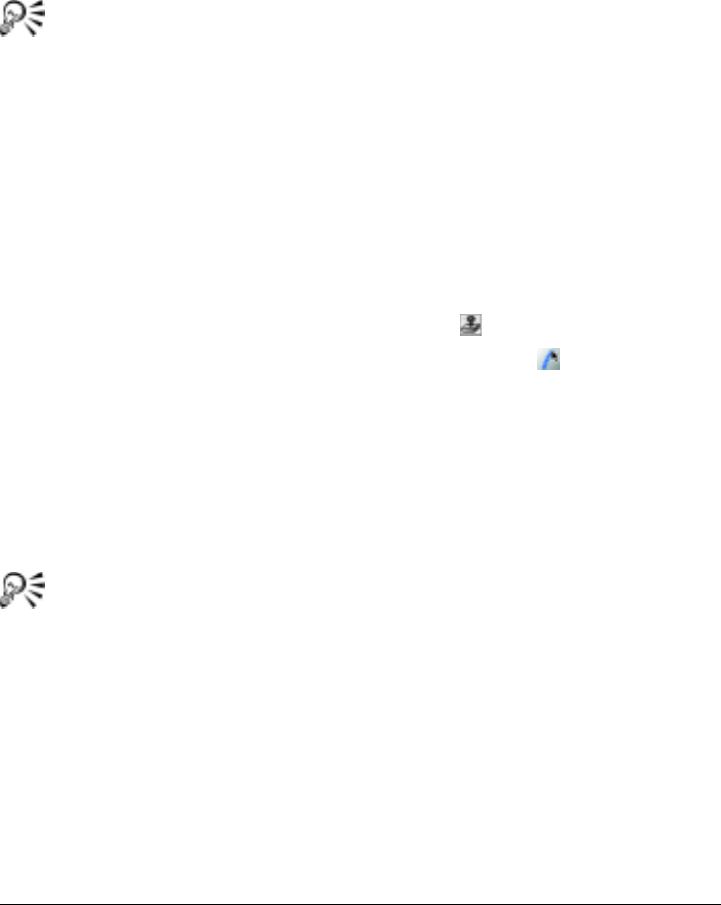
310 Corel Painter User Guide
4Drag in the document window.
New tiles flow from your stroke.
5Keep the Make Mosaic dialog box open so that you can continue to work on the
mosaic.
You can also have Corel Painter do the tile work automatically with the
Stroke Selections and Fill Selection commands located in the Make Mosaic
dialog box in the Options pop-up menu. For information on how to use the
Stroke Selections and Fill Selection options, see “Using Stroke Selections and
Fill Selection Commands” on page 321.
To create a mosaic based on a cloned image
1Clone an existing document by choosing File menu > Open, and locating the file
that you want to clone. Then, choose File menu > Quick Clone.
2Choose Canvas menu > Make Mosaic.
3On the Colors palette, click the Clone Color option to enable it.
4In the Make Mosaic dialog box, click the Apply Tiles button .
If you don’t want to work with Tracing Paper, disable the Use Tracing Paper check
box.
5Drag in the document window.
New tiles flow from your stroke.
6Keep the Make Mosaic dialog box open so that you can continue to work on the
mosaic.
You can monitor the progress of the clone-based mosaic by viewing the image
with Tracing Paper on, by enabling the Use Tracing Paper check box. This lets
you see a faded out version of the clone source. You can also enable or disable
Tracing Paper by choosing Canvas menu > Tracing Paper. A check mark
indicates that it it enabled.
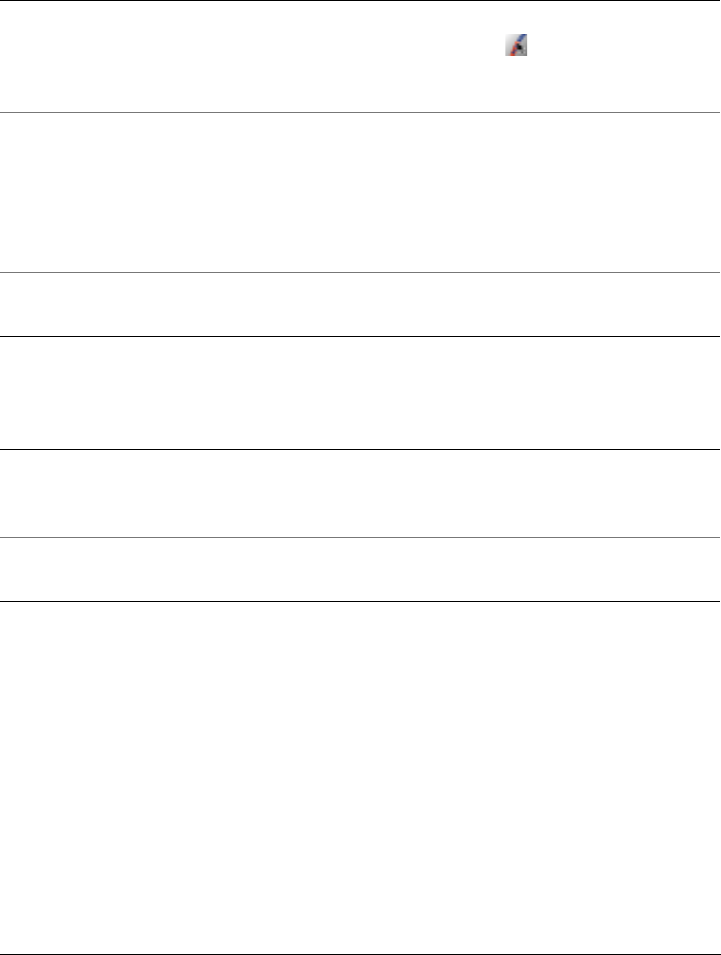
Mosaics 311
To select tiles
To deselect tiles
Specifying Tile Color
There are several ways to change tile color. You can adjust the value, change the hue,
or randomize variability. You can adjust the color for individual tiles or for larger areas
across the mosaic.
The tile color is determined by the main color selected on the Colors palette. You
might want to add some color variability to build visual interest. When working in a
clone document, you can color the tiles based on the clone source.
To Do the following
Select tiles In the Make Mosaic dialog box, click the
Select Tiles button . Drag across the tiles
you want to select. Red borders appear on
selected tiles.
Select contiguous tiles of the same color (no
variability allowed) In the Make Mosaic dialog box, click the
Select Tiles button. Press Command +
Control (Mac OS), or Ctrl (Windows), and
drag across part of a line of tiles, so that the
whole line of tiles is selected. A magic wand
appears as you select the tiles.
Select every tile With the Make Mosaic dialog box displayed,
press the A key.
To Do the following
Deselect an individual tile In the Make Mosaic dialog box, click the
Select Tiles button. Click on a tile that is
already selected to deselect it.
Deselect all tiles With the Make Mosaic dialog box displayed,
press the D key.

312 Corel Painter User Guide
Normally, each tile is given a single color. If you want more options for coloring tiles,
render the tiles to a channel. You can then convert the channel to a selection to paint
directly on the tiles, apply effects, or fill them with a pattern, weave, gradient, or
image. Refer to “Giving Tiles a 3D Look” on page 319 for more information.
To change the color of selected tiles
1In the Make Mosaic dialog box, click the Select Tiles button .
2Click or drag across the tiles you want to select. Red borders appear on selected
tiles.
3Choose a color from the Colors palette.
4Press one of the following keys to apply the described color change to the selected
tiles:
• C (Color) Changes the tiles to the current main color.
• T (Tint) Applies a small amount (10%) of the current main color. Repeat to
accentuate.
• V (Vary) Adds color variability, based on the variability settings on the Colors
palette. On the Colors and Color Variability palettes, choose the color and
variability settings you want to use. Repeat until you are satisfied with the
results.
To change tile color individually
1In the Make Mosaic dialog box, click the Change Tile Color button .
2Choose one of the following color adjustment modes from the menu:
• The Color mode changes the tiles to the current main color.
• The Darken mode applies a small amount of black.
• The Lighten mode applies a small amount of white.
• The Tint mode applies a small amount (10%) of the current main color.
• The Vary mode adds color variability, based on the variability settings on the
Colors palette. On the Colors and Color Variability palettes, choose the color
and variability settings you want to use.
3Click individual tiles you want to change or drag across a group of tiles.
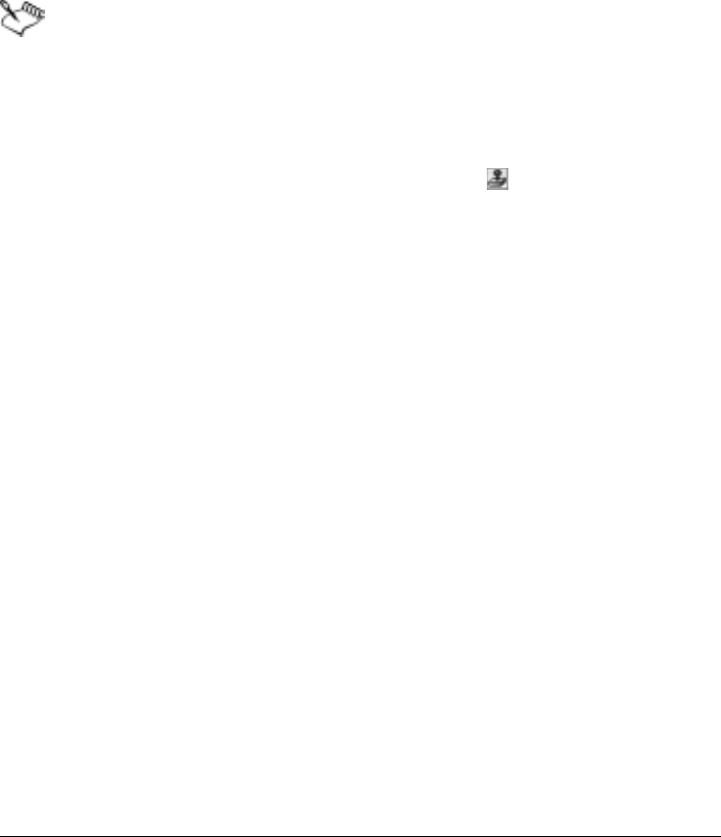
Mosaics 313
To use multicolored tiles
1Choose Window menu > Brush Controls > Show Color Variability to display the
Color Variability palette.
If the Color Variability palette is not expanded, click the palette arrow.
2Choose a color variability method from the pop-up menu.
3Move the sliders or type values in the boxes to adjust the color variability settings.
If the Color Variability palette is not open, you must first close the Make
Mosaic dialog box. Then, display the Color Variability palette, and open the
Make Mosaic dialog box again.
To base colors on a clone source
•After cloning an image, enable the Clone Color option on the Colors palette.
For more information about creating mosaics based on cloned images, see “To
create a mosaic based on a cloned image” on page 310.
Specifying Grout Color
Any area not covered by tiles is considered grout. The grout color is assigned to the
mosaic background when you begin working.
To change the grout color
•In the Make Mosaic dialog box, click the Grout color chip.
Use the Color dialog box to select a grout color. You can change the grout color at
any time. However, changing the grout color automatically re-renders the mosaic,
which erases any part of the image that is not a tile or grout.
Removing Tiles
If you want to remove tiles selectively, use the Remove Tile tool. The Reset Mosaic
command removes all tiles from the document; Corel Painter clears the canvas, leaving
only the grout color.
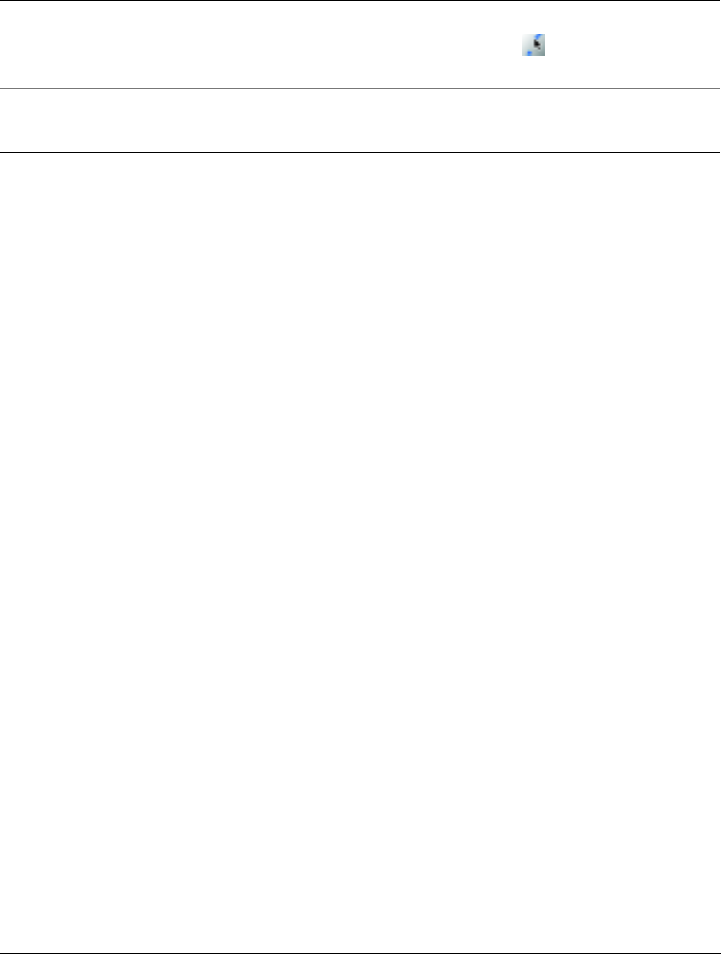
314 Corel Painter User Guide
To remove tiles
Saving to a RIFF File
If you save a mosaic in the RIFF format, you can open the file later, choose the
Make Mosaic command, and continue working.
RIFF is the only file format that will save the resolution-independent mosaic tile
objects. Saving in any other format prohibits you from resuming the mosaic process.
All file formats will save the rendered image of the mosaic tiles on the canvas.
Placing and Customizing Tiles
The Make Mosaic dialog box includes several powerful features for placing tiles and
developing and improving your mosaic. The commands in this section are accessible
from the Settings and Options pop-up menus.
Adjusting Dimensions and Randomness
Tile shapes have two categories of control: Dimensions and Randomness. These
categories can be controlled by using the Settings pop-up menu.
The Dimensions sliders let you control the basic size of the tiles and grout spacing.
The Randomness sliders allow you to control the uniformity of the tile shapes.
Increasing randomness makes the shapes more erratic, each different from the last. For
example, if the Length dimension is 10 pixels, a Length randomness of 25% creates
tiles that are randomly given a length in the range of 7.5 to 12.5 pixels.
To Do the following
Remove specific tiles In the Make Mosaic dialog box, click the
Remove Tiles button . Click or drag
across the tiles you want to remove.
Remove all tiles In the Make Mosaic dialog box, from the
Options pop-up menu, choose Reset Mosaic.

Mosaics 315
To adjust tile dimensions or randomness
1In the Make Mosaic dialog box, from the Settings pop-up menu, choose one of the
following:
•Dimensions
•Randomness
2Adjust the sliders.
3Drag in the document window to apply tiles with the new dimensions or
randomness settings.
Dimension control Example
The Width control sets the width of the tiles
in pixels. In this example, the width is set to 3.5 pixels
(top) and 30.4 pixels (bottom).
The Length control sets the length of the
tiles in pixels. In this example, the length is set to
4.1 pixels (top) and 24.2 pixels (bottom).
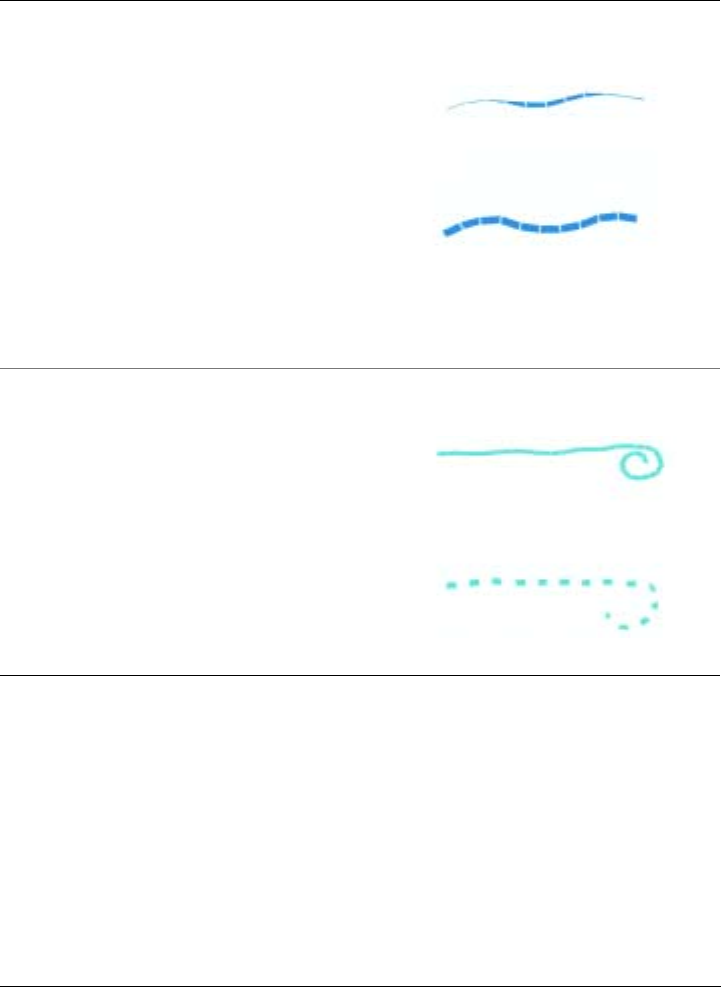
316 Corel Painter User Guide
Pressure determines how tile dimensions are
affected by stylus pressure. The Pressure
slider allows you to control the width
variance under differently weighted strokes.
With the Pressure slider set to zero, a light
stroke produces narrow tiles, and a heavier
stroke creates wider tiles.
Increasing the Pressure slider increases the
effect of pressure on the width of the tiles.
By increasing the Pressure setting, you can
prevent the creation of narrow tiles in
response to a light stroke. Setting Pressure to
100% creates uniformly wide tiles,
regardless of the pressure.
In this example, the pressure slider is set to
0% (top) and 100% (bottom)
The Grout control sets the spacing between
tiles in pixels. In this example, the spacing between tiles is
0% (top) and 15% (bottom).
Dimension control Example

Mosaics 317
Randomness control Example
Increasing Width randomness allows the
width to vary by the set percentage. In this example, Width randomness is set
to 92%.
Increasing Length randomness allows the
length to vary by the set percentage. In this example, the Length slider is set
to 98%.
With Cut randomness set to zero, the edges
of the tile are created perpendicularly to the
stroke. Increasing Cut randomness allows
the angle of the tile ends to vary.
In this example, the Cut slider is set to 90°.
Increasing Grout randomness allows the
spacing between tiles to vary by the set
percentage.
The Grout randomness is set to 100%.
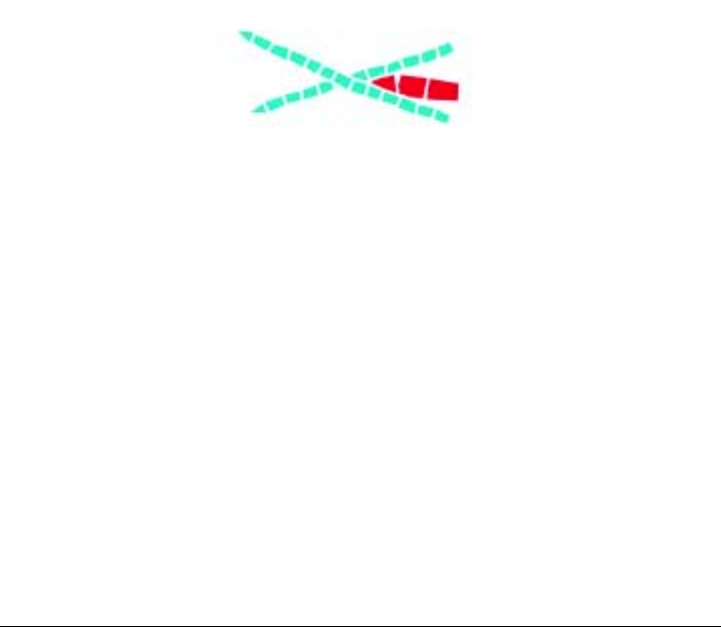
318 Corel Painter User Guide
Fitting Tiles Together
When you work with real ceramic tiles, it is physically impossible to merge them. You
can put them close to each other, but you can’t make them occupy the same space.
Likewise, the mosaic tiles in Corel Painter respect each other’s space and do not overlap
or merge. Corel Painter adjusts the shape of the tiles to fit them together while
maintaining the grout lines. So, when you want to re-lay the tiles in an area, you must
remove the existing tiles. For more information on removing tiles, refer to “Removing
Tiles” on page 313.
Starting with a Triangle
When the Start With Triangle command is enabled, Corel Painter creates a triangle as
the first tile in each stroke. This command is particularly useful when you want to fill a
“V”-shaped space with tiles.
The Start With Triangle command makes a perfect wedge in the “v.”
Respecting the Edge of an Image
When the Respect Edge Of Image command is enabled, Corel Painter maintains a
grout line at the perimeter of the image. Tiles you create at the edge of the image do
not violate the grout line.
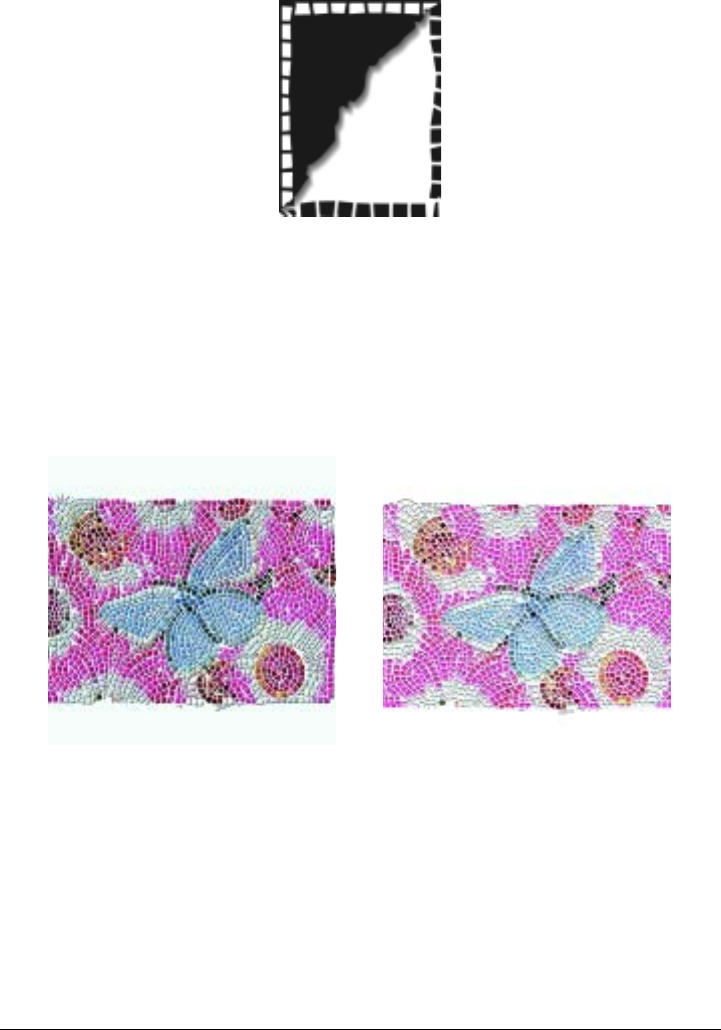
Mosaics 319
The Respect Edge Of Image command ensures that the tiles you
create at the edge will not violate the grout line. In this example,
the white tiles respect the edge, while the black tiles do not.
Giving Tiles a 3D Look
The Render Tiles Into Mask command places the tile shapes in a new channel named
Mosaic Mask (on the Channels palette). This feature has several uses. The most
common is adding depth to the tiles.
Use the Apply Surface Texture command to create a look of 3D tiles.
With the tiles in a channel, you can load the mosaic pattern as a selection or you can
invert the channel to use the grout as a selection. The result can be particularly
interesting when you work with a tessellated mosaic.
To give mosaic tiles a 3D look
1After creating the mosaic, choose Render Tiles Into Mask from the Options pop-up
menu in the Make Mosaic dialog box.

320 Corel Painter User Guide
2Click Done to exit the Make Mosaic dialog box.
3Choose Effects menu > Surface Control > Apply Surface Texture.
4In the Apply Surface Texture dialog box, choose Mosaic Mask from the Using
pop-up menu.
5Change the Amount and Softness sliders to achieve the level of relief you want.
In most cases, the best results are obtained with the Picture slider set at 100%. For
more information on surface texture options, refer to “Working with Surface
Texture” on page 291.
Because Corel Painter uses the tile shapes from the channel, the resulting surface
texture gives the tiles a realistic 3D appearance.
Re-Rendering Mosaic Tiles
You can use this command to change the resolution of the tiles, after you change the
resolution of your document. This command re-creates the mosaic from the grout
color and the tile object information. Re-rendering first fills the image with the grout
color and then re-renders the mosaic tiles at the resolution of the document. However,
once you choose Re-render Mosaic, Corel Painter erases any image that is not a tile or
grout.
To re-render tiles
1Open an image that is the size you want.
2Create a mosaic, and click Done to exit the Make Mosaic dialog box.
3Choose Canvas menu > Resize.
In the Resize dialog box, disable the Constrain File Size check box, and set the
resolution to a higher value.
When Corel Painter finishes resizing, you’ll notice that the tiles have blurred. You
can correct this problem by re-rendering the mosaic.
4Choose Canvas menu > Make Mosaic.
5In the Make Mosaic dialog box, choose Re-Render Mosaic from the Options
pop-up menu.
Corel Painter replaces the resized, blurry tiles with tiles rendered at the higher
resolution.
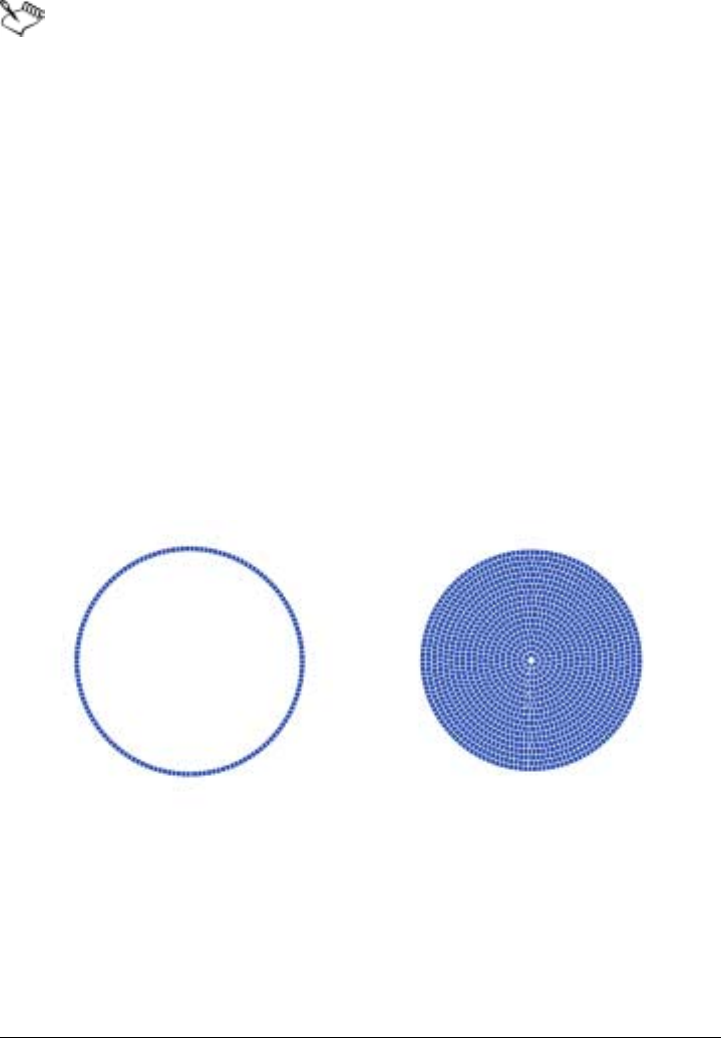
Mosaics 321
Once you choose Re-render Mosaic, Corel Painter erases any part of the image
that is not a tile or grout.
Using Stroke Selections and Fill Selection Commands
The Stroke Selections and Fill Selection commands let you apply mosaic tiles to
selections. These features work only with path-based selections created with the
Rectangular Selection, Oval Selection, and Lasso tools. You might need to use the
Transform Selection command to convert a channel-based selection to a path-based
selection when you work with mosaics. For more information, refer to “Getting Started
with Selections” in the Help.
Stroking and filling a selection are appropriate only when you change a parameter
between operations — for example, if you change the tile color or dimensions. The
Stroke Selection command applies a single row of tiles as an outline along the selection
path. To fill an entire selection with tiles, you can make the selection using the Lasso
tool. To fill an oval or rectangular selection, you must first use the Stroke Selection
command to apply tiles to the selection path, and then use the Fill Selection command
to fill the rest of the selection.
To fill an oval or rectangular selection, you must first use the Stroke Selection command to apply tiles to
the selection path (left), and then use the Fill Selection command to fill the rest of the selection (right).
To create a mosaic in a selection
1Set up the area you want to tile as an active selection.
2Choose Canvas menu > Make Mosaic.
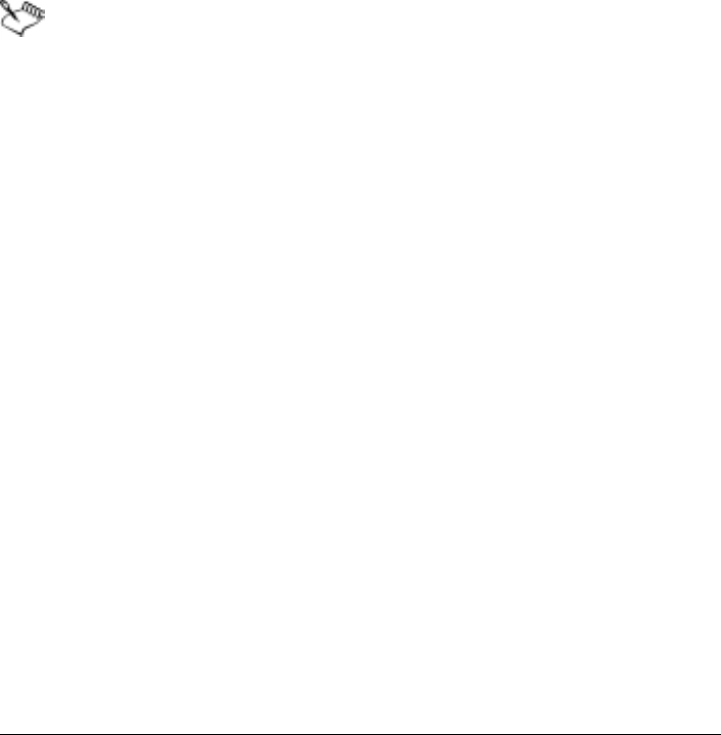
322 Corel Painter User Guide
3In the Make Mosaic dialog box, choose Dimensions or Randomness from the
Settings pop-up menu.
4Choose the color for the tile and the grout.
5Use the Options pop-up menu to select the command you want:
• Stroke Selections creates one row of tiles along each selection path.
• Fill Selection applies multiple rows of tiles, working in from the path until the
selected area is filled with tiles.
The Fill Selection command works with selections made using the Lasso tool. To fill
an oval or rectangular selection, you must first choose the Stroke Selection
command, and then choose the Fill Selection command.
In some cases, Corel Painter might not put a tile in every space. You can fill
openings by choosing the Apply Tiles tool and putting them the tiles in
yourself.
If you want to change the tiling of an area, you can use the Remove Tiles tool
to clear it. Then you can reapply tiles manually
Working with Mosaics and Layers
Each mosaic tile you create is stored as a resolution-independent object within the
Corel Painter image database. This means that if you resize an image composed of
mosaic tiles, your image can be displayed at the same quality as if it had been created
at a higher resolution originally.
The image that you see displayed is the set of all mosaic tiles rendered as an image
onto the canvas. Mosaics can be re-rendered at any time. Once you exit the Make
Mosaic dialog box, you can treat this rendered image just like any photograph or
painting. You can paint it, apply effects to it, select portions of it, or increase the
canvas size. However, once you choose Re-render Mosaic, Corel Painter erases any
image that is not a tile or grout.
The first thing the Mosaic feature does is cover the entire canvas with grout. This
obliterates images that are on the canvas, but leaves objects that hover above the
canvas, such as layers and shapes. These objects are not deleted, but they do cover up
the mosaic you’re working on. The Mosaic feature works with the entire canvas. You
cannot apply mosaic tiles inside a layer.

Mosaics 323
Compositing Mosaics with Other Images
If you want to composite a mosaic with another image, you have several options:
• Using multiple documents — You can create the mosaic in its own document.
When you’re satisfied with the result, float and copy the mosaic to the document
where you want to composite it. For information on creating floating objects, see
“Working with Floating Objects” on page 66.
• Using layers — You can float the non-mosaic portion of the image. Create the
mosaic on the canvas. When you’re satisfied with the mosaic, you can drop the
layers.
• Layering mosaics — If a mosaic already exists in the document when you open the
Make Mosaic dialog box, it is assumed that you want to keep existing tiles, and
Corel Painter does not apply new grout. To avoid this, you can use a layer to create
a mosaic on top of an image.
To layer mosaics
1Create a mosaic, and then click Done to exit the Make Mosaic dialog box.
2Fill, paint, and drop layers to create your background.
3When you return to the Make Mosaic dialog box, your background image remains,
and you can place tiles over the top of it.
Removing tiles placed on an image reveals the grout, not the image.

John Taylor Dismukes’s highly detailed, imaginative style, mixing the old and the new, has been
named "Gothic Tech." His trendsetting designs and illustrations are sought by companies and agencies
on a global level, from Microsoft, Time Warner, Toshiba, and Pepsi, to newsmakers and entertainment
companies such as Universal, WB Network, and Columbia TriStar.
Art by John Taylor Dismukes: 3D Halloween concept design

Using Shapes 327
Using Shapes
Shapes are vector-based objects that you can draw, modify, and fill. Shapes can be open
or closed. They can be simple lines, curves, or text outlines. You can create and edit
shapes with the precision of a drawing program and integrate them with the
Natural-Media environment in Corel Painter.
In this chapter you’ll learn how to create shapes and set their stroke and fill attributes.
You’ll learn how to modify shapes, edit their outlines, and convert them to pixel-based
layers.
An image created with shapes.
Getting Started with Shapes
In Corel Painter, you work mainly with bitmaps, or raster images. Bitmaps are
composed of tiny squares called pixels; each pixel is mapped to a location in an image
and has a numerical color value. The location and color value data are stored as bits —
hence, the name bitmaps.
Shapes are vector objects, and you can work with them in Corel Painter in much the
same way you work with vector objects in drawing programs like CorelDRAW® and
Adobe® Illustrator®. Vector graphics are made up of lines, curves, objects, and fills
that are all calculated mathematically.

328 Corel Painter User Guide
Corel Painter draws shapes in an anti-aliased fashion. This anti-aliasing gives objects a
smooth edge, as opposed to the jagged edges apparent in some drawing programs.
Some clipart objects actually look like photographic elements when they are imported
into Corel Painter and displayed with anti-aliasing.
Anti-aliased shapes are typically slower to appear on the screen in Corel Painter than
are aliased objects in drawing programs, so you may want to use your drawing
program for most of your object creation. You can then import the vector artwork into
Corel Painter, tweak it with the drawing tools, and add some Natural-Media effects.
Shapes in Corel Painter can be interleaved with pixel-based layers, so you can layer
both styles of artwork in a single composition. You can convert vector objects and
groups into pixel-based layers and use any of the effects or painting tools on these
floating objects to create Natural-Media artwork.
You can also convert shapes to selections and vice versa. The tools for adjusting shapes
allow precise control over the outline path, so you may want to use shapes to create
some of your selection paths. For more information about selections, refer to
“Selections” in the Help.
Understanding Shapes as Layers
In Corel Painter, shapes are implemented as layers. When you create a shape, a new
layer is added to your document. The shapes you create are listed on the Layers palette.
Many of the options and controls for working with pixel-based layers apply equally to
shapes. For example, you can apply effects to shapes or give them a composite method
to control how the shape interacts with the underlying image.
Shapes follow the same layering rules as pixel-based layers, and you can manipulate
them in many of the same ways. Shapes differ from pixel-based layers by the type of
data they contain. Shapes are vector objects; pixel-based layers are constructed of
pixels.
If you want to work with pixel information in a shape, you can convert the shape to a
pixel-based layer. In many cases, Corel Painter will do this for you automatically. For
example, if you want to apply a fill to a shape, Corel Painter asks if you want to
commit the shape to an image layer. You can also deliberately convert a shape or group
of shapes to a pixel-based layer.
For more information about layers, refer to “Layers” on page 43.

Using Shapes 329
To convert a shape to a pixel-based layer
1Choose the Shape Selection tool in the toolbox.
2Click the shape to select it.
3Do one of the following:
• Choose Shapes menu > Convert To Layer.
• Click the Convert To Layer button on the property bar.
• On the Layers palette, click the shape’s layer, click the palette menu arrow, and
choose Convert To Default Layer.
You can paint a shape, but you must first convert the shape to a pixel-based
layer. For more information, see “Painting Shapes” on page 350.
Working with Bézier Lines
The paths used to create shapes are known as Bézier lines. They can be straight or
curved, and they consist of anchor points connected by line segments.
When the path is a curve, “wings” extend from the anchor points. The wings are
represented by a straight line and are tangent to the curve. The wings have control
“handles” on them. By dragging the wing handle, you can change the curvature of the
line segment.
Paths can be modified by using anchor points and wing handles.
Shapes can be open (with endpoints) or closed (without endpoints).
anchor point
wing handle

330 Corel Painter User Guide
Open paths contain endpoints; closed paths do not.
Anchor points can be either smooth or corner points. A smooth point allows you to
manipulate the segments on both sides of an anchor point by dragging a handle. A
corner point restricts the manipulation of the segments to the one side of the anchor
point that has a handle. For information about converting smooth or corner anchor
points, see “To convert a smooth or corner point” on page 343.
An anchor point can be a smooth point (top) or a corner point (bottom).
Creating Shapes
You can create shapes in the following ways:
• by using the Pen, Quick Curve, Rectangular Shape, Oval Shape, or Text tool
• by converting a selection path to a shape
• by acquiring an Adobe Illustrator file (File menu > Acquire)
• by pasting an Adobe Illustrator object from the Clipboard
endpoint
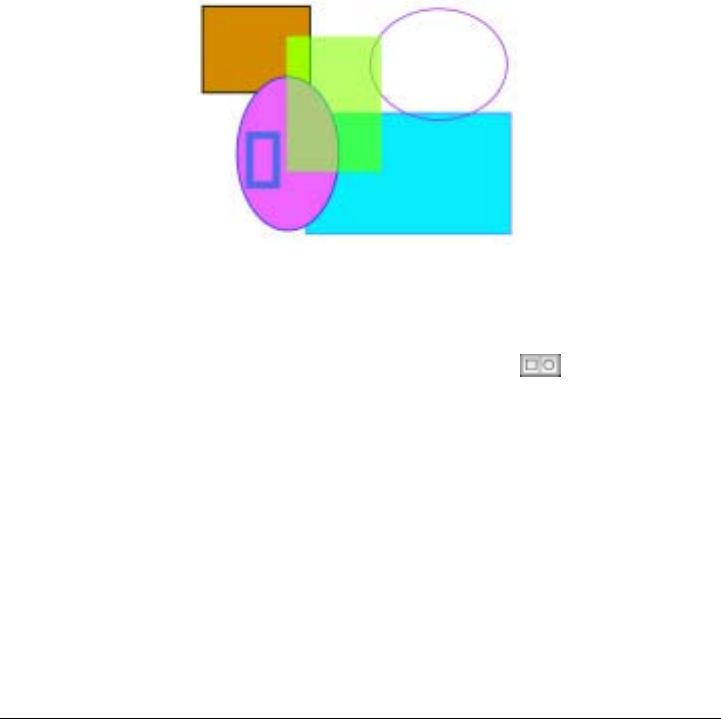
Using Shapes 331
As you create shapes, Corel Painter gives them default attributes for stroke and fill. For
instructions on setting the default shape attributes, refer to “Shapes Preferences” on
page 39 and “Setting Shape Attributes” on page 336.
The shape manipulation tools are in the toolbox. By holding down Command
(Mac OS) or Ctrl (Windows), you can toggle between the Shape Selection tool and any
of the shape design and editing tools. Toggling makes it convenient to quickly select a
wing handle or anchor point before editing it.
Using Shape Object Tools
You can create shapes by using the Rectangular Shape tool or Oval Shape tool.
Shapes created with the Rectangular Shape tool and Oval Shape tool.
To create a rectangle or an oval
1Choose the Rectangular Shape tool or the Oval Shape tool in the toolbox.
2On the property bar, set any of the following attributes:
• the Stroke check box, when enabled, lets you create a shape with a stroke, or an
outline.
• the Stroke Color pop-up menu lets you choose a stroke color if the Stroke check
box is enabled.
• the Fill check box, when enabled, lets you create a shape with a fill.
• the Fill Color pop-up menu lets you choose a color for the fill if the Fill check
box is enabled.
3Drag in the document window.

332 Corel Painter User Guide
If you want to create a perfect square or circle, hold down Shift while you
drag.
The property bar and the Info palette display information about the shape.
To display the Info palette, choose Window menu > Show Info.
Using the Pen Tool
The Pen tool lets you use Bézier lines to create shapes. You can use the Pen tool to draw
straight lines or smooth, flowing curves, and you can create shapes containing any
combination of straight and curved lines.
You can easily adjust shapes after you create them. For more information, refer to
“Editing Shapes” on page 339. You can also convert between smooth and corner
points. For more information, refer to “Adjusting Curvature” on page 342.
Clicking creates anchor points connected by straight line segments.
Dragging curves the segments between points.
To draw a Pen tool shape
1Choose the Pen tool in the toolbox.
2In the document window, click where you want to begin.
3Do one of the following:
• To make a straight line segment, click where you want to end the segment.
Corel Painter draws a straight line between the two anchor points.

Using Shapes 333
Shapes created with straight line segments.
• To make a curved line segment, drag to create a new anchor point and wing.
The angle and length of the wing determine the curvature of the path. The
farther you drag, the longer the wing and the deeper the curve.
Shapes created with curved line segments.
4Repeat step 3 as often as necessary, combining straight and curved segments until
you have the shape you want.
5Finish the shape by doing one of the following:
• Close the shape by clicking or dragging the first anchor point.
• Close the shape by clicking the Close Shape button on the property bar.
• Hold down Command (Mac OS) or Ctrl (Windows) to temporarily access the
Shape Selection tool, and click outside the shape to deselect it.
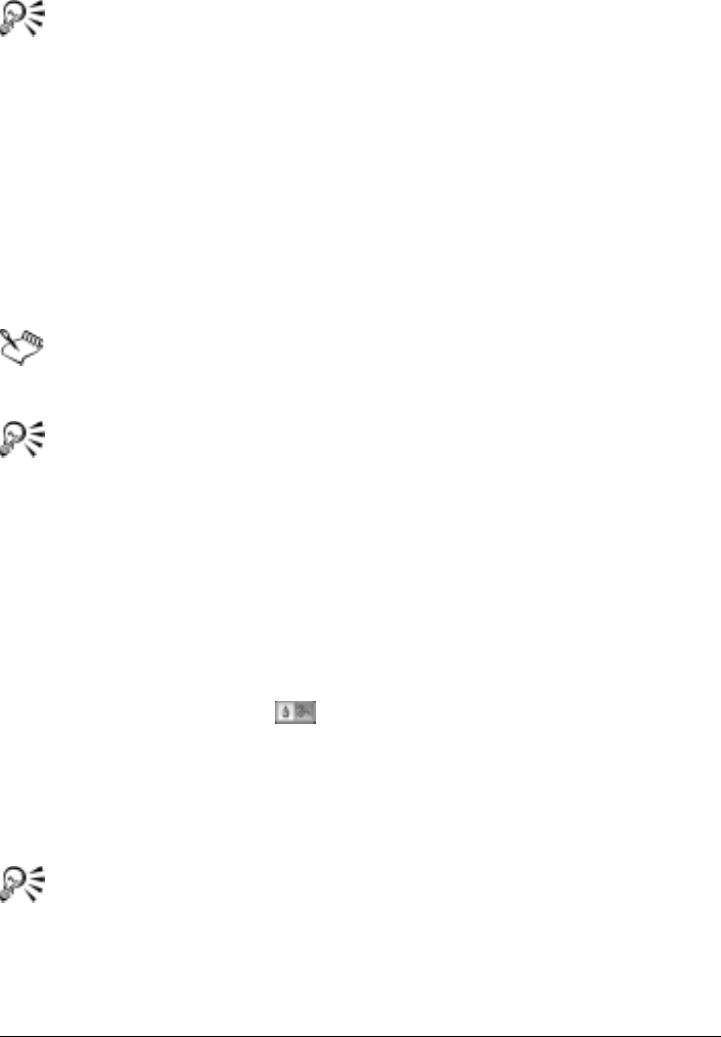
334 Corel Painter User Guide
You can constrain the placement of the points by snapping to the grid. For
information about displaying and snapping to the grid, refer to “Using the
Grid” in the Help.
Each click or drag adds to the path. If you unintentionally add to the path,
press Delete (Mac OS) or Backspace (Windows) to remove the last anchor
point.
To add to an open shape path
1Click an endpoint with the Pen tool.
2Click or drag where you want to add an anchor point.
You can add to a path from an endpoint only. You cannot add to a closed path,
or to the middle of an open path.
You can also select an endpoint by holding down Command (Mac OS) or Ctrl
(Windows) and clicking the endpoint or dragging a marquee over it.
Using the Quick Curve Tool
The Quick Curve tool allows you to create Bézier curves by drawing freehand lines, as
if you were drawing with a pen or pencil.
To draw a freehand shape
1Choose the Quick Curve tool in the toolbox.
2Click where you want to start the shape or line, and drag.
As you drag, a dotted line appears. When you stop dragging, the Quick Curve
shape appears.
If you want to close the shape, finish at the same point where you began.
You can add to either endpoint of a Quick Curve shape by selecting the
endpoint and dragging out from it. To select an endpoint, hold down
Command (Mac OS) or Ctrl (Windows), and click the endpoint or drag
over it.

Using Shapes 335
Draw freehand shapes with the Quick Curve tool.
Converting Selections to Shapes
Converting a selection to a shape enables you to edit the contour by using the Shape
Edit tools. When you are satisfied with the contour, you can convert the shape outline
back to a selection. For more information, refer to “To convert a shape to a selection” in
the Help.
If you are simply scaling, rotating, or skewing a selection path, use the Selection
Adjuster tool. If you must edit the profile of the curve, convert the selection to a shape.
Working from a selection path also lets you create shapes based on regions of the
image. For example, if you used the Magic Wand tool to select a region of common
color, you could convert the Magic Wand selection path to a shape. When the selection
is pixel-based, Corel Painter may create multiple shapes.
You can convert a selection to a shape.
To convert a selection to a shape
1Do one of the following:
• Create a selection in the image.
• From the Selection Portfolio palette, drag a selection to the document window.
2Choose Select menu > Convert To Shape.
Corel Painter converts the selection to a shape, giving it the default shape
attributes. The new shape appears on the Layers palette.

336 Corel Painter User Guide
For best results, the selection should be path-based. If the selection is
pixel-based, from the menu bar choose Select > Transform Selection to
convert it to a path-based selection.
Acquiring Shapes from Adobe Illustrator
You may want to work with shapes you’ve created in Adobe Illustrator. Corel Painter
lets you import the shape contents of files in Illustrator EPS format.
Some Adobe Illustrator file options are not supported by Corel Painter. Patterns,
placed images, gradients, masks, and text cannot be interpreted by Corel Painter. If
the file contains text, you must convert the text to outlines.
Corel Painter also supports PostScript on the Clipboard when you paste content into a
Corel Painter document. This convention allows applications to exchange high-quality
vector PostScript information. With PostScript on the Clipboard, you can copy from
Illustrator and paste into Corel Painter when both applications are running.
Corel Painter imports PostScript content from the Clipboard, but exports only pixel-
based layers and selections.
To acquire shapes from Adobe Illustrator
1In Corel Painter, choose File menu > Acquire > Adobe Illustrator File.
2In the Adobe Illustrator File dialog box, select the Adobe Illustrator file, and click
Open.
To convert text in Adobe Illustrator
1In Adobe Illustrator, select the text using a selection tool.
2Choose Type menu > Create Outlines.
Setting Shape Attributes
When you apply a stroke, also known as an outline, to a shape, you can choose the
color, opacity, and width of the path outlining the shape. You can also control the way
line ends are drawn and joined. In addition, you can apply a fill to a shape by coloring
the area enclosed by the stroke. When you fill a shape, you can choose the color and
opacity of the fill.

Using Shapes 337
Stroke and fill attributes apply to both open and closed shapes. Before filling an open
shape, Corel Painter closes the shape by connecting the endpoints with a straight line.
The Flatness attribute controls how many straight lines the program uses to
approximate a curve when printing. PostScript output devices create curved lines by
linking a series of short, straight lines that progress in angle. The smaller the flatness
setting, the greater the number of straight lines, and the more accurate the curve.
You can also change the default shape attributes. For more information, refer to
“Shapes Preferences” on page 39. In addition, you can paint a shape after the shape has
been committed to a pixel-based image layer.
To set shape stroke attributes
1With the Shape Selection tool , click a shape whose stroke attributes you want to
change, and press Return (Mac OS) or Enter (Windows).
You can select multiple shapes by holding down Shift while clicking the shapes.
2In the Set Shape Attributes dialog box, enable the Stroke check box to apply an
outline to the selected shape.
To remove the stroke, disable the check box.
3Double-click the chip, choose a color from the Colors dialog box, and click OK.
4Adjust the Opacity and Width sliders to control the opacity and width of the
stroke.
5Click one of the following Line Cap icons to control the endpoints of open shapes.
Choose Projecting , Round , or Butt .
6Click one of the following Line Join icons to determine how corners are created
when two segments meet.
Choose Miter , Round , or Bevel .
7Adjust the Miter Limit slider.
When lines are joined at a sharp angle, a sharp corner is created. You can set the
miter limit to smooth out the sharpness.
8Click Set New Shape Attributes.
You can also specify the Stroke, Stroke Color, Fill, and Fill Color attributes on
the property bar when you select a shape with the Shape Selection tool.

338 Corel Painter User Guide
To set shape fill attributes
1With the Shape Selection tool , click a shape whose fill attributes you want to
change, and press Return (Mac OS) or Enter (Windows).
You can select multiple shapes by holding down Shift while clicking the shapes.
2In the Set Shape Attributes dialog box, enable the Fill check box to apply a stroke
to the selected shape.
To remove the fill, disable the check box.
3Double-click the chip, choose a color from the Color dialog box, and click OK.
4Adjust the Opacity slider to control the opacity of the fill.
5Click one of the following icons:
• Fill Overlaps to fill overlapping areas of multiple shapes.
• Don’t Fill Overlaps to leave overlapping areas unfilled. Multiple overlaps
alternate between filled and not filled.
6Click Set New Shape Attributes.
You can also specify some fill and fill color attributes on the property bar
when you select a shape with the Layer Adjuster or Shape Selection tool.
You can also use the Effects menu > Fill command or the Paint Bucket
tool to fill a shape. Because these methods apply pixel data to the region,
Corel Painter first converts the shape to a pixel-based layer. For more
information, refer to “Filling an Area with Media” on page 163.
To set shape flatness
1With the Shape Selection tool , click a shape whose flatness you want to change,
and press Return (Mac OS) or Enter (Windows).
You can select multiple shapes by holding down Shift while clicking the shapes.
2In the Set Shape Attributes dialog box, adjust the Flatness slider.
3Click Set New Shape Attributes.
Usually, it is not necessary to change the flatness setting. You may want to
change it to adjust for a particular high resolution printer or to avoid a
PostScript limitcheck error. Check with your output service to find out if they
have a recommended flatness setting.
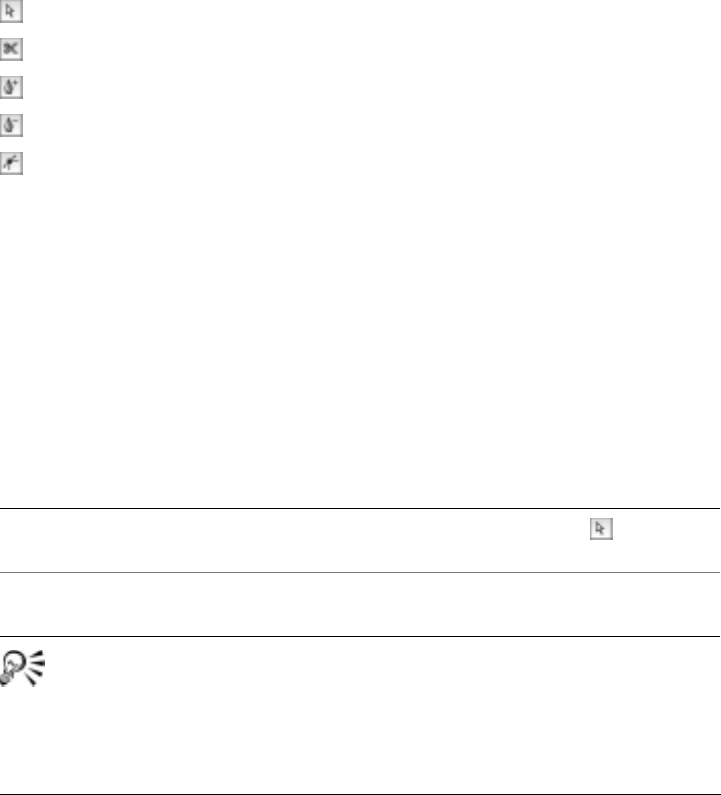
Using Shapes 339
A change in flatness appears only in your output, not on your screen.
Editing Shapes
Corel Painter provides five tools for editing shapes. As you work, you’ll switch tools
based on the type of changes you’re going to make. From any other editing tool, you
can toggle to the Shape Selection tool by pressing Command (Mac OS) or Ctrl
(Windows).
Shape Selection drags anchor points and control handles.
Scissors cuts the segment at the point you click.
Add Point adds an anchor point where you click on the curve.
Remove Point deletes the anchor point you click.
Convert Point changes anchor points from corner points into smooth points and
vice versa.
Selecting a Shape
If you don’t see the shape’s outline path, you’ll want to select the shape — to display
the path and anchor points — before proceeding. It is easier to work when you can see
the path and points. For information about selecting shapes as layers, refer to
“Selecting Layers” on page 52.
To select shapes
If you are using the Layer Adjuster tool, you can double-click a shape to
switch to the Shape Selection tool and select the shape.
To Do the following
Select a shape With the Shape Selection tool , click a
shape.
Select multiple shapes Hold down Shift, and click the shapes with
the Shape Selection tool.

340 Corel Painter User Guide
Adding, Deleting, and Moving Anchor Points
You can add anchor points to create new vertices or curves. You can delete anchor
points to change the shape of the path or to smooth a contour that has unnecessary
points. This might occur when you draw with the Quick Curve tool or create a shape
from a selection.
You can move one or several anchor points by dragging. You can also move one or
several points by averaging, which moves two or more anchor points with respect to
each other.
Averaging is useful when you need to join the endpoint of one curve to the endpoint of
another. Averaging the endpoints in both directions brings them precisely on top of
each other. Now, when you join the endpoints, Corel Painter merges them to a single
point, through which the path continues. If you don’t average points that are near each
other, Corel Painter joins them with a segment.
To add or delete an anchor point
•With the Shape Selection tool , select a shape.
Use the Add Point tool to add anchor points to the path.
To Do the following
Add an anchor point Choose the Add Point tool in
the toolbox, and click where you want to add
the point.
Delete an anchor point Choose the Remove Point tool
in the toolbox, and click the anchor point
you want to delete.
The anchor point is deleted, but the path
remains connected.
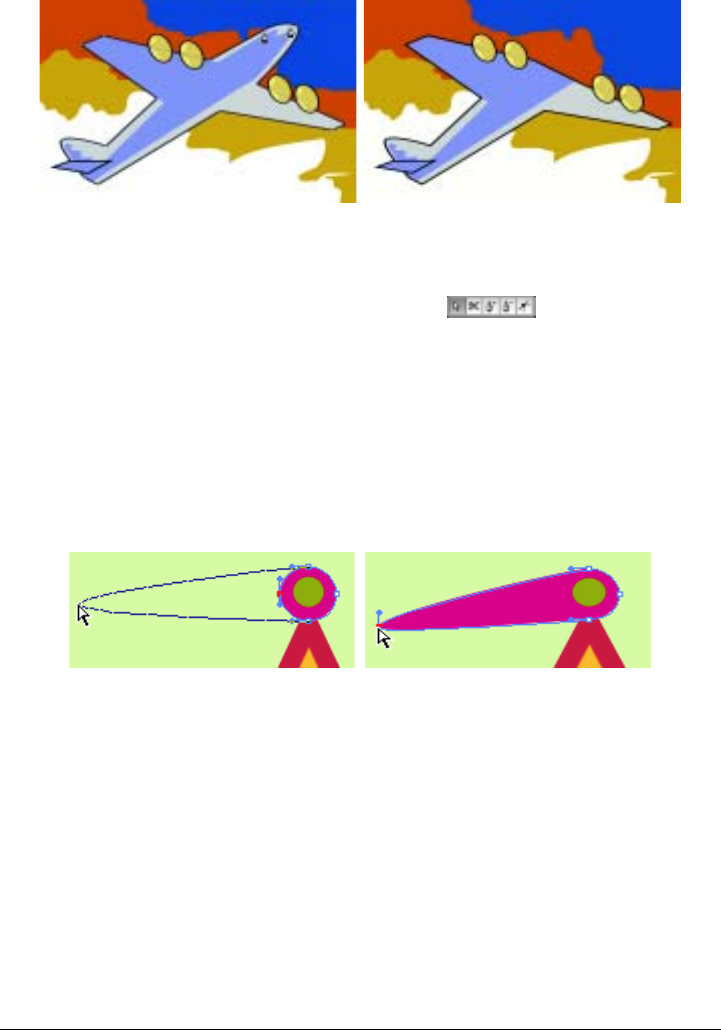
Using Shapes 341
Use the Remove Point tool to delete anchor points.
To move anchor points
1Choose the Shape Selection tool from the toolbox .
2Click an anchor point to select it, or marquee select a point by dragging over it.
If you want to select several points, marquee select them by dragging over them.
All anchor points within the marquee are selected, including those from other
shapes.
If you want to add to the selection, hold down Shift and select more points.
3Drag the point to a new location.
If you have selected several points, dragging one moves them all.
Drag an anchor point to move it.
To average anchor points
1With the Shape Selection tool, select the anchor points you want to average.
It is often easiest to drag a marquee around the points you want.
2Choose Shapes menu > Average Points.
3In the Average Points dialog box, enable an option to determine the axis for the
averaging.

342 Corel Painter User Guide
Adjusting Curvature
The angle and length of the wing determine the curvature of the segments on either
side of the anchor point. The longer the wing, the deeper the curve.
The result of moving a wing depends on whether the anchor point is defined as a
smooth point or a corner point. Two connecting curves (or straight lines) share one
anchor point, which can be a smooth or corner point. The wings on smooth and corner
points behave differently.
When you drag the handle on one wing of a smooth point, the curves on both sides of
the point change. With a smooth point, you adjust the angle of the wings concurrently.
A corner point is converted to a smooth point.
When you drag the handle on one wing of a corner point, only the curve on that side
of the point changes. With a corner point, you can adjust the angle of the wings
independently.
To adjust a curve
1Choose the Shape Selection tool from the toolbox .
2Click a shape to select it.
If an anchor point’s wings are not displayed, drag over the anchor point to display
them.
3Drag a wing handle to set the curve you want.
You can also adjust a curve by dragging a line segment with the
Shape Selection tool.
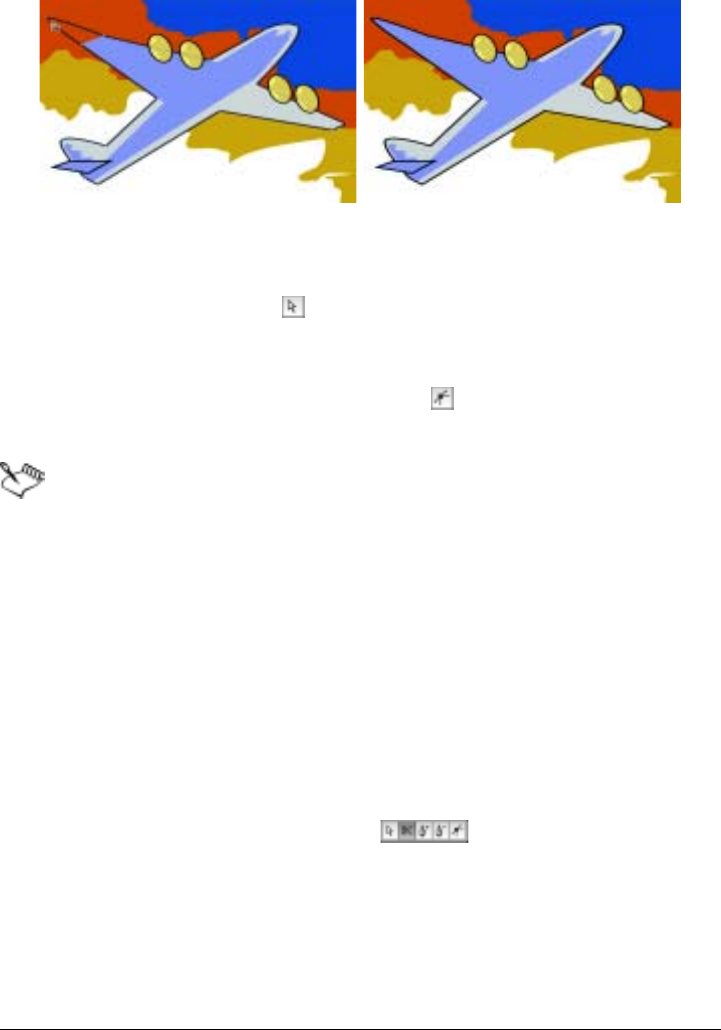
Using Shapes 343
Use the Shape Selection tool to drag a wing handle.
To convert a smooth or corner point
1With the Shape Selection tool , select an anchor point.
If the anchor point’s wings are not displayed, drag over the anchor point to display
them.
2Choose the Convert Point tool from the toolbox .
3Click one of the anchor point’s wing handles.
After converting a point, you must use the Shape Selection tool for further
adjustments. If you try to adjust an anchor point with the Convert Point tool,
the anchor point will be converted again.
Cutting and Joining Shape Segments
You may want to open a shape so that you can add new curves or connect another open
shape. You can do this with the Scissors tool. You can also connect any two endpoints
— of the same shape or of different shapes. This lets you close an open shape or attach
one shape to another.
To cut a shape
1Choose the Scissors tool from the toolbox .
2Click where you want to split the shape (you cannot click an endpoint).
The hot spot of the Scissors tool is where the blades cross. Position the cross on the
line.
The scissors snap closed momentarily, and two new anchor points are created.
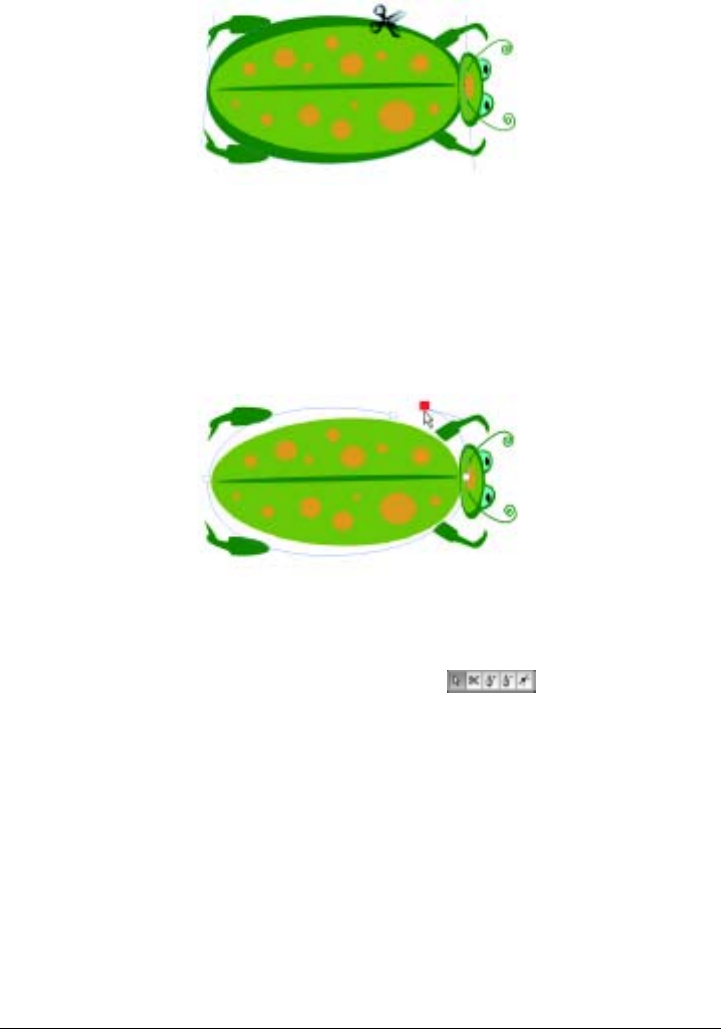
344 Corel Painter User Guide
The Scissors tool opens and closes to cut the path.
3Choose the Shape Selection tool from the toolbox, and drag the new anchor points
or segments.
The new anchor points are on top of each other, and both are selected. If you try to
drag one of the new anchor points with the Shape Selection tool and both move,
deselect them, then drag one point away.
Once a path is cut, it can be moved.
To join endpoints
1Choose the Shape Selection tool from the toolbox .
2Select the two anchor points you want to join.
You can do this either by marquee selecting both points, or by clicking the first
point and then holding down Shift and clicking the second point.
3Choose Shapes menu > Join Endpoints.
A straight line is created between the two points.

Using Shapes 345
Use the Shape Selection tool to select two endpoints.
Use the Join Endpoints command to connect two endpoints.
Transforming Shapes
Corel Painter lets you manipulate and modify shapes in a number of ways. You can
resize, rotate, or skew shapes. You can also create shape duplicates and groups. Before
you can work with a shape, you must select it. For more information, see “To select
shapes” on page 339.
Resizing Shapes
You can resize a shape or group of shapes by directly manipulating the objects with the
Layer Adjuster tool or by using the Scale command.
To resize a shape
1Choose the Layer Adjuster tool from the toolbox.
2Select the shape or group you want to resize.
A selection rectangle appears around the shapes. The rectangle has a handle on
each corner and side.
3Drag one of the handles to resize the selected shape.
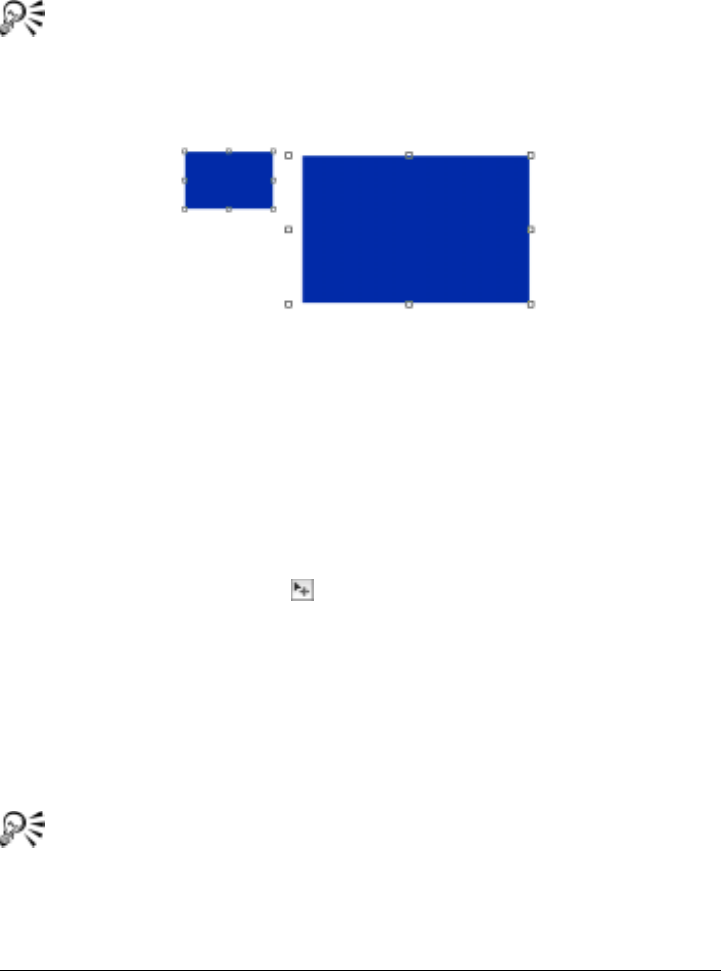
346 Corel Painter User Guide
To resize in one dimension, drag one of the side handles. To resize in both
dimensions, drag one of the corner handles.
You can maintain the proportions by holding down Shift as you drag.
You can also choose Effects menu > Orientation > Scale to increase or
decrease size by a fixed percentage. For more information, refer to “Scaling
Images” in the Help.
Resizing a shape.
Rotating Shapes
You can rotate a shape or group of shapes by directly manipulating the objects with the
Layer Adjuster tool or by using the Rotate command. For more information on the
Rotate command, refer to “Rotating Images” in the Help.
To rotate a shape
1Choose the Layer Adjuster tool from the toolbox.
2Select the shape or group you want to rotate.
A selection rectangle appears around the shapes. The rectangle has a handle on
each corner and side.
3Choose Effects menu > Orientation > Rotate.
4In the Rotate Selection dialog box, specify a number of degrees.
This command works for both shapes and pixel-based layers.
You can also rotate a shape by holding down Command (Mac OS) or Ctrl
(Windows) and dragging a corner handle.
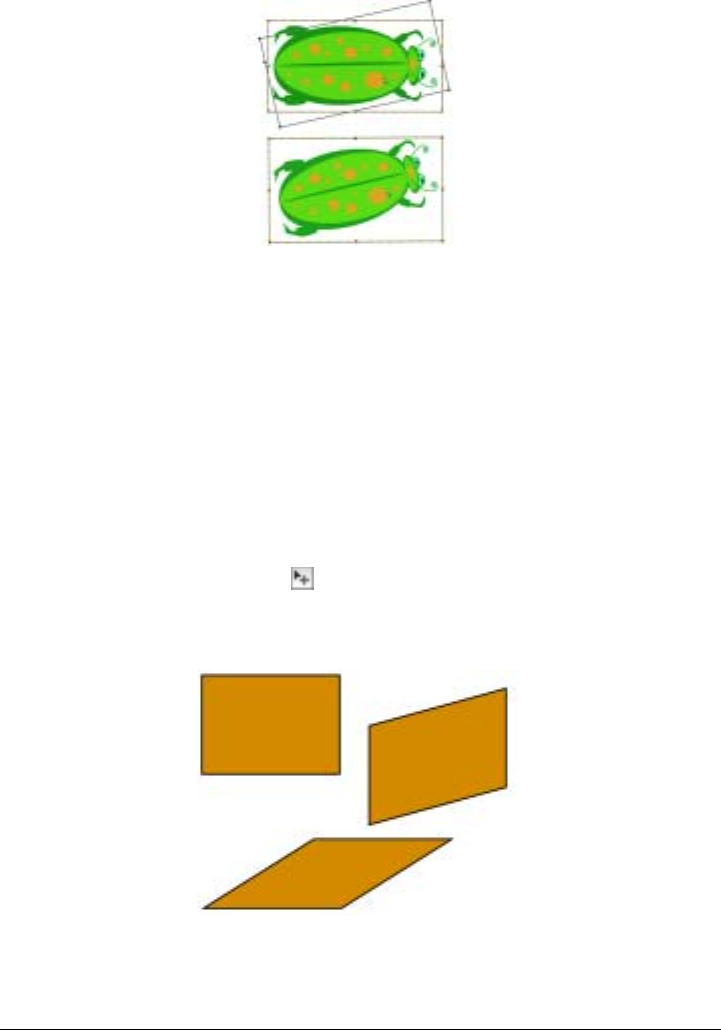
Using Shapes 347
Rotating a group of shapes.
Skewing and Distorting Shapes
You can skew a single shape or a group of shapes. When you skew a shape, you drag a
middle selection handle to give the shape a unique slant.
You can also distort a layer, regardless of whether it consists of a pixel-based bitmap or
a vector shape. When you distort a shape or group of shapes, a box with eight selection
handles appears, and you can drag any handle to create an interesting effect.
To skew a shape
1Choose the Layer Adjuster tool from the toolbox.
2Select the shape or group you want to skew.
3Hold down Command (Mac OS) or Ctrl (Windows), and drag a middle handle.
A rectangle (upper left) is skewed by dragging a side middle handle
(upper right) and by dragging the top middle handle (bottom).
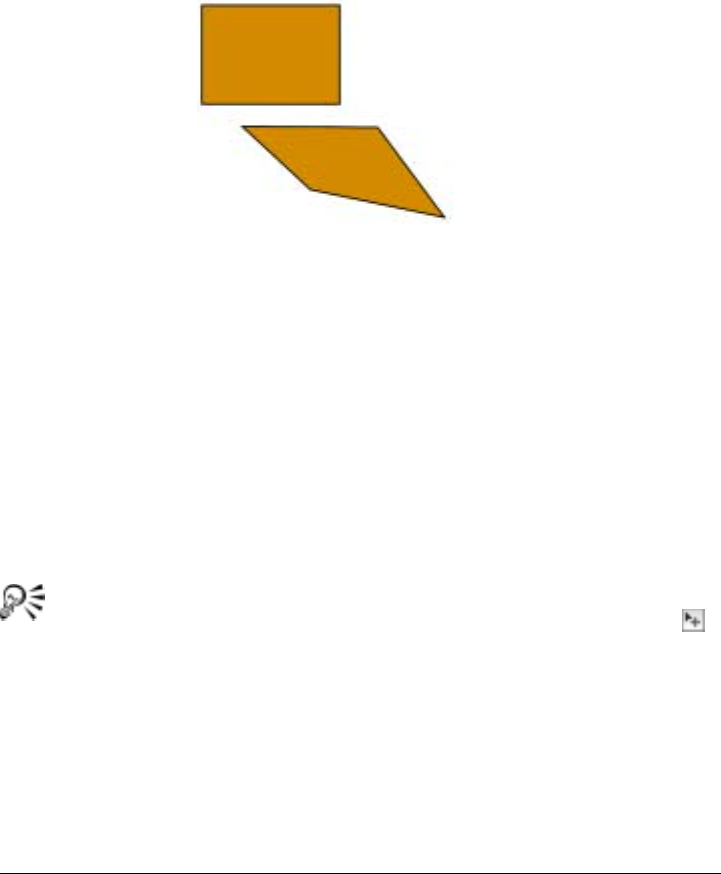
348 Corel Painter User Guide
To distort a shape
1Select a shape.
2Choose Effects menu > Orientation > Distort.
3With the Distort Selection dialog box open, drag the selection handles in the
document window.
Distorting a shape
Flipping Shapes
You can flip a shape horizontally or vertically.
To flip a shape
1Select a shape.
2Choose one of the following:
• Effects menu > Orientation > Flip Horizontal
• Effects menu > Orientation > Flip Vertical
You can also flip a shape by first selecting it with the Layer Adjuster tool .
Then, to flip horizontally, drag a top or bottom handle past the opposite
handle. To flip vertically, drag a side handle past the opposite handle.
Duplicating Shapes
Duplicating creates an identical copy of the selected shape. Corel Painter also lets you
duplicate shapes using compound transformations. Transformed duplicates are created
according to the options you set.

Using Shapes 349
To duplicate a shape
1Choose the Layer Adjuster tool from the toolbox.
2Hold down Option (Mac OS) or Alt (Windows), and or drag across the shape.
To change duplication settings
1Choose Shapes menu > Set Duplicate Transform.
2In the Set Duplicate Transform dialog box, specify any of the following settings:
• Translation controls where Corel Painter creates duplicate shapes in relation to
the original. The offset values are in pixels. When H. Offset and V. Offset are
both zero, the duplicate is created precisely on top of the original. If both values
are 100, the duplicate appears 100 pixels lower and 100 pixels to the right.
Negative values offset the duplicate up and to the left, respectively.
• Scaling controls the size of duplicates in relation to the original. The scale values
are percentages.
• Constrain Aspect Ratio maintains the aspect ratio of the shape. If you want to
create distorted duplicates, disable this option and specify different percentages
for horizontal and vertical scaling.
• Rotation lets you specify a number of degrees to rotate duplicates. Positive
values rotate counterclockwise, and negative values rotate clockwise.
• Slant controls the degree of slant applied to duplicates. Positive values slant
duplicates to the right. Negative values slant them to the left. Slant accepts
values between –90° and 90°. However, as values approach the extremes, the
duplicate shape becomes a streak.
To create a transformed duplicate
1Select the shape you want to transform.
2Choose Shapes menu > Duplicate.
Corel Painter creates a duplicate shape according to the specifications you’ve set.
This duplicate is now the selected shape. You can choose the Duplicate command
again, or press Command + ] (Mac OS) or Ctrl + ] (Windows), to repeat the
transformation on the new shape.

350 Corel Painter User Guide
The oval shape was duplicated by using rotation only (left). The number 5
shape was duplicated by using translation, scaling, and rotation (right).
Painting Shapes
You can paint on a shape, but you must commit it to a pixel-based layer. Once
committed, you cannot re-access the shape’s vector controls.
To paint a shape
1Choose a brush category and variant from the Brush Selector bar.
You cannot use Watercolor or Liquid Ink brushes to paint a shape.
2Click the shape on the Layers palette.
3Click the palette menu arrow, and choose Convert To Default Layer.
The shape is committed to a pixel-based layer.
4Enable the Preserve Transparency check box on the Layers palette.
5Paint on the shape.
After a shape has been committed to an image layer, none of the
shape-specific editing features are available. To modify the content of a new,
pixel-based image layer, see “Editing Layers” on page 63.
You cannot paint on a shape using Watercolor brushes or Liquid Ink brushes,
because they automatically create their own special layers.

Using Shapes 351
Combining Shapes
You can combine shapes in various ways to achieve particular results. You can group
shapes so that you can manipulate several at the same time. You can also compound
two or more shapes to create a single shape. You can also blend single shapes or groups
of shapes, so that they appear to be one shape morphing into another.
Grouping Shapes
Shapes can be grouped, allowing you to manipulate multiple shapes as a single unit.
Shapes are created on layers, so you can group them in the same way you group layers.
You cannot scale, rotate, flip, or distort groups that contain a mixture of pixel-based
layers and shapes. You must manipulate these two types of entities independently
before you group them. For more information about grouping, refer to “Viewing Layer
Position” on page 59.
Creating Compound Shapes
In a compound shape, two shapes are combined into a single shape. The resulting
shape takes on the attributes of the shape on the topmost layer. If the shape is filled,
any overlapping areas are not filled. Compound shapes can be used to cut a void in one
shape using another shape. You can release a compound shape, which reverts it to the
original shapes.
The rectangle and the oval are combined to create a compound shape.
To create a compound shape
1Choose the Shape Selection tool , hold down Shift and select both shapes, or drag
over the shapes to marquee select them.
2Choose Shapes menu > Make Compound.
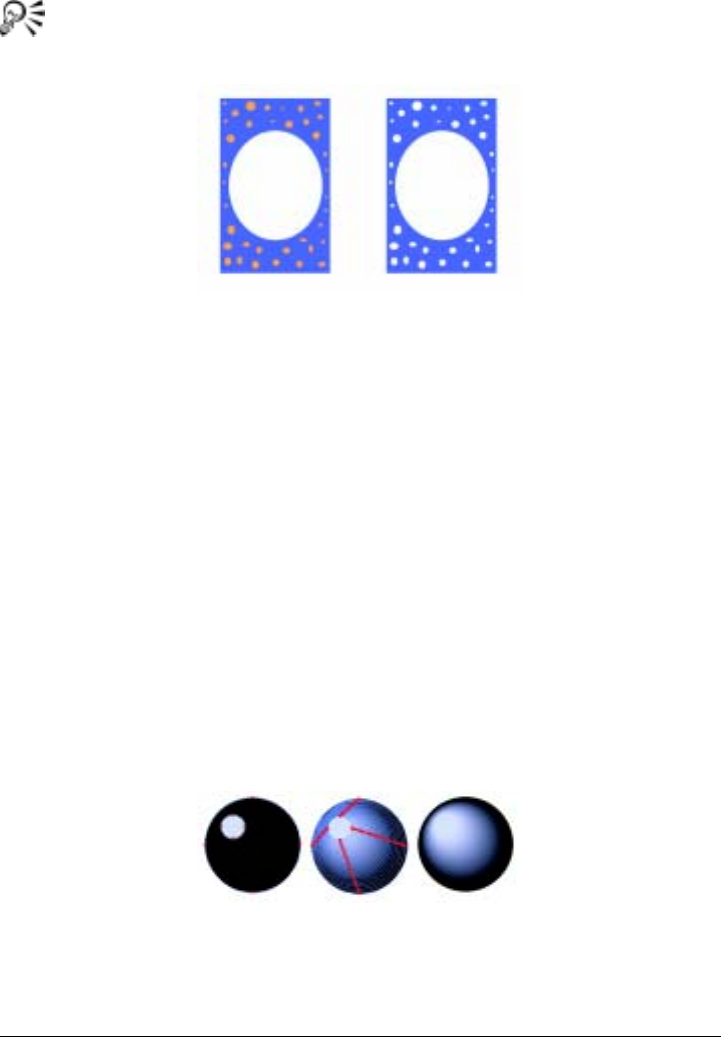
352 Corel Painter User Guide
You can combine a shape with a compound shape to create a nested
compound shape.
The resulting compound shape can itself be used again
to create another compound shape.
To release a compound shape
1Select a compound shape.
2Choose Shapes menu > Release Compound.
Blending Shapes
Blending creates intermediate shapes between two or more selected shapes, which is
useful for morphing one shape into another. It is also used to simulate shading on
irregular shapes. Blending applies to stroke and fill attributes as well as to the shape
size.
You can blend a shape group with another group, but you can’t blend a single shape
with a group.
Blending groups with other groups offers interesting effects, especially if the groups
are blends themselves.
The small circle is blended with the large circle to create a shading effect.
To blend shapes
1Position the shapes you want to blend.
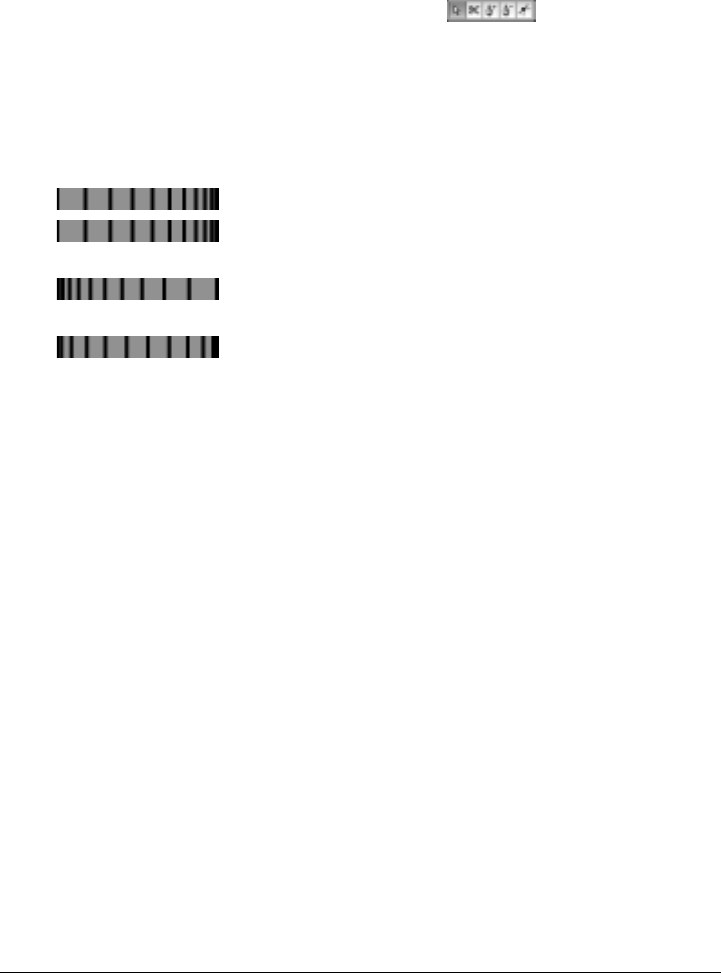
Using Shapes 353
2On the Layers palette, arrange the shape layers.
Blends will progress from lower to higher layers.
3Choose the Shape Selection tool from the toolbox .
4Hold down Shift, and select the shapes you want to blend.
5Choose Shapes menu > Blend.
6In the Blend dialog box, type a value in the Number of Steps box to control how
many intermediate shapes are created.
7Enable one of the following ramp type options:
• Blend shapes are evenly spaced.
• Spacing starts wide and decreases toward the end of the
blend.
• Spacing starts small and increases toward the end of the
blend.
• Spacing is wide in the middle and decreases toward both
ends.
8Choose one of the following Color Space options:
• RGB to progress color directly over the course of the blend.
• Hue CW to progress color clockwise in the color wheel to reach the destination
color.
• Hue CCW to progress color counterclockwise in the color wheel to reach the
destination color.
9Type a value between 0.01 and 100 in the Perspective Factor box to control the
spacing of intermediate shapes.
With a Perspective Factor of 1.0, the shapes are spaced evenly. With a Perspective
Factor of less than 1.0, shapes are closer at the beginning of the blend and farther
apart at the end of the blend. With a Perspective Factor greater than 1.0, shapes
are farther apart at the beginning of the blend and closer at the end of the blend.
10 Enable any of the following check boxes:
• Arc Length Matching to blend shapes containing a different number of anchor
points.
• Align Shape Start Points to base the orientation of intermediate shapes on the
orientation of the start and end shapes. When disabled, Corel Painter bases the
orientation of intermediate shapes on the starting point (first anchor point) of
the start and end shapes. This can create a “tumbling” appearance in the
intermediate shapes.
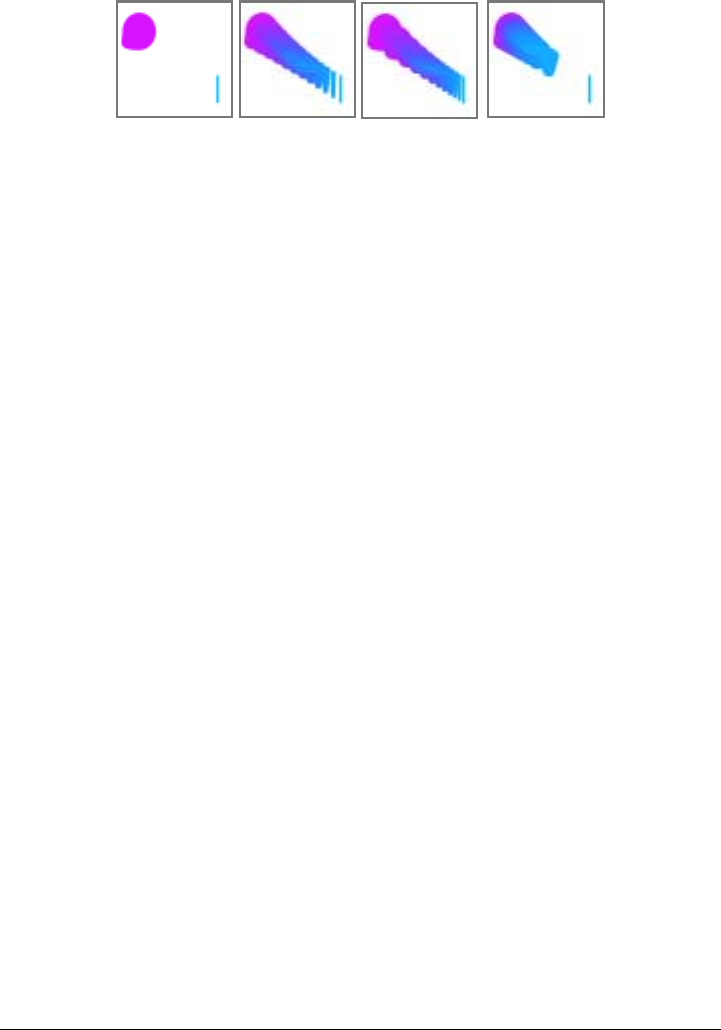
354 Corel Painter User Guide
From left to right: Two shapes with no blending; blending with a perspective factor of 1.0;
blending with a perspective factor of 4.0; and blending with a perspective factor of 0.1.
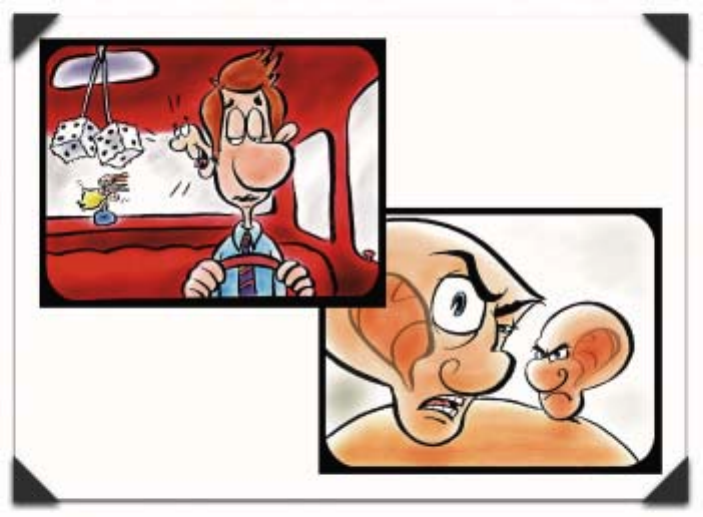
Art by John Ryan: Animation storyboard for a radio commercial
John Ryan, with his wife, Joyce, and partner Robert Pope, launched animation and visual effects
company Dagnabit! in 2001. John began his career as an art director for public television, before he
and his wife set up their own company. In 1989, he went to work at DESIGNfx, the animation
and special effects division of Crawford Post Production, Atlanta. He was the director of animation
at Click 3X, Atlanta, for five years, before once again starting his own company.
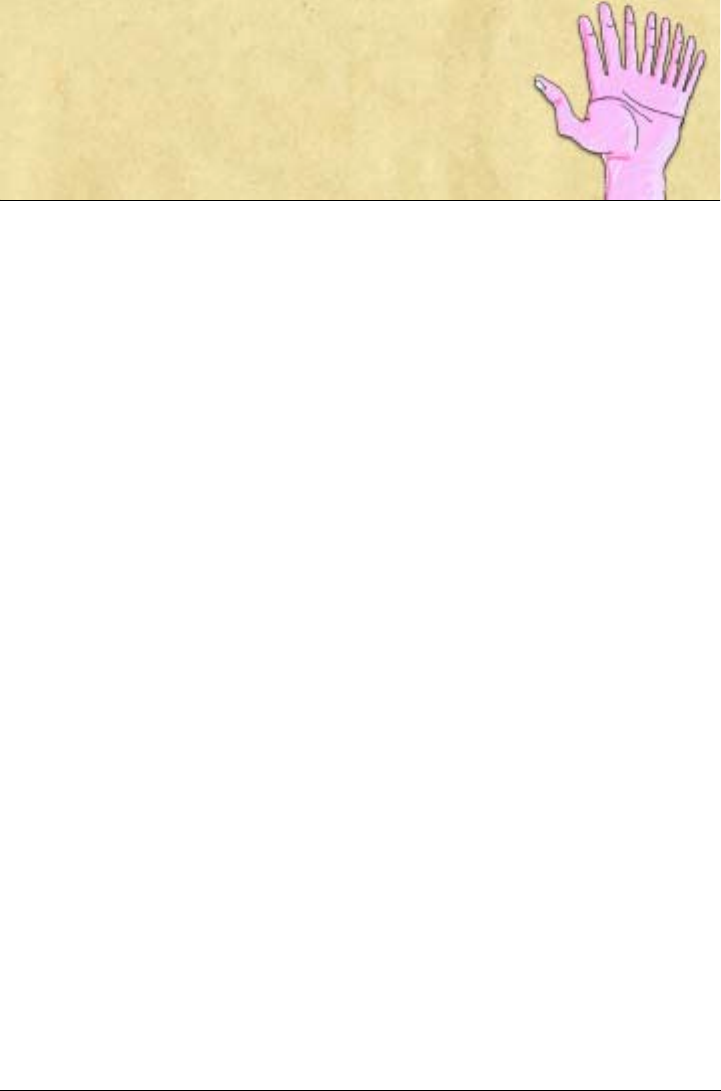
Animation and Video 357
Animation and Video
An animation is a series of drawings with progressive change. When viewed in rapid
succession, they create a moving image.
Because Corel Painter has its full suite of Natural-Media tools and effects available for
each image in a frame stack, it’s an extraordinary program for creating original
animation.
The animation features in the Corel Painter application give you the power to work
with video and create animations, including onion skinning and rotoscoping. Onion
skinning is a feature animators use to view previous and future frames while working
in the current frame. Rotoscoping is the ability to paint on and apply effects to existing
movies. Corel Painter controls allow you to clone, trace, edit, and combine movies.
In this chapter, you’ll learn animation and compositing techniques. You’ll learn how to
create, open, and modify movies, how to navigate the Frame Stacks palette, and how
to export movies to QuickTime or VFW/AVI format (Windows only).
Creating Animations and Video
Corel Painter lets you create animation as well as modify QuickTime or AVI movies. It
also offers you a range of options for critical elements of your animation, such as color,
frame rate, and file size.
Creating Animations
Corel Painter offers several methods to create original animations:
• Cloning or tracing video. For more information, refer to “Cloning a Movie” on
page 376.
• Manipulating layers
• Drawing each frame by hand

358 Corel Painter User Guide
Corel Painter has powerful features that simplify animation and help you get the best
quality possible. You can use the Natural-Media tools in Corel Painter to create your
own animations with a traditional look. Onion skinning allows you to see multiple
frames at the same time. In Corel Painter, you can view up to five frames at a time: the
current frame and four other frames adjacent to it. This will help you determine where
the next frame of motion should be drawn. You can play back your animation over and
over as you create it, to be sure you have the correct flow of movement.
Working with Video
Corel Painter offers certain ways of working with video that are not offered by
QuickTime or Audio Video Interleaved (AVI) applications. You can use any of the
Corel Painter brushes, textures, and effects to modify a QuickTime or AVI movie. You
can paint directly into video frames, you can clone video using the Natural-Media
tools, and you can combine or composite portions of one video clip with another.
When you open a QuickTime or AVI movie, Corel Painter automatically converts it to
a frame stack. A frame stack is a series of images, each equal in size and resolution.
Corel Painter does not provide features for working with audio.
When you’re finished with the movie in Corel Painter, you can save it as a QuickTime,
AVI, or animated GIF file. You can then open the QuickTime or AVI movie in a
video-editing application, like Adobe® Premiere®, in which you can add sound effects
and other finishing touches.
Considering Color
You might want to create a color set for the animation. Creating a color set helps you
better control the use of color. For example, you wouldn’t want the colors of your
characters shifting between frames. Using a particular color set prevents this from
happening. You might want to set up an image of each character with annotations to
specify which colors to use in which areas.
Not all colors are suitable for video. For information about converting colors for use in
video, refer to “Posterize by Using a Color Set” in the Help. For more information
about using color, refer to “Getting Started with Color” on page 77.

Animation and Video 359
Considering Frame Rate
Frame rate describes the number of image frames displayed per second (fps). The frame
rate can determine not only how big a file your animation is, but also how smooth the
motion appears.
When you save a movie as an AVI file, you can specify the rate of display. This doesn’t
necessarily mean that what you specify is what you’ll experience. Factors like frame
size, compression method, and computer speed can prevent some movies from
achieving their set rate. If your animations will be viewed on the computer only, frame
rates of 8, 10, and 12 fps are good choices. If your animations will be viewed
elsewhere, you should consider the the following frame rates:
• The frame rate of film is 24 fps.
• The frame rate of NTSC video is 30 fps (29.97 fps in broadcast video). NTSC is the
video standard used in the United States.
• The frame rate of Phase Alternating Line (PAL) video is 25 fps.
These frame rates are sufficient to produce smooth, continuous motion with filmed or
video-recorded subjects.
Animation drawings contain far less detail than live-action images. The difference in
the level of detail allows animations to be produced at frame rates significantly lower
than those designed for live action. Because of the smoothness of color fills and
continuity between images, animations can look quite nice at rates between 10 and
15 fps.
You must consider frame rates to know how many drawings are needed to make
actions smooth, natural, and consistent throughout the project.
The computer can display frames at any reasonable rate. The Frame Stacks palette
provides control over frame display rates within Corel Painter. You can preview an
animation at a rate of 1 to 40 fps.
You can’t display different sections of a movie at different rates. What you can do is
create sections separately at different rates and then modulate them to the same rate
before joining them. This is the kind of work you’ll do in your video-editing
application.
To set the preview frame rate
•On the Frame Stacks palette, adjust the Playback slider.
The frame rate is displayed to the right of the slider.
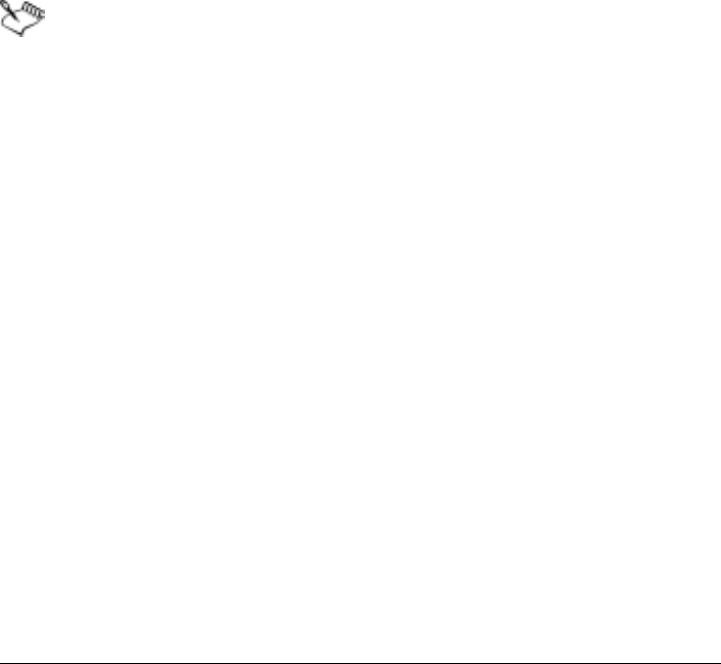
360 Corel Painter User Guide
Considering Movie File Sizes
Keep in mind that video and animation can produce huge files. When planning a
project, be careful not to overestimate your available disk space. For an idea of disk
requirements, consider this example: Each 640 by 480-pixel, 24-bit color frame is 1.2
MB. At this size, a 12-fps, 30-second animation would consume more than 400 MB of
disk space.
To calculate the disk space required for a frame stack
1Using pixels as the unit of measurement for width and height, calculate the
number of bytes required to save the frame stack with the following formula:
(Frame Width) × (Frame Height) × (Bytes per Pixel) × (Number of Frames)
2Divide the product of the formula in step 1 by 1,024 to convert to kilobytes.
Bytes per pixel is determined by the storage type. For example, 24-bit color
with an 8-bit alpha channel uses 4 bytes per pixel. For more information
about storage types, refer to “Creating a Movie” on page 362.
When you save a movie as QuickTime or AVI, the file size can be reduced by
compression. For more information on compression, refer to “Saving and
Exporting Movies” on page 378.
Understanding the Frame Stacks Palette
In Corel Painter, digital video and animation files are known as movies or frame stacks.
Whether you’re working with imported video or building a new animation, the tools
are the same. They’re found on the Frame Stacks palette and in the Movie menu.
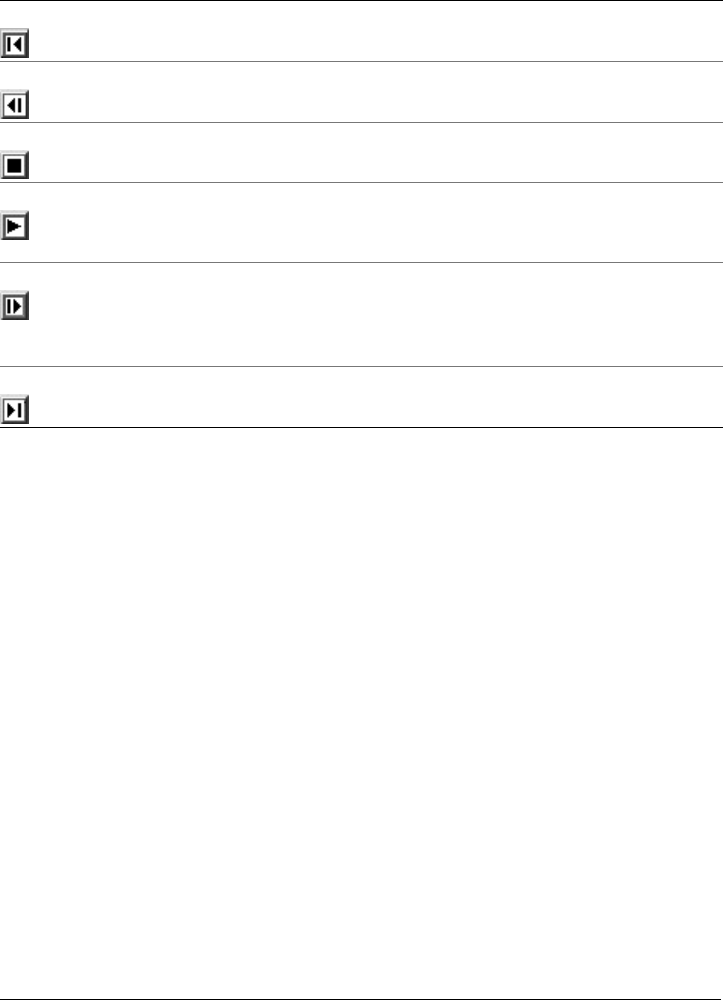
Animation and Video 361
The frame stack format in Corel Painter is a series of images, each equal in size and
resolution. The Frame Stacks palette appears whenever you open or create a movie file.
The Frame Stacks palette must stay open while you work with a movie.
You work in one frame at a time — the one appearing in the document window. The
Frame Stacks palette helps you navigate the frames in the stack and choose which
frame to modify.
Each frame in a frame stack can have one layer. For example, if you drag an item from
the image portfolio onto a frame, Corel Painter places the image on a layer. You can
move the image around using the Layer Adjuster tool. However, when you move
between frames or close the file, Corel Painter drops all layers — the layer is deleted,
and the layer’s content is flattened onto the background canvas. Refer to “Layers” on
page 43 for more information about working with layers.
The Frame Stacks palette displays thumbnails of several frames. The frame numbers
appear under the thumbnails. The current frame is shown with a red triangle over it.
The number of thumbnails is determined by the layers of onion skin you’ve chosen. By
default, QuickTime and AVI files are opened with two layers of onion skin. For more
information on onion skinning, refer to “Understanding Onion Skinning” on
page 365.
Icon Keyboard shortcut Comment
Rewind Home Returns to the first frame in a stack
Step Reverse Page Down Moves back one frame
Stop Command +. (Mac OS) or
Ctrl+. (Windows) Halts a frame stack that’s playing
Play Command +Shift+P (Mac
OS) or Ctrl+Shift+P
(Windows)
Plays the frame stack
Step Forward Page Up Advances to the next frame. When a
frame is the last in the stack,
Corel Painter adds a new frame to the
end and advances.
Fast Forward End Advances to the last frame in the
stack

362 Corel Painter User Guide
Getting Started with Movies
You can create movies Corel Painter, or you can open movies created in common
animation formats, such as QuickTime or Video for Windows (AVI).
Creating a Movie
The first step in creating a new animation is to create a movie file. Corel Painter
automatically saves movie files as you proceed from frame to frame.
To create a movie
1Choose File menu > New.
2In the New dialog box, select the frame size and paper color you want.
The standard digital video frame is 640 by 480 pixels, which is a 4:3 aspect ratio.
Many people work at sizes consistent with this aspect ratio.
3Enable the Movie option, type a number in the Frames box, and click OK.
Remember, you can add and delete frames at any time.
4In the Enter Movie Name dialog box, type a name for the movie, and click Save.
5In the New Frame Stack dialog box, choose a number of onion skin layers.
The number of onion skin layers determines the number of frames displayed in the
Frame Stacks palette. For more information about onion skinning, refer to
“Understanding Onion Skinning” on page 365.
6Choose one of the following storage types:
• 8-bit gray (for 256 levels of gray)
• 8-bit color system palette (for 256 colors)
• 15-bit color with 1-bit alpha (for 32,768 colors and a layer for a channel)
• 24-bit color with 8-bit alpha (for 16.7 million colors and a layer for an
anti-aliased channel)
7Click OK.
When the movie opens, the Frame Stacks palette appears, and the document
window displays the first frame of the movie.

Animation and Video 363
The storage type lets you specify the color depth for saving each frame. This
applies to the saved frame stack, not to your work in the current frame. For
example, choosing 256 colors as the storage type still allows you to work with
a selection and 24-bit tools in the document window for the current frame. As
soon as you change frames, however, the image is saved in the 256-color
format, and the selection is lost. If you want to maintain selections in saved
frames, you’ll need to choose the 15-bit or 24-bit storage type. These storage
types allow you to take advantage of compositing options that require a
selection layer.
Opening a Movie
Quite often, you’ll start by opening a movie created in another program — like a
captured video segment. You’ll also open an existing movie if you worked on a frame
stack earlier and now want to return to it.
For efficiency, don’t bring in more video frames than you’re going to work on. For
example, if you have a two-minute video clip and you want to paint on the first 10
seconds, don’t open the entire clip in Corel Painter. You’re better off separating the
first 10 seconds in your editing application and bringing in just those frames. After
finishing that clip in Corel Painter, you can join it to the other part in your editing
application.
You can also import a movie that has been saved as a series of numbered files. For more
information, refer to “Working with Numbered Files” on page 381.
To open a Corel Painter frame stack
1Choose File menu > Open.
2In the Open (Mac OS) or Select Image (Windows) dialog box, locate the frame
stack, and click Open.
When a file is selected, the dialog box shows the frame size, file size, and number of
frames. If a preview is available, it shows a thumbnail of the first frame.
3In the Open Frame Stack dialog box, choose the number of onion skin layers you
want to appear in the Frame Stacks palette.
The number you choose also determines the number of thumbnails visible in the
Frame Stacks palette.
4Click OK.
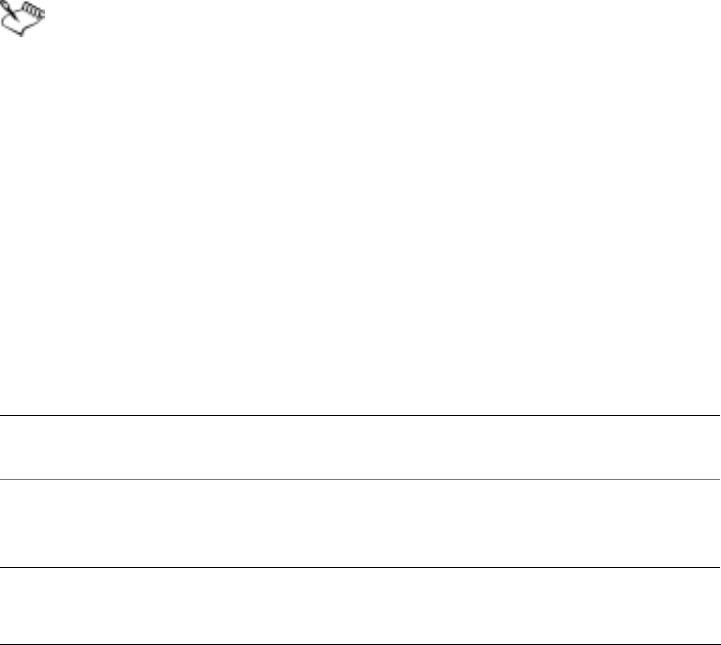
364 Corel Painter User Guide
The Frame Stacks palette appears and the document window displays the first
frame of the movie.
To open a QuickTime or AVI movie
1Choose File menu > Open.
2In the Open (Mac OS) or Select Image (Windows) dialog box, locate the movie,
and click Open.
When a file is selected, the dialog box shows the frame size, file size, and the
number of frames. If a preview is available, it shows a thumbnail of the first frame.
3In the Enter Movie Name dialog box, type a name in the Save As (Mac OS) or File
name (Windows) box, and click Save.
The Frame Stacks palette appears, and the document window displays the first
frame of the movie.
When you open a QuickTime or AVI movie, Corel Painter makes a frame
stack copy of the movie. This ensures that the original won’t be changed.
Frame stacks are uncompressed, so you need an adequate amount of disk
space to create them. For example, a 1-MB QuickTime or AVI movie can
become a 20-MB frame stack.
Navigating through a Movie
You can select a frame by clicking its thumbnail on the Frame Stacks palette. You can
also easily jump to any frame in a movie.
To select a frame
To Do the following
Select a frame On the Frame Stacks palette, click the
frame’s thumbnail.
Jump to a particular frame Choose Movie menu > Go To Frame, and
type the frame number in the Go To Frame
dialog box.

Animation and Video 365
Understanding Onion Skinning
Traditional cartoon animators work on an onion skin paper that allows them to see a
sequence of frames through transparent layers. They then draw successive frames,
using the previous frames for reference. Seeing the several images superimposed helps
increment the action evenly.
Corel Painter lets you work in two to five layers of onion skin. You specify the number
of layers when you open a frame stack. To change the number of onion skin layers, you
must close the file and reopen it.
Onion skin view (Tracing Paper on). Each frame in the frame
stack represents one onion skin layer.
The Frame Stacks palette displays a linear view of the onion skin layers. Each
thumbnail represents one onion skin layer, and the thumbnail of the current frame has
a red triangle above it.
You can change the current frame by clicking any thumbnail in the Frame Stacks
palette. This lets you view a frame in any position of the onion skin sequence. For
example, if you want to display the reference frames before the current frame, set the
current frame to the far-right position in the palette. If you want to display the frames
before and after the current frame, set the current frame to the middle thumbnail in
the palette.
To use the onion skin feature
•Choose Canvas menu > Tracing Paper.
In the document window, the current frame appears darkest. Each frame moving
away is progressively fainter.
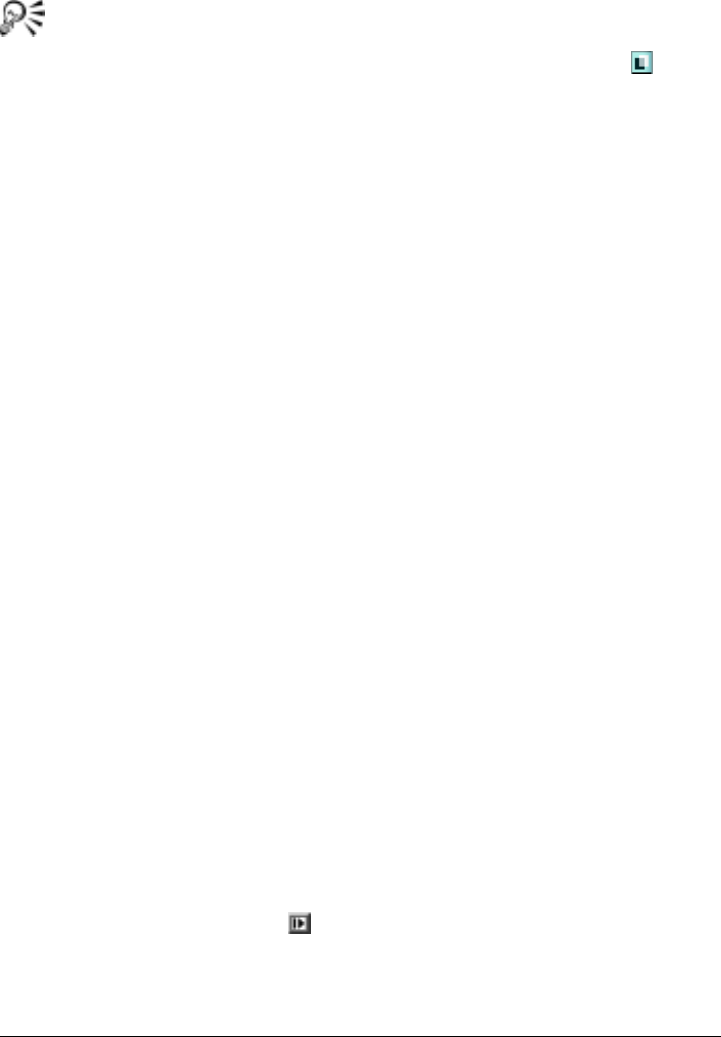
366 Corel Painter User Guide
You can also turn Tracing Paper on and off by pressing Command+T
(Mac OS) or Ctrl+T (Windows) or clicking the Tracing Paper icon on the
vertical scroll bar.
Animating with Layers
One of the simplest ways to create animation in Corel Painter is to move an item from
the Image Portfolio palette across a series of frames. This is the most basic example of
animating with layers. Adding multiple layers allows you to make more complex
animations.
You can also group layers and move them simultaneously, but be careful. When you
leave a frame, Corel Painter drops the layers in that frame. When a layer is dropped, its
contents are merged with the canvas and can no longer be accessed separately. For this
reason, you may want to work from the background forward; start by animating
what’s farthest from your point of view. For more information, refer to “Merging
Layers with the Canvas” on page 62.
You can also rotate a layer. Rotating a layer can degrade its on-screen image quality,
but this does not affect its printed quality.
To create motion with layers
1Choose File menu > New.
2Enable the Movie option, and type 1in the Frames box.
3In the Enter Movie Name dialog box, choose a location, enter a name for the file,
and click Save.
4In the New Frame Stack dialog box, enable one of the Layers of Onion Skin
options.
5Choose Window menu > Show Image Portfolio.
6Drag an item from the Image Portfolio palette to the document window.
A new layer is created.
7Position the layer to the far left of the document window.
8Click the Step Forward button on the Frame Stacks palette.
A new frame is added and becomes the current frame. The layer in the previous
frame is merged with the canvas. In the new, current frame, the layer is active.

Animation and Video 367
9On the keyboard, press the arrow keys to move the portfolio image.
10 Repeat steps 6 and 7 for as many frames as you want to add.
11 In the last frame, deselect the layer.
12 Click the Play button on the Frame Stacks palette.
The portfolio image moves across the screen.
Repeating Actions
You can repeat actions to create an animated cycle. Take, for example, a blinking eye.
For this type of action, draw the cycle once, and repeat it as many times as needed.
To create a clean cycle, the beginning and ending images must be the same. For
example, in an animation of a blinking eye, the eye would be open at the beginning
and the end. This way, when the end of one cycle is “hooked up” to the beginning of
the next, the action continues smoothly.
Scrolling a background is another example of a cycled action. Commonly, a subject
remains in one place while the background slides by.
Modifying a Movie
Frames can be added to, or deleted from, a movie. You can also erase the contents of a
frame while leaving the frame in the movie. These changes cannot be undone, so it’s
best that you create your animation in segments and combine them when you are
finished.
Adding Frames and Movies to a Movie
You can add frames at any time to your movie. Frames can be added at the end or
beginning of a movie or between any frame in the stack. You can also repeat the last
frame at the end of the stack.
You can combine movies by inserting the contents of one movie into another. You can
insert only a Corel Painter movie, not a QuickTime or AVI movie or numbered files.
You need to convert a QuickTime or AVI movie to a Corel Painter frame stack before
you insert it into another Corel Painter movie.

368 Corel Painter User Guide
The movie you insert must have the same frame size (width and height) as the current
movie. You’ll get better results if the movie you insert is designed for the same frame
rate as the current movie. You can insert a movie before or after a specific frame, at the
start of a movie, or at the end of a movie.
To add frames to a movie
1Choose Movie menu > Add Frames.
2In the Add Frames dialog box, type the number of frames in the Add box.
3Enable an option for frame placement.
For example, to add six blank frames before frame 10, type 6 in the Add box,
enable the Before option, and type 10 in the Frame box.
To repeat the last frame
1On the Frame Stacks palette, click the Fast Forward button .
2Choose Movie menu > Clear New Frames to disable this command.
The check mark beside the Clear New Frames command is removed.
3Click the Step Forward button on the Frame Stacks palette.
You can add blank frames at the end of a movie with the Step Forward button
when the Clear New Frames command is enabled.
To insert a movie
1Choose Movie menu > Insert Movie.
2In the Insert Movie dialog box, choose where to insert the movie, and click OK.
3In the Select Movie dialog box, locate the movie you want to insert, and click
Open.
The movie you insert must have the same frame size (width and height) as the
current movie. You’ll get better results if the movie you insert is designed for
the same frame rate as the current movie.

Animation and Video 369
Deleting Frames and Erasing Frame Contents
When you delete frames, the frames are removed from the movie, and subsequent
frames are renumbered as necessary. Erasing clears the image to the paper color. The
frames themselves remain in the movie.
To delete or erase frames
Rotoscoping
Rotoscoping is the process of painting on a movie, applying effects to a movie, or
compositing a portion of the images from one movie with the images of another. This
is often done to make the action of a person filmed in one place appear on a
background filmed in another. You can also use rotoscoping to remove an element
from a video clip, as shown below in the frames from a short movie of an owl on a
roost. After the video was captured digitally, it was imported it into Corel Painter, and
the roost was removed frame by frame, using the masking tools.
To Do the following
Delete frames from a movie Choose Movie menu > Delete Frames. In
the Delete Frames dialog box, enter the
range of frames you wish to delete.
Erase frame contents Choose Movie menu > Erase Frames. In the
Erase Frames dialog box, enter the range of
frames you wish to erase.

370 Corel Painter User Guide
(1)The frame shows an owl perched on a roost. (2)The frame shows the
owl without the roost. (3)The frame shows the mask used to hide the roost.
Rotoscoping is also useful for adding a background to an animation. The process is the
same whether you work with digitized video or painted animation cells.
Applying Effects to a Single Frame
You can paint on, or apply effects to, any frame in a movie. You can do anything in a
frame that you can do in a single image: paint with a brush, add layers, or apply an
effect to a selection or to the entire image. Frames are automatically saved when you
select another frame, and the changes cannot be undone.
To paint on or apply an effect to a single frame
1On the Frame Stacks palette, go to the frame you want to work in.
To go to a frame, you can click on the thumbnail of the frame or click the Step
Forward button to advance to the frame. The selected frame appears in the
document window.
2Modify the image in the document window.
3When you’re ready to work on the next frame, click the Step Forward button.
Changing frames automatically saves the frame. You cannot undo changes after the
frame is saved.
12
3

Animation and Video 371
Applying Scripts to Movies
The Script feature in Corel Painter lets you repeat the same actions for each frame in a
movie. For example, you might want to apply an effect like Glass Distortion to a video
clip. You can record a script that applies the Glass Distortion effect to a single image
and then, with a single command, apply that script to the entire movie. A script can
contain almost any action — a single command, a series of commands, or the many
steps in creating an original drawing. You’ll devise scripts based on the needs of your
project.
You cannot undo changes after applying a script to a movie. Before applying a script to
a movie, you should become familiar with scripting and experiment with a separate
sample image. You might want to work with a copy of the movie, or you might apply
the script to a short sample movie to test it. For complete information on working with
scripts, refer to “Scripting” in the Help.
Using scripts to set grain position
You might use a script to apply a surface texture (paper grain) to an entire movie. In
this case, you have several options for the position of the grain in each frame. You can
put the grain in exactly the same position, move the grain randomly, or move it
linearly by a set number of pixels. For instructions on applying surface texture and dye
concentration, refer to “Applying Effects” in the Help.
Using scripts to apply brush strokes
Corel Painter lets you apply a recorded brush stroke to a movie. Corel Painter divides
the stroke into as many segments as there are frames and places the segments in
successive frames. This feature is most useful when used with the Image Hose. When
you apply a brush stroke to a movie using the Image Hose brush, Corel Painter
deposits one or more Nozzle images on each frame. If the Nozzle file is an animated
sequence — for example, a person walking — Corel Painter can drop successive
images on successive frames. Play the movie back, and the person walks across the
document window. For this to work, you must set up the Nozzle file appropriately and
have the right Image Hose brush size. For more information, refer to “Getting Started
with the Image Hose” on page 193.
To create a script for a movie
1Choose Window menu > Scripts.
2On the Scripts palette, click the palette menu arrow, and choose Record Script.

372 Corel Painter User Guide
3Perform the actions you want included in the script, and click the Stop button
on the Scripts palette.
4In the Script Name dialog box, type a name for the script in the Save As box.
To apply a script to a movie
1Open the movie to which you want to apply the script.
2Choose Movie menu > Apply Script to Movie.
3In the Apply Script to Movie dialog box, double-click a script.
Corel Painter applies that script to each frame in the stack. If you have few small
frames in your movie, and the script is not a complicated one, the script can be
applied quickly. If the movie has several large frames, a complicated script could
take a long time.
You can apply only scripts that do not create new images.
To set grain position with a script
1Record a script that applies surface texture or dye concentration to an entire image.
2Choose Movie menu > Set Grain Position.
3In the Set Grain Position dialog box, enable one of the following options:
• Grain Stays Still allows the grain to remain in the same position throughout the
movie.
• Grain Moves Randomly moves the grain as the movie plays. To use this option,
you must disable the Record Initial State option when recording your script. On
the Scripts palette, click the palette menu arrow, and choose Script Options. In
the Script Options dialog box, disable the Record Initial State check box.
• Grain Moves Linearly increments the grain movement. Specify the number of
pixels you want the grain to move horizontally and vertically from one frame to
the next.
4Click OK.
5Choose Movie menu > Apply Script to Movie to apply the grain script. Each frame
is textured according to your selected method.
To apply a brush stroke script
1On the Brush Selector bar, click the menu arrow and choose Record Stroke.

Animation and Video 373
2Create a brush stroke in the document window.
3Open a movie file.
4Choose Movie menu > Apply Brush Stroke to Movie.
Compositing Movies
You can composite two movies together into one — for example, you can composite a
foreground action against a new background. To do this, you must create a selection in
each frame of the foreground movie. For information about selections, refer to
“Creating Selections” in the Help. You can also create an alpha channel for each frame
and load it as a selection as you work. For more information, refer to “Creating,
Generating, and Importing Channels” in the Help.
When creating selections in the foreground movie, if the background is uniform — all
white, for example — you can take advantage of the automatic selection and script
features.
The drawing mode determines whether Corel Painter draws inside or outside of a
selection, so you can create selections that either include or exclude the foreground
image — whichever is easiest — then set the drawing mode accordingly. For more
information about drawing modes, refer to “Selecting a Drawing Mode” in the Help.
When you composite movies, it can take a long time to generate selections and paint
in the background for each frame. Using scripting in conjunction with the Auto Select
or Color Select commands can make this operation much easier and faster.
You can create a selection based on image characteristics or color. You do this once,
record the process as a script, and then apply the script to all frames in your movie. For
information about creating selections based on image characteristics, refer to “To
generate a selection with the Auto Selection command” in the Help. For information
about creating selections based on color, refer to “To generate a color-based selection”
in the Help. For information about recording scripts, refer to “Scripting” in the Help.
To composite one movie with another
1Open the foreground movie.
2In each frame, create a selection that defines the foreground image.
Because the foreground image continues to move, the selection in each frame must
be different.

374 Corel Painter User Guide
3On the Frame Stacks palette, click the Rewind button to go back to the first
frame in the stack.
4Open the background movie or image.
If the background is a movie, click the Rewind button.
5Do one of the following:
• Select the background movie and choose Movie menu > Set Movie Clone
Source.
• Select the background image and choose File menu > Clone Source > [Image
Title].
6Select the foreground movie.
7Click the drawing mode button in the lower-left corner of the document window,
and choose one of the following:
• Draw Outside if you selected the portion of the image that you want to
keep.
• Draw Inside if you selected the portion of the image that you want to
replace.
You can also invert the selection instead of changing the drawing mode.
8On the Brush Selector bar, choose a Cloners brush.
If you want to bring the background across perfectly, select the Straight Cloner
brush variant.
9Paint in the foreground movie to replace the background by using the clone source.
10 Click the Step Forward button and paint the background of the next frame.
If your clone source is a movie, Corel Painter automatically advances the
foreground and clone source movies by one frame. The movies stay synchronized as
you proceed.
11 Repeat step 10 for each frame in the movie.
If you want to automate the painting process, you can record the complete
painting of one frame as a script and then apply that script to the entire
movie. This assumes that the entire movie can use the cloned background. For
more information, refer to “Applying Scripts to Movies” on page 371.
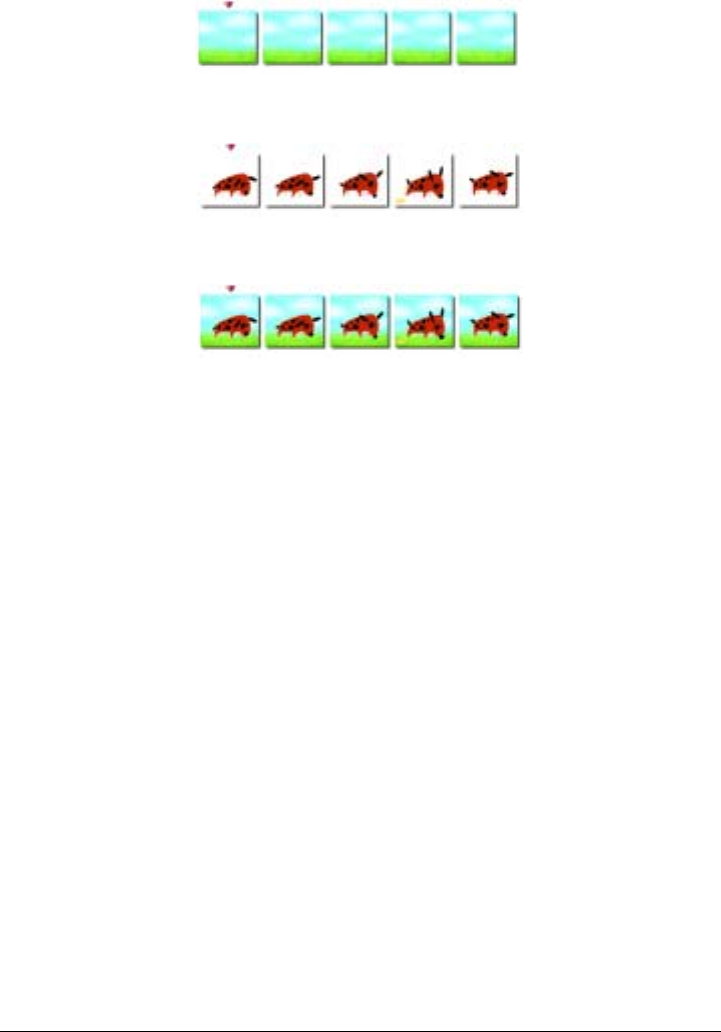
Animation and Video 375
The frame stack of the background movie.
The frame stack of the foreground movie where selections of the dog are generated.
The composited movie.
To composite movies using scripting
1Working in a sample image, determine whether Auto Select or Color Select works
best with your image.
Those selection methods are accessible by choosing Select menu > Auto Select or
Color Select.
2When you’ve determined the settings for the best method, start over. This time,
record the Auto Select or Color Select process as a script.
To record a script, click the palette menu arrow on the Scripts palette, and choose
Record Script.
3Open the frame stack in which you wish to create selections.
4Choose Movie menu > Apply Script to Movie.
5In the Apply Script to Movie dialog box, double-click the Auto Select or Color
Select script you saved.
Corel Painter applies the script to each frame in the stack.

376 Corel Painter User Guide
Cloning a Movie
Cloning from one movie to another is almost like cloning from one image to another.
The only difference is that you are cloning from one sequence of frames to another
sequence of frames. In this case, by advancing one frame in the clone frame stack,
Corel Painter automatically advances one frame in the source frame stack.
When you set a movie clone source, the current frame in the clone is matched to the
current frame in the source. If both movies are rewound to frame 1, the
clone-to-source correspondence is 1-1, 2-2, 3-3. This means that the source for frame 1
in the clone movie is frame 1 in the source movie, and so on. If you like, you can create
a different correspondence by choosing other frames before setting the movie clone
source. For example, if the current frame of the clone movie is frame 1 and the current
frame of the source movie is frame 5, the correspondence would be 1-5, 2-6, 3-7. This
means that the source for frame 1 in the clone movie is frame 5 in the source movie,
and so on. For information on cloning brushes, refer to “Cloning Images” on page 273.
You can control the areas cloned by setting up a selection in the clone movie. For
complete information on creating selections, refer to “Selections” in the Help.
You can also use Auto Clone to do the cloning, or you can record an Auto Clone script
and apply the script to the new movie with a Cloner brush selected. For more
information about using Auto Clone, refer to “Using Auto Clone” in the Help. For
information about working with scripts, refer to “Recording Scripts” in the Help.
To clone a movie
1Choose File menu > Open, and open the source movie you want to clone.
2In the Open (Mac OS) or Select Image (Windows) dialog box, note the information
on movie dimensions and number of frames given under the thumbnail window,
and click Open.
3Create a new movie with the same dimensions and number of frames as the source.
With these two frame stacks open, you’re ready to clone the source into the new
movie.
4Select frame 1 of the new movie.
5With the source movie selected, choose the first frame you want to clone.
6Choose Movie menu > Set Movie Clone Source.
7Select the new movie.
8Using any Cloner brush, paint on the document window.
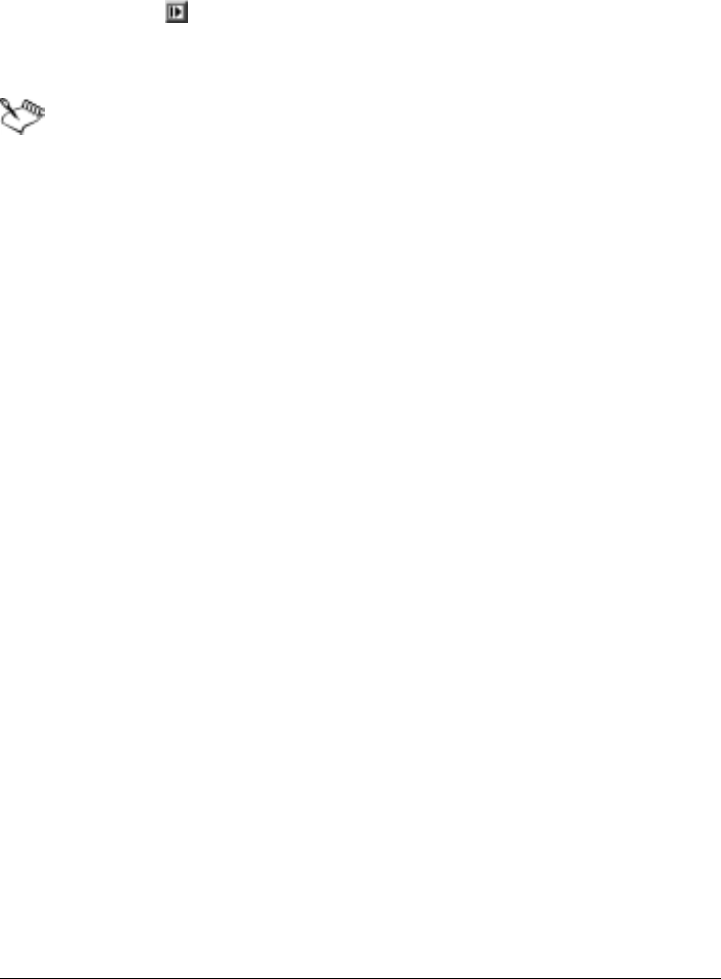
Animation and Video 377
You will be painting the source movie into the clone.
9When you finish cloning in a frame, advance to the next one by clicking the Step
Forward button on the Frame Stacks palette.
Corel Painter automatically advances the clone source to maintain the
frame-to-frame correspondence.
If you have a Corel Painter movie open and you choose File menu > Clone,
Corel Painter will create a clone only of the frame in the image window.
To apply an Auto Clone script to a movie
1Record the Auto Clone effect on a sample image, and save the script.
2Open the frame stack in which you wish to clone.
3Choose Movie menu > Apply Script to Movie.
4In the Apply Script to Movie dialog box, select a saved Auto Clone script, and click
Playback.
Corel Painter clones the source movie into the destination movie.
Tracing a Movie
Have you ever wanted to animate your own cartoon, but didn’t know where to start?
The Tracing Paper feature in Corel Painter makes it possible to trace the contents of a
movie into a brand-new animation.
For best results, the source should have the same frame rate you intend for the
animation. For more information on frame rates, refer to “Considering Frame Rate” on
page 359.
To trace a movie
1Choose File menu > Open, and open the source movie you want to trace.
2In the Open (Mac OS) or Select Image (Windows) dialog box, note the movie
dimensions and number of frames information under the thumbnail window, and
click Open.
3Create a new movie with the same dimensions and number of frames as the source.
With these two frame stacks open, you’re ready to trace the source into the new
movie.
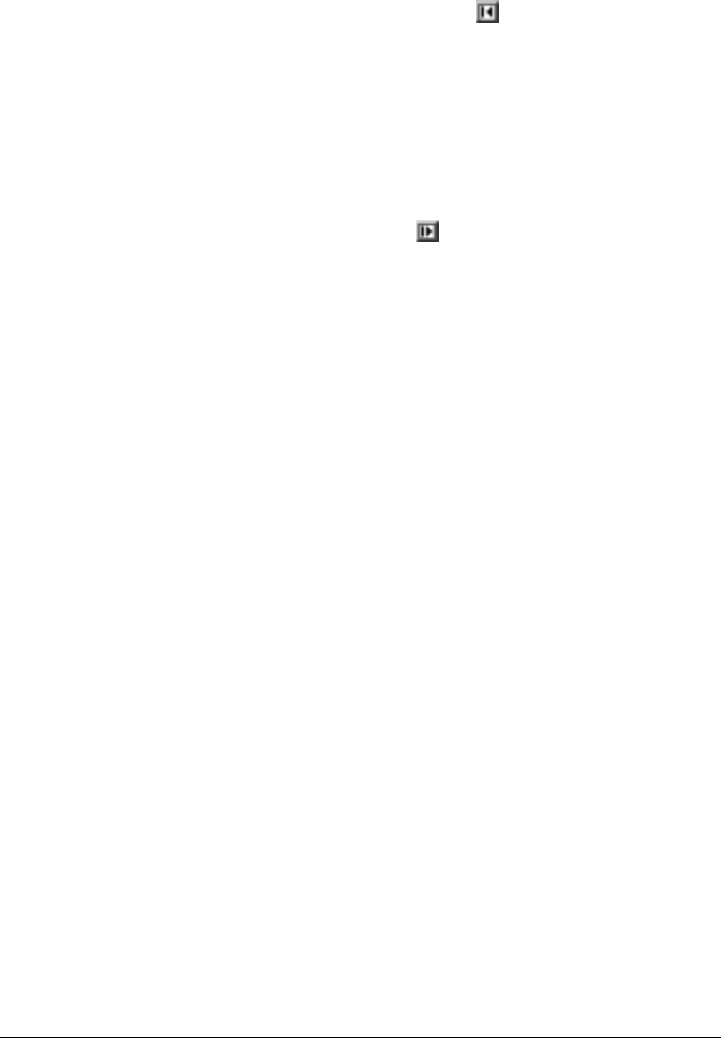
378 Corel Painter User Guide
4Select the source movie, and click the Rewind button on the Frame Stacks
palette to select frame 1.
5Choose Movie menu > Set Movie Clone Source.
6Select the new movie and choose Canvas menu > Tracing Paper.
The first frame of the original movie appears ghosted in the first frame of the new
movie.
7Trace the first frame using any of the Corel Painter tools, textures, and effects.
8When finished, click the Step Forward button on the Frame Stacks palette, and
trace the second frame.
9Continue frame by frame.
Saving and Exporting Movies
Corel Painter provides several options for saving and exporting your finished movies.
Some file formats, like QuickTime and Video for Windows, have compression options
available.
Exporting a Single Image from a Movie
You can save and export a movie frame in several file formats.
To export a frame as a single image
1Display the frame you want to export in the document window.
You can click on the frame thumbnail in the Frame Stacks palette or use the
controls in the Frames Stacks palette to display the frame.
2Choose File menu > Save As.
3In the Save Movie dialog box, enable the Save current frame as image option, and
click OK.
4In the Save (Mac OS) or Save Image As (Windows) dialog box, choose a location
and file format, enter a name for the file, and click Save.

Animation and Video 379
Exporting Movies as QuickTime Movies
You can export a movie as a QuickTime movie on either the Macintosh or Windows
platform.
QuickTime supports several compression schemes. The following descriptions should
help you choose one; however, you’ll probably want to experiment with different
compressors and settings to identify the best settings for your work. You may also have
additional compression methods available.
• The Animation method works well with areas of continuous tone. If you set the
Quality in the Compression Settings dialog box to Best and make every frame a key
frame, this compressor is lossless. For most Corel Painter animations, this
compressor is a good choice.
• The Cinepak® method produces acceptable motion and image quality at
remarkably small file sizes. It is the preferred format for CD-ROM delivery and
transfer across the Internet. Cinepak can take a long time to compress, and it can
be difficult to find the best compression settings for certain image types and frame
rates.
• The Graphics method is limited to 256 colors. It compresses the file at a greater
ratio than the Animation compressor, but does not play as quickly.
• The None option uses no compression, so the images retain all of their quality.
With a large frame size, some computers might not be fast enough to play at a high
frame rate.
• The Photo-JPEG method allows high compression ratios while maintaining
excellent image quality. However, it does not play at high rates. JPEG is an
international standard for image compression.
• The Video method is designed for recording and playing back digitized video at
high rates. Because of the spatial compression method it uses, the Video compressor
does not provide optimal results for images with large areas of continuous tone,
such as those in most animations.
The compression ratio is inversely proportional to image quality. The Quality slider
allows you to set an optimum level between the amount of compression and image
quality. For most work in Corel Painter, it is best to set the Quality slider to High.
You can specify the number of frames you want displayed per second and, with some
compression methods, the frequency of key frames. Key frames are used in temporal
compression methods. Each key frame is stored in its entirety. The next set of frames,
up to the next key, are saved only as changes.

380 Corel Painter User Guide
With some compression methods, you can also limit the speed of data transmission
with the Limit Data Rate option. The data rate limit overrides the Quality setting, if
necessary, to keep the compressed movie within the set limit.
To export a Corel Painter movie as a QuickTime movie
1Choose File menu > Save As.
2In the Save Movie dialog box, enable the Save Movie as QuickTime option.
3In the Enter Movie Name dialog box, choose a location, enter a name for the file,
and click Save.
4In the Compression Settings dialog box, choose a compression method from the
pop-up menu.
5Specify the options you want.
Exporting a Movie as an AVI Movie (Windows)
If you are using a Windows operating system, you can export your movie as an AVI
movie.
The AVI format supports several compression schemes. The following descriptions
should help you choose one; however, you’ll probably want to experiment with
different compressors and settings to identify the best settings for your work. You may
also have additional compression methods available.
• The Cinepak method produces acceptable motion and image quality at remarkably
small file sizes. It is the preferred format for CD-ROM delivery and transfer across
the Internet. Cinepak takes a long time to compress, and it can be difficult to find
the best compression settings for certain image types and frame rates.
• The Microsoft® Video 1 method is designed for recording and playing back
digitized video at high rates.
• The Full Frames (Uncompressed) method uses no compression, so the images retain
all of their quality. With a large frame size, some computers might not be fast
enough to play at a high frame rate. This is the preferred format for transferring
Corel Painter movies to AVI-editing applications.
The compression ratio is inversely proportional to image quality. In the
Video Compression dialog box, the Compression Quality slider allows you to set an
optimum level between the amount of compression and image quality.

Animation and Video 381
Key frames are used in temporal compression methods. Each key frame is stored in its
entirety. The next set of frames, up to the next key, are saved only as changes. With
some compression methods, you can specify the frequency of key frames with the Key
Frame Every [Number] Frames option.
With some compression methods, you can also limit the speed of data transmission
with the Data Rate option. The data rate limit overrides the Quality slider setting, if
necessary, to keep the compressed movie within the set limit.
To export a Corel Painter movie as an AVI movie
1Choose File menu > Save As.
2In the Save Movie dialog box, enable the Save Movie as AVI option, and specify the
number of frames per second.
3In the Enter Movie Name dialog box, choose a location, enter a name for the file,
and click Save.
4In the Video Compression dialog box, choose a compression method from the
Compressor pop-up menu.
5Specify the options you want.
For some compression methods, you can click Configure to specify additional
options.
Working with Numbered Files
Corel Painter supports importing and exporting numbered files. Numbered files are
any series of files that are the same size and resolution, and named following a specific
style, which includes a number at the beginning or end of each file name. For example,
the first frame might be called “Movie01,” the second frame “Movie02,” and so on.
When you export a movie as numbered files, you can import the numbered files into
an application that may not support other movie formats. When exporting, you
specify the filename for the first file. You must include zeros so that all numbered files
have the same number of digits. For example, to create numbered files from 1 to 24,
include “01” in the filename. To create numbered files from 89 to 110, include “089”
in the filename.
Importing numbered files is an excellent method of bringing an animation from
another 3D or animation program into Corel Painter. The file format of the numbered
files you are importing must be supported by Corel Painter, and the number of digits

382 Corel Painter User Guide
in each filename must be the same. When you import numbered files, you create a new
frame stack, and you are prompted to choose a number of onion skin layers and a
storage type. For more information, refer to “Creating a Movie” on page 362.
To export a movie as numbered files
1Choose File menu > Save As.
2In the Save Movie dialog box, enable the Save Movie as Numbered Files option,
and click OK.
3In the Save (Mac OS) or Save Image As (Windows) dialog box, choose a location
and file format, enter a name for the first file, and click Save.
You must begin or end the filename with a number — for example, “01Movie” or
“Animation14.”
To import numbered files
1Choose File menu > Open.
2Enable the Open Numbered Files check box in the Open (Mac OS) or Select Image
(Windows) dialog box.
3Do one of the following:
• (Mac OS) Select the first numbered file. When “Choose Last Numbered File”
appears under the Open Numbered Files check box, select the last numbered
file, and click Open.
• (Windows) Select the first numbered file, and click Open. Then, select the last
numbered file, and click Open.
4In the Enter Movie Name dialog box, choose a location to save the imported movie,
enter a filename, and click Save.
5In the New Frame Stack dialog box, choose a number of onion skin layers and a
storage type, and click OK.
Corel Painter sequences the images into the frames of a new frame stack.
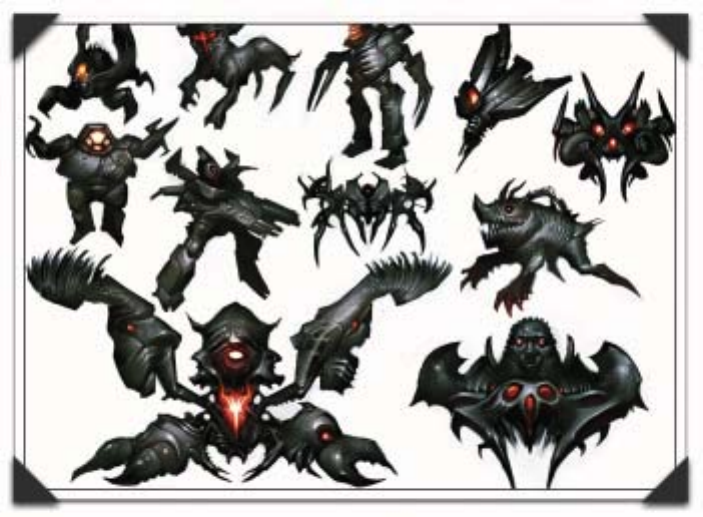
Andrew Jones has been involved in creating concepts for films and video for Industrial Light and
Magic, and for Black Isle Studios, and is currently working as Retro Studio’s senior concept artist.
He was the conceptual force behind Nintendo’s Metroid Prime and Metroid Prime 2: Echoes.
Art by Andrew Jones: Character design for a video game
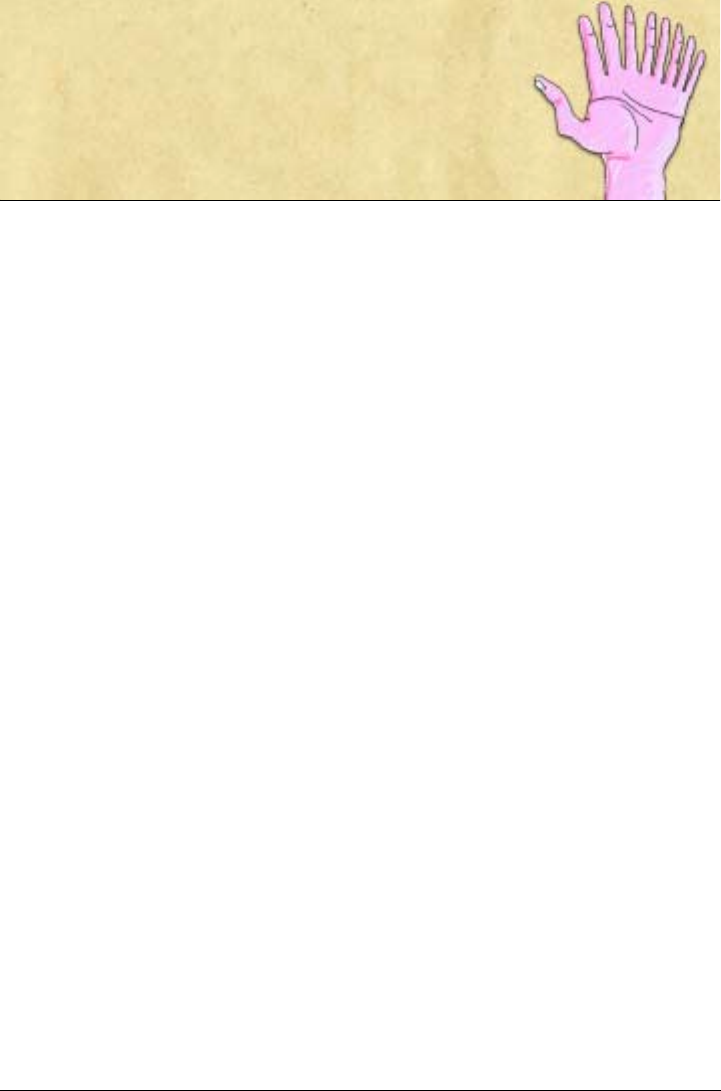
Printing 385
Printing
You can print Corel Painter images on a wide variety of printers, including PostScript,
Windows Graphics Device Interface (GDI), and Quick Draw® printers, and
high-resolution imagesetters.
Understanding Printing
Even if your final goal is to print high-quality color prints, it’s a good idea to first print
proofs on any printer you have available. You can use a black-and-white printer to
check page size and placement of images on the page. If you have a color printer, you
can print proofs to get a general impression of what your image will look like. Keep in
mind that the proof is not an accurate representation of a final print produced by an
offset printing process. The print process, inks, and paper types combined affect the
final output.
To help you prepare for color printing and to ensure the best results, Corel Painter
supports color management through the Kodak® Color Management System
(KCMS). Color management is not enabled by default. If you want to use it while you
work or when you print, you must first set it up for your system. Refer to
“Understanding Color Management” in the Help for more on KCMS in Corel Painter.
Printing Images with Shapes
In Corel Painter, shapes can be interleaved with layers on the Layers palette, which can
affect the way your document prints. Shapes are inherently resolution-independent —
they’re mathematical representations of curves, not actual pixels. When you print on a
PostScript printer, these curves are usually turned into PostScript paths and printed at
the full printer resolution, although there are some exceptions.
Some effects that you can apply to shapes, such as transparency and compositing, are
not actually printable with PostScript Level I or II. You must rasterize them on the
canvas before printing.

386 Corel Painter User Guide
Any object in a lower position on the Layers list “touched” by a rasterized shape must
also be rasterized to preserve the effect. For example, if you have a shape with
transparency on top of a number of other shapes, all the shapes below it must be
rasterized to preserve the transparency all the way down to the canvas. This is true
even if the overlap area is small. Similarly, if you place an image from a layer partially
over a shape, the shape must be rasterized to print correctly.
If you want shapes to print at the full resolution of your printer, make sure that they
do not overlap with raster layers, that they are not transparent, and that their
compositing method is set to Default.
Printing Composited Images
Having many layers and shapes in a document increases printing time. Printing a fully
composited version of the image is much faster.
Instead of creating a composited version by dropping all the layers in the image, you
can clone the file and then print the clone. Keep layers in the saved RIFF file so you
can return and make changes. For more information, see “Cloning a Document” on
page 274.
Getting Started with Printing
Corel Painter offers a wide range of printing options for a number of output devices.
You can preview and size the image before you print it.
Setting Up Printing
Options for setting up your file for printing depend on several factors: the output
device, color versus black-and-white printing, and whether you are printing
separations.
To access print settings
•Choose File menu > Page Setup.
To preview an image
1On the Info palette, click the palette menu arrow.

Printing 387
2Choose one of the following:
• To view the image as it appears on your canvas with no relation to the printing
paper, choose Canvas Preview.
• To view the image as it will appear on the currently selected printing paper,
choose Page Layout Preview.
Sizing an Image
If you want to print an image that is larger than a selected page size, you can size the
image to fit the page. For example, when this option is enabled, a 12-by-12-inch
image would be resized to fit on an 8.5-by-11-inch page.
To size an image to fit your page
1Do one of the following:
• (Mac OS) From the menu bar, choose File menu > Page Setup, and choose
Corel Painter IX from the Settings pop-up menu.
• (Windows) Choose File menu > Print.
2Enable the Size to Fit Page check box.
If an image is larger than the page size and you haven’t enabled the check box
Size to Fit Page, your image will not print.
Printing an Image
Once you have chosen options in the Print Setup dialog box (Mac OS) or Page Setup
dialog box (Windows), you are ready to print.
To print an image
1Choose File menu > Print to open the Print dialog box.
2(Mac OS) From the pop-up menu below the Presets pop-up menu, choose
Corel Painter IX.
3In the Print Type area, select one of the four print types that Corel Painter
supports.
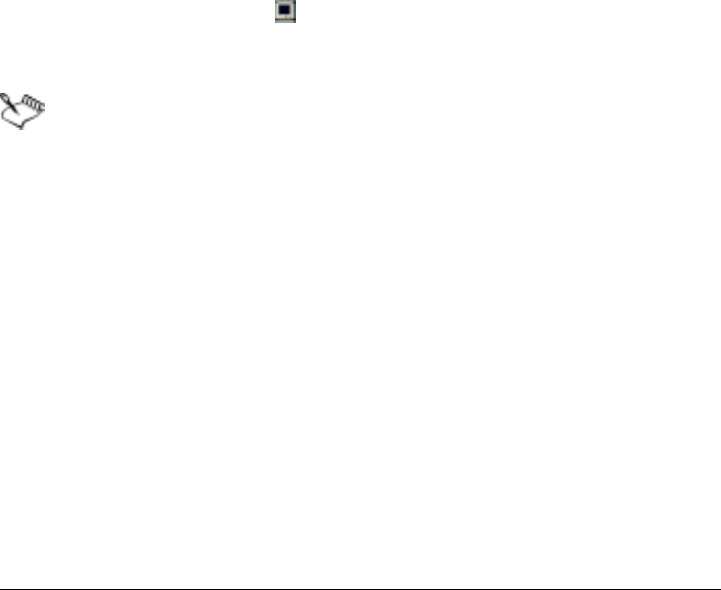
388 Corel Painter User Guide
• Enable the Color Quick Draw (Mac OS) or GDI Printing (Windows) option if
your printer is not a PostScript printer. Some common examples are the
Hewlett-Packard Deskjet, the Canon® Bubble Jet, and the EPSON Stylus®.
You cannot print separations to non-PostScript printers.
• Enable the Color PostScript option to print to a color PostScript device. The
Minolta QMS™ ColorScript and Tektronix® color thermal printers are
examples of color PostScript printers.
• Enable the Separations option to print separations. The output consists of four
pages, one each for cyan, magenta, yellow, and black. You can print separations
from Corel Painter with any PostScript device, including high-resolution
imagesetters.
• Enable the B & W PostScript option if you are printing on a black-and-white
PostScript laser printer.
Corel Painter places a color bar, registration marks, and color name on each of the
four separated plates.
4If you want to use the Color Management System to control printing, click the
Toggle Color Correction icon on the vertical scroll bar so that the icon displays
color bars. For more information, refer to “Understanding Color Management” in
the Help.
Corel Painter uses the device’s default screening information to produce
high-quality color separations. If Output Preview is off when you save to EPS
format, Corel Painter uses the Color Studio separation tables with your
device’s default screening. For more information, see “Saving in EPS File
Format for Printing” in the Help.

Index
Index 389
A
Academic courseware . . . . . . . . . . . . . . 9
Acquiring
images . . . . . . . . . . . . . . . . . . . . . . . 18
Additional color . . . . . . . . . . . . . . . . . 80
choosing . . . . . . . . . . . . . . . . . . . . . 81
Adobe Illustrator files
acquiring shapes from . . . . . . . . . . 336
converting text from . . . . . . . . . . . . 336
Adobe Photoshop files
saving . . . . . . . . . . . . . . . . . . . . . . . 29
saving layers as . . . . . . . . . . . . . . . . . 51
support for . . . . . . . . . . . . . . . . . . . . . 7
Airbrushes . . . . . . . . . . . . . . . . . . . . . 157
adjusting flow . . . . . . . . . . . . . . . . 159
adjusting spread . . . . . . . . . . . . . . . 159
conic sections . . . . . . . . . . . . . . . . . 157
controlling droplet size . . . . . . . . . . 160
controls for . . . . . . . . . . . . . . . . . . 243
pooling . . . . . . . . . . . . . . . . . . . . . 148
stylus settings . . . . . . . . . . . . . . . . . 158
varying edges . . . . . . . . . . . . . . . . . 159
Aligning
brush strokes to paths . . . . . . . . . . . 147
layers . . . . . . . . . . . . . . . . . . . . . . . . 55
Anchor points
adding and deleting . . . . . . . . . . . . 340
averaging . . . . . . . . . . . . . . . . . . . . 340
converting . . . . . . . . . . . . . . . . . . . 342
moving . . . . . . . . . . . . . . . . . . . . . 340
Angles
changing in gradients . . . . . . . . . . . 106
contraining strokes to 45° . . . . . . . . 146
controlling in brush strokes . . . . . . 223
Animations . . . . . . . . . . . . . . . . . . . . . 357
calculating required disk space . . . . 360
color sets . . . . . . . . . . . . . . . . . . . . 358
creating . . . . . . . . . . . . . . . . . . . . . 357
frame rate . . . . . . . . . . . . . . . . . . . . 359
Annotations . . . . . . . . . . . . . . . . . . . . . 98
creating and deleting . . . . . . . . . . . . . 99
hiding and showing . . . . . . . . . . . . . 99
renaming colors . . . . . . . . . . . . . . . . 99
Apply Color tool . . . . . . . . . . . . . . . . . 86
Apply Surface Texture effect . . . . . . 291
applying lighting . . . . . . . . . . 303, 305
embossing . . . . . . . . . . . . . . . . . . . 299
using 3D Brush Strokes . . . . . . . . . 294
using a channel or layer mask . 300, 301
using clone source luminance . . . . . 298
using luminance . . . . . . . . . . . 297, 299
using paper . . . . . . . . . . . . . . . . . . . 293
Artists’ Oils
Artists’ Oils Painting System . . . . . . . . 5
brush tips . . . . . . . . . . . . . . . . . . . . 217
controls . . . . . . . . . . . . . . . . . . . . . 258
mixing . . . . . . . . . . . . . . . . . . . . . . . 91
sampling multiple colors . . . . . . . . . . 91
Auto-Save Scripts . . . . . . . . . . . . . . . . 34
AVI files
exporting . . . . . . . . . . . . . . . . . . . . 380
opening . . . . . . . . . . . . . . . . . . . . . 364
B
Bearing
adjusting for mouse . . . . . . . . . . . . 143
Bézier lines . . . . . . . . . . . . . . . . . . . . . 329

390 Index
Bleed . . . . . . . . . . . . . . . . . . . . . . . . . .230
controlling with stylus . . . . . . . . . . .153
setting . . . . . . . . . . . . . . . . . . . . . . .231
Blend modes . . . . . . . . . . . . . . . . . . . . .51
Blending
Impasto brush strokes with layers . . .185
layers . . . . . . . . . . . . . . . . . . . . . . . .71
shapes . . . . . . . . . . . . . . . . . . . . . . .352
Blending ramps
creating . . . . . . . . . . . . . . . . . . . . . .109
linear . . . . . . . . . . . . . . . . . . . . . . .109
Brightness
paper texture . . . . . . . . . . . . . . . . . .117
Bristles
modifying . . . . . . . . . . . . . . . . . . . .226
Brush Controls . . . . . . . . . . . . . . . . . . . .4
vs. Brush Creator . . . . . . . . . . . . . . .197
Brush Creator
getting started with . . . . . . . . . . . . .198
opening . . . . . . . . . . . . . . . . . . . . .199
Randomizer . . . . . . . . . . . . . . . . . .202
resizing preview grid . . . . . . . . . . . .200
Stroke Designer . . . . . . . . . . . . . . .204
tools . . . . . . . . . . . . . . . . . . . . . . . .200
Transposer . . . . . . . . . . . . . . . . . . .203
workspace . . . . . . . . . . . . . . . . . . . .198
Brush dabs
adjusting spacing between . . . . . . . .221
capturing . . . . . . . . . . . . . . . . . . . .265
creating shapes for . . . . . . . . . . . . . .265
previewing . . . . . . . . . . . . . . . . . . .216
Brush Loading option
brush behavior and . . . . . . . . . . . . .229
cloning with . . . . . . . . . . . . . . . . . .288
painting with multiple colors . . . . . .152
Brush Looks
saving . . . . . . . . . . . . . . . . . . . . . . .267
using saved . . . . . . . . . . . . . . . . . . .268
Brush Selector bar
choosing brush from . . . . . . . . . . . .138
showing . . . . . . . . . . . . . . . . . . . . . .138
Brush strokes
360° . . . . . . . . . . . . . . . . . . . . . . . . .148
aligning to paths and shapes . . . . . . .147
applying in movies . . . . . . . . . . . . . .372
constraining . . . . . . . . . . . . . . . . . . .146
controlling angles of . . . . . . . . . . . . .223
creating . . . . . . . . . . . . . . . . . . . . . .144
creating texture with . . . . . . . . . . . .295
damping . . . . . . . . . . . . . . . . . . . . .222
data for . . . . . . . . . . . . . . . . . . . . . .162
fading . . . . . . . . . . . . . . . . . . . . . . .146
playing back . . . . . . . . . . . . . .161, 162
randomizing . . . . . . . . . . . . . . . . . .235
randomizing playback . . . . . . . . . . .162
recording . . . . . . . . . . . . . . . . .161, 162
resizing . . . . . . . . . . . . . . . . . .216, 218
saving . . . . . . . . . . . . . . . . . . . . . . .162
selecting saved . . . . . . . . . . . . . . . . .162
two-color . . . . . . . . . . . . . . . . . . . . .150
types . . . . . . . . . . . . . . . . . . . . . . . .209
undoing . . . . . . . . . . . . . . . . . . . . . .146
using data from . . . . . . . . . . . . . . . .162
Brush tips . . . . . . . . . . . . . . . . . . . . . . .217
airbrushes . . . . . . . . . . . . . . . . . . . .159
Artists’ Oils . . . . . . . . . . . . . . . . . . .217
choosing . . . . . . . . . . . . . . . . . . . . .218
Brush Tracking preferences . . . . . . . .35
Brush variants
choosing . . . . . . . . . . . . . . . . . . . . .203
copying between categories . . . . . . . .264
creating random variants . . . . . . . . .202

Index 391
creating transposed variants . . . . . . 203
deleting . . . . . . . . . . . . . . . . . . . . . 264
designing . . . . . . . . . . . . . . . . . . . . 204
restoring default settings . . . . . . . . . 264
saving . . . . . . . . . . . . . . . . . . . . . . 263
Brushes . . . . . . . . . . . . . . . . . . . . . . . . 137
adjusting size in Scratch Pad . . . . . 201
choosing settings . . . . . . . . . . . . . . 139
Cloner . . . . . . . . . . . . . . . . . . .278, 279
creating new category . . . . . . . . . . . 266
custom Impasto . . . . . . . . . . . . . . . 182
customizing . . . . . . . . . . . . . . . . . . 197
dab types . . . . . . . . . . . . . . . . . . . . 205
dryout . . . . . . . . . . . . . . . . . . .230, 231
grain . . . . . . . . . . . . . . . . . . . . . . . 140
libraries . . . . . . . . . . . . . . . . . . . . . 268
Looks. See Brush Looks
managing customized . . . . . . . . . . 263
methods. See Methods
multiuser support . . . . . . . . . . .197, 269
opacity . . . . . . . . . . . . . . . . . . . . . . 140
painting with stylus . . . . . . . . . . . . 142
pooling media . . . . . . . . . . . . . . . . 148
selecting . . . . . . . . . . . . . . . . . . . . 138
setting opacity . . . . . . . . . . . . . . . . 215
sizing . . . . . . . . . . . . . . . . . . . . . . 139
strokes. See Brush strokes
subcategories . . . . . . . . . . . . . . . . . 211
tips. See Brush tips
using as Cloners . . . . . . . . . . . . . . . 288
variants. See Brush variants
Watercolor . . . . . . . . . . . . . . . . . . . 171
C
Canvas
flipping . . . . . . . . . . . . . . . . . . . . .4, 26
marking . . . . . . . . . . . . . . . . . . . . . 144
resizing . . . . . . . . . . . . . . . . . . . . . . 25
rotating . . . . . . . . . . . . . . . . . . . . 4, 26
Capturing
brush dabs . . . . . . . . . . . . . . . . . . . 265
gradients . . . . . . . . . . . . . . . . . . . . 110
patterns . . . . . . . . . . . . . . . . . . . . . 123
Channels
creating texture with . . . . . . . . . . . . 300
Clear and Reset Canvas tool . . . . . . . 87
Clearing
Impasto layer . . . . . . . . . . . . . . . . . 180
Mixer Pad . . . . . . . . . . . . . . . . . . . . 90
Scratch Pad . . . . . . . . . . . . . . . . . . 202
Clone Color
brush behavior and . . . . . . . . . . . . . 240
using . . . . . . . . . . . . . . . . . . . . 82, 288
Clone Location controls . . . . . . 236, 238
Clone source luminance
creating texture with . . . . . . . . . . . . 298
Clone types
selecting . . . . . . . . . . . . . . . . . . . . . 282
setting . . . . . . . . . . . . . . . . . . . . . . 285
Cloners
using other brushes as . . . . . . . . . . . 288
Cloning
Brush Loading option . . . . . . . . . . . 288
clone source . . . . . . . . . . . . . . . . . . 277
Cloner brushes . . . . . . . . . . . . 278, 279
color . . . . . . . . . . . . . . . . . . . . . . . . . 82
constraining in destination . . . . . . . 240
controls for . . . . . . . . . . . . . . . . . . . 240
customizing Quick Clone . . . . . . . . . 33
documents . . . . . . . . . . . . . . . . . . . 274
for embossing effect . . . . . . . . . . . . 299
images . . . . . . . . . . . . . . . . . . . . . . 273
method . . . . . . . . . . . . . . . . . . . . . . 289

392 Index
movies . . . . . . . . . . . . . . . . . . . . . .376
moving source points . . . . . . . . . . . .287
multipoint . . . . . . . . . . . . . . . . . . . .282
offset . . . . . . . . . . . . . . . . . . . . . . . .279
painting in a clone . . . . . . . . . . . . . .278
point-to-point . . . . . . . . . . . . . 280, 281
reproducing source selection . . . . . .240
setting clone source . . . . . . . . . . . . .277
setting reference points . . . . . . . . . .285
setting up clone source . . . . . . . . . . .82
tiling . . . . . . . . . . . . . . . . . . . . . . . .240
turning brushes into Cloners . . . . . .288
with Clone Color . . . . . . . . . . . . . .288
with crosshair cursor . . . . . . . . . . . .282
with Quick Clone . . . . . . . . . . . . . .277
with Tracing Paper . . . . . . . . . . . . .275
Closing documents . . . . . . . . . . . . . . .31
Collapsing
layer groups . . . . . . . . . . . . . . . . . . .62
Color . . . . . . . . . . . . . . . . . . . . . . . . . . .77
adding in gradients . . . . . . . . . . . . .108
adding swatches to a color set . . . . . . .92
annotations . . . . . . . . . . . . . . . . . . . .98
bleed . . . . . . . . . . . . . . . . . . . . . . . .231
choosing for color sets . . . . . . . . . . . .93
choosing from Colors palette . . . . . . .79
cloning . . . . . . . . . . . . . . . . . . . . . . .82
creating color sets . . . . . . . . . . . . . . .95
expression . . . . . . . . . . . . . . . . . . . .103
finding in color set . . . . . . . . . . . . . . .94
getting started with . . . . . . . . . . . . . .77
loading . . . . . . . . . . . . . . . . . . . . . .152
main and additional . . . . . . . . . . . . .80
management . . . . . . . . . . . . . . . . . . . .8
mixing . . . . . . . . . . . . . . . . . . . . . . .89
movies . . . . . . . . . . . . . . . . . . . . . .358
of paper. See Paper color
painting with . . . . . . . . . . . . . . . . .149
replacing in color set . . . . . . . . . . . . .97
sampling from images . . . . . . . .81, 150
sampling from Mixer Pad . . . . . . . . . .89
sampling multiple . . . . . . . . . . . . . . .91
sets. See Color sets
swapping main and additional . . . . . .81
variability . . . . . . . . . . . . 100, 101, 102
viewing information . . . . . . . . . . . . .102
Color Expression palette . . . . . . . . . .103
Color Hue
changing in gradients . . . . . . . . . . . .110
Color Info palette . . . . . . . . . . . . . . . .102
Color management . . . . . . . . . . . . . . . . .8
Color sets . . . . . . . . . . . . . . . . . . . . . . . .92
adding color swatches to . . . . . . . . . . .92
adding colors to . . . . . . . . . . . . . . . . .97
choosing colors for . . . . . . . . . . . . . . .93
creating from the Mixer Pad . . . . . . . .92
creating with the Colors palette . . . . .95
customizing layout . . . . . . . . . . . . . . .94
deleting colors from . . . . . . . . . . . . . .97
displaying for weaves . . . . . . . . . . . .133
editing . . . . . . . . . . . . . . . . . . . . . . . .96
finding color in . . . . . . . . . . . . . . . . .94
loading in Mixer palette . . . . . . . . . . .88
multiuser support . . . . . . . . . . . . . . . .92
opening . . . . . . . . . . . . . . . . . . . . . . .93
renaming colors . . . . . . . . . . . . . . . . .98
replacing colors in . . . . . . . . . . . . . . .97
saving . . . . . . . . . . . . . . . . . . . . . . . .94
setting color variability . . . . . . . . . . .102
Color space prompt . . . . . . . . . . . . . . .39
Color Variability palette . . . . . . . . . .100
Colors palette . . . . . . . . . . . . . . . . . . . .78
choosing color from . . . . . . . . . . . . . .79
displaying . . . . . . . . . . . . . . . . . .78, 79

Index 393
Combining
layers with canvas . . . . . . . . . . . . . . 62
shapes . . . . . . . . . . . . . . . . . . . . . . 351
Commit dialog box
reinstating . . . . . . . . . . . . . . . . . . . . 35
Committing
reference layers . . . . . . . . . . . . . . . . 71
Compatibility . . . . . . . . . . . . . . . . . . . . 7
Composite methods
changing . . . . . . . . . . . . . . . . . . . . . 72
converting to blend modes . . . . . . . . 51
for blending layers . . . . . . . . . . . . . . 71
Compositing . . . . . . . . . . . . . . . . . . . 386
movies . . . . . . . . . . . . . . . . . . . . . . 373
scripting . . . . . . . . . . . . . . . . . . . . 373
Compound shapes
creating . . . . . . . . . . . . . . . . . . . . . 351
releasing . . . . . . . . . . . . . . . . . . . . 352
Constraining
fills . . . . . . . . . . . . . . . . . . . . . . . . 165
lines . . . . . . . . . . . . . . . . . . . . . . . 144
Continuous Time Deposition . .222, 223
Contrast
paper texture . . . . . . . . . . . . . . . . . 117
Copying
layers . . . . . . . . . . . . . . . . . . . . . . . . 48
lines to selection . . . . . . . . . . . . . . . 165
Corel Support Services . . . . . . . . . . . . 12
Courseware
academic . . . . . . . . . . . . . . . . . . . . . . 9
Creativity . . . . . . . . . . . . . . . . . . . . . . . . 5
Cropping . . . . . . . . . . . . . . . . . . . . . . . 23
adjusting ratio values . . . . . . . . . . . . 24
constraining to square . . . . . . . . . . . 24
Crosshair cursor . . . . . . . . . . . . . . . . . 282
Cubic Interpolation . . . . . . . . . . . . . . 222
Cursor
choosing icon for . . . . . . . . . . . . . . . 32
crosshair . . . . . . . . . . . . . . . . . . . . . 282
Curves
adjusting . . . . . . . . . . . . . . . . . . . . 342
Customizing
brushes . . . . . . . . . . . . . . . . . . . . . . 197
color set layout . . . . . . . . . . . . . . . . . 94
keyboard shortcuts . . . . . . . . . . . . 5, 36
Quick Clone . . . . . . . . . . . . . . . . . . . 33
Cutting
shape segments . . . . . . . . . . . . . . . . 343
D
Dab types . . . . . . . . . . . . . . . . . . . . . . 205
choosing . . . . . . . . . . . . . . . . . . . . . 209
Damping
of brush strokes . . . . . . . . . . . . . . . . 222
Default settings
restoring brush variant . . . . . . . . . . 264
Depth
creating appearance of . . . . . . . . . . 292
in Impasto . . . . . . . . . . . . . . . . . . . 180
Depth method
controlling medium interaction . . . . 183
for Impasto brushes . . . . . . . . 182, 241
inverting . . . . . . . . . . . . . . . . . . . . . 183
varying input . . . . . . . . . . . . . . . . . 185
Deselecting
layers . . . . . . . . . . . . . . . . . . . . . . . . 53
Designing
brush variants . . . . . . . . . . . . . . . . . 204

394 Index
Diffusion . . . . . . . . . . . . . . . . . . . . . . .172
Digital Watercolor . . . . . . . . . . . . 7, 172
adjusting diffusion . . . . . . . . . . . . .172
controls for . . . . . . . . . . . . . . . . . . .258
pooling . . . . . . . . . . . . . . . . . . . . . .173
Directional grain
enabling . . . . . . . . . . . . . . . . . . . . .119
Dirty Brush Mode tool . . . . . . . . . . . .86
Dirty Mode option . . . . . . . . . . . . . . .261
Displaying
Brush Selector bar . . . . . . . . . . . . . .138
color sets for weaves . . . . . . . . . . . . .133
Colors palette . . . . . . . . . . . . . . . 78, 79
Image Portfolio . . . . . . . . . . . . . . . . .73
Mixer palette . . . . . . . . . . . . . . . . . . .85
Distortion
applying to shapes . . . . . . . . . . . . . .347
Documents
browsing for (Mac OS) . . . . . . . . . . .17
cloning . . . . . . . . . . . . . . . . . . . . . .274
closing . . . . . . . . . . . . . . . . . . . . . . .31
creating . . . . . . . . . . . . . . . . . . . . . . .15
opening . . . . . . . . . . . . . . . . . . . 15, 17
repositioning . . . . . . . . . . . . . . . . . . .22
rotating . . . . . . . . . . . . . . . . . . . . . . .23
working with . . . . . . . . . . . . . . . . . . .15
Drawing
choosing cursor for . . . . . . . . . . . . . .32
freehand . . . . . . . . . . . . . . . . . . . . .144
straight-line . . . . . . . . . . . . . . . . . .144
styles . . . . . . . . . . . . . . . . . . . . . . . .144
Drawing area
resizing . . . . . . . . . . . . . . . . . . . . . . .25
Drawing method . . . . . . . . . . . . . . . .182
for Impasto . . . . . . . . . . . . . . . . . . .241
Drop shadows
adding . . . . . . . . . . . . . . . . . . . . . . . .68
Dropper tool
accessing . . . . . . . . . . . . . . . . . . . . . .82
sampling color with . . . . . . . . . . . . . .81
Dropping
floating objects . . . . . . . . . . . . . . . . . .67
layers . . . . . . . . . . . . . . . . . . . . . .62, 63
Dryout . . . . . . . . . . . . . . . . . . . . . . . . .230
setting . . . . . . . . . . . . . . . . . . . . . . .231
Duplicating
changing settings for . . . . . . . . . . . .349
layers . . . . . . . . . . . . . . . . . . . . . . . . .48
shapes . . . . . . . . . . . . . . . . . . . . . . .348
Dynamic layers . . . . . . . . . . . . . . . . . . .45
E
Editing
color sets . . . . . . . . . . . . . . . . . . . . . .96
complex gradients . . . . . . . . . . . . . .108
layers . . . . . . . . . . . . . . . . . . . . . . . . .63
pattern tiles . . . . . . . . . . . . . . . . . . .125
shapes . . . . . . . . . . . . . . . . . . . . . . .339
weave colors . . . . . . . . . . . . . . . . . . .133
Effects . . . . . . . . . . . . . . . . . . . . . . . . . .291
applying to movie frames . . . . . . . . .370
embossing . . . . . . . . . . . . . . . . . . . .299
Impasto . . . . . . . . . . . . . . . . . . . . . .180
Embossing effects
creating . . . . . . . . . . . . . . . . . . . . . .299
Encapsulated PostScript. See EPS files
Endpoints
joining . . . . . . . . . . . . . . . . . . . . . . .343
EPS files
saving . . . . . . . . . . . . . . . . . . . . . . . .29

Index 395
Exporting
an image from a movie . . . . . . . . . . 378
AVI files . . . . . . . . . . . . . . . . . . . . 380
movies as numbered files . . . . . . . . 382
QuickTime movies . . . . . . . . . . . . 379
Expression
color . . . . . . . . . . . . . . . . . . . . . . . 103
Expression settings . . . . . . . . . . . . . . 262
choosing for Ranks . . . . . . . . . . . . . 243
varying brush strokes with . . . . . . . 262
F
Fading
strokes . . . . . . . . . . . . . . . . . . . . . . 146
Filesimporting . . . . . . . . . . . . . . . . . . . . 19
numbered . . . . . . . . . . . . . . . . . . . 381
placing . . . . . . . . . . . . . . . . . . . . . . 19
recovering . . . . . . . . . . . . . . . . . . . . 30
saving . . . . . . . . . . . . . . . . . . . . .26, 31
Filling . . . . . . . . . . . . . . . . . . . . . . . . . 163
aborting . . . . . . . . . . . . . . . . . . . . . 166
areas . . . . . . . . . . . . . . . . . . . . . . . 163
based on color . . . . . . . . . . . . . . . . 164
constraining . . . . . . . . . . . . . . . . . . 165
limiting and preventing leakage . . . 166
techniques . . . . . . . . . . . . . . . . . . . 163
with pattern tiles . . . . . . . . . . . . . . 122
Flipping
canvas . . . . . . . . . . . . . . . . . . . . . .4, 26
shapes . . . . . . . . . . . . . . . . . . . . . . 348
Floating objects . . . . . . . . . . . . . . . .45, 66
creating . . . . . . . . . . . . . . . . . . . . . . 67
dropping . . . . . . . . . . . . . . . . . . . . . 67
repositioning . . . . . . . . . . . . . . . . . . 67
Flow
adjusting for airbrushes . . . . . . . . . . 159
4-Point Tiling . . . . . . . . . . . . . . . . . . 240
Fractal patterns
converting to paper texture . . . . . . . 128
creating . . . . . . . . . . . . . . . . . . . . . 126
Frame Rate . . . . . . . . . . . . . . . . . . . . . 359
Frame Stacks palette . . . . . . . . . . . . . 360
Frames
adding and deleting . . . . . . . . . . . . 367
repeating . . . . . . . . . . . . . . . . . . . . 368
Frames-per-Second Control . . . . . . . . . 4
Freehand drawing . . . . . . . . . . . . . . . 144
Full screen mode . . . . . . . . . . . . . . . . . 24
G
General controls . . . . . . . . . . . . . . . . 204
General preferences . . . . . . . . . . . . . . . 32
GIF files
saving . . . . . . . . . . . . . . . . . . . . . . . . 28
Grabber tool
repositioning documents . . . . . . . . . . 22
Gradients . . . . . . . . . . . . . . . . . . . . . . 104
adding color control points . . . . . . . 108
angles in . . . . . . . . . . . . . . . . . . . . . 106
capturing . . . . . . . . . . . . . . . . . . . . 110
changing color hue . . . . . . . . . . . . . 110
color variability . . . . . . . . . . . . . . . . 101
complex . . . . . . . . . . . . . . . . . . . . . 108
creating . . . . . . . . . . . . . . . . . . . . . 107
deleting control points . . . . . . . . . . 109
editing . . . . . . . . . . . . . . . . . . 107, 108
expressing in an image . . . . . . . . . . 112
linear . . . . . . . . . . . . . . . . . . . . . . . 109

396 Index
mapping to luminance . . . . . . . . . . .112
nonlinear . . . . . . . . . . . . . . . . . . . .109
order . . . . . . . . . . . . . . . . . . . . . . . .106
painting with . . . . . . . . . . . . . 153, 154
saving . . . . . . . . . . . . . . . . . . . . . . .109
selecting . . . . . . . . . . . . . . . . . . . . .105
spiral tension . . . . . . . . . . . . . . . . . .107
two-point . . . . . . . . . . . . . . . . . . . .108
types . . . . . . . . . . . . . . . . . . . . . . . .104
Grain
adjusting . . . . . . . . . . . . . . . . . 140, 215
Grouping
layers . . . . . . . . . . . . . . . . . . . . . . . .60
shapes . . . . . . . . . . . . . . . . . . . . . . .351
Grout
color . . . . . . . . . . . . . . . . . . . . . . . .313
H
Hiding
annotations . . . . . . . . . . . . . . . . . . . .99
layers . . . . . . . . . . . . . . . . . . . . . . . .57
HSV values
setting . . . . . . . . . . . . . . . . . . . . . . .102
I
Image effects . . . . . . . . . . . . . . . . . . . .291
Image Hose . . . . . . . . . . . . . . . . . 191, 192
controlling . . . . . . . . . . . . . . . . . . .243
getting started with . . . . . . . . . . . . .193
Image Luminance
creating texture using . . . . . . . . . . .297
Image Portfolio
adding layers to . . . . . . . . . . . . . . . . .73
storing images in . . . . . . . . . . . . . . . .73
using images from . . . . . . . . . . . . . . .73
Image Portfolio Libraries
organizing layers with . . . . . . . . . . . .74
Images
acquiring . . . . . . . . . . . . . . . . . . . . . .18
cloning . . . . . . . . . . . . . . . . . . . . . .273
cropping . . . . . . . . . . . . . . . . . . . . . .23
exporting from movies . . . . . . . . . . .378
expressing gradients in . . . . . . . . . . .112
previewing . . . . . . . . . . . . . . . . . . . .386
printing . . . . . . . . . . . . . . . . . .386, 387
sampling color from . . . . . . . . . . . . .150
sizing . . . . . . . . . . . . . . . . . . . . . . .387
storing . . . . . . . . . . . . . . . . . . . . . . . .73
tracing . . . . . . . . . . . . . . . . . . . . . . .275
using effects in . . . . . . . . . . . . . . . . .291
using stored . . . . . . . . . . . . . . . . . . . .73
Impasto . . . . . . . . . . . . . . . . . . . . . . . .179
adding and deleting lights . . . . . . . .188
adjusting depth . . . . . . . . . . . .180, 185
blending with layers . . . . . . . . . . . . .185
controls . . . . . . . . . . . . . . . . . . . . . .241
creating . . . . . . . . . . . . . . 179, 180, 181
creating custom brushes . . . . . .182, 184
depth effect of lighting . . . . . . . . . . .187
depth interaction . . . . . . . . . . . . . . .183
depth method . . . . . . . . . . . . .182, 241
drawing method . . . . . . . . . . . .182, 241
effect . . . . . . . . . . . . . . . . . . . . . . . .180
inverting depth method . . . . . . . . . .183
layer . . . . . . . . . . . . . . . . . . . .179, 180
setting light properties . . . . . . . . . . .189
Impasto layer . . . . . . . . . . . . . . . . . . . .179
activating and deactivating . . . . . . . .180
clearing . . . . . . . . . . . . . . . . . . . . . .180
Importing
Adobe Illustrator shapes . . . . . . . . . .336
files . . . . . . . . . . . . . . . . . . . . . . . . . .19
movies as numbered files . . . . . . . . .382

Index 397
Info palette
displaying . . . . . . . . . . . . . . . . . . . . 60
Iterative Save . . . . . . . . . . . . . . . . . . .5, 31
J
Jitter control . . . . . . . . . . . . . . . .235, 238
Joining
shape segments . . . . . . . . . . . . . . . 343
JPEG files
saving . . . . . . . . . . . . . . . . . . . . . . . 27
K
Keyboard shortcuts
customizing . . . . . . . . . . . . . . . . . . . 36
KPT filters . . . . . . . . . . . . . . . . . . . . . . . 7
L
Layer Adjuster tool . . . . . . . . . . . . . . . 47
Layer masks
creating texture with . . . . . . . . . . . . 300
Layers . . . . . . . . . . . . . . . . . . . . . . . . . . 43
adding notes to . . . . . . . . . . . . . . . . 72
adding to groups . . . . . . . . . . . . . . . 61
adding to Image Portfolio . . . . . . . . . 73
aligning . . . . . . . . . . . . . . . . . . . . . . 55
based on selection . . . . . . . . . . . . . . 49
blending . . . . . . . . . . . . . . . . . . . . . 71
brush methods for painting on . . . . . 64
changing composite method . . . . . . . 72
changing hierarchy . . . . . . . . . . . . . 58
collapsing groups . . . . . . . . . . . . . . . 62
composite methods . . . . . . . . . . .51, 71
converting shapes to . . . . . . . . . . . . 329
converting to default . . . . . . . . . . . . 47
copying and pasting . . . . . . . . . . . . . 48
creating . . . . . . . . . . . . . . . . . . . . . . 48
creating floating objects on . . . . . 45, 66
creating patterns on . . . . . . . . . . . . . 68
deleting . . . . . . . . . . . . . . . . . . . . . . 52
deselecting . . . . . . . . . . . . . . . . . . . . 53
dropping . . . . . . . . . . . . . . . . . . 62, 63
dropping floating objects on . . . . . . . 67
duplicating . . . . . . . . . . . . . . . . . . . . 48
dynamic . . . . . . . . . . . . . . . . . . . . . . 45
editing . . . . . . . . . . . . . . . . . . . . . . . 63
getting started with . . . . . . . . . . . . . . 43
grouping . . . . . . . . . . . . . . . . . . . . . 60
hiding . . . . . . . . . . . . . . . . . . . . . . . 57
hierarchy . . . . . . . . . . . . . . . . . . . . . 58
Impasto . . . . . . . . . . . . . . . . . 179, 180
Liquid Ink . . . . . . . . . . . . . . . . 46, 175
locking . . . . . . . . . . . . . . . . . . . . 56, 57
managing . . . . . . . . . . . . . . . . . . . . . 52
merging with canvas . . . . . . . . . . . . . 62
movies . . . . . . . . . . . . . . . . . . . . . . 366
moving . . . . . . . . . . . . . . . . . . . . 54, 69
naming . . . . . . . . . . . . . . . . . . . . . . 50
opacity . . . . . . . . . . . . . . . . . . . . . . . 65
opening and closing groups . . . . . . . . 61
order . . . . . . . . . . . . . . . . . . . . . . . . 58
organizing . . . . . . . . . . . . . . . . . . . . 74
painting on . . . . . . . . . . . . . . . . . . . . 63
palette . . . . . . . . . . . . . . . . . . . . . . . 46
pixel-based . . . . . . . . . . . . . . . . . . . . 44
position . . . . . . . . . . . . . . . . . . . . . . 59
preserving transparency . . . . . . . . 65, 66
reference . . . . . . . . . . . . . . . . . . 45, 69
removing from groups . . . . . . . . . . . . 61
repositioning floating objects on . . . . 67
resizing . . . . . . . . . . . . . . . . . . . . . . 69
rotating . . . . . . . . . . . . . . . . . . . . . . 69
saving . . . . . . . . . . . . . . . . . . . . . . . . 51
selecting . . . . . . . . . . . . . . . . . . . . . . 52
setting opacity . . . . . . . . . . . . . . . . . . 71

398 Index
shapes as . . . . . . . . . . . . . . . . . . 45, 328
showing . . . . . . . . . . . . . . . . . . . . . .57
showing indicators . . . . . . . . . . . . . .60
transforming . . . . . . . . . . . . . . . . . . .69
types . . . . . . . . . . . . . . . . . . . . . . . . .44
ungrouping . . . . . . . . . . . . . . . . . . . .62
unlocking . . . . . . . . . . . . . . . . . . . . .57
viewing . . . . . . . . . . . . . . . . . . . . . . .57
viewing position . . . . . . . . . . . . . . . .59
Watercolor . . . . . . . . . . . . . . . . 46, 170
Learning . . . . . . . . . . . . . . . . . . . . . . . . .8
Libraries
brushes . . . . . . . . . . . . . . . . . . . . . .268
Looks . . . . . . . . . . . . . . . . . . . . . . .268
patterns . . . . . . . . . . . . . . . . . . . . . .130
setting default . . . . . . . . . . . . . . . . . .33
Lighting
adding and deleting . . . . . . . . . . . . .188
adjusting for textures . . . . . . . . . . . .305
adjusting surface . . . . . . . . . . . . . . .187
angle . . . . . . . . . . . . . . . . . . . . . . . .188
applying to textures . . . . . . . . . . . . .303
changing color of . . . . . . . . . . . 189, 305
changing position of . . . . . . . . . . . .305
deleting from texture . . . . . . . . . . . .304
positioning . . . . . . . . . . . . . . . . . . .187
settings . . . . . . . . . . . . . . . . . . . . . .189
Lines
Bézier . . . . . . . . . . . . . . . . . . . . . . .329
copying to selections . . . . . . . . . . . .165
drawing . . . . . . . . . . . . . . . . . . . . .144
Liquid Ink
adding depth . . . . . . . . . . . . . . . . . .175
adding lighting effects to . . . . . . . . .177
adjusting threshold for . . . . . . . . . . .175
choosing brush size . . . . . . . . . . . . .176
choosing ink type for . . . . . . . . 251, 256
controlling . . . . . . . . . . . . . . . .176, 250
Expression settings . . . . . . . . . . . . . .177
layers . . . . . . . . . . . . . . . . . . . . .46, 175
Loading
Mixer Pad . . . . . . . . . . . . . . . . . . . . .90
Mixer palette colors . . . . . . . . . . . . . .88
Locking
layers . . . . . . . . . . . . . . . . . . . . . .56, 57
Lock-out color
choosing . . . . . . . . . . . . . . . . . . . . .165
Looks
libraries . . . . . . . . . . . . . . . . . . . . . .268
saving . . . . . . . . . . . . . . . . . . .118, 267
Luminance
from clone source . . . . . . . . . . . . . . .298
mapping gradients to . . . . . . . . . . . .112
lynda.com training videos . . . . . . . .8, 12
M
Magnifier tool
accessing . . . . . . . . . . . . . . . . . . . . . .22
resetting . . . . . . . . . . . . . . . . . . . . . . .22
zooming . . . . . . . . . . . . . . . . . . . . . .22
Main color . . . . . . . . . . . . . . . . . . . . . . .80
Masked patterns . . . . . . . . . . . . . . . . .125
Media
choosing source for . . . . . . . . . . . . .215
enabling pooling . . . . . . . . . . . . . . .148
filling with . . . . . . . . . . . . . . . . . . . .163
Memory & Scratch preferences . . . . . .41
Merging
layers with canvas . . . . . . . . . . . . . . .62
Methods . . . . . . . . . . . . . . . . . . . . . . . .211
choosing . . . . . . . . . . . . . . . . . . . . .214

Index 399
composite . . . . . . . . . . . . . . . . . . . . 71
for painting on layers . . . . . . . . . . . . 64
subcategories . . . . . . . . . . . . . .211, 214
Mix Color tool . . . . . . . . . . . . . . . . . . . 86
Mixer Pad
changing background . . . . . . . . . . . . 85
clearing . . . . . . . . . . . . . . . . . . . . . . 90
creating color sets . . . . . . . . . . . . . . . 92
loading . . . . . . . . . . . . . . . . . . . . . . 90
mixing Artists’ Oils paint . . . . . . . . . 91
sampling color from . . . . . . . . . . . . . 89
saving . . . . . . . . . . . . . . . . . . . . . . . 90
Mixer palette . . . . . . . . . . . . . . . . . . . . 84
adding color swatches to . . . . . . . . . . 91
changing colors on . . . . . . . . . . . . . . 87
displaying . . . . . . . . . . . . . . . . . . . . 85
loading colors to . . . . . . . . . . . . . . . . 88
mixing colors in . . . . . . . . . . . . . . . . 89
resetting colors on . . . . . . . . . . . . . . 88
saving colors from . . . . . . . . . . . . . . 88
tools . . . . . . . . . . . . . . . . . . . . . .85, 87
Mixing . . . . . . . . . . . . . . . . . . . . . . . . . 91
Monitors
using two . . . . . . . . . . . . . . . . . . . . . 42
Mosaics . . . . . . . . . . . . . . . . . . . . .307, 308
adding depth to tiles . . . . . . . . . . . . 319
commands . . . . . . . . . . . . . . . . . . . 314
creating from cloned images . . . . . . 310
creating from scratch . . . . . . . . . . . 309
creating in a selection . . . . . . . . . . . 321
deselecting tiles . . . . . . . . . . . . . . . 311
filling a V-shaped space . . . . . . . . . 318
filling selections . . . . . . . . . . . . . . . 321
grout color . . . . . . . . . . . . . . . . . . . 313
removing tiles . . . . . . . . . . . . . . . . 314
rendering tiles into mask . . . . . . . . 319
re-rendering . . . . . . . . . . . . . . . . . . 320
respecting edge of image . . . . . . . . . 318
saving as RIF files . . . . . . . . . . . . . . 314
selecting strokes . . . . . . . . . . . . . . . 321
selecting tiles . . . . . . . . . . . . . . . . . 311
tile color . . . . . . . . . . . . . . . . . . . . . 311
tile dimensions . . . . . . . . . . . . . . . . 314
tile size . . . . . . . . . . . . . . . . . . . . . . 315
tile spacing . . . . . . . . . . . . . . . . . . . 315
using layers . . . . . . . . . . . . . . 322, 323
Mouse
controlling . . . . . . . . . . . . . . . . . . . 239
simulating a stylus . . . . . . . . . 142, 143
Movies . . . . . . . . . . . . . . . . . . . . . . . . . 357
adding frames . . . . . . . . . . . . . . . . . 367
applying effects to a frame . . . . . . . . 370
cloning . . . . . . . . . . . . . . . . . . . . . . 376
color sets . . . . . . . . . . . . . . . . . . . . 358
compositing . . . . . . . . . . . . . . . . . . 373
creating new . . . . . . . . . . . . . . . . . . 362
creating scripts . . . . . . . . . . . . . . . . 371
deleting frames . . . . . . . . . . . . . . . . 369
estimating required disk space . . . . . 360
exporting a single image . . . . . . . . . 378
exporting as AVI files . . . . . . . . . . . 380
exporting as numbered files . . . . . . . 382
file formats . . . . . . . . . . . . . . . . . . . 358
frame rate . . . . . . . . . . . . . . . . . . . . 359
Frame Stacks palette . . . . . . . . . . . . 360
importing numbered files . . . . . . . . 382
inserting movies within . . . . . . . . . . 368
modifying . . . . . . . . . . . . . . . . . . . . 367
navigating . . . . . . . . . . . . . . . . . . . 364
onion skinning . . . . . . . . . . . . . . . . 365
opening . . . . . . . . . . . . . . . . . . . . . 363
opening QuickTime or AVI files . . . 364
painting . . . . . . . . . . . . . . . . . . . . . 370
repeated actions . . . . . . . . . . . . . . . 367
rotoscoping . . . . . . . . . . . . . . . . . . . 369

400 Index
saving . . . . . . . . . . . . . . . . . . . . . . .378
scripting for compositing . . . . . . . . .373
setting preview frame rate . . . . . . . .359
tracing . . . . . . . . . . . . . . . . . . . . . .377
using layers . . . . . . . . . . . . . . . . . . .366
using scripts . . . . . . . . . . . . . . . . . .371
Moving
layers . . . . . . . . . . . . . . . . . . . . . . . .54
Multipoint cloning . . . . . . . . . . . . . . .282
setting reference points . . . . . . . . . .285
Multiuser support . . . . . . . . . . . . . . . . .5
brushes . . . . . . . . . . . . . . . . . . 197, 269
color sets . . . . . . . . . . . . . . . . . . . . . .92
templates . . . . . . . . . . . . . . . . . . . . .18
N
Naming layers . . . . . . . . . . . . . . . . . . .50
New features . . . . . . . . . . . . . . . . . . . . . .3
Nozzles
selecting . . . . . . . . . . . . . . . . . . . . .194
Numbered files . . . . . . . . . . . . . . . . . .381
exporting . . . . . . . . . . . . . . . . . . . .382
importing . . . . . . . . . . . . . . . . . . . .382
O
Obey Source Selection option . . . . .240
Offset cloning . . . . . . . . . . . . . . . . . . .279
Onion skinning . . . . . . . . . . . . . 357, 365
Opacity
brushes . . . . . . . . . . . . . . . . . . . . . .140
layers . . . . . . . . . . . . . . . . . . . . . 65, 71
reducing . . . . . . . . . . . . . . . . . . . . .146
setting . . . . . . . . . . . . . . . . . . . . . . .215
Opening
Brush Creator . . . . . . . . . . . . . . . . .199
color sets . . . . . . . . . . . . . . . . . . . . . .93
documents . . . . . . . . . . . . . . . . . . . . .15
Operating system (Windows)
preferences for . . . . . . . . . . . . . . . . . .40
Organizing
layers . . . . . . . . . . . . . . . . . . . . . . . . .74
Oval Shape tool . . . . . . . . . . . . . . . . . .331
P
Page setup . . . . . . . . . . . . . . . . . . . . . .386
image size . . . . . . . . . . . . . . . . . . . .387
Paint Bucket tool
filling images with . . . . . . . . . . . . . .164
Painting . . . . . . . . . . . . . . . . . . . .137, 148
360° degree brush strokes . . . . . . . . .148
brush methods for layers . . . . . . . . . . .64
constraining strokes . . . . . . . . . . . . .146
in a clone . . . . . . . . . . . . . . . . . . . . .278
in Dirty Mode . . . . . . . . . . . . . . . . .261
on canvas vs. layer . . . . . . . . . . . . . .144
on layers . . . . . . . . . . . . . . . . . . . . . .63
playing recordings . . . . . . . . . . . . . .162
shapes . . . . . . . . . . . . . . . . . . . . . . .350
troubleshooting . . . . . . . . . . . . . . . .153
with airbrushes . . . . . . . . . . . . . . . .157
with Cloner brushes . . . . . . . . . . . . .279
with color . . . . . . . . . . . . . . . . . . . .149
with gradients . . . . . . . . . . . . .153, 154
with multiple colors . . . . . . . . . . . . .152
with pattern opacity . . . . . . . . . . . . .156
with patterns . . . . . . . . . . 122, 153, 156
with two-color brush strokes . . . .83, 150
Palettes
See also specific palettes

Index 401
Brush Control . . . . . . . . . . . . . . .4, 197
Color Expression . . . . . . . . . . . . . . 103
Color Info . . . . . . . . . . . . . . . . . . . 102
Color Variability . . . . . . . . . . . . . . 100
Colors . . . . . . . . . . . . . . . . . . . . . . . 78
displaying Info . . . . . . . . . . . . . . . . . 60
Frame Stacks . . . . . . . . . . . . . . . . . 360
Image Portfolio . . . . . . . . . . . . . . . . 73
Layers . . . . . . . . . . . . . . . . . . . . . . . 46
Mixer. See Mixer palette
setting preferences for . . . . . . . . . . . . 41
Tracker . . . . . . . . . . . . . . . . . . . . . . . 5
Pan tool . . . . . . . . . . . . . . . . . . . . . . . . 87
Paper color
changing . . . . . . . . . . . . . . . . . . . . . 77
Paper grain
adjusting . . . . . . . . . . . . . . . . . . . . 118
enabling directional grain . . . . . . . . 119
randomizing . . . . . . . . . . . . . . . . . 118
setting in movies . . . . . . . . . . . . . . 372
Paper texture . . . . . . . . . . . . . . . . . . . 113
See also Texture
adjusting brightness . . . . . . . . . . . . 117
adjusting contrast . . . . . . . . . . . . . . 117
applying . . . . . . . . . . . . . . . . .291, 293
capturing . . . . . . . . . . . . . . . . . . . . 116
choosing . . . . . . . . . . . . . . . . . . . . 115
creating . . . . . . . . . . . . . . . . . . . . . 116
from fractal pattern . . . . . . . . . . . . 128
inverting . . . . . . . . . . . . . . . . . . . . 119
revealing when painting . . . . . . . . . 140
scaling . . . . . . . . . . . . . . . . . . . . . . 119
setting grain . . . . . . . . . . . . . . . . . . 215
Watercolor . . . . . . . . . . . . . . . . . . . 171
Paths
adding to shapes . . . . . . . . . . . . . . 334
aligning brush strokes to . . . . . . . . . 147
Pattern tiles
creating seamless . . . . . . . . . . . . . . 128
editing . . . . . . . . . . . . . . . . . . . . . . 125
filling with . . . . . . . . . . . . . . . . . . . 122
Patterns . . . . . . . . . . . . . . . . . . . . . . . . 113
adding to library . . . . . . . . . . . . . . . 130
adjusting appearance . . . . . . . . . . . 121
capturing . . . . . . . . . . . . . . . . . . . . 123
choosing . . . . . . . . . . . . . . . . . . . . . 120
creating . . . . . . . . . . . . . . . . . . . . . 123
creating on layers . . . . . . . . . . . . . . . 68
fractal . . . . . . . . . . . . . . . . . . . . . . . 126
masked . . . . . . . . . . . . . . . . . . . . . . 125
painting with . . . . . . . . . .122, 153, 156
uses for . . . . . . . . . . . . . . . . . . . . . . 120
Pen tool . . . . . . . . . . . . . . . . . . . . . . . . 332
drawing shapes . . . . . . . . . . . . . . . . 332
Performance . . . . . . . . . . . . . . . . . . . . . . 4
Pixed-based layers . . . . . . . . . . . . . . . . 44
Placing
files . . . . . . . . . . . . . . . . . . . . . . . . . 19
Point-to-point cloning . . . . . . . . . . . 279
between documents . . . . . . . . . . . . 281
within a document . . . . . . . . . . . . . 280
Pooling
media . . . . . . . . . . . . . . . . . . . . . . . 148
Preferences
Brush Tracking . . . . . . . . . . . . . . . . 35
Customize Keys . . . . . . . . . . . . . . . . 36
General . . . . . . . . . . . . . . . . . . . . . . 32
Operating System (Windows) . . . . . . 40
palettes . . . . . . . . . . . . . . . . . . . . . . . 41
Quick Clone . . . . . . . . . . . . . . . . . . . 34
Save . . . . . . . . . . . . . . . . . . . . . . . . . 39
setting . . . . . . . . . . . . . . . . . . . . . . . 32
Shapes . . . . . . . . . . . . . . . . . . . . . . . 39

402 Index
system memory . . . . . . . . . . . . . . . . .41
Undo . . . . . . . . . . . . . . . . . . . . . . . .38
user interface . . . . . . . . . . . . . . . . . . .41
Pressure
adjusting for mouse . . . . . . . . . . . . .143
Preview grid
resizing in Brush Creator . . . . . . . . .200
Previewing
images . . . . . . . . . . . . . . . . . . . . . .386
Printing . . . . . . . . . . . . . . . . . . . . . . . .385
composited images . . . . . . . . . . . . .386
images . . . . . . . . . . . . . . . . . . . . . .387
page setup . . . . . . . . . . . . . . . . . . . .386
quality . . . . . . . . . . . . . . . . . . . . . . .20
resolution . . . . . . . . . . . . . . . . . . . . .20
shapes . . . . . . . . . . . . . . . . . . . . . . .385
Productivity . . . . . . . . . . . . . . . . . . . . . .4
Q
Quick Clone . . . . . . . . . . . . . . . . . . . . . .7
using . . . . . . . . . . . . . . . . . . . . . . .277
Quick Curve tool . . . . . . . . . . . . . . . .334
QuickTime files
exporting . . . . . . . . . . . . . . . . . . . .379
opening . . . . . . . . . . . . . . . . . . . . .364
Quitting . . . . . . . . . . . . . . . . . . . . . . . .31
R
Ramps
blending . . . . . . . . . . . . . . . . . . . . .109
Random Brush Stroke Grain . . 236, 239
Random Clone Source . . . . . . . . 237, 239
Randomizer . . . . . . . . . . . . . . . . . . . . .202
Randomizing
brush strokes . . . . . . . . . . . . . . . . . .235
brush variants . . . . . . . . . . . . . . . . .202
paper grain . . . . . . . . . . . . . . . . . . .118
playback of brush strokes . . . . . . . . .162
Recording
brush strokes . . . . . . . . . . . . . . . . . .162
notes for layers . . . . . . . . . . . . . . . . . .72
Recovering files . . . . . . . . . . . . . . . . . . .30
Rectangular Shape tool . . . . . . . . . . .331
Reference layers . . . . . . . . . . . . . . .45, 69
committing . . . . . . . . . . . . . . . . . . . .71
creating . . . . . . . . . . . . . . . . . . . . . . .69
settings . . . . . . . . . . . . . . . . . . . . . . .70
transforming . . . . . . . . . . . . . . . . . . .69
Reflection maps
creating texture with . . . . . . . . . . . .301
Releasing
compound shapes . . . . . . . . . . . . . .352
Renaming
annotations . . . . . . . . . . . . . . . . . . . .99
colors . . . . . . . . . . . . . . . . . . . . . . . . .98
Replacing
colors in color sets . . . . . . . . . . . . . . .97
Repositioning
documents . . . . . . . . . . . . . . . . . . . . .22
floating objects . . . . . . . . . . . . . . . . . .67
Resaturation . . . . . . . . . . . . . . . . . . . .230
setting . . . . . . . . . . . . . . . . . . . . . . .231
Resetting
magnification . . . . . . . . . . . . . . . . . .22
Mixer palette colors . . . . . . . . . . . . . .88
Resizing
airbrush droplets . . . . . . . . . . . . . . .160

Index 403
brush size in Scratch Pad . . . . . . . . 201
brush strokes . . . . . . . . . . . . . .216, 218
canvas . . . . . . . . . . . . . . . . . . . . . . . 25
drawing area . . . . . . . . . . . . . . . . . . 25
preview grid in Brush Creator . . . . . 200
shapes . . . . . . . . . . . . . . . . . . . . . . 345
Resolution . . . . . . . . . . . . . . . . . . . . . . 19
print quality . . . . . . . . . . . . . . . . . . . 20
screen appearance . . . . . . . . . . . . . . 20
Restoring
brush variant default settings . . . . . 264
RGB values
setting . . . . . . . . . . . . . . . . . . . . . . 102
setting color variability . . . . . . . . . . 101
RIF files
saving . . . . . . . . . . . . . . . . . . . . . . . 27
saving layers as . . . . . . . . . . . . . . . . . 51
Rotate Page tool . . . . . . . . . . . . . . . . . 23
Rotating
canvas . . . . . . . . . . . . . . . . . . . . . .4, 26
documents . . . . . . . . . . . . . . . . . . . . 23
in 90° increments . . . . . . . . . . . . . . . 23
shapes . . . . . . . . . . . . . . . . . . . . . . 346
Rotoscoping . . . . . . . . . . . . . . . . .357, 369
S
Sample Color tool . . . . . . . . . . . . . . . . 86
Sample Multiple Colors tool . . . . . . . 86
Sampling
color from images . . . . . . . . . . . . . . 81
color from Mixer Pad . . . . . . . . . . . . 89
colors . . . . . . . . . . . . . . . . . . . . . . . 150
multiple colors . . . . . . . . . . . . . . . . . 91
Saving
Adobe Photoshop files . . . . . . . . . . . 29
brush Looks . . . . . . . . . . . . . . . . . . 267
brush strokes . . . . . . . . . . . . . . . . . 162
brush variants . . . . . . . . . . . . . . . . . 263
color sets . . . . . . . . . . . . . . . . . . . . . 94
EPS files . . . . . . . . . . . . . . . . . . . . . 29
files . . . . . . . . . . . . . . . . . . . . . . 26, 31
GIF files . . . . . . . . . . . . . . . . . . . . . . 28
gradients . . . . . . . . . . . . . . . . . . . . 109
Iterative Save . . . . . . . . . . . . . . . . 5, 31
JPEG files . . . . . . . . . . . . . . . . . . . . 27
layers . . . . . . . . . . . . . . . . . . . . . . . . 51
Looks . . . . . . . . . . . . . . . . . . . . . . . 118
Mixer Pad . . . . . . . . . . . . . . . . . . . . 90
Mixer palette colors . . . . . . . . . . . . . . 88
mosaics . . . . . . . . . . . . . . . . . . . . . 314
movies . . . . . . . . . . . . . . . . . . . . . . 378
RIF files . . . . . . . . . . . . . . . . . . . . . . 27
setting preferences for . . . . . . . . . . . . 39
TIF files . . . . . . . . . . . . . . . . . . . . . . 29
weaves . . . . . . . . . . . . . . . . . . . . . . 134
Scratch disk . . . . . . . . . . . . . . . . . . . . . 41
Scratch Pad
adjusting brush size . . . . . . . . . . . . 201
clearing . . . . . . . . . . . . . . . . . . . . . 202
making selection in . . . . . . . . . . . . . 201
zooming in . . . . . . . . . . . . . . . . . . . 201
zooming out . . . . . . . . . . . . . . . . . . 201
Screen appearance
resolution . . . . . . . . . . . . . . . . . . . . . 20
Scripts
applying to movies . . . . . . . . . . . . . 371
automatically selecting . . . . . . . . . . 373
Auto-Save Scripts . . . . . . . . . . . . . . . 34
creating for movies . . . . . . . . . . . . . 371
for compositing . . . . . . . . . . . . . . . . 373
Segments
cutting . . . . . . . . . . . . . . . . . . . . . . 343

404 Index
Selecting
brushes . . . . . . . . . . . . . . . . . . . . . .138
clone type . . . . . . . . . . . . . . . . . . . .282
gradients . . . . . . . . . . . . . . . . . . . . .105
layers . . . . . . . . . . . . . . . . . . . . . . . .52
nozzles . . . . . . . . . . . . . . . . . . . . . .194
saved brush strokes . . . . . . . . . . . . .162
shapes . . . . . . . . . . . . . . . . . . . . . . .339
Selections
converting to shapes . . . . . . . . . . . .335
copying lines to . . . . . . . . . . . . . . . .165
creating by dropping layers . . . . . . . .63
creating layers from . . . . . . . . . . . . . .49
floating . . . . . . . . . . . . . . . . . . . . . . .66
in Scratch Pad . . . . . . . . . . . . . . . . .201
Shadows
adding to layers . . . . . . . . . . . . . . . . .68
Shapes . . . . . . . . . . . . . . . . . . . . . . . . .327
acquiring from Adobe Illustrator . . .336
adding anchor points . . . . . . . . . . . .340
adding to paths . . . . . . . . . . . . . . . .334
adjusting curves . . . . . . . . . . . . . . .342
aligning brush strokes to . . . . . . . . .147
as layers . . . . . . . . . . . . . . . . . . 45, 328
averaging anchor points . . . . . . . . . .340
Bézier lines . . . . . . . . . . . . . . . . . . .329
blending . . . . . . . . . . . . . . . . . . . . .352
changing settings for duplicating . . .349
combining . . . . . . . . . . . . . . . . . . . .351
compound . . . . . . . . . . . . . . . . . . .351
converting points . . . . . . . . . . . . . . .342
converting selections to . . . . . . . . . .335
converting to layers . . . . . . . . . . . . .329
creating . . . . . . . . . . . . . . . . . . 330, 351
creating for brush dabs . . . . . . . . . .265
creating rectangles or ovals . . . . . . . .331
cutting segments . . . . . . . . . . . . . . .343
deleting anchor points . . . . . . . . . . .340
distorting . . . . . . . . . . . . . . . . . . . . .347
drawing with Pen tool . . . . . . . . . . .332
duplicating . . . . . . . . . . . . . . . . . . .348
editing . . . . . . . . . . . . . . . . . . . . . . .339
flipping . . . . . . . . . . . . . . . . . . . . . .348
grouping . . . . . . . . . . . . . . . . . . . . .351
joining endpoints . . . . . . . . . . . . . . .343
moving anchor points . . . . . . . . . . . .340
painting . . . . . . . . . . . . . . . . . . . . . .350
preferences for . . . . . . . . . . . . . . . . . .39
printing . . . . . . . . . . . . . . . . . . . . . .385
releasing compound shapes . . . . . . .352
resizing . . . . . . . . . . . . . . . . . . . . . .345
rotating . . . . . . . . . . . . . . . . . . . . . .346
selecting . . . . . . . . . . . . . . . . . . . . .339
setting attributes . . . . . . . . . . . . . . .336
skewing . . . . . . . . . . . . . . . . . . . . . .347
tools . . . . . . . . . . . . . . . . . . . . . . . .331
transforming . . . . . . . . . . . . . . . . . .345
Shortcut keys
customizing . . . . . . . . . . . . . . . . . .5, 36
SizeLiquid Ink brushes . . . . . . . . . . . . .176
Sizing
See also Resizing
brushes . . . . . . . . . . . . . . . . . . . . . .139
images . . . . . . . . . . . . . . . . . . . . . . .387
Skewing
shapes . . . . . . . . . . . . . . . . . . . . . . .347
Snap-to-Path Painting . . . . . . . . . . . . . .6
using . . . . . . . . . . . . . . . . . . . . . . . .147
Source
choosing media . . . . . . . . . . . . . . . .215
setting . . . . . . . . . . . . . . . . . . . . . . .215
Spacing
controlling between brush dabs . . . . .221

Index 405
Special effects . . . . . . . . . . . . . . . . . . 291
Speed . . . . . . . . . . . . . . . . . . . . . . . . . . . 4
Spiral tension
changing in gradients . . . . . . . . . . . 107
Spread
adjusting for airbrushes . . . . . . . . . 159
Storing
images . . . . . . . . . . . . . . . . . . . . . . . 73
Straight lines
drawing . . . . . . . . . . . . . . . . . . . . . 144
Stroke data
using . . . . . . . . . . . . . . . . . . . . . . . 162
Stroke Designer . . . . . . . . . . . . . . . . 204
Airbrush controls . . . . . . . . . . . . . . 243
Angle controls . . . . . . . . . . . . . . . . 223
Artists’ Oil controls . . . . . . . . . . . . 258
Bristle controls . . . . . . . . . . . . . . . . 226
Brush Dab Preview Window . . . . . 216
Cloning controls . . . . . . . . . . . . . . 240
Digital Watercolor controls . . . . . . . 258
Expression settings . . . . . . . . . . . . . 262
General controls . . . . . . . . . . . . . . 204
Image Hose controls . . . . . . . . . . . 243
Impasto controls . . . . . . . . . . . . . . 241
Liquid Ink contros . . . . . . . . . . . . . 250
Mouse controls . . . . . . . . . . . . . . . 239
Rake controls . . . . . . . . . . . . . . . . . 231
Random controls . . . . . . . . . . . . . . 235
settings . . . . . . . . . . . . . . . . . . . . . 204
Size controls . . . . . . . . . . . . . . . . . 216
Spacing controls . . . . . . . . . . . . . . . 221
Water controls . . . . . . . . . . . . . . . . 245
Well controls . . . . . . . . . . . . . . . . . 229
Strokes. See Brush strokes
Stylus
controlling bleed . . . . . . . . . . . . . . 153
using with airbrushes . . . . . . . . . . . 158
vs. mouse . . . . . . . . . . . . . . . . . . . . 142
wheel controls . . . . . . . . . . . . . . . . 159
Subcategories of brush methods . . .211,
214
Support
multiuser. See Multiuser support
Surface
lighting . . . . . . . . . . . . . . . . . . . . . 187
texture . . . . . . . . . . . . . . . . . . . . . . 291
Surface Control effects
Apply Surface Texture . . . . . . . . . . 291
Swapping colors . . . . . . . . . . . . . . . . . . 81
T
Templates
creating . . . . . . . . . . . . . . . . . . . . . . 18
multiuser support . . . . . . . . . . . . . . . 18
opening . . . . . . . . . . . . . . . . . . . . . . 18
Textconverting Adobe Illustrator files . . . 336
Texture . . . . . . . . . . . . . . . . . . . . . . . . 113
See also Paper texture
adding lighting to . . . . . . . . . . . . . . 303
applying . . . . . . . . . . . . . . . . . . . . . 291
deleting lighting . . . . . . . . . . . . . . . 304
embossing . . . . . . . . . . . . . . . . . . . 299
from 3D Brush Strokes . . . . . . 294, 295
from channels . . . . . . . . . . . . . . . . . 300
from clone source luminance . . . . . . 298
from image luminance . . . . . . . . . . 297
from layer masks . . . . . . . . . . . . . . . 300
from paper . . . . . . . . . . . . . . . . . . . 293
from reflection maps . . . . . . . . . . . . 301

406 Index
3D Brush Strokes
creating texture using . . . . . . . . . . .294
Three-dimensional oils . . . . . . . . . . .295
Threshold
Liquid Ink settings . . . . . . . . . . . . .175
TIF files
saving . . . . . . . . . . . . . . . . . . . . . . . .29
Tiles
adding depth . . . . . . . . . . . . . . . . . .319
color . . . . . . . . . . . . . . . . . . . . . . . .311
dimensions . . . . . . . . . . . . . . . . . . .314
fitting together . . . . . . . . . . . . . . . .318
4-Point Tiling option . . . . . . . . . . .240
randomness . . . . . . . . . . . . . . . . . . .314
removing from mosaics . . . . . . . . . .314
rendering into mask . . . . . . . . . . . .319
re-rendering . . . . . . . . . . . . . . . . . .320
respecting image edge . . . . . . . . . . .318
settings . . . . . . . . . . . . . . . . . . . . . .314
Tiltadjusting for mouse . . . . . . . . . . . . .143
Tools
Brush Creator . . . . . . . . . . . . . . . . .200
Mixer palette . . . . . . . . . . . . . . . . . . .85
Tracing
images . . . . . . . . . . . . . . . . . . . . . .275
movies . . . . . . . . . . . . . . . . . . . . . .377
resuming . . . . . . . . . . . . . . . . . . . . .277
Tracing Paper . . . . . . . . . . . . . . . . . . .275
turning on or off . . . . . . . . . . . . . . .276
using with movies . . . . . . . . . . . . . .365
Tracker palette . . . . . . . . . . . . . . . . . . . .5
Training videos
lynda.com . . . . . . . . . . . . . . . . . . . 8, 12
Transforming
duplicated shapes . . . . . . . . . . . . . . .349
reference layers . . . . . . . . . . . . . . . . .69
shapes . . . . . . . . . . . . . . . . . . . . . . .345
Transparency
preserving on layers . . . . . . . . . . .65, 66
Transposer . . . . . . . . . . . . . . . . . . . . . .203
choosing a brush variant . . . . . . . . . .203
creating brush variants . . . . . . . . . . .203
Troubleshooting
painting . . . . . . . . . . . . . . . . . . . . . .153
Two-color brush strokes . . . . . . . . . .150
U
Undo
preferences for . . . . . . . . . . . . . . . . . .38
Undoing strokes . . . . . . . . . . . . . . . . .146
Ungrouping
layers . . . . . . . . . . . . . . . . . . . . . . . . .62
Unlocking
layers . . . . . . . . . . . . . . . . . . . . . . . . .57
V
Values
HSV . . . . . . . . . . . . . . . . . . . . . . . .102
RGB . . . . . . . . . . . . . . . . . . . . . . . .102
Vector shape layers . . . . . . . . . . . . . . . .45
Video . . . . . . . . . . . . . . . . . . . . . . . . . .357
See also Movies
working with . . . . . . . . . . . . . . . . . .358
W
Wacom Intuos
support for . . . . . . . . . . . . . . . . . . . . . .8

Index 407
Water controls . . . . . . . . . . . . . .171, 245
Watercolor . . . . . . . . . . . . . . . . . . . . . 169
brushes . . . . . . . . . . . . . . . . . . . . . 171
Digital Watercolor . . . . . . . . . . . . . 172
layer. See Watercolor layer
paper textures . . . . . . . . . . . . . . . . 171
Water Controls . . . . . . . . . . . . . . . 171
Watercolor layer . . . . . . . . . .46, 169, 170
creating . . . . . . . . . . . . . . . . . . . . . 170
lifting the canvas to . . . . . . . . . . . . 170
wetting . . . . . . . . . . . . . . . . . . . . . 170
Weaves . . . . . . . . . . . . . . . . . . . . . . . . 113
adjusting scale . . . . . . . . . . . . . . . . 132
adjusting thickness . . . . . . . . . . . . . 132
changing colors . . . . . . . . . . . . . . . 133
changing display of . . . . . . . . . . . . 133
choosing . . . . . . . . . . . . . . . . . . . . 131
creating . . . . . . . . . . . . . . . . . . . . . 134
displaying color sets . . . . . . . . . . . . 133
editing colors . . . . . . . . . . . . . . . . . 133
saving . . . . . . . . . . . . . . . . . . . . . . 134
uses for . . . . . . . . . . . . . . . . . . . . . 131
Welcome screen . . . . . . . . . . . . . . . . . . 4
Workspace
Brush Creator . . . . . . . . . . . . . . . . 198
Z
Zoom tool . . . . . . . . . . . . . . . . . . . . . . 87
Zooming . . . . . . . . . . . . . . . . . . . . . . . 21
in . . . . . . . . . . . . . . . . . . . . . . . . . . 21
Magnifier tool . . . . . . . . . . . . . . . . . 22
on Scratch Pad . . . . . . . . . . . . . . . . 201
out . . . . . . . . . . . . . . . . . . . . . . . . . 21
reset magnification . . . . . . . . . . . . . . 22
to fit screen . . . . . . . . . . . . . . . . . . . 22